
PS024302-0904
P R E L I M I N A R Y
ZiLOG Worldwide Headquarters ∑ 532 Race Street ∑ San Jose, CA 95126-3432
Telephone: 408.558.8500 ∑ Fax: 408.558
.8300 ∑ www.ZiLOG.com
Product Specification
High-Performance 8-Bit Microcontrollers
Z8 Encore!
Æ
4K Series

PS024302-0904
P R E L I M I N A R Y
This publication is subject to replacement by a later edition. To determine whether
a later edition exists, or to request copies of publications, contact:
ZiLOG Worldwide Headquarters
532 Race Street
San Jose, CA 95126
Telephone: 408.558.8500
Fax: 408.558.8300
www.ZiLOG.com
Document Disclaimer
ZiLOG is a registered trademark of ZiLOG Inc. in the United States and in other countries. All other
products and/or service names mentioned herein may be trademarks of the companies with which
they are associated.
©2004 by ZiLOG, Inc. All rights reserved. Information in this publication concerning the devices,
applications, or technology described is intended to suggest possible uses and may be superseded.
ZiLOG, INC. DOES NOT ASSUME LIABILITY FOR OR PROVIDE A REPRESENTATION OF
ACCURACY OF THE INFORMATION, DEVICES, OR TECHNOLOGY DESCRIBED IN THIS
DOCUMENT. ZiLOG ALSO DOES NOT ASSUME LIABILITY FOR INTELLECTUAL PROPERTY
INFRINGEMENT RELATED IN ANY MANNER TO USE OF INFORMATION, DEVICES, OR
TECHNOLOGY DESCRIBED HEREIN OR OTHERWISE. Devices sold by ZiLOG, Inc. are covered
by warranty and limitation of liability provisions appearing in the ZiLOG, Inc. Terms and Conditions of
Sale. ZiLOG, Inc. makes no warranty of merchantability or fitness for any purpose Except with the
express written approval of ZiLOG, use of information, devices, or technology as critical components
of life support systems is not authorized. No licenses are conveyed, implicitly or otherwise, by this
document under any intellectual property rights.

PS024302-0904
P R E L I M I N A R Y
Table of Contents
Z8 Encore!
Æ
4K Series
Product Specification
iii
Table of Contents
List of Figures . . . . . . . . . . . . . . . . . . . . . . . . . . . . . . . . . . . . . . . . . . . . . . . . . . x
List of Tables . . . . . . . . . . . . . . . . . . . . . . . . . . . . . . . . . . . . . . . . . . . . . . . . . . xii
Overview . . . . . . . . . . . . . . . . . . . . . . . . . . . . . . . . . . . . . . . . . . . . . . . . . . . . . . 1
Features . . . . . . . . . . . . . . . . . . . . . . . . . . . . . . . . . . . . . . . . . . . . . . . . . . . . . . . 1
Part Selection Guide . . . . . . . . . . . . . . . . . . . . . . . . . . . . . . . . . . . . . . . . . . . . . . 2
Block Diagram . . . . . . . . . . . . . . . . . . . . . . . . . . . . . . . . . . . . . . . . . . . . . . . . . . . 2
CPU and Peripheral Overview . . . . . . . . . . . . . . . . . . . . . . . . . . . . . . . . . . . . . . 4
eZ8 CPU Features . . . . . . . . . . . . . . . . . . . . . . . . . . . . . . . . . . . . . . . . . . . . 4
General Purpose I/O . . . . . . . . . . . . . . . . . . . . . . . . . . . . . . . . . . . . . . . . . . . 4
Flash Controller . . . . . . . . . . . . . . . . . . . . . . . . . . . . . . . . . . . . . . . . . . . . . . . 4
Internal Precision Oscillator . . . . . . . . . . . . . . . . . . . . . . . . . . . . . . . . . . . . . . 5
10-Bit Analog-to-Digital Converter . . . . . . . . . . . . . . . . . . . . . . . . . . . . . . . . . 5
UART . . . . . . . . . . . . . . . . . . . . . . . . . . . . . . . . . . . . . . . . . . . . . . . . . . . . . . . 5
Timers . . . . . . . . . . . . . . . . . . . . . . . . . . . . . . . . . . . . . . . . . . . . . . . . . . . . . 5
Interrupt Controller . . . . . . . . . . . . . . . . . . . . . . . . . . . . . . . . . . . . . . . . . . . . 5
Reset Controller . . . . . . . . . . . . . . . . . . . . . . . . . . . . . . . . . . . . . . . . . . . . . . 5
On-Chip Debugger . . . . . . . . . . . . . . . . . . . . . . . . . . . . . . . . . . . . . . . . . . . . 5
Pin Description . . . . . . . . . . . . . . . . . . . . . . . . . . . . . . . . . . . . . . . . . . . . . . . . . 7
Overview . . . . . . . . . . . . . . . . . . . . . . . . . . . . . . . . . . . . . . . . . . . . . . . . . . . . . . . 7
Available Packages . . . . . . . . . . . . . . . . . . . . . . . . . . . . . . . . . . . . . . . . . . . . . . . 7
Pin Configurations . . . . . . . . . . . . . . . . . . . . . . . . . . . . . . . . . . . . . . . . . . . . . . . 7
Signal Descriptions . . . . . . . . . . . . . . . . . . . . . . . . . . . . . . . . . . . . . . . . . . . . . . . 9
Pin Characteristics . . . . . . . . . . . . . . . . . . . . . . . . . . . . . . . . . . . . . . . . . . . . . . 10
Address Space . . . . . . . . . . . . . . . . . . . . . . . . . . . . . . . . . . . . . . . . . . . . . . . . 13
Overview . . . . . . . . . . . . . . . . . . . . . . . . . . . . . . . . . . . . . . . . . . . . . . . . . . . . . . 13
Register File . . . . . . . . . . . . . . . . . . . . . . . . . . . . . . . . . . . . . . . . . . . . . . . . . . . 13
Program Memory . . . . . . . . . . . . . . . . . . . . . . . . . . . . . . . . . . . . . . . . . . . . . . . . 14
Data Memory . . . . . . . . . . . . . . . . . . . . . . . . . . . . . . . . . . . . . . . . . . . . . . . . . . . 15
Flash Information Area . . . . . . . . . . . . . . . . . . . . . . . . . . . . . . . . . . . . . . . . . . . 15
Register Map . . . . . . . . . . . . . . . . . . . . . . . . . . . . . . . . . . . . . . . . . . . . . . . . . . 16
Reset, STOP Mode Recovery and Low Voltage Detection . . . . . . . . . . . . . 20
Overview . . . . . . . . . . . . . . . . . . . . . . . . . . . . . . . . . . . . . . . . . . . . . . . . . . . . . . 20
Reset Types . . . . . . . . . . . . . . . . . . . . . . . . . . . . . . . . . . . . . . . . . . . . . . . . . . . 20

PS024302-0904
P R E L I M I N A R Y
Table of Contents
Z8 Encore!
Æ
4K Series
Product Specification
iv
Reset Sources . . . . . . . . . . . . . . . . . . . . . . . . . . . . . . . . . . . . . . . . . . . . . . . . . . 21
Power-On Reset . . . . . . . . . . . . . . . . . . . . . . . . . . . . . . . . . . . . . . . . . . . . . 22
Voltage Brown-Out Reset . . . . . . . . . . . . . . . . . . . . . . . . . . . . . . . . . . . . . . 22
Watch-Dog Timer Reset . . . . . . . . . . . . . . . . . . . . . . . . . . . . . . . . . . . . . . . 23
External Reset Input . . . . . . . . . . . . . . . . . . . . . . . . . . . . . . . . . . . . . . . . . . 24
External Reset Indicator . . . . . . . . . . . . . . . . . . . . . . . . . . . . . . . . . . . . . . . 24
STOP Mode Recovery . . . . . . . . . . . . . . . . . . . . . . . . . . . . . . . . . . . . . . . . . . . 24
STOP Mode Recovery Using Watch-Dog Timer Time-Out . . . . . . . . . . . . . 25
STOP Mode Recovery Using a GPIO Port Pin Transition . . . . . . . . . . . . . . 25
STOP Mode Recovery Using the External RESET Pin . . . . . . . . . . . . . . . . 26
Reset Register Definitions . . . . . . . . . . . . . . . . . . . . . . . . . . . . . . . . . . . . . . . . . 26
Low-Power Modes . . . . . . . . . . . . . . . . . . . . . . . . . . . . . . . . . . . . . . . . . . . . . . 28
Overview . . . . . . . . . . . . . . . . . . . . . . . . . . . . . . . . . . . . . . . . . . . . . . . . . . . . . . 28
STOP Mode . . . . . . . . . . . . . . . . . . . . . . . . . . . . . . . . . . . . . . . . . . . . . . . . . . . . 28
HALT Mode . . . . . . . . . . . . . . . . . . . . . . . . . . . . . . . . . . . . . . . . . . . . . . . . . . . . 29
Peripheral-Level Power Control . . . . . . . . . . . . . . . . . . . . . . . . . . . . . . . . . . . . 29
Power Control Register Definitions . . . . . . . . . . . . . . . . . . . . . . . . . . . . . . . . . . 29
General-Purpose I/O . . . . . . . . . . . . . . . . . . . . . . . . . . . . . . . . . . . . . . . . . . . . 31
Overview . . . . . . . . . . . . . . . . . . . . . . . . . . . . . . . . . . . . . . . . . . . . . . . . . . . . . . 31
GPIO Port Availability By Device . . . . . . . . . . . . . . . . . . . . . . . . . . . . . . . . . . . . 31
Architecture . . . . . . . . . . . . . . . . . . . . . . . . . . . . . . . . . . . . . . . . . . . . . . . . . . . . 32
GPIO Alternate Functions . . . . . . . . . . . . . . . . . . . . . . . . . . . . . . . . . . . . . . . . . 32
Shared Debug Pin . . . . . . . . . . . . . . . . . . . . . . . . . . . . . . . . . . . . . . . . . . . . . . . 33
5V Tolerance . . . . . . . . . . . . . . . . . . . . . . . . . . . . . . . . . . . . . . . . . . . . . . . . . . . 33
External Clock Setup . . . . . . . . . . . . . . . . . . . . . . . . . . . . . . . . . . . . . . . . . . . . . 33
GPIO Interrupts . . . . . . . . . . . . . . . . . . . . . . . . . . . . . . . . . . . . . . . . . . . . . . . . . 38
GPIO Control Register Definitions . . . . . . . . . . . . . . . . . . . . . . . . . . . . . . . . . . . 38
Port A≠C Address Registers . . . . . . . . . . . . . . . . . . . . . . . . . . . . . . . . . . . . 39
Port A≠C Control Registers . . . . . . . . . . . . . . . . . . . . . . . . . . . . . . . . . . . . . 39
Port A≠C Data Direction Sub-Registers . . . . . . . . . . . . . . . . . . . . . . . . . . . 40
Port A≠C Alternate Function Sub-Registers . . . . . . . . . . . . . . . . . . . . . . . . 40
Port A≠C Input Data Registers . . . . . . . . . . . . . . . . . . . . . . . . . . . . . . . . . . 44
Port A≠C Output Data Register . . . . . . . . . . . . . . . . . . . . . . . . . . . . . . . . . . 45
Interrupt Controller . . . . . . . . . . . . . . . . . . . . . . . . . . . . . . . . . . . . . . . . . . . . . 46
Overview . . . . . . . . . . . . . . . . . . . . . . . . . . . . . . . . . . . . . . . . . . . . . . . . . . . . . . 46
Interrupt Vector Listing . . . . . . . . . . . . . . . . . . . . . . . . . . . . . . . . . . . . . . . . . . . 46
Architecture . . . . . . . . . . . . . . . . . . . . . . . . . . . . . . . . . . . . . . . . . . . . . . . . . . . . 48

PS024302-0904
P R E L I M I N A R Y
Table of Contents
Z8 Encore!
Æ
4K Series
Product Specification
v
Operation . . . . . . . . . . . . . . . . . . . . . . . . . . . . . . . . . . . . . . . . . . . . . . . . . . . . . . 48
Master Interrupt Enable . . . . . . . . . . . . . . . . . . . . . . . . . . . . . . . . . . . . . . . . 48
Interrupt Vectors and Priority . . . . . . . . . . . . . . . . . . . . . . . . . . . . . . . . . . . . 49
Interrupt Assertion . . . . . . . . . . . . . . . . . . . . . . . . . . . . . . . . . . . . . . . . . . . . 49
Software Interrupt Assertion . . . . . . . . . . . . . . . . . . . . . . . . . . . . . . . . . . . . 50
Interrupt Control Register Definitions . . . . . . . . . . . . . . . . . . . . . . . . . . . . . . . . 50
Interrupt Request 0 Register . . . . . . . . . . . . . . . . . . . . . . . . . . . . . . . . . . . . 50
Interrupt Request 1 Register . . . . . . . . . . . . . . . . . . . . . . . . . . . . . . . . . . . . 51
Interrupt Request 2 Register . . . . . . . . . . . . . . . . . . . . . . . . . . . . . . . . . . . . 52
IRQ0 Enable High and Low Bit Registers . . . . . . . . . . . . . . . . . . . . . . . . . . 52
IRQ1 Enable High and Low Bit Registers . . . . . . . . . . . . . . . . . . . . . . . . . . 54
IRQ2 Enable High and Low Bit Registers . . . . . . . . . . . . . . . . . . . . . . . . . . 55
Interrupt Edge Select Register . . . . . . . . . . . . . . . . . . . . . . . . . . . . . . . . . . 56
Interrupt Control Register . . . . . . . . . . . . . . . . . . . . . . . . . . . . . . . . . . . . . . 56
Timers . . . . . . . . . . . . . . . . . . . . . . . . . . . . . . . . . . . . . . . . . . . . . . . . . . . . . . . . 58
Overview . . . . . . . . . . . . . . . . . . . . . . . . . . . . . . . . . . . . . . . . . . . . . . . . . . . . . . 58
Architecture . . . . . . . . . . . . . . . . . . . . . . . . . . . . . . . . . . . . . . . . . . . . . . . . . . . . 58
Operation . . . . . . . . . . . . . . . . . . . . . . . . . . . . . . . . . . . . . . . . . . . . . . . . . . . . . . 59
Timer Operating Modes . . . . . . . . . . . . . . . . . . . . . . . . . . . . . . . . . . . . . . . . 59
Reading the Timer Count Values . . . . . . . . . . . . . . . . . . . . . . . . . . . . . . . . 71
Timer Pin Signal Operation . . . . . . . . . . . . . . . . . . . . . . . . . . . . . . . . . . . . . 71
Timer Control Register Definitions . . . . . . . . . . . . . . . . . . . . . . . . . . . . . . . . . . 72
Timer 0≠1 High and Low Byte Registers . . . . . . . . . . . . . . . . . . . . . . . . . . . 72
Timer Reload High and Low Byte Registers . . . . . . . . . . . . . . . . . . . . . . . . 72
Timer 0-1 PWM High and Low Byte Registers . . . . . . . . . . . . . . . . . . . . . . 73
Timer 0≠1 Control Registers . . . . . . . . . . . . . . . . . . . . . . . . . . . . . . . . . . . . 74
Watch-Dog Timer . . . . . . . . . . . . . . . . . . . . . . . . . . . . . . . . . . . . . . . . . . . . . . . 79
Overview . . . . . . . . . . . . . . . . . . . . . . . . . . . . . . . . . . . . . . . . . . . . . . . . . . . . . . 79
Operation . . . . . . . . . . . . . . . . . . . . . . . . . . . . . . . . . . . . . . . . . . . . . . . . . . . . . . 79
Watch-Dog Timer Refresh . . . . . . . . . . . . . . . . . . . . . . . . . . . . . . . . . . . . . . 80
Watch-Dog Timer Time-Out Response . . . . . . . . . . . . . . . . . . . . . . . . . . . . 80
Watch-Dog Timer Reload Unlock Sequence . . . . . . . . . . . . . . . . . . . . . . . . 81
Watch-Dog Timer Control Register Definitions . . . . . . . . . . . . . . . . . . . . . . . . . 82
Watch-Dog Timer Control Register . . . . . . . . . . . . . . . . . . . . . . . . . . . . . . . 82
Watch-Dog Timer Reload Upper, High and Low Byte Registers . . . . . . . . . 82
UART . . . . . . . . . . . . . . . . . . . . . . . . . . . . . . . . . . . . . . . . . . . . . . . . . . . . . . . . 84
Overview . . . . . . . . . . . . . . . . . . . . . . . . . . . . . . . . . . . . . . . . . . . . . . . . . . . . . . 84
Architecture . . . . . . . . . . . . . . . . . . . . . . . . . . . . . . . . . . . . . . . . . . . . . . . . . . . . 84

PS024302-0904
P R E L I M I N A R Y
Table of Contents
Z8 Encore!
Æ
4K Series
Product Specification
vi
Operation . . . . . . . . . . . . . . . . . . . . . . . . . . . . . . . . . . . . . . . . . . . . . . . . . . . . . . 85
Data Format . . . . . . . . . . . . . . . . . . . . . . . . . . . . . . . . . . . . . . . . . . . . . . . . 85
Transmitting Data using the Polled Method . . . . . . . . . . . . . . . . . . . . . . . . 86
Transmitting Data using the Interrupt-Driven Method . . . . . . . . . . . . . . . . . 87
Receiving Data using the Polled Method . . . . . . . . . . . . . . . . . . . . . . . . . . 88
Receiving Data using the Interrupt-Driven Method . . . . . . . . . . . . . . . . . . . 89
Clear To Send (CTS) Operation . . . . . . . . . . . . . . . . . . . . . . . . . . . . . . . . . 90
MULTIPROCESSOR (9-bit) Mode . . . . . . . . . . . . . . . . . . . . . . . . . . . . . . . 90
External Driver Enable . . . . . . . . . . . . . . . . . . . . . . . . . . . . . . . . . . . . . . . . 91
UART Interrupts . . . . . . . . . . . . . . . . . . . . . . . . . . . . . . . . . . . . . . . . . . . . . 92
UART Baud Rate Generator . . . . . . . . . . . . . . . . . . . . . . . . . . . . . . . . . . . . 94
UART Control Register Definitions . . . . . . . . . . . . . . . . . . . . . . . . . . . . . . . . . . 95
UART Transmit Data Register . . . . . . . . . . . . . . . . . . . . . . . . . . . . . . . . . . . 95
UART Receive Data Register . . . . . . . . . . . . . . . . . . . . . . . . . . . . . . . . . . . 96
UART Status 0 Register . . . . . . . . . . . . . . . . . . . . . . . . . . . . . . . . . . . . . . . 96
UART Status 1 Register . . . . . . . . . . . . . . . . . . . . . . . . . . . . . . . . . . . . . . . 97
UART Control 0 and Control 1 Registers . . . . . . . . . . . . . . . . . . . . . . . . . . 98
UART Address Compare Register . . . . . . . . . . . . . . . . . . . . . . . . . . . . . . 100
UART Baud Rate High and Low Byte Registers . . . . . . . . . . . . . . . . . . . . 101
Infrared Encoder/Decoder . . . . . . . . . . . . . . . . . . . . . . . . . . . . . . . . . . . . . . 103
Overview . . . . . . . . . . . . . . . . . . . . . . . . . . . . . . . . . . . . . . . . . . . . . . . . . . . . . 103
Architecture . . . . . . . . . . . . . . . . . . . . . . . . . . . . . . . . . . . . . . . . . . . . . . . . . . . 103
Operation . . . . . . . . . . . . . . . . . . . . . . . . . . . . . . . . . . . . . . . . . . . . . . . . . . . . . 103
Transmitting IrDA Data . . . . . . . . . . . . . . . . . . . . . . . . . . . . . . . . . . . . . . . 104
Receiving IrDA Data . . . . . . . . . . . . . . . . . . . . . . . . . . . . . . . . . . . . . . . . . 105
Infrared Encoder/Decoder Control Register Definitions . . . . . . . . . . . . . . . . . 106
Analog-to-Digital Converter . . . . . . . . . . . . . . . . . . . . . . . . . . . . . . . . . . . . . 107
Overview . . . . . . . . . . . . . . . . . . . . . . . . . . . . . . . . . . . . . . . . . . . . . . . . . . . . . 107
Architecture . . . . . . . . . . . . . . . . . . . . . . . . . . . . . . . . . . . . . . . . . . . . . . . . . . . 107
Operation . . . . . . . . . . . . . . . . . . . . . . . . . . . . . . . . . . . . . . . . . . . . . . . . . . . . . 108
Data Format . . . . . . . . . . . . . . . . . . . . . . . . . . . . . . . . . . . . . . . . . . . . . . . 108
Automatic Powerdown . . . . . . . . . . . . . . . . . . . . . . . . . . . . . . . . . . . . . . . . 109
Single-Shot Conversion . . . . . . . . . . . . . . . . . . . . . . . . . . . . . . . . . . . . . . . 109
Continuous Conversion . . . . . . . . . . . . . . . . . . . . . . . . . . . . . . . . . . . . . . . 110
ADC Control Register Definitions . . . . . . . . . . . . . . . . . . . . . . . . . . . . . . . . . . 111
ADC Control Register 0 . . . . . . . . . . . . . . . . . . . . . . . . . . . . . . . . . . . . . . . 111
ADC Control/Status Register 1 . . . . . . . . . . . . . . . . . . . . . . . . . . . . . . . . . 112
ADC Data High Byte Register . . . . . . . . . . . . . . . . . . . . . . . . . . . . . . . . . . 113
ADC Data Low Bits Register . . . . . . . . . . . . . . . . . . . . . . . . . . . . . . . . . . . 113

PS024302-0904
P R E L I M I N A R Y
Table of Contents
Z8 Encore!
Æ
4K Series
Product Specification
vii
Flash Memory . . . . . . . . . . . . . . . . . . . . . . . . . . . . . . . . . . . . . . . . . . . . . . . . 115
Overview . . . . . . . . . . . . . . . . . . . . . . . . . . . . . . . . . . . . . . . . . . . . . . . . . . . . . 115
Flash Information Area . . . . . . . . . . . . . . . . . . . . . . . . . . . . . . . . . . . . . . . . . . 116
Operation . . . . . . . . . . . . . . . . . . . . . . . . . . . . . . . . . . . . . . . . . . . . . . . . . . . . . 117
Flash Operation Timing Using the Flash Frequency Registers . . . . . . . . . 119
Flash Code Protection Against External Access . . . . . . . . . . . . . . . . . . . . 119
Flash Code Protection Against Accidental Program and Erasure . . . . . . . 119
Byte Programming . . . . . . . . . . . . . . . . . . . . . . . . . . . . . . . . . . . . . . . . . . . 121
Page Erase . . . . . . . . . . . . . . . . . . . . . . . . . . . . . . . . . . . . . . . . . . . . . . . . 121
Mass Erase . . . . . . . . . . . . . . . . . . . . . . . . . . . . . . . . . . . . . . . . . . . . . . . . 121
Flash Controller Bypass . . . . . . . . . . . . . . . . . . . . . . . . . . . . . . . . . . . . . . 122
Flash Control Register Definitions . . . . . . . . . . . . . . . . . . . . . . . . . . . . . . . . . . 122
Flash Control Register . . . . . . . . . . . . . . . . . . . . . . . . . . . . . . . . . . . . . . . . 122
Flash Status Register . . . . . . . . . . . . . . . . . . . . . . . . . . . . . . . . . . . . . . . . 123
Flash Page Select Register . . . . . . . . . . . . . . . . . . . . . . . . . . . . . . . . . . . . 123
Flash Sector Protect Register . . . . . . . . . . . . . . . . . . . . . . . . . . . . . . . . . . 124
Flash Frequency High and Low Byte Registers . . . . . . . . . . . . . . . . . . . . 125
Flash Option Bits . . . . . . . . . . . . . . . . . . . . . . . . . . . . . . . . . . . . . . . . . . . . . . 126
Overview . . . . . . . . . . . . . . . . . . . . . . . . . . . . . . . . . . . . . . . . . . . . . . . . . . . . . 126
Operation . . . . . . . . . . . . . . . . . . . . . . . . . . . . . . . . . . . . . . . . . . . . . . . . . . . . . 126
Option Bit Configuration By Reset . . . . . . . . . . . . . . . . . . . . . . . . . . . . . . . 126
Option Bit Types . . . . . . . . . . . . . . . . . . . . . . . . . . . . . . . . . . . . . . . . . . . . 126
Flash Option Bit Control Register Definitions . . . . . . . . . . . . . . . . . . . . . . . . . 127
Trim Bit Address Register . . . . . . . . . . . . . . . . . . . . . . . . . . . . . . . . . . . . . 127
Trim Bit Data Register . . . . . . . . . . . . . . . . . . . . . . . . . . . . . . . . . . . . . . . . 127
Flash Option Bit Address Space . . . . . . . . . . . . . . . . . . . . . . . . . . . . . . . . . . . 128
Flash Program Memory Address 0000H . . . . . . . . . . . . . . . . . . . . . . . . . . 128
Flash Program Memory Address 0001H . . . . . . . . . . . . . . . . . . . . . . . . . . 129
Trim Bit Address Space . . . . . . . . . . . . . . . . . . . . . . . . . . . . . . . . . . . . . . . . . . 129
Trim Bit Address 0000H - Reserved . . . . . . . . . . . . . . . . . . . . . . . . . . . . . 129
Trim Bit Address 0001H - Reserved . . . . . . . . . . . . . . . . . . . . . . . . . . . . . 129
Trim Bit Address 0002H . . . . . . . . . . . . . . . . . . . . . . . . . . . . . . . . . . . . . . 129
Trim Bit Address 0003H - Reserved . . . . . . . . . . . . . . . . . . . . . . . . . . . . . 130
Trim Bit Address 0004H - Reserved . . . . . . . . . . . . . . . . . . . . . . . . . . . . . 130
On-Chip Debugger . . . . . . . . . . . . . . . . . . . . . . . . . . . . . . . . . . . . . . . . . . . . 131
Overview . . . . . . . . . . . . . . . . . . . . . . . . . . . . . . . . . . . . . . . . . . . . . . . . . . . . . 131
Architecture . . . . . . . . . . . . . . . . . . . . . . . . . . . . . . . . . . . . . . . . . . . . . . . . . . . 131
Operation . . . . . . . . . . . . . . . . . . . . . . . . . . . . . . . . . . . . . . . . . . . . . . . . . . . . . 132

PS024302-0904
P R E L I M I N A R Y
Table of Contents
Z8 Encore!
Æ
4K Series
Product Specification
viii
OCD Interface . . . . . . . . . . . . . . . . . . . . . . . . . . . . . . . . . . . . . . . . . . . . . . 132
DEBUG Mode . . . . . . . . . . . . . . . . . . . . . . . . . . . . . . . . . . . . . . . . . . . . . . 133
OCD Data Format . . . . . . . . . . . . . . . . . . . . . . . . . . . . . . . . . . . . . . . . . . . 134
OCD Auto-Baud Detector/Generator . . . . . . . . . . . . . . . . . . . . . . . . . . . . . 134
OCD Serial Errors . . . . . . . . . . . . . . . . . . . . . . . . . . . . . . . . . . . . . . . . . . . 135
Breakpoints . . . . . . . . . . . . . . . . . . . . . . . . . . . . . . . . . . . . . . . . . . . . . . . . 135
Runtime Counter . . . . . . . . . . . . . . . . . . . . . . . . . . . . . . . . . . . . . . . . . . . . 135
On-Chip Debugger Commands . . . . . . . . . . . . . . . . . . . . . . . . . . . . . . . . . . . . 136
On-Chip Debugger Control Register Definitions . . . . . . . . . . . . . . . . . . . . . . . 140
OCD Control Register . . . . . . . . . . . . . . . . . . . . . . . . . . . . . . . . . . . . . . . . 140
OCD Status Register . . . . . . . . . . . . . . . . . . . . . . . . . . . . . . . . . . . . . . . . . 142
Oscillator Control . . . . . . . . . . . . . . . . . . . . . . . . . . . . . . . . . . . . . . . . . . . . . 143
Overview . . . . . . . . . . . . . . . . . . . . . . . . . . . . . . . . . . . . . . . . . . . . . . . . . . . . . 143
Operation . . . . . . . . . . . . . . . . . . . . . . . . . . . . . . . . . . . . . . . . . . . . . . . . . . . . . 143
System Clock Selection . . . . . . . . . . . . . . . . . . . . . . . . . . . . . . . . . . . . . . . 143
Oscillator Control Register Definitions . . . . . . . . . . . . . . . . . . . . . . . . . . . . . . . 144
Internal Precision Oscillator . . . . . . . . . . . . . . . . . . . . . . . . . . . . . . . . . . . . . 146
Overview . . . . . . . . . . . . . . . . . . . . . . . . . . . . . . . . . . . . . . . . . . . . . . . . . . . . . 146
Operation . . . . . . . . . . . . . . . . . . . . . . . . . . . . . . . . . . . . . . . . . . . . . . . . . . . . . 146
eZ8 CPU Instruction Set . . . . . . . . . . . . . . . . . . . . . . . . . . . . . . . . . . . . . . . . 147
Assembly Language Programming Introduction . . . . . . . . . . . . . . . . . . . . . . . 147
Assembly Language Syntax . . . . . . . . . . . . . . . . . . . . . . . . . . . . . . . . . . . . . . 148
eZ8 CPU Instruction Notation . . . . . . . . . . . . . . . . . . . . . . . . . . . . . . . . . . . . . 148
eZ8 CPU Instruction Classes . . . . . . . . . . . . . . . . . . . . . . . . . . . . . . . . . . . . . 150
eZ8 CPU Instruction Summary . . . . . . . . . . . . . . . . . . . . . . . . . . . . . . . . . . . . 155
Opcode Maps . . . . . . . . . . . . . . . . . . . . . . . . . . . . . . . . . . . . . . . . . . . . . . . . . 163
Electrical Characteristics . . . . . . . . . . . . . . . . . . . . . . . . . . . . . . . . . . . . . . . 167
Absolute Maximum Ratings . . . . . . . . . . . . . . . . . . . . . . . . . . . . . . . . . . . . . . . 167
DC Characteristics . . . . . . . . . . . . . . . . . . . . . . . . . . . . . . . . . . . . . . . . . . . . . 168
AC Characteristics . . . . . . . . . . . . . . . . . . . . . . . . . . . . . . . . . . . . . . . . . . . . . . 170
On-Chip Peripheral AC and DC Electrical Characteristics . . . . . . . . . . . . . . . 171
General Purpose I/O Port Input Data Sample Timing . . . . . . . . . . . . . . . . 173
General Purpose I/O Port Output Timing . . . . . . . . . . . . . . . . . . . . . . . . . 175
On-Chip Debugger Timing . . . . . . . . . . . . . . . . . . . . . . . . . . . . . . . . . . . . 176
UART Timing . . . . . . . . . . . . . . . . . . . . . . . . . . . . . . . . . . . . . . . . . . . . . . . 177
Packaging . . . . . . . . . . . . . . . . . . . . . . . . . . . . . . . . . . . . . . . . . . . . . . . . . . . 179

PS024302-0904
P R E L I M I N A R Y
Table of Contents
Z8 Encore!
Æ
4K Series
Product Specification
ix
Ordering Information . . . . . . . . . . . . . . . . . . . . . . . . . . . . . . . . . . . . . . . . . . 185
Customer Feedback Form . . . . . . . . . . . . . . . . . . . . . . . . . . . . . . . . . . . . . . 193
Index . . . . . . . . . . . . . . . . . . . . . . . . . . . . . . . . . . . . . . . . . . . . . . . . . . . . . . . . 195

PS024302-0904
P R E L I M I N A R Y
List of Figures
Z8 Encore!
Æ
4K Series
Product Specification
x
List of Figures
Figure 1. 4K Series Block Diagram . . . . . . . . . . . . . . . . . . . . . . . . . . . . . . . . . . 3
Figure 2. Z8F04x3, Z8F02x3, and Z8F01x3 in 8-Pin SOIC or PDIP Package . . 8
Figure 3. Z8F04x3, Z8F02x3, and Z8F01x3 in 20-Pin SOIC, SSOP or PDIP
Package . . . . . . . . . . . . . . . . . . . . . . . . . . . . . . . . . . . . . . . . . . . . . . . . . . . . . . . 8
Figure 4. Z8F04x3, Z8F02x3, and Z8F01x3k in 28-Pin SOIC, SSOP or PDIP
Package . . . . . . . . . . . . . . . . . . . . . . . . . . . . . . . . . . . . . . . . . . . . . . . . . . . . . . . 8
Figure 5. Power-On Reset Operation . . . . . . . . . . . . . . . . . . . . . . . . . . . . . . . . 22
Figure 6. Voltage Brown-Out Reset Operation . . . . . . . . . . . . . . . . . . . . . . . . . 23
Figure 7. GPIO Port Pin Block Diagram . . . . . . . . . . . . . . . . . . . . . . . . . . . . . . 32
Figure 8. Interrupt Controller Block Diagram . . . . . . . . . . . . . . . . . . . . . . . . . . . 48
Figure 9. Timer Block Diagram . . . . . . . . . . . . . . . . . . . . . . . . . . . . . . . . . . . . . 59
Figure 10. UART Block Diagram . . . . . . . . . . . . . . . . . . . . . . . . . . . . . . . . . . . . 85
Figure 11. UART Asynchronous Data Format without Parity . . . . . . . . . . . . . . 86
Figure 12. UART Asynchronous Data Format with Parity . . . . . . . . . . . . . . . . . 86
Figure 13. UART Asynchronous MULTIPROCESSOR Mode Data Format . . . 90
Figure 14. UART Driver Enable Signal Timing (shown with 1 Stop Bit and
Parity) . . . . . . . . . . . . . . . . . . . . . . . . . . . . . . . . . . . . . . . . . . . . . . . . . . . . . . . . 92
Figure 15. UART Receiver Interrupt Service Routine Flow . . . . . . . . . . . . . . . . 94
Figure 16. Infrared Data Communication System Block Diagram . . . . . . . . . . 103
Figure 17. Infrared Data Transmission . . . . . . . . . . . . . . . . . . . . . . . . . . . . . . 104
Figure 18. IrDA Data Reception . . . . . . . . . . . . . . . . . . . . . . . . . . . . . . . . . . . 105
Figure 19. Analog-to-Digital Converter Block Diagram . . . . . . . . . . . . . . . . . . 108
Figure 20. Flash Memory Arrangement . . . . . . . . . . . . . . . . . . . . . . . . . . . . . . 116
Figure 21. Flash Controller Operation Flow Chart . . . . . . . . . . . . . . . . . . . . . . 118
Figure 22. On-Chip Debugger Block Diagram . . . . . . . . . . . . . . . . . . . . . . . . . 131
Figure 23. Interfacing the On-Chip Debugger's DBG Pin with an RS-232
Interface (1) . . . . . . . . . . . . . . . . . . . . . . . . . . . . . . . . . . . . . . . . . . . . . . . . . . . 132
Figure 24. Interfacing the On-Chip Debugger's DBG Pin with an RS-232
Interface (2) . . . . . . . . . . . . . . . . . . . . . . . . . . . . . . . . . . . . . . . . . . . . . . . . . . . 133

PS024302-0904
P R E L I M I N A R Y
List of Figures
Z8 Encore!
Æ
4K Series
Product Specification
xi
Figure 25. OCD Data Format . . . . . . . . . . . . . . . . . . . . . . . . . . . . . . . . . . . . . 134
Figure 26. Opcode Map Cell Description . . . . . . . . . . . . . . . . . . . . . . . . . . . . 163
Figure 27. First Opcode Map . . . . . . . . . . . . . . . . . . . . . . . . . . . . . . . . . . . . . . 165
Figure 28. Second Opcode Map after 1FH . . . . . . . . . . . . . . . . . . . . . . . . . . . 166
Figure 29. ICC Versus System Clock Frequency . . . . . . . . . . . . . . . . . . . . . . 169
Figure 30. Port Input Sample Timing . . . . . . . . . . . . . . . . . . . . . . . . . . . . . . . . 174
Figure 31. GPIO Port Output Timing . . . . . . . . . . . . . . . . . . . . . . . . . . . . . . . . 175
Figure 32. On-Chip Debugger Timing . . . . . . . . . . . . . . . . . . . . . . . . . . . . . . . 176
Figure 33. UART Timing With CTS . . . . . . . . . . . . . . . . . . . . . . . . . . . . . . . . . 177
Figure 34. UART Timing Without CTS . . . . . . . . . . . . . . . . . . . . . . . . . . . . . . 178
Figure 35. 8-Pin Plastic Dual Inline Package (PDIP) . . . . . . . . . . . . . . . . . . . 179
Figure 36. 8-Pin Small Outline Integrated Circuit Package (SOIC) . . . . . . . . 180
Figure 37. 20-Pin Plastic Dual Inline Package (PDIP) . . . . . . . . . . . . . . . . . . 181
Figure 38. 20-Pin Small Shrink Outline Package (SSOP) . . . . . . . . . . . . . . . . 182
Figure 39. 28-Pin Plastic Dual Inline Package (PDIP) . . . . . . . . . . . . . . . . . . 183
Figure 40. 28-Pin Small Outline Integrated Circuit Package (SOIC) . . . . . . . . 184

PS024302-0904
P R E L I M I N A R Y
List of Tables
Z8 Encore!
Æ
4K Series
Product Specification
xii
List of Tables
Table 1. 4K Series Family Part Selection Guide . . . . . . . . . . . . . . . . . . . . . . . . . 2
Table 2. 4K Series Package Options . . . . . . . . . . . . . . . . . . . . . . . . . . . . . . . . . . 7
Table 3. Signal Descriptions. . . . . . . . . . . . . . . . . . . . . . . . . . . . . . . . . . . . . . . . . 9
Table 4. Pin Characteristics (20- and 28-pin Devices) . . . . . . . . . . . . . . . . . . . . 11
Table 5. Pin Characteristics (8-Pin Devices) . . . . . . . . . . . . . . . . . . . . . . . . . . . 12
Table 6. 4K Series Program Memory Maps . . . . . . . . . . . . . . . . . . . . . . . . . . . . 14
Table 7. 4K Series Flash Memory Information Area Map . . . . . . . . . . . . . . . . . 15
Table 8. Register File Address Map . . . . . . . . . . . . . . . . . . . . . . . . . . . . . . . . . . 16
Table 9. Reset and STOP Mode Recovery Characteristics and Latency. . . . . . 20
Table 10. Reset Sources and Resulting Reset Type . . . . . . . . . . . . . . . . . . . . . 21
Table 11. STOP Mode Recovery Sources and Resulting Action . . . . . . . . . . . . 25
Table 12. Reset Status Register (RSTSTAT). . . . . . . . . . . . . . . . . . . . . . . . . . . 26
Table 13. Power Control Register 0 (PWRCTL0). . . . . . . . . . . . . . . . . . . . . . . . 30
Table 14. Port Availability by Device and Package Type . . . . . . . . . . . . . . . . . . 31
Table 15. Port Alternate Function Mapping (Non 8-Pin Parts) . . . . . . . . . . . . . . 34
Table 16. Port Alternate Function Mapping (8-Pin Parts). . . . . . . . . . . . . . . . . . 37
Table 17. GPIO Port Registers and Sub-Registers . . . . . . . . . . . . . . . . . . . . . . 38
Table 18. Port A≠C GPIO Address Registers (PxADDR). . . . . . . . . . . . . . . . . . 39
Table 19. Port A≠C Control Registers (PxCTL) . . . . . . . . . . . . . . . . . . . . . . . . . 40
Table 20. Port A≠C Data Direction Sub-Registers (PxDD) . . . . . . . . . . . . . . . . 40
Table 21. Port A≠C Alternate Function Sub-Registers (PxAF). . . . . . . . . . . . . . 41
Table 22. Port A≠C Output Control Sub-Registers (PxOC) . . . . . . . . . . . . . . . . 41
Table 23. Port A≠C High Drive Enable Sub-Registers (PxHDE) . . . . . . . . . . . . 42
Table 24. Port A≠C STOP Mode Recovery Source Enable Sub-Registers
(PxSMRE) . . . . . . . . . . . . . . . . . . . . . . . . . . . . . . . . . . . . . . . . . . . . . . . . . . . . . 42
Table 25. Port A≠C Pull-Up Enable Sub-Registers (PxPUE) . . . . . . . . . . . . . . . 43
Table 26. Port A≠C Alternate Function Set 1 Sub-Registers (PxAFS1). . . . . . . 43
Table 27. Port A≠C Alternate Function Set 2 Sub-Registers (PxAFS2). . . . . . . 44

PS024302-0904
P R E L I M I N A R Y
List of Tables
Z8 Encore!
Æ
4K Series
Product Specification
xiii
Table 28. Port A≠C Input Data Registers (PxIN) . . . . . . . . . . . . . . . . . . . . . . . . 44
Table 29. Port A≠C Output Data Register (PxOUT). . . . . . . . . . . . . . . . . . . . . . 45
Table 30. Trap and Interrupt Vectors in Order of Priority . . . . . . . . . . . . . . . . . . 47
Table 31. Interrupt Request 0 Register (IRQ0) . . . . . . . . . . . . . . . . . . . . . . . . . 51
Table 32. Interrupt Request 1 Register (IRQ1) . . . . . . . . . . . . . . . . . . . . . . . . . 52
Table 33. Interrupt Request 2 Register (IRQ2) . . . . . . . . . . . . . . . . . . . . . . . . . 52
Table 34. IRQ0 Enable and Priority Encoding . . . . . . . . . . . . . . . . . . . . . . . . . . 53
Table 35. IRQ0 Enable High Bit Register (IRQ0ENH) . . . . . . . . . . . . . . . . . . . . 53
Table 36. IRQ0 Enable Low Bit Register (IRQ0ENL). . . . . . . . . . . . . . . . . . . . . 53
Table 37. IRQ1 Enable and Priority Encoding . . . . . . . . . . . . . . . . . . . . . . . . . . 54
Table 38. IRQ1 Enable High Bit Register (IRQ1ENH) . . . . . . . . . . . . . . . . . . . . 54
Table 39. IRQ1 Enable Low Bit Register (IRQ1ENL). . . . . . . . . . . . . . . . . . . . . 54
Table 40. IRQ2 Enable and Priority Encoding . . . . . . . . . . . . . . . . . . . . . . . . . . 55
Table 41. IRQ2 Enable High Bit Register (IRQ2ENH) . . . . . . . . . . . . . . . . . . . . 55
Table 42. IRQ2 Enable Low Bit Register (IRQ2ENL). . . . . . . . . . . . . . . . . . . . . 55
Table 43. Interrupt Edge Select Register (IRQES). . . . . . . . . . . . . . . . . . . . . . . 56
Table 44. Interrupt Control Register (IRQCTL) . . . . . . . . . . . . . . . . . . . . . . . . . 56
Table 45. Timer 0≠1 High Byte Register (TxH) . . . . . . . . . . . . . . . . . . . . . . . . . 72
Table 46. Timer 0≠1 Low Byte Register (TxL) . . . . . . . . . . . . . . . . . . . . . . . . . . 72
Table 47. Timer 0≠1 Reload High Byte Register (TxRH) . . . . . . . . . . . . . . . . . . 73
Table 48. Timer 0≠1 Reload Low Byte Register (TxRL). . . . . . . . . . . . . . . . . . . 73
Table 49. Timer 0≠1 PWM High Byte Register (TxPWMH) . . . . . . . . . . . . . . . . 73
Table 50. Timer 0≠1 Control Register 0 (TxCTL0) . . . . . . . . . . . . . . . . . . . . . . . 74
Table 51. Timer 0≠1 PWM Low Byte Register (TxPWML) . . . . . . . . . . . . . . . . . 74
Table 52. Timer 0≠1 Control Register 1 (TxCTL1) . . . . . . . . . . . . . . . . . . . . . . . 75
Table 53. Watch-Dog Timer Approximate Time-Out Delays . . . . . . . . . . . . . . . 80
Table 54. Watch-Dog Timer Control Register (WDTCTL) . . . . . . . . . . . . . . . . . 82
Table 55. Watch-Dog Timer Reload Upper Byte Register (WDTU) . . . . . . . . . . 83
Table 56. Watch-Dog Timer Reload High Byte Register (WDTH) . . . . . . . . . . . 83
Table 57. Watch-Dog Timer Reload Low Byte Register (WDTL) . . . . . . . . . . . . 83

PS024302-0904
P R E L I M I N A R Y
List of Tables
Z8 Encore!
Æ
4K Series
Product Specification
xiv
Table 58. UART Transmit Data Register (U0TXD) . . . . . . . . . . . . . . . . . . . . . . 95
Table 59. UART Receive Data Register (U0RXD) . . . . . . . . . . . . . . . . . . . . . . . 96
Table 60. UART Status 0 Register (U0STAT0) . . . . . . . . . . . . . . . . . . . . . . . . . 96
Table 61. UART Status 1 Register (U0STAT1) . . . . . . . . . . . . . . . . . . . . . . . . . 97
Table 62. UART Control 0 Register (U0CTL0). . . . . . . . . . . . . . . . . . . . . . . . . . 98
Table 63. UART Control 1 Register (U0CTL1). . . . . . . . . . . . . . . . . . . . . . . . . . 99
Table 64. UART Address Compare Register (U0ADDR) . . . . . . . . . . . . . . . . . 101
Table 65. UART Baud Rate High Byte Register (U0BRH) . . . . . . . . . . . . . . . . 101
Table 66. UART Baud Rate Low Byte Register (U0BRL) . . . . . . . . . . . . . . . . 101
Table 67. UART Baud Rates . . . . . . . . . . . . . . . . . . . . . . . . . . . . . . . . . . . . . . 102
Table 68. ADC Control Register 0 (ADCCTL0) . . . . . . . . . . . . . . . . . . . . . . . . 111
Table 69. ADC Control/Status Register 1 (ADCCTL1). . . . . . . . . . . . . . . . . . . 112
Table 70. ADC Data High Byte Register (ADCD_H) . . . . . . . . . . . . . . . . . . . . 113
Table 71. ADC Data Low Bits Register (ADCD_L). . . . . . . . . . . . . . . . . . . . . . 113
Table 72. 4K Series Flash Memory Configurations . . . . . . . . . . . . . . . . . . . . . 115
Table 73. Flash Code Protection Using the Flash Option Bits . . . . . . . . . . . . . 120
Table 74. Flash Control Register (FCTL) . . . . . . . . . . . . . . . . . . . . . . . . . . . . . 122
Table 75. Flash Status Register (FSTAT) . . . . . . . . . . . . . . . . . . . . . . . . . . . . 123
Table 76. Flash Page Select Register (FPS) . . . . . . . . . . . . . . . . . . . . . . . . . . 124
Table 77. Flash Sector Protect Register (FPROT). . . . . . . . . . . . . . . . . . . . . . 124
Table 78. Flash Frequency High Byte Register (FFREQH) . . . . . . . . . . . . . . . 125
Table 79. Flash Frequency Low Byte Register (FFREQL). . . . . . . . . . . . . . . . 125
Table 80. Trim Bit Address Register (TRMADR) . . . . . . . . . . . . . . . . . . . . . . . 127
Table 81. Trim Bit Data Register (TRMDR) . . . . . . . . . . . . . . . . . . . . . . . . . . . 127
Table 82. Flash Option Bits at Program Memory Address 0000H . . . . . . . . . . 128
Table 83. Flash Options Bits at Program Memory Address 0001H . . . . . . . . . 129
Table 84. Trim Option Bits at 0002H (TIPO) . . . . . . . . . . . . . . . . . . . . . . . . . . 129
Table 85. OCD Baud-Rate Limits. . . . . . . . . . . . . . . . . . . . . . . . . . . . . . . . . . . 134
Table 86. OCD Control Register (OCDCTL) . . . . . . . . . . . . . . . . . . . . . . . . . . 141
Table 87. OCD Status Register (OCDSTAT) . . . . . . . . . . . . . . . . . . . . . . . . . . 142

PS024302-0904
P R E L I M I N A R Y
List of Tables
Z8 Encore!
Æ
4K Series
Product Specification
xv
Table 88. Oscillator Configuration and Selection . . . . . . . . . . . . . . . . . . . . . . . 143
Table 89. Oscillator Control Register (OSCCTL) . . . . . . . . . . . . . . . . . . . . . . . 144
Table 90. Assembly Language Syntax Example 1. . . . . . . . . . . . . . . . . . . . . . 148
Table 91. Assembly Language Syntax Example 2. . . . . . . . . . . . . . . . . . . . . . 148
Table 92. Notational Shorthand . . . . . . . . . . . . . . . . . . . . . . . . . . . . . . . . . . . . 149
Table 93. Additional Symbols. . . . . . . . . . . . . . . . . . . . . . . . . . . . . . . . . . . . . . 150
Table 94. Arithmetic Instructions . . . . . . . . . . . . . . . . . . . . . . . . . . . . . . . . . . . 151
Table 95. Bit Manipulation Instructions . . . . . . . . . . . . . . . . . . . . . . . . . . . . . . 152
Table 96. Block Transfer Instructions. . . . . . . . . . . . . . . . . . . . . . . . . . . . . . . . 152
Table 97. CPU Control Instructions . . . . . . . . . . . . . . . . . . . . . . . . . . . . . . . . . 152
Table 98. Logical Instructions. . . . . . . . . . . . . . . . . . . . . . . . . . . . . . . . . . . . . . 153
Table 99. Load Instructions . . . . . . . . . . . . . . . . . . . . . . . . . . . . . . . . . . . . . . . 153
Table 100. Program Control Instructions . . . . . . . . . . . . . . . . . . . . . . . . . . . . . 154
Table 101. Rotate and Shift Instructions . . . . . . . . . . . . . . . . . . . . . . . . . . . . . 154
Table 102. eZ8 CPU Instruction Summary. . . . . . . . . . . . . . . . . . . . . . . . . . . . 155
Table 103. Opcode Map Abbreviations . . . . . . . . . . . . . . . . . . . . . . . . . . . . . . 164
Table 104. Absolute Maximum Ratings . . . . . . . . . . . . . . . . . . . . . . . . . . . . . . 167
Table 105. DC Characteristics . . . . . . . . . . . . . . . . . . . . . . . . . . . . . . . . . . . . . 168
Table 106. AC Characteristics . . . . . . . . . . . . . . . . . . . . . . . . . . . . . . . . . . . . . 170
Table 107. Power-On Reset and Voltage Brown-Out Electrical Characteristics
and Timing . . . . . . . . . . . . . . . . . . . . . . . . . . . . . . . . . . . . . . . . . . . . . . . . . . . . 171
Table 108. Flash Memory Electrical Characteristics and Timing . . . . . . . . . . . 172
Table 109. Watch-Dog Timer Electrical Characteristics and Timing . . . . . . . . 172
Table 110. Analog-to-Digital Converter Electrical Characteristics and Timing. 173
Table 111. GPIO Port Input Timing . . . . . . . . . . . . . . . . . . . . . . . . . . . . . . . . . 174
Table 112. GPIO Port Output Timing . . . . . . . . . . . . . . . . . . . . . . . . . . . . . . . . 175
Table 113. On-Chip Debugger Timing . . . . . . . . . . . . . . . . . . . . . . . . . . . . . . . 176
Table 114. UART Timing With CTS . . . . . . . . . . . . . . . . . . . . . . . . . . . . . . . . . 177
Table 115. UART Timing Without CTS . . . . . . . . . . . . . . . . . . . . . . . . . . . . . . 178

PS024302-0904
P R E L I M I N A R Y Overview
Z8 Encore!
Æ
4K Series
Product Specification
1
Overview
The Z8 Encore!
Æ
MCU family of products are the first in a line of ZiLOG
Æ
microcontrol-
ler products based upon the 8-bit eZ8 CPU. The Z8 Encore!
Æ
4K Series products, hereaf-
ter referred to collectively the Z8 Encore!
Æ
or the PartName, expand upon ZiLOG's
extensive line of 8-bit microcontrollers. The Flash in-circuit programming capability
allows for faster development time and program changes in the field. The new eZ8 CPU is
upward compatible with existing Z8
Æ
instructions. The rich peripheral set of the PartName
makes it suitable for a variety of applications including motor control, security systems,
home appliances, personal electronic devices, and sensors.
Features
∑
5MHz eZ8 CPU
∑
1KB, 2KB or 4KB Flash memory with in-circuit programming capability
∑
256B, 512B or 1KB register RAM
∑
6 to 24 I/O pins depending upon package
∑
Internal Precision Oscillator
∑
Full-duplex UART
∑
Infrared Data Association (IrDA)-compliant infrared encoder/decoders, integrated with
UART
∑
Two enhanced 16-bit timers with capture, compare, and PWM capability
∑
Watch-Dog Timer (WDT) with dedicated internal RC oscillator
∑
On-Chip Debugger
∑
Optional 8-channel, 10-bit Analog-to-Digital Converter (ADC)
∑
Up to 20 vectored interrupts
∑
Voltage Brown-out Protection (VBO)
∑
Power-On Reset (POR)
∑
2.7 to 3.6V operating voltage
∑
Up to thirteen 5V-tolerant input pins
∑
0∞ to +70∞C and -40∞ to +105∞C for operating temperature ranges

PS024302-0904
P R E L I M I N A R Y Overview
Z8 Encore!
Æ
4K Series
Product Specification
2
Part Selection Guide
Table 1 identifies the basic features and package styles available for each device within the
PartName product line.
Block Diagram
Figure 1 illustrates the block diagram of the architecture of the PartName devices
.
Table 1. 4K Series Family Part Selection Guide
Part
Number
Flash
(KB)
RAM
(B)
EEPROM
(B)
I/O
ADC
Inputs
Packages
Z8F0423
4
1024
128
6≠22
4≠8
8-, 20- and 28-pins
Z8F0413
4
1024
128
6≠24
0
8-, 20- and 28-pins
Z8F0223
2
512
64
6≠22
4≠8
8-, 20- and 28-pins
Z8F0213
2
512
64
6≠24
0
8-, 20- and 28-pins
Z8F0123
1
256
16
6≠22
4≠8
8-, 20- and 28-pins
Z8F0113
1
256
16
6≠24
0
8-, 20- and 28-pins
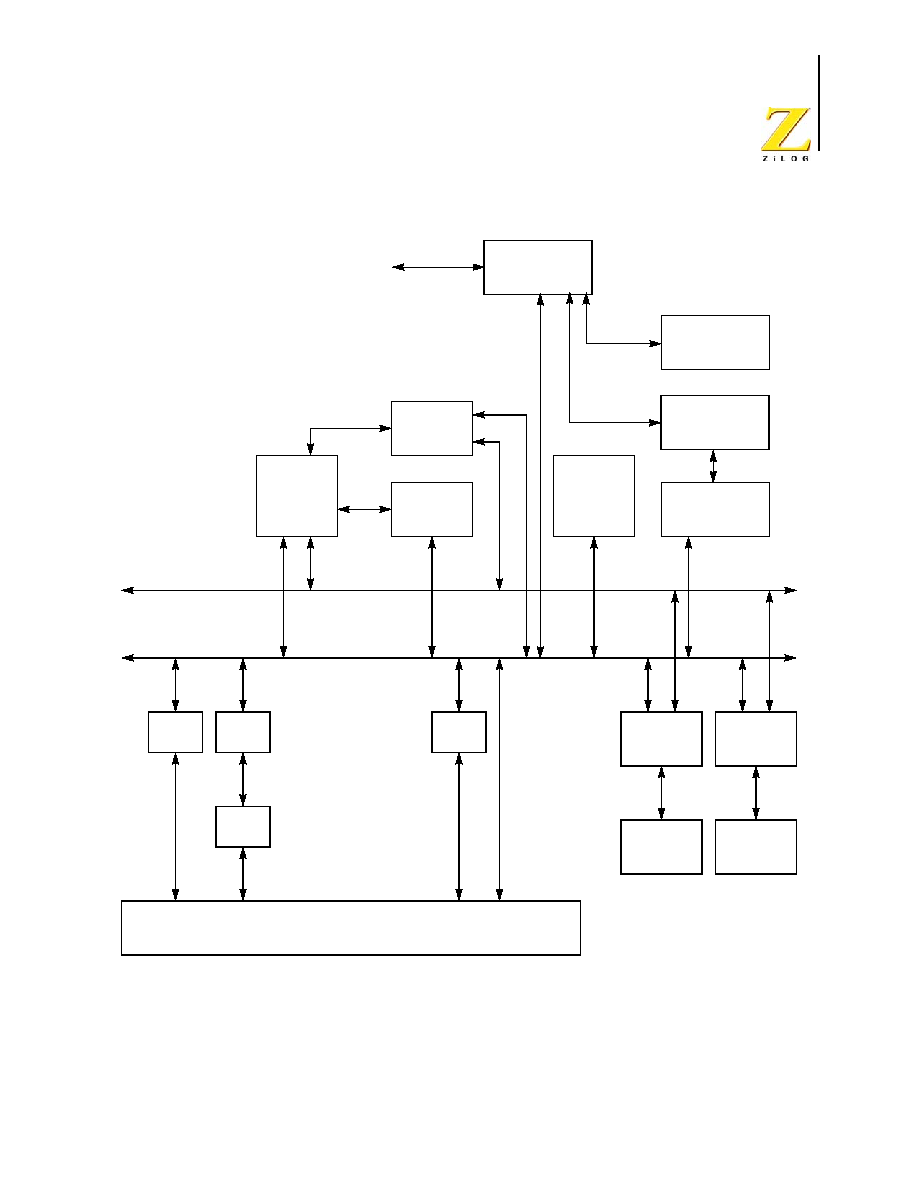
PS024302-0904
P R E L I M I N A R Y Overview
Z8 Encore!
Æ
4K Series
Product Specification
3
Figure 1. 4K Series Block Diagram
GPIO
IrDA
UART
Timers
ADC
Flash
Flash
Controller
RAM
RAM
Controller
Memory
Interrupt
Controller
On-Chip
Debugger
eZ8
CPU
WDT
POR/VBO
& Reset
Controller
Register Bus
Memory Busses
System
Clock
Low Power
RC Oscillator
Internal
Oscillator
Control
Oscillator
Precision

PS024302-0904
P R E L I M I N A R Y Overview
Z8 Encore!
Æ
4K Series
Product Specification
4
CPU and Peripheral Overview
eZ8 CPU Features
The eZ8 CPU, ZiLOG
Æ
's latest 8-bit Central Processing Unit (CPU), meets the continuing
demand for faster and more code-efficient microcontrollers. The eZ8 CPU executes a
superset of the original Z8
Æ
instruction set. The eZ8 CPU features include:
∑
Direct register-to-register architecture allows each register to function as an
accumulator, improving execution time and decreasing the required program memory
∑
Software stack allows much greater depth in subroutine calls and interrupts than
hardware stacks
∑
Compatible with existing Z8
Æ
code
∑
Expanded internal Register File allows access of up to 4KB
∑
New instructions improve execution efficiency for code developed using higher-level
programming languages, including C
∑
Pipelined instruction fetch and execution
∑
New instructions for improved performance including BIT, BSWAP, BTJ, CPC, LDC,
LDCI, LEA, MULT, and SRL
∑
New instructions support 12-bit linear addressing of the Register File
∑
Up to 10 MIPS operation
∑
C-Compiler friendly
∑
2 to 9 clock cycles per instruction
For more information regarding the eZ8 CPU, refer to the eZ8 CPU User Manual avail-
able for download at
www.zilog.com
.
General Purpose I/O
The Z8 Encore! PartName features 6 to 24 port pins (Ports A≠C) for general purpose I/O
(GPIO). The number of GPIO pins available is a function of package. Each pin is individ-
ually programmable.
Flash Controller
The Flash Controller programs and erases Flash memory. The Flash Controller supports
protection against accidental program and erasure.

PS024302-0904
P R E L I M I N A R Y Overview
Z8 Encore!
Æ
4K Series
Product Specification
5
Internal Precision Oscillator
The Internal Precision Oscillator (IPO) is a trimmable clock source that requires no exter-
nal components.
10-Bit Analog-to-Digital Converter
The optional Analog-to-Digital Converter (ADC) converts an analog input signal to a 10-
bit binary number. The ADC accepts inputs from 8 different analog input pins in both sin-
gle-ended and differential modes.
UART
The UART is full-duplex and capable of handling asynchronous data transfers. The UART
supports 8- and 9-bit data modes and selectable parity. The UART also supports multi-
drop address processing in hardware.
Timers
Two enhanced 16-bit reloadable timers can be used for timing/counting events or for
motor control operations. These timers provide a 16-bit programmable reload counter and
operate in One-Shot, Continuous, Gated, Capture, Capture Restart, Compare, Capture and
Compare, PWM Single Output and PWM Dual Output modes.
Interrupt Controller
The Z8 Encore!
Æ
4K Series products support up to 20 interrupts. These interrupts consist
of 8 internal peripheral interrupts and 12 general-purpose I/O pin interrupt sources. The
interrupts have 3 levels of programmable interrupt priority.
Reset Controller
The 4K Series products can be reset using the RESET pin, power-on reset, Watch-Dog
Timer (WDT) time-out, STOP mode exit, or Voltage Brown-Out (VBO) warning signal.
The RESET pin is bi-directional, meaning it functions as reset source as well as a reset
indicator.
On-Chip Debugger
The 4K Series products feature an integrated On-Chip Debugger (OCD). The OCD pro-
vides a rich set of debugging capabilities, such as reading and writing registers, program-

PS024302-0904
P R E L I M I N A R Y Overview
Z8 Encore!
Æ
4K Series
Product Specification
6
ming Flash memory, setting breakpoints and executing code. A single-pin interface
provides communication to the OCD.

PS024302-0904
P R E L I M I N A R Y Pin
Description
Z8 Encore!
Æ
4K Series
Product Specification
7
Pin Description
Overview
The PartName products are available in a variety of packages styles and pin configura-
tions. This chapter describes the signals and available pin configurations for each of the
package styles. For information regarding the physical package specifications, refer to the
chapter
"Packaging" on page 179
.
Available Packages
Table 2 identifies the package styles that are available for each device in the PartName
product line.
Pin Configurations
Figure 2 through Figure 4 illustrate the pin configurations for all of the packages available
in the 4K Series. Refer to Table 3 for a description of the signals. The analog input alter-
nate functions (ANAx) are not available on the Z8F041A, Z8F021A, and Z8F011A
devices. The analog supply pins (AV
DD
and AV
SS
) are also not available on these parts,
and are replaced by PB6 and PB7.
At reset, all Port A, B and C pins default to an input state. In addition, any alternate func-
tionality is not enabled, so the pins function as general purpose input ports until pro-
grammed otherwise.
The pin configurations listed are preliminary and subject to change based on manufactur-
ing limitations.
Table 2. 4K Series Package Options
Part
Number
ADC
8-pin
PDIP
8-pin
SOIC
20-pin
PDIP
20-pin
SOIC
20-pin
SSOP
28-pin
PDIP
28-pin
SOIC
28-pin
SSOP
Z8F0423
Yes
X
X
X
X
X
X
X
X
Z8F0413
No
X
X
X
X
X
X
X
X
Z8F0223
Yes
X
X
X
X
X
X
X
X
Z8F0213
No
X
X
X
X
X
X
X
X
Z8F0123
Yes
X
X
X
X
X
X
X
X
Z8F0113
No
X
X
X
X
X
X
X
X
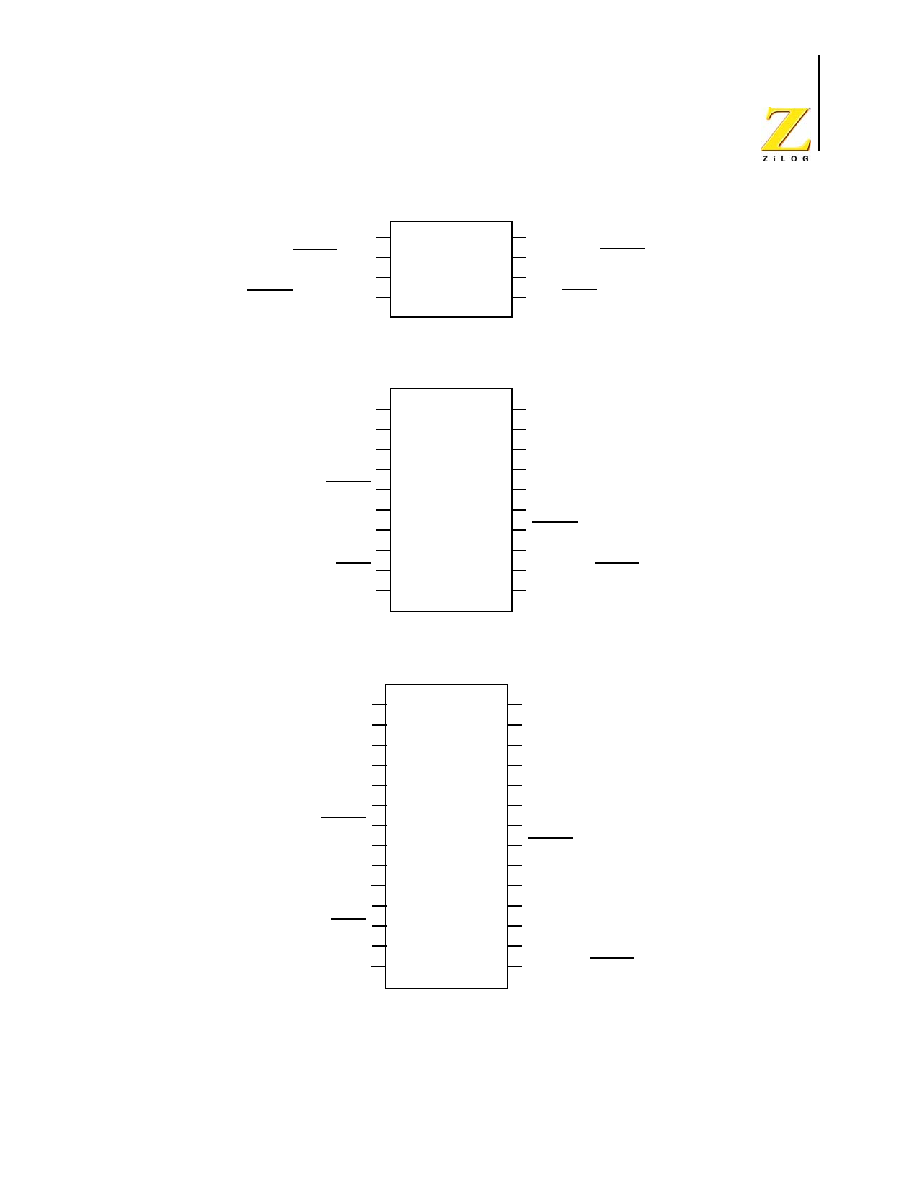
PS024302-0904
P R E L I M I N A R Y Pin
Description
Z8 Encore!
Æ
4K Series
Product Specification
8
Figure 2.Z8F04x3, Z8F02x3, and Z8F01x3 in 8-Pin SOIC or PDIP Package
Figure 3.Z8F04x3, Z8F02x3, and Z8F01x3 in 20-Pin SOIC, SSOP or PDIP Package
Figure 4.Z8F04x3, Z8F02x3, and Z8F01x3k in 28-Pin SOIC, SSOP or PDIP Package
VSS
PA5/TXD0/T1OUT/ANA0
PA4/RXD0/ANA1
PA3/CTS0/ANA2/T1IN
VDD
PA0/T0IN/T0OUT/DBG
PA1/T0OUT/ANA3/VREF/CLKIN
PA2/RESET/DE0/T1OUT
2
1
3
4
7
8
6
5
PB0/ANA0
PC3
PC2/ANA6
PC1/ANA5
PC0/ANA4
DBG
RESET
PA7/T1OUT
PA6/T1IN/T1OUT
PB1/ANA1
PB2/ANA2
PB3/CLKIN/ANA3
VDD
PA0/T0IN/T0OUT
PA1/T0OUT
VSS
PA2/DE0
1
PA5/TXD0
PA3/CTS0
5
10
PA4/RXD0
2
3
4
6
7
8
9
20
16
11
19
18
17
15
14
13
12
PB1/ANA1
PB0/ANA0
PC3/COUT
PC2/ANA6
PC1/ANA5
PC0/ANA4
DBG
RESET
PC7
PB2/ANA2
PB3/CLKIN/ANA3
PB4/ANA7
PB5/VREF
(PB6) AVDD
VDD
PA0/T0IN/T0OUT
PA1/T0OUT
1
PC6
VSS
5
10
(PB7) AVSS
PA2/DE0
PA3/CTS0
PA4/RXD0
14
PA5/TXD0
2
3
4
6
7
8
9
11
12
13
PC5
PC4
PA7/T1OUT
PA6/T1IN/T1OUT
28
24
19
15
27
26
25
23
22
21
20
18
17
16

PS024302-0904
P R E L I M I N A R Y Pin
Description
Z8 Encore!
Æ
4K Series
Product Specification
9
Signal Descriptions
Table 3 describes the PartName signals. Refer to the section
"Pin Configurations" on
page 7
to determine the signals available for the specific package styles.
Table 3. Signal Descriptions
Signal Mnemonic
I/O
Description
General-Purpose I/O Ports A≠D
PA[7:0]
I/O
Port A. These pins are used for general-purpose I/O.
PB[7:0]
I/O
Port B. These pins are used for general-purpose I/O. PB6 and PB7 are
available only in those devices without an ADC.
PC[7:0]
I/O
Port C. These pins are used for general-purpose I/O.
Note: PB6 and PB7 are only available in 28-pin packages without ADC. In 28-pin packages with ADC,
they are replaced by AV
DD
and AV
SS
.
UART Controllers
TXD0
O
Transmit Data. This signal is the transmit output from the UART and IrDA.
RXD0
I
Receive Data. This signal is the receive input for the UART and IrDA.
CTS0
I
Clear To Send. This signal is the flow control input for the UART.
DE
O
Driver Enable. This signal allows automatic control of external RS-485
drivers. This signal is approximately the inverse of the TXE (Transmit
Empty) bit in the UART Status 0 register. The DE signal may be used to
ensure the external RS-485 driver is enabled when data is transmitted by
the UART.
Timers
T0OUT/T1OUT
O
Timer Output 0≠1. These signals are output from the timers.
T0OUT/T1OUT
O
Timer Complement Output 0≠1. These signals are output from the timers
in PWM Dual Output mode.
T0IN/T1IN
I
Timer Input 0≠1. These signals are used as the capture, gating and
counter inputs. The T0IN signal is multiplexed T0OUT signals.
Analog
ANA[7:0]
I
Analog Port. These signals are used as inputs to the analog-to-digital
converter (ADC).
VREF
I/O
Analog-to-digital converter reference voltage input.
Clock Input
CLKIN
I
Clock Input Signal. This pin inputs a TTL-level signal to be used as the
system clock.
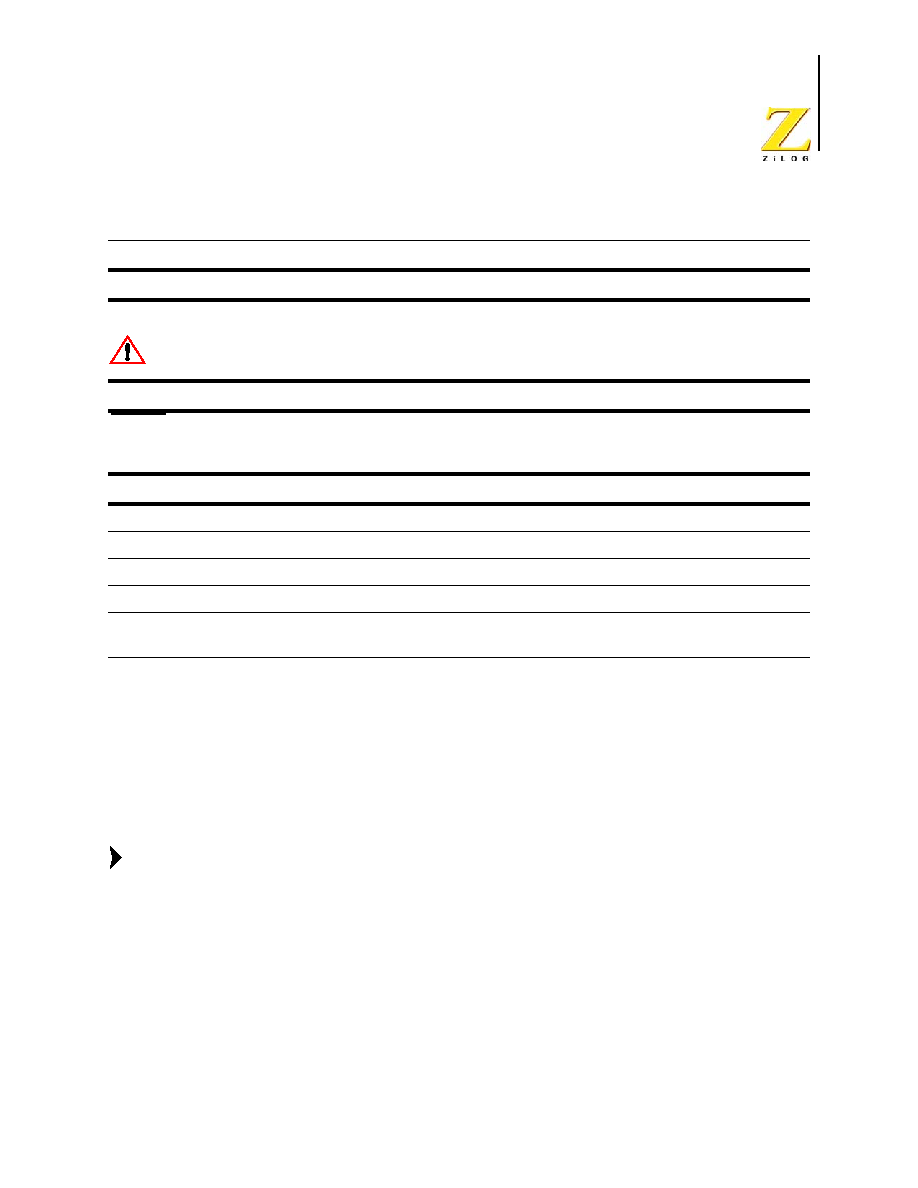
PS024302-0904
P R E L I M I N A R Y Pin
Description
Z8 Encore!
Æ
4K Series
Product Specification
10
Pin Characteristics
Table 4 provides detailed information about the characteristics for each pin available on
the 4K Series 20- and 28-pin devices. Data in Table 4 is sorted alphabetically by the pin
symbol mnemonic.
Table 5 provides detailed information about the characteristics for each pin available on
the 4K Series 8-pin devices,
All six I/O pins on the 8-pin packages are 5V-tolerant (unless the pull-up devices are
enabled). The column in Table 4 below describes 5V-tolerance for the 20 and 28-pin pack-
ages only.
On-Chip Debugger
DBG
I/O
Debug. This signal is the control and data input and output to and from the
On-Chip Debugger.
The DBG pin is open-drain and requires an external pull-up resistor to
ensure proper operation.
Reset
RESET
I/O
RESET. Generates a Reset when asserted (driven Low). Also serves as a
reset indicator; the Z8 Encore!
Æ
forces this pin low when in reset. This pin
is open-drain and features an enabled internal pull-up resistor.
Power Supply
V
DD
I
Digital Power Supply.
AV
DD
I
Analog Power Supply.
V
SS
I
Digital Ground.
AV
SS
I
Analog Ground.
Note: The AV
DD
and AV
SS
signals are available only in 28-pin packages with ADC. They are replaced by
PB6 and PB7 on 28-pin packages without ADC.
Table 3. Signal Descriptions (Continued)
Signal Mnemonic
I/O
Description
Caution:
Note:

PS024302-0904
P R E L I M I N A R Y Pin
Description
Z8 Encore!
Æ
4K Series
Product Specification
11
PB6 and PB7 are available only in those devices without ADC.
Table 4. Pin Characteristics (20- and 28-pin Devices)
Symbol
Mnemonic Direction
Reset
Direction
Active
Low
or
Active
High
Tristate
Output
Internal Pull-
up
or Pull-down
Schmitt
Trigger
Input
Open Drain
Output
5V
Tolerance
AVDD
N/A
N/A
N/A
N/A
N/A
N/A
N/A
No
AVSS
N/A
N/A
N/A
N/A
N/A
N/A
N/A
No
DBG
I/O
I
N/A
Yes
No
Yes
Yes
Yes
PA[7:0]
I/O
I
N/A
Yes
Programmable
Pull-up
Yes
Yes,
Programmable
PA[7:2] only
PB[7:0]
I/O
I
N/A
Yes
Programmable
Pull-up
Yes
Yes,
Programmable
PB[7:6] only
PC[7:0]
I/O
I
N/A
Yes
Programmable
Pull-up
Yes
Yes,
Programmable
PC[7:3] only
RESET
I/O
I/O Low N/A
Pull-up
Yes
N/A
Yes
VDD
N/A
N/A
N/A
N/A
N/A
N/A
N/A
N/A
VSS
N/A
N/A
N/A
N/A
N/A
N/A
N/A
N/A
Note:

PS024302-0904
P R E L I M I N A R Y Pin
Description
Z8 Encore!
Æ
4K Series
Product Specification
12
)
Table 5. Pin Characteristics (8-Pin Devices)
Symbol
Mnemonic Direction
Reset
Direction
Active Low
or
Active
High
Tristate
Output
Internal Pull-
up
or Pull-down
Schmitt
Trigger
Input
Open Drain
Output
5V
Tolerance
PA0/DBG
I/O
I (but can
change
during
reset if
key
sequence
detected)
N/A
Yes
Programmable
Pull-up
Yes
Yes,
Programmable
Yes, unless
pull-ups
enabled
PA1
I/O
I
N/A
Yes
Programmable
Pull-up
Yes
Yes,
Programmable
Yes, unless
pull-ups
enabled
RESET/
PA2
I/O
I/O
N/A
Yes
Programmable
for PA2;
always on for
RESET
Yes
programmable
for PA2; always
on for RESET
Yes, unless
pull-ups
enabled
PA[5:3]
I/O
I
N/A
Yes
Programmable
Pull-up
Yes
Yes,
Programmable
Yes, unless
pull-ups
enabled
VDD
N/A
N/A
N/A
N/A
N/A
N/A
N/A
N/A
VSS
N/A
N/A
N/A
N/A
N/A
N/A
N/A
N/A

PS024302-0904
P R E L I M I N A R Y Address
Space
Z8 Encore!
Æ
4K Series
Product Specification
13
Address Space
Overview
The eZ8 CPU can access three distinct address spaces:
∑
The Register File contains addresses for the general-purpose registers and the eZ8 CPU,
peripheral, and general-purpose I/O port control registers.
∑
The Program Memory contains addresses for all memory locations having executable
code and/or data.
∑
The Data Memory contains addresses for all memory locations that contain data only.
These three address spaces are covered briefly in the following subsections. For more
detailed information regarding the eZ8 CPU and its address space, refer to the eZ8 CPU
User Manual available for download at
www.zilog.com
.
Register File
The Register File address space in the Z8 Encore!
Æ
MCU is 4KB (4096 bytes). The Regis-
ter File is composed of two sections: control registers and general-purpose registers. When
instructions are executed, registers defined as sources are read, and registers defined as
destinations are written. The architecture of the eZ8 CPU allows all general-purpose regis-
ters to function as accumulators, address pointers, index registers, stack areas, or scratch
pad memory.
The upper 256 bytes of the 4KB Register File address space are reserved for control of the
eZ8 CPU, the on-chip peripherals, and the I/O ports. These registers are located at
addresses from
F00H
to
FFFH
. Some of the addresses within the 256B control register sec-
tion are reserved (unavailable). Reading from a reserved Register File address returns an
undefined value. Writing to reserved Register File addresses is not recommended and can
produce unpredictable results.
The on-chip RAM always begins at address
000H
in the Register File address space. The
4K Series devices contain 256B to 1KB of on-chip RAM. Reading from Register File
addresses outside the available RAM addresses (and not within the control register address
space) returns an undefined value. Writing to these Register File addresses produces no
effect.

PS024302-0904
P R E L I M I N A R Y Address
Space
Z8 Encore!
Æ
4K Series
Product Specification
14
Program Memory
The eZ8 CPU supports 64KB of Program Memory address space. The PartName devices
contain 1KB to 4KB of on-chip Flash memory in the Program Memory address space,
depending on the device. Reading from Program Memory addresses outside the available
Flash memory addresses returns
FFH
. Writing to these unimplemented Program Memory
addresses produces no effect. Table 6 describes the Program Memory Maps for the Part-
Name products.
Table 6. 4K Series Program Memory Maps
Program Memory Address (Hex) Function
Z8F042A and Z8F041A Products
0000≠0001
Flash Option Bits
0002≠0003
Reset Vector
0004≠0005
WDT Interrupt Vector
0006≠0007
Illegal Instruction Trap
0008≠0037
Interrupt Vectors*
003E≠0FFF
Program Memory
Z8F022A and Z8F021A Products
0000≠0001
Flash Option Bits
0002≠0003
Reset Vector
0004≠0005
WDT Interrupt Vector
0006≠0007
Illegal Instruction Trap
0008≠0037
Interrupt Vectors*
003E≠07FF
Program Memory
Z8F012A and Z8F011A Products
0000≠0001
Flash Option Bits
0002≠0003
Reset Vector
0004≠0005
WDT Interrupt Vector
0006≠0007
Illegal Instruction Trap
0008≠0037
Interrupt Vectors*
003E≠03FF
Program Memory
* See Table 30 on page 47 for a list of the interrupt vectors.

PS024302-0904
P R E L I M I N A R Y Address
Space
Z8 Encore!
Æ
4K Series
Product Specification
15
Data Memory
The 4K Series does not use the eZ8 CPU's 64KB Data Memory address space.
Flash Information Area
Table 7 describes the 4K Series Flash Information Area. This 128B Information Area is
accessed by setting bit 7 of the Flash Page Select Register to 1. When access is enabled,
the Flash Information Area is mapped into the Program Memory and overlays the 128
bytes at addresses
FE00H
to
FF7FH
. When the Information Area access is enabled, all
reads from these Program Memory addresses return the Information Area data rather than
the Program Memory data. Access to the Flash Information Area is read-only.
Table 7. 4K Series Flash Memory Information Area Map
Program Memory Address (Hex) Function
FE00≠FE3F
ZiLOG Option Bits
FE40≠FE53
Part Number
20-character ASCII alphanumeric code
Left justified and filled with FH
FE54≠FE5F
Reserved
FE60≠FE7F
ZiLOG Calibration Data
FE80≠FFFF
Reserved

PS024302-0904
P R E L I M I N A R Y Register
Map
Z8 Encore!
Æ
4K Series
Product Specification
16
Register Map
Table 8 provides the address map for the Register File of the PartName devices. Not all
devices and package styles in the PartName support the ADC, or all of the GPIO Ports.
Consider registers for unimplemented peripherals as Reserved.
Table 8. Register File Address Map
Address (Hex) Register Description
Mnemonic
Reset (Hex)
Page #
General Purpose RAM
Z8F0423/Z8F0413 Devices
000≠3FF
General-Purpose Register File RAM
--
XX
400≠EFF
Reserved
--
XX
Z8F0223/Z8F0213 Devices
000≠1FF
General-Purpose Register File RAM
--
XX
200≠EFF
Reserved
--
XX
Z8F0123/Z8F0113 Devices
000≠0FF
General-Purpose Register File RAM
--
XX
100≠EFF
Reserved --
XX
Timer 0
F00
Timer 0 High Byte
T0H
00
72
F01
Timer 0 Low Byte
T0L
01
72
F02
Timer 0 Reload High Byte
T0RH
FF
73
F03
Timer 0 Reload Low Byte
T0RL
FF
73
F04
Timer 0 PWM High Byte
T0PWMH
00
73
F05
Timer 0 PWM Low Byte
T0PWML
00
74
F06
Timer 0 Control 0
T0CTL0
00
74
F07
Timer 0 Control 1
T0CTL1
00
75
Timer 1
F08
Timer 1 High Byte
T1H
00
72
F09
Timer 1 Low Byte
T1L
01
72
F0A
Timer 1 Reload High Byte
T1RH
FF
73
F0B
Timer 1 Reload Low Byte
T1RL
FF
73
F0C
Timer 1 PWM High Byte
T1PWMH
00
73
F0D
Timer 1 PWM Low Byte
T1PWML
00
74
XX=Undefined

PS024302-0904
P R E L I M I N A R Y Register
Map
Z8 Encore!
Æ
4K Series
Product Specification
17
F0E
Timer 1 Control 0
T1CTL0
00
74
F0F
Timer 1 Control 1
T1CTL1
00
72
F10≠F3F
Reserved
--
XX
UART 0
F40
UART0 Transmit Data
U0TXD
XX
95
UART0 Receive Data
U0RXD
XX
96
F41
UART0 Status 0
U0STAT0
0000011Xb
96
F42
UART0 Control 0
U0CTL0
00
98
F43
UART0 Control 1
U0CTL1
00
99
F44
UART0 Status 1
U0STAT1
00
97
F45
UART0 Address Compare
U0ADDR
00
101
F46
UART0 Baud Rate High Byte
U0BRH
FF
101
F47
UART0 Baud Rate Low Byte
U0BRL
FF
101
F48≠F6F
Reserved
--
XX
Analog-to-Digital Converter (ADC)
F70
ADC Control 0
ADCCTL0
00
111
F71
ADC Control 1
ADCCTL1
80
111
F72
ADC Data High Byte
ADCD_H
XX
113
F73
ADC Data Low Bits
ADCD_L
XX
113
F74≠F7F
Reserved
--
XX
Low Power Control
F80
Power Control 0
PWRCTL0
80
30
F81
Reserved
--
XX
F82≠F85
Reserved
--
XX
Oscillator Control
F86
Oscillator Control
OSCCTL
A0
144
F87≠FBF
Reserved
--
XX
Interrupt Controller
FC0
Interrupt Request 0
IRQ0
00
51
FC1
IRQ0 Enable High Bit
IRQ0ENH
00
53
FC2
IRQ0 Enable Low Bit
IRQ0ENL
00
53
FC3
Interrupt Request 1
IRQ1
00
52
FC4
IRQ1 Enable High Bit
IRQ1ENH
00
54
FC5
IRQ1 Enable Low Bit
IRQ1ENL
00
54
Table 8. Register File Address Map (Continued)
Address (Hex) Register Description
Mnemonic
Reset (Hex)
Page #
XX=Undefined

PS024302-0904
P R E L I M I N A R Y Register
Map
Z8 Encore!
Æ
4K Series
Product Specification
18
FC6
Interrupt Request 2
IRQ2
00
52
FC7
IRQ2 Enable High Bit
IRQ2ENH
00
55
FC8
IRQ2 Enable Low Bit
IRQ2ENL
00
55
FC9≠FCC
Reserved
--
XX
FCD
Interrupt Edge Select
IRQES
00
56
FCE
Reserved
FCF
Interrupt Control
IRQCTL
00
56
GPIO Port A
FD0
Port A Address
PAADDR
00
38
FD1
Port A Control
PACTL
00
40
FD2
Port A Input Data
PAIN
XX
40
FD3
Port A Output Data
PAOUT
00
40
GPIO Port B
FD4
Port B Address
PBADDR
00
38
FD5
Port B Control
PBCTL
00
40
FD6
Port B Input Data
PBIN
XX
40
FD7
Port B Output Data
PBOUT
00
40
GPIO Port C
FD8
Port C Address
PCADDR
00
38
FD9
Port C Control
PCCTL
00
40
FDA
Port C Input Data
PCIN
XX
40
FDB
Port C Output Data
PCOUT
00
40
FDC≠FEF
Reserved
--
XX
Watch-Dog Timer (WDT)
FF0
Reset Status
RSTSTAT
XX
82
Watch-Dog Timer Control
WDTCTL
XX
82
FF1
Watch-Dog Timer Reload Upper Byte
WDTU
FF
83
FF2
Watch-Dog Timer Reload High Byte
WDTH
FF
83
FF3
Watch-Dog Timer Reload Low Byte
WDTL
FF
83
FF4≠FF5
Reserved
--
XX
Trim Bit Control
FF6
Trim Bit Address
TRMADR
00
127
FF7
Trim Data
TRMDR
XX
127
Table 8. Register File Address Map (Continued)
Address (Hex) Register Description
Mnemonic
Reset (Hex)
Page #
XX=Undefined

PS024302-0904
P R E L I M I N A R Y Register
Map
Z8 Encore!
Æ
4K Series
Product Specification
19
Flash Memory Controller
FF8
Flash Control
FCTL
00
122
FF8
Flash Status
FSTAT
00
123
FF9
Flash Page Select
FPS
00
124
Flash Sector Protect
FPROT
00
124
FFA
Flash Programming Frequency High Byte FFREQH
00
125
FFB
Flash Programming Frequency Low Byte FFREQL
00
125
eZ8 CPU
FFC
Flags
--
XX
Refer to the
eZ8 CPU User
Manual
FFD
Register Pointer
RP
XX
FFE
Stack Pointer High Byte
SPH
XX
FFF
Stack Pointer Low Byte
SPL
XX
Table 8. Register File Address Map (Continued)
Address (Hex) Register Description
Mnemonic
Reset (Hex)
Page #
XX=Undefined

PS024302-0904
P R E L I M I N A R Y Reset, STOP Mode Recovery and Low Voltage
Z8 Encore!
Æ
4K Series
Product Specification
20
Reset, STOP Mode Recovery and Low
Voltage Detection
Overview
The Reset Controller within the PartName controls Reset and STOP Mode Recovery oper-
ation and provides indication of low supply voltage conditions. In typical operation, the
following events cause a Reset:
∑
Power-On Reset (POR)
∑
Voltage Brown-Out (VBO)
∑
Watch-Dog Timer time-out (when configured by the WDT_RES Flash Option Bit to
initiate a reset)
∑
External RESET pin assertion (when the alternate RESET function is enabled by the
GPIO register)
∑
On-Chip Debugger initiated Reset (OCDCTL[0] set to 1)
When the device is in STOP mode, a STOP Mode Recovery is initiated by either of the
following:
∑
Watch-Dog Timer time-out
∑
GPIO Port input pin transition on an enabled STOP Mode Recovery source
Reset Types
The PartName provides two types of Reset operation (Systems Reset, and STOP Mode
Recovery). The reset type is a function of both the current operating mode of the Part-
Name device and the source of the reset. Table 9 lists the types of Reset and their operat-
ing characteristics.
Table 9. Reset and STOP Mode Recovery Characteristics and Latency
Reset Type
Reset Characteristics and Latency
Control Registers
eZ8
CPU Reset Latency (Delay)
System Reset
Reset (as applicable)
Reset 66 Internal Precision Oscillator Cycles
STOP Mode Recovery
Unaffected, except
WDT_CTL and
OSC_CTL registers
Reset 66 Internal Precision Oscillator Cycles

PS024302-0904
P R E L I M I N A R Y Reset, STOP Mode Recovery and Low Voltage
Z8 Encore!
Æ
4K Series
Product Specification
21
During a System Reset or STOP Mode Recovery, the PartName device is held in Reset for
66 cycles of the Internal Precision Oscillator. When a reset occurs because of a low volt-
age condition or power on reset, this delay is measured from the time that the supply volt-
age first exceeds the POR level (discussed later in this chapter). If the external pin reset
remains asserted at the end of the reset period, the device remains in reset until the pin is
deasserted.
At the beginning of Reset, all GPIO pins are configured as inputs with pull-up resistor dis-
abled. During Reset, the eZ8 CPU and on-chip peripherals are idle; however, Watch-Dog
Timer oscillator remains running.
Upon Reset, control registers within the Register File that have a defined Reset value are
loaded with their reset values. Other control registers (including the Stack Pointer, Regis-
ter Pointer, and Flags) and general-purpose RAM are undefined following Reset. The eZ8
CPU fetches the Reset vector at Program Memory addresses
0002H
and
0003H
and loads
that value into the Program Counter. Program execution begins at the Reset vector
address.
Because the control registers are re-initialized by a system reset, the system clock after
reset is always the IPO. User software must reconfigure the oscillator control block, such
that the correct system clock source is enabled and selected.
Reset Sources
Table 10 lists the possible sources of a system reset.
Table 10. Reset Sources and Resulting Reset Type
Operating Mode
Reset Source
Special Conditions
NORMAL or HALT
modes
Power-On Reset / Voltage Brown-
Out
Reset delay begins after supply voltage
exceeds POR level
Watch-Dog Timer time-out
when configured for Reset
None
RESET pin assertion
All reset pulses less than three system clocks
in width are ignored.
On-Chip Debugger initiated Reset
(OCDCTL[0] set to 1)
System Reset, except the On-Chip Debugger
is unaffected by the reset
STOP mode
Power-On Reset / Voltage Brown-
Out
Reset delay begins after supply voltage
exceeds POR level
RESET pin assertion
All reset pulses less than the specified analog
delay are ignored. See "Electrical
Characteristics" on page 167.
DBG pin driven Low
None
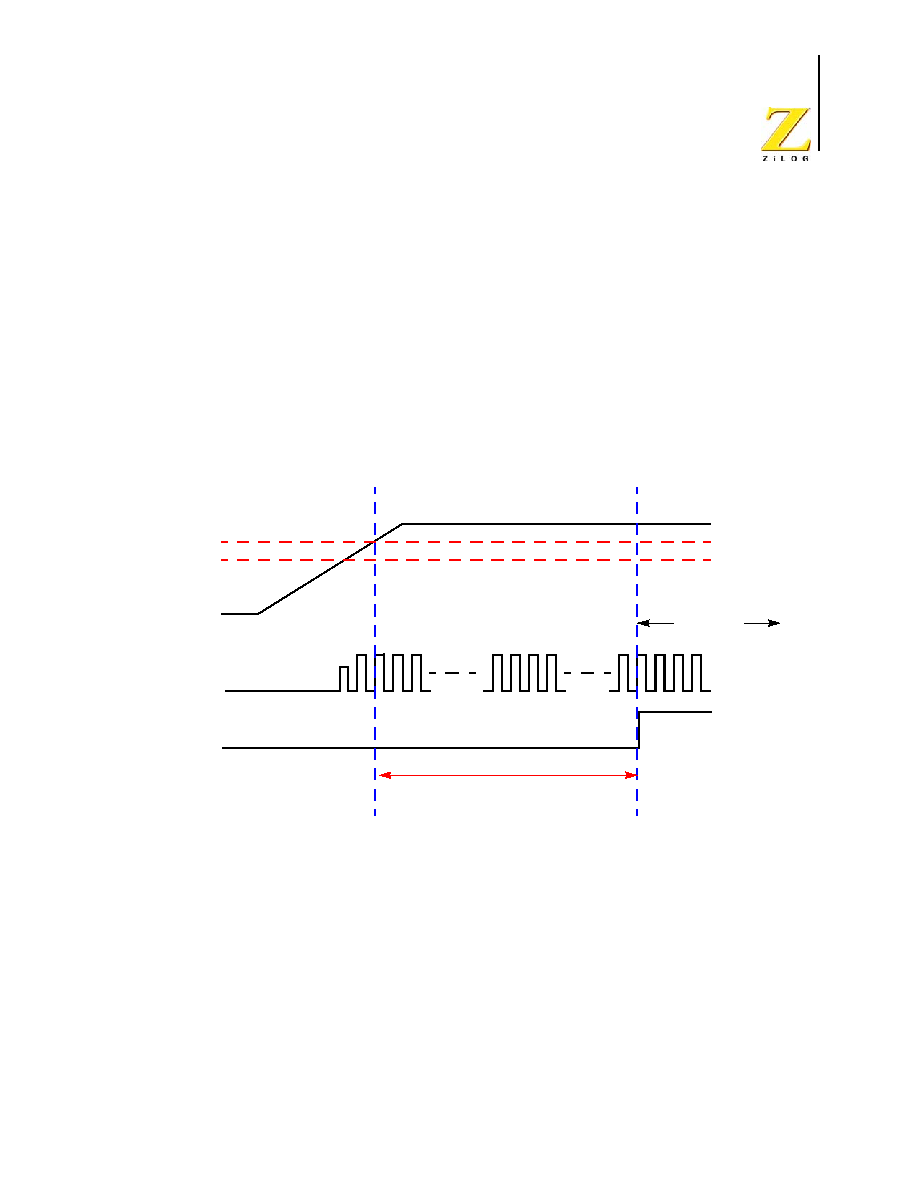
PS024302-0904
P R E L I M I N A R Y Reset, STOP Mode Recovery and Low Voltage
Z8 Encore!
Æ
4K Series
Product Specification
22
Power-On Reset
Each device in the 4K Series contains an internal Power-On Reset (POR) circuit. The POR
circuit monitors the supply voltage and holds the device in the Reset state until the supply
voltage reaches a safe operating level. After the supply voltage exceeds the POR voltage
threshold (V
POR
), the device is held in the Reset state until the POR Counter has timed
out.
After the 4K Series device exits the Power-On Reset state, the eZ8 CPU fetches the Reset
vector. Following Power-On Reset, the POR status bit in the Watch-Dog Timer Control
(WDTCTL) register is set to 1.
Figure 5 illustrates Power-On Reset operation. Refer to the "Electrical Characteristics" on
page 167 for the POR threshold voltage (V
POR
).
Figure 5.Power-On Reset Operation
Voltage Brown-Out Reset
The devices in the 4K Series provide low Voltage Brown-Out (VBO) protection. The VBO
circuit senses when the supply voltage drops to an unsafe level (below the VBO threshold
voltage) and forces the device into the Reset state. While the supply voltage remains
below the Power-On Reset voltage threshold (V
POR
), the VBO block holds the device in
the Reset.
After the supply voltage again exceeds the Power-On Reset voltage threshold, the device
progresses through a full System Reset sequence, as described in the Power-On Reset sec-
VCC = 0.0V
VCC = 3.3V
V
POR
V
VBO
Internal Precision
Internal RESET
signal
Program
Execution
POR
Counter Delay
Oscillator
Note: Not to Scale
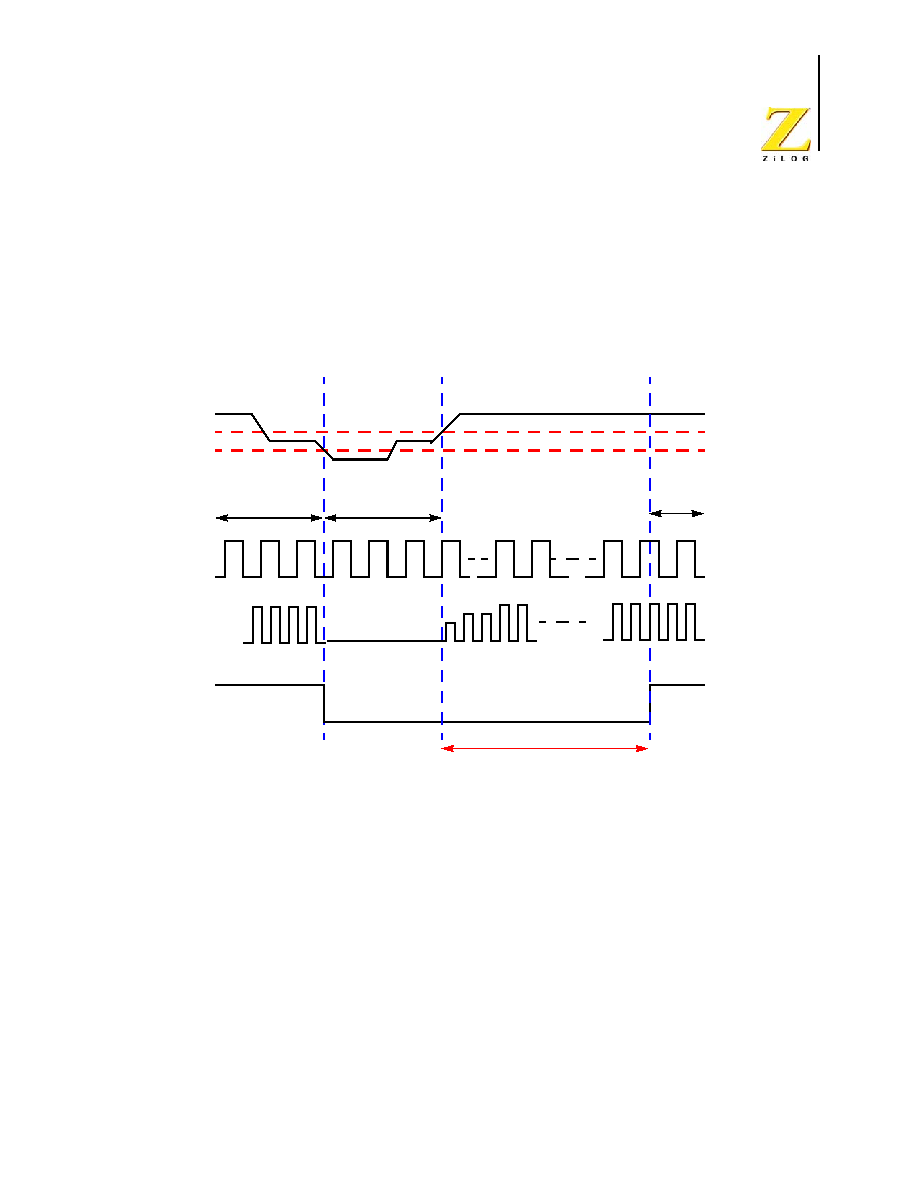
PS024302-0904
P R E L I M I N A R Y Reset, STOP Mode Recovery and Low Voltage
Z8 Encore!
Æ
4K Series
Product Specification
23
tion. Following Power-On Reset, the POR status bit in the Reset Status (RSTSTAT) regis-
ter is set to 1. Figure 6 illustrates Voltage Brown-Out operation. Refer to the chapter
"Electrical Characteristics" on page 167 for the VBO and POR threshold voltages (V
VBO
and V
POR
).
The Voltage Brown-Out circuit can be either enabled or disabled during STOP mode.
Operation during STOP mode is set by the VBO_AO Flash Option Bit. Refer to the Flash
Option Bits chapter for information about configuring VBO_AO.
Figure 6.Voltage Brown-Out Reset Operation
The POR level is greater than the VBO level by the specified hysteresis value. This
ensures that the device undergoes a power on reset after recovering from a VBO condition.
Watch-Dog Timer Reset
If the device is in NORMAL or STOP mode, the Watch-Dog Timer can initiate a System
Reset at time-out if the WDT_RES Flash Option Bit is programmed to 1. This is the
unprogrammed state of the WDT_RES Flash Option Bit. If the bit is programmed to 0, it
configures the Watch-Dog Timer to cause an interrupt, not a System Reset, at time-out.
VCC = 3.3V
V
POR
V
VBO
Internal RESET
signal
Program
Execution
Program
Execution
Voltage
Brownout
VCC = 3.3V
System Clock
WDT Clock
POR
counter delay
Note: Not to Scale

PS024302-0904
P R E L I M I N A R Y Reset, STOP Mode Recovery and Low Voltage
Z8 Encore!
Æ
4K Series
Product Specification
24
The WDT status bit in the WDT Control register is set to signify that the reset was initi-
ated by the Watch-Dog Timer.
External Reset Input
The RESET pin has a Schmitt-triggered input and an internal pull-up resistor. Once the
RESET pin is asserted for a minimum of 4 system clock cycles, the device progresses
through the System Reset sequence. Because of the possible asynchronicity of the system
clock and reset signals, the required reset duration may be as short as three clock periods
and as long as four. A reset pulse three clock cycles in duration might trigger a reset; a
pulse four cycles in duration always triggers a reset.
While the RESET input pin is asserted Low, the 4K Series devices remain in the Reset
state. If the RESET pin is held Low beyond the System Reset time-out, the device exits the
Reset state on the system clock rising edge following RESET pin deassertion. Following a
System Reset initiated by the external RESET pin, the EXT status bit in the Watch-Dog
Timer Control (WDTCTL) register is set to 1.
External Reset Indicator
During System Reset the RESET pin functions as an open-drain (active low) reset mode
indicator. This reset output feature allows an 4K Series device to reset other components
to which it is connected, even if that reset is caused by internal sources such as POR, VBO
or WDT events.
After an internal reset event occurs, the internal circuitry begins driving the RESET pin
Low. The RESET pin is held Low by the internal circuitry until the appropriate delay
listed in Table 9 has elapsed.
STOP Mode Recovery
STOP mode is entered by execution of a STOP instruction by the eZ8 CPU. Refer to the
chapter
"Low-Power Modes" on page 28
for detailed STOP mode information. During
STOP Mode Recovery, the CPU is held in reset for 66 IPO cycles.
STOP Mode Recovery does not affect onchip registers other than the Watch-Dog Timer
Control register (WDTCTL) and the Oscillator Control register (OSCCTL). After any
STOP Mode Recovery, the IPO is enabled and selected as the system clock. If another sys-
tem clock source is required or IPO disabling is required, the STOP Mode Recovery code
must reconfigure the oscillator control block such that the correct system clock source is
enabled and selected.
The eZ8 CPU fetches the Reset vector at Program Memory addresses
0002H
and
0003H
and loads that value into the Program Counter. Program execution begins at the Reset vec-

PS024302-0904
P R E L I M I N A R Y Reset, STOP Mode Recovery and Low Voltage
Z8 Encore!
Æ
4K Series
Product Specification
25
tor address. Following STOP Mode Recovery, the STOP bit in the Watch-Dog Timer Con-
trol Register is set to 1. Table 11 lists the STOP Mode Recovery sources and resulting
actions. The text following provides more detailed information about each of the STOP
Mode Recovery sources.
STOP Mode Recovery Using Watch-Dog Timer Time-Out
If the Watch-Dog Timer times out during STOP mode, the device undergoes a STOP
Mode Recovery sequence. In the Watch-Dog Timer Control register, the WDT and STOP
bits are set to 1. If the Watch-Dog Timer is configured to generate an interrupt upon time-
out and the 4K Series device is configured to respond to interrupts, the eZ8 CPU services
the Watch-Dog Timer interrupt request following the normal STOP Mode Recovery
sequence.
STOP Mode Recovery Using a GPIO Port Pin Transition
Each of the GPIO Port pins may be configured as a STOP Mode Recovery input source.
On any GPIO pin enabled as a STOP Mode Recovery source, a change in the input pin
value (from High to Low or from Low to High) initiates STOP Mode Recovery. In the
Watch-Dog Timer Control register, the STOP bit is set to 1.
In STOP mode, the GPIO Port Input Data registers (PxIN) are disabled. The Port Input
Data registers record the Port transition only if the signal stays on the Port pin through
the end of the STOP Mode Recovery delay. As a result, short pulses on the Port pin can
initiate STOP Mode Recovery without being written to the Port Input Data register or
without initiating an interrupt (if enabled for that pin).
Table 11. STOP Mode Recovery Sources and Resulting Action
Operating Mode
STOP Mode Recovery Source
Action
STOP mode
Watch-Dog Timer time-out
when configured for Reset
STOP Mode Recovery
Watch-Dog Timer time-out
when configured for interrupt
STOP Mode Recovery followed by
interrupt (if
interrupts are enabled)
Data transition on any GPIO Port pin
enabled as a STOP Mode Recovery
source
STOP Mode Recovery
Assertion of external
RESET
Pin
System Reset
Debug Pin driven Low
System Reset
Caution:
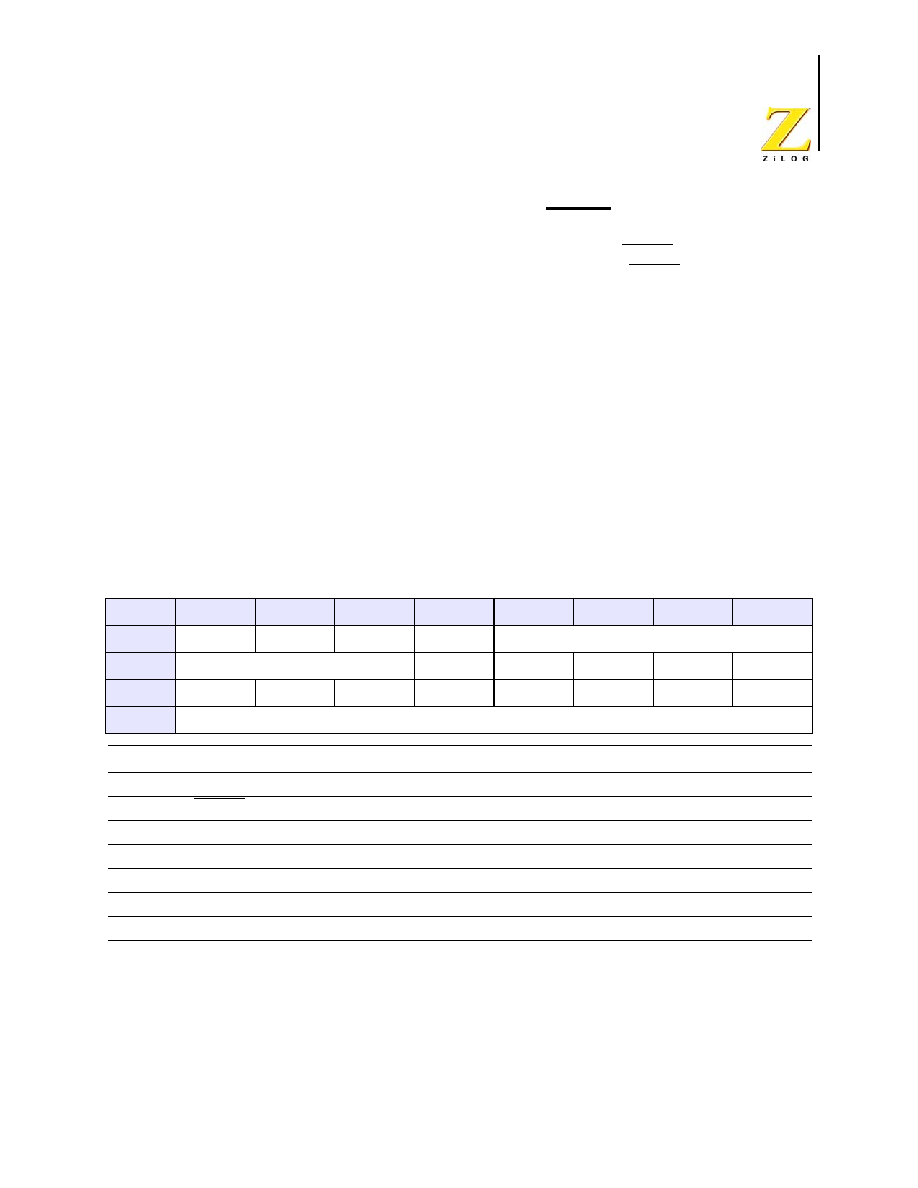
PS024302-0904
P R E L I M I N A R Y Reset, STOP Mode Recovery and Low Voltage
Z8 Encore!
Æ
4K Series
Product Specification
26
STOP Mode Recovery Using the External RESET Pin
When the 4K Series device is in STOP Mode and the external RESET pin is driven Low, a
system reset occurs. Because of a glitch filter operating on the RESET pin, the Low pulse
must be greater than the minimum width specified, or it is ignored. See
"Electrical Charac-
teristics" on page 167
for details.
Reset Register Definitions
Reset Status Register
The Reset Status (RSTSTAT) register is a read-only register that indicates the source of
the most recent Reset event, indicates a STOP Mode Recovery event, and indicates a
Watch-Dog Timer time-out. Reading this register resets the upper four bits to 0.
This register shares its address with the Watch-Dog Timer control register, which is write-
only (Table 12).
POR--Power-On Reset Indicator
If this bit is set to 1, a Power-On Reset event occurred. This bit is reset to 0 if a WDT time-
out or STOP Mode Recovery occurs. This bit is also reset to 0 when the register is read.
STOP--STOP Mode Recovery Indicator
If this bit is set to 1, a STOP Mode Recovery occurred. If the STOP and WDT bits are both
Table 12. Reset Status Register (RSTSTAT)
BITS
7
6
5
4
3
2
1
0
FIELD
POR
STOP
WDT
EXT
Reserved
RESET
See descriptions below
0
0
0
0
0
R/W
R
R
R
R
R
R
R
R
ADDR
FF0H
Reset or STOP Mode Recovery Event
POR
STOP
WDT
EXT
Power-On Reset
1
0
0
0
Reset using RESET pin assertion
0
0
0
1
Reset using Watch-Dog Timer time-out
0
0
1
0
Reset using the On-Chip Debugger (OCTCTL[1] set to 1)
1
0
0
0
Reset from STOP Mode using DBG Pin driven Low
1
0
0
0
STOP Mode Recovery using GPIO pin transition
0
1
0
0
STOP Mode Recovery using Watch-Dog Timer time-out
0
1
1
0

PS024302-0904
P R E L I M I N A R Y Reset, STOP Mode Recovery and Low Voltage
Z8 Encore!
Æ
4K Series
Product Specification
27
set to 1, the STOP Mode Recovery occurred because of a WDT time-out. If the STOP bit
is 1 and the WDT bit is 0, the STOP Mode Recovery was not caused by a WDT time-out.
This bit is reset by a Power-On Reset or a WDT time-out that occurred while not in STOP
mode. Reading this register also resets this bit.
WDT--Watch-Dog Timer Time-Out Indicator
If this bit is set to 1, a WDT time-out occurred. A Power-On Reset resets this pin. A STOP
Mode Recovery from a change in an input pin also resets this bit. Reading this register
resets this bit. This read must occur before clearing the WDT interrupt.
EXT--External Reset Indicator
If this bit is set to 1, a Reset initiated by the external RESET pin occurred. A Power-On
Reset or a STOP Mode Recovery from a change in an input pin resets this bit. Reading this
register resets this bit.
Reserved--Must be 0.

PS024302-0904
P R E L I M I N A R Y Low-Power
Modes
Z8 Encore!
Æ
4K Series
Product Specification
28
Low-Power Modes
Overview
The 4K Series products contain power-saving features. The highest level of power reduc-
tion is provided by the STOP mode. The next lower level of power reduction is provided
by the HALT mode.
Further power savings can be implemented by disabling individual peripheral blocks
while in Normal mode.
STOP Mode
Executing the eZ8 CPU's STOP instruction places the device into STOP mode. In STOP
mode, the operating characteristics are:
∑
Internal Precision Oscillator is stopped
∑
System clock is stopped
∑
eZ8 CPU is stopped
∑
Program counter (PC) stops incrementing
∑
Watch-Dog Timer's internal RC oscillator continues to operate if enabled by the Oscillator
Control Register
∑
If enabled, the Watch-Dog Timer logic continues to operate
∑
If enabled for operation in STOP mode by the associated Flash Option Bit, the Voltage-
brown out protection circuit continues to operate
∑
Transimpedance amplifier in the ADC block continues to operate if enabled by the Power
Control Register to do so; all other portions of the ADC are disabled
∑
All other on-chip peripherals are idle
To minimize current in STOP mode, all GPIO pins that are configured as digital inputs
must be driven to one of the supply rails (V
CC
or GND). The device can be brought out of
STOP mode using STOP Mode Recovery. For more information about STOP Mode
Recovery refer to
"Reset, STOP Mode Recovery and Low Voltage Detection" on
page 20
.

PS024302-0904
P R E L I M I N A R Y Low-Power
Modes
Z8 Encore!
Æ
4K Series
Product Specification
29
HALT Mode
Executing the eZ8 CPU's HALT instruction places the device into HALT mode. In HALT
mode, the operating characteristics are:
∑
Primary oscillator is enabled and continues to operate
∑
System clock is enabled and continues to operate
∑
eZ8 CPU is stopped
∑
Program counter (PC) stops incrementing
∑
Watch-Dog Timer's internal RC oscillator continues to operate
∑
If enabled, the Watch-Dog Timer continues to operate
∑
All other on-chip peripherals continue to operate
The eZ8 CPU can be brought out of HALT mode by any of the following operations:
∑
Interrupt
∑
Watch-Dog Timer time-out (interrupt or reset)
∑
Power-on reset
∑
Voltage-brown out reset
∑
External RESET pin assertion
To minimize current in HALT mode, all GPIO pins that are configured as inputs must be
driven to one of the supply rails (V
CC
or GND).
Peripheral-Level Power Control
In addition to the STOP and Halt modes, it is possible to disable each peripheral on each
of the 4K Series devices. Disabling a given peripheral minimizes its power consumption.
Power Control Register Definitions
Power Control Register 0
Each bit of the following registers disables a peripheral block, either by gating its system
clock input or by removing power from the block.
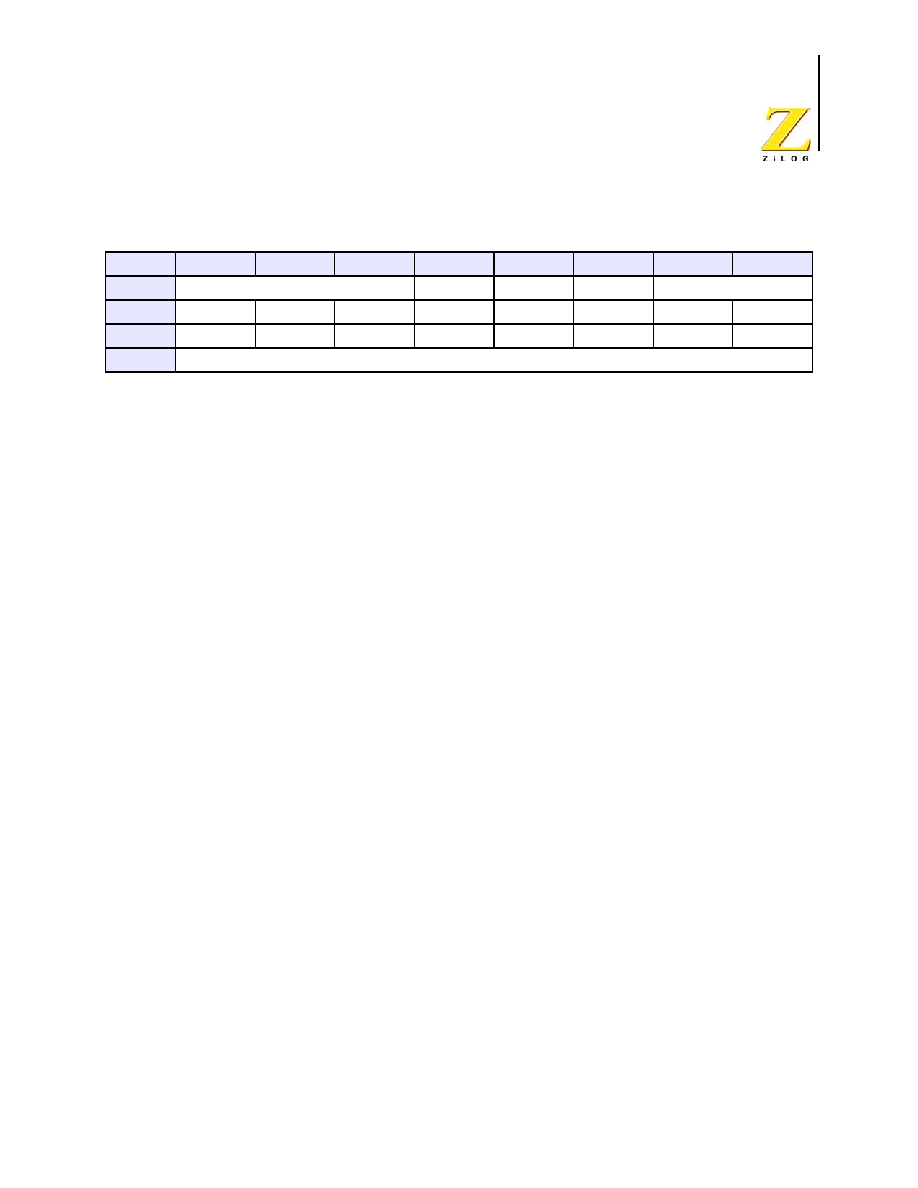
PS024302-0904
P R E L I M I N A R Y Low-Power
Modes
Z8 Encore!
Æ
4K Series
Product Specification
30
Reserved--Must be 0.
VBO--Voltage Brown-Out Detector Disable
This bit and the VBO_AO Flash option bit must both enable the VBO for the VBO to be
active.
0 = VBO Enabled
1 = VBO Disabled
ADC--Analog-to-Digital Converter Disable
0 = Analog-to-Digital Converter Enabled
1 = Analog-to-Digital Converter Disabled
Reserved--Must be 0.
Table 13. Power Control Register 0 (PWRCTL0)
BITS
7
6
5
4
3
2
1
0
FIELD
Reserved
VBO
Reserved
ADC
Reserved
RESET
1
0
0
0
0
0
0
0
R/W
R/W
R/W
R/W
R/W
R/W
R/W
R/W
R/W
ADDR
F80H

PS024302-0904
P R E L I M I N A R Y General-Purpose
I/O
Z8 Encore!
Æ
4K Series
Product Specification
31
General-Purpose I/O
Overview
The 4K Series products support a maximum of 25 port pins (Ports A≠C) for general-pur-
pose input/output (GPIO) operations. Each port contains control and data registers. The
GPIO control registers determine data direction, open-drain, output drive current, pro-
grammable pull-ups, STOP Mode Recovery functionality, and alternate pin functions.
Each port pin is individually programmable.
GPIO Port Availability By Device
Table 14 lists the port pins available with each device and package type.
Table 14. Port Availability by Device and Package Type
Devices
Package 10-Bit ADC Port A
Port B
Port C Total I/O
Z8F0423SB, Z8F0423PB
Z8F0223SB, Z8F0223PB
Z8F0123SB, Z8F0123PB
8-pin
Yes
[5:0]
No
No
6
Z8F0413SB, Z8F0413PB
Z8F0213SB, Z8F0213PB
Z8F0113SB, Z8F011vPB
8-pin
No
[5:0]
No
No
6
Z8F0423PH, Z8F0423HH
Z8F0223PH, Z8F0223HH
Z8F0123PH, Z8F0123HH
20-pin
Yes
[7:0]
[3:0]
[3:0]
16
Z8F0413PH, Z8F0413HH
Z8F0213PH, Z8F0213HH
Z8F0113PH, Z8F0113HH
20-pin
No
[7:0]
[3:0]
[3:0]
16
Z8F0423PJ, Z8F0423SJ
Z8F0223PJ, Z8F0223SJ
Z8F0123PJ, Z8F0123SJ
28-pin
Yes
[7:0]
[5:0]
[7:0]
22
Z8F0413PJ, Z8F0413SJ
Z8F0213PJ, Z8F0213SJ
Z8F0113PJ, Z8F0113SJ
28-pin
No
[7:0]
[7:0]
[7:0]
24

PS024302-0904
P R E L I M I N A R Y General-Purpose
I/O
Z8 Encore!
Æ
4K Series
Product Specification
32
Architecture
Figure 7 illustrates a simplified block diagram of a GPIO port pin. In this figure, the abil-
ity to accommodate alternate functions and variable port current drive strength is not illus-
trated.
Figure 7.GPIO Port Pin Block Diagram
GPIO Alternate Functions
Many of the GPIO port pins can be used for general-purpose I/O and access to on-chip
peripheral functions such as the timers and serial communication devices. The Port A≠C
Alternate Function sub-registers configure these pins for either General-Purpose I/O or
alternate function operation. When a pin is configured for alternate function, control of the
port pin direction (input/output) is passed from the Port A≠C Data Direction registers to
the alternate function assigned to this pin. Table 15 on page 34 lists the alternate functions
possible with each port pin. The alternate function associated at a pin is defined through
Alternate Function Sets sub-registers AFS1 and AFS2.
PA0 and PA6 contain two different timer functions, a timer input and a complementary
timer output. Both of these functions require the same GPIO configuration, the selection
between the two is based on the timer mode. See
"Timers" on page 58
for more details.
D
Q
D
Q
D
Q
GND
VDD
Port Output Control
Port Data Direction
Port Output
Data Register
Port Input
Data Register
Port
Pin
DATA
Bus
System
Clock
System
Clock
Schmitt Trigger

PS024302-0904
P R E L I M I N A R Y General-Purpose
I/O
Z8 Encore!
Æ
4K Series
Product Specification
33
Shared Debug Pin
On the 8-pin version of this device only, the Debug pin shares function with the PortA0
GPIO pin. This pin performs as a general purpose input pin on power-up, but the debug
logic monitors this pin during the reset sequence to determine if the unlock sequence
occurs. If the unlock sequence is present, the debug function is unlocked and the pin no
longer functions as a GPIO pin. If it is not present, the debug feature is disabled until/
unless another reset event occurs. For more details, see
"On-Chip Debugger" on page 131
5V Tolerance
All six I/O pins on the 8-pin devices are 5V-tolerant, unless the programmable pull-ups are
enabled. If the pull-ups are enabled and inputs higher than V
DD
are applied to these parts,
excessive current flows through those pull-up devices and can damage the chip.
In the 20- and 28-pin versions of this device, any pin which shares functionality with an
ADC is not 5V-tolerant, including PB[5:0] and PC[2:0]. All other signal pins are 5V-toler-
ant, and can safely handle inputs higher than V
DD
even with the pull-ups enabled.
External Clock Setup
For systems using an external TTL drive, PB3 is the clock source for 20- and 28-pin
devices. In this case, configure PB3 for alternate function CLKIN. Write the Oscillator
Control Register (page 144) such that the external oscillator is selected as the system clock
For 8-pi devices use PA1 instead of PB3.
Note:

PS024302-0904
P R E L I M I N A R Y General-Purpose
I/O
Z8 Encore!
Æ
4K Series
Product Specification
34
Table 15. Port Alternate Function Mapping (Non 8-Pin Parts)
Port
Pin
Mnemonic
Alternate Function Description
Alternate
Function Set
Register AFS1
Port A
PA0
T0IN/T0OUT
Timer 0 Input/Timer 0 Output Complement N/A
Reserved
PA1
T0OUT
Timer 0 Output
Reserved
PA2
DE0
UART 0 Driver Enable
Reserved
PA3
CTS0
UART 0 Clear to Send
Reserved
PA4
RXD0/IRRX0
UART 0 / IrDA 0 Receive Data
Reserved
PA5
TXD0/IRTX0
UART 0 / IrDA 0 Transmit Data
Reserved
PA6
T1IN/T1OUT
Timer 1 Input/Timer 1 Output Complement
Reserved
PA7
T1OUT
Timer 1 Output
Reserved
Note: Because there is only a single alternate function for each Port A pin, the Alternate Function
Set registers are not implemented for Port A. Enabling alternate function selections as described in
"Port A≠C Alternate Function Sub-Registers" on page 40 automatically enables the associated
alternate function.

PS024302-0904
P R E L I M I N A R Y General-Purpose
I/O
Z8 Encore!
Æ
4K Series
Product Specification
35
Port B
PB0
Reserved
AFS1[0]: 0
ANA0/AMPOUT
ADC Analog Input/Transamp Output
AFS1[0]: 1
PB1
Reserved
AFS1[1]: 0
ANA1/AMPINN
ADC Analog Input/Transamp Input (N)
AFS1[1]: 1
PB2
Reserved
AFS1[2]: 0
ANA2/AMPINP
ADC Analog Input/Transamp Input (P)
AFS1[2]: 1
PB3
CLKIN
External Clock Input
AFS1[3]: 0
ANA3
ADC Analog Input
AFS1[3]: 1
PB4
Reserved
AFS1[4]: 0
ANA7
ADC Analog Input
AFS1[4]: 1
PB5
Reserved
AFS1[5]: 0
VREF
ADC Voltage Reference
AFS1[5]: 1
PB6
Reserved
AFS1[6]: 0
Reserved
AFS1[6]: 1
PB7
Reserved
AFS1[7]: 0
Reserved
AFS1[7]: 1
Note: Because there are at most two choices of alternate function for any pin of Port B, the Alternate
Function Set register AFS2 is implemented but not used to select the function. Also, alternate
function selection as described in "Port A≠C Alternate Function Sub-Registers" on page 40 must
also be enabled.
Table 15. Port Alternate Function Mapping (Continued)(Non 8-Pin Parts)
Port
Pin
Mnemonic
Alternate Function Description
Alternate
Function Set
Register AFS1

PS024302-0904
P R E L I M I N A R Y General-Purpose
I/O
Z8 Encore!
Æ
4K Series
Product Specification
36
Port C
PC0
Reserved
AFS1[0]: 0
ANA4
ADC
AFS1[0]: 1
PC1
Reserved
AFS1[1]: 0
ANA5
ADC AFS1[1]:
1
PC2
Reserved
AFS1[2]: 0
ANA6
ADC Analog Input
AFS1[2]: 1
PC3
Reserved
AFS1[3]: 0
Reserved
AFS1[3]: 1
PC4
Reserved
AFS1[4]: 0
Reserved
AFS1[4]: 1
PC5
Reserved
AFS1[5]: 0
Reserved
AFS1[5]: 1
PC6
Reserved
AFS1[6]: 0
Reserved
AFS1[6]: 1
PC7
Reserved
AFS1[7]: 0
Reserved
AFS1[7]: 1
Note: Because there are at most two choices of alternate function for any pin of Port C, the Alternate
Function Set register AFS2 is implemented but not used to select the function.
Table 15. Port Alternate Function Mapping (Continued)(Non 8-Pin Parts)
Port
Pin
Mnemonic
Alternate Function Description
Alternate
Function Set
Register AFS1

PS024302-0904
P R E L I M I N A R Y General-Purpose
I/O
Z8 Encore!
Æ
4K Series
Product Specification
37
Table 16. Port Alternate Function Mapping (8-Pin Parts)
Port
Pin
Mnemonic
Alternate Function
Description
Alternate
Function Select
Register AFS2
Alternate
Function
Select
Register
AFS1
Port A
PA0
T0IN
Timer 0 Input
AFS2[0]: 0
AFS1[0]: 0
Reserved
AFS2[0]: 0
AFS1[0]: 1
DBG
OCD Control and Data I/O
AFS2[0]: 1
AFS1[0]: 0
T0OUT
Timer 0 Output Complement
AFS2[0]: 1
AFS1[0]: 1
PA1
T0OUT
Timer 0 Output
AFS2[1]: 0
AFS1[1]: 0
Reserved
AFS2[1]: 0
AFS1[1]: 1
CLKIN
External Clock Input
AFS2[1]: 1
AFS1[1]: 0
ANA3
ADC Analog Input/VREF
AFS2[1]: 1
AFS1[1]: 1
PA2
DE0
UART 0 Driver Enable
AFS2[2]: 0
AFS1[2]: 0
RESET
External Reset
AFS2[2]: 0
AFS1[2]: 1
T1OUT
Timer 1 Output
AFS2[2]: 1
AFS1[2]: 0
Reserved
AFS2[2]: 1
AFS1[2]: 1
PA3
CTS0
UART 0 Clear to Send
AFS2[3]: 0
AFS1[3]: 0
COUT
Comparator Output
AFS2[3]: 0
AFS1[3]: 1
T1IN
Timer 1 Input
AFS2[3]: 1
AFS1[3]: 0
ANA2
ADC Analog Input
AFS2[3]: 1
AFS1[3]: 1
PA4
RXD0
UART 0 Receive Data
AFS2[4]: 0
AFS1[4]: 0
Reserved
AFS2[4]: 0
AFS1[4]: 1
Reserved
AFS2[4]: 1
AFS1[4]: 0
ANA1
ADC Analog Input
AFS2[4]: 1
AFS1[4]: 1
PA5
TXD0
UART 0 Transmit Data
AFS2[5]: 0
AFS1[5]: 0
T1OUT
Timer 1 Output Complement
AFS2[5]: 0
AFS1[5]: 1
Reserved
AFS2[5]: 1
AFS1[5]: 0
ANA0
ADC Analog Input
AFS2[5]: 1
AFS1[5]: 1

PS024302-0904
P R E L I M I N A R Y General-Purpose
I/O
Z8 Encore!
Æ
4K Series
Product Specification
38
GPIO Interrupts
Many of the GPIO port pins can be used as interrupt sources. Some port pins can be con-
figured to generate an interrupt request on either the rising edge or falling edge of the pin
input signal. Other port pin interrupt sources generate an interrupt when any edge occurs
(both rising and falling). Refer to the chapter
"Interrupt Controller" on page 46
for more
information about interrupts using the GPIO pins.
GPIO Control Register Definitions
Four registers for each Port provide access to GPIO control, input data, and output data.
Table 17 lists these Port registers. Use the Port A≠C Address and Control registers
together to provide access to sub-registers for Port configuration and control.
Table 17. GPIO Port Registers and Sub-Registers
Port Register Mnemonic
Port Register Name
PxADDR
Port A≠C Address Register
(Selects sub-registers)
PxCTL
Port A≠C Control Register
(Provides access to sub-registers)
PxIN
Port A≠C Input Data Register
PxOUT
Port A≠C Output Data Register
Port Sub-Register Mnemonic Port Register Name
PxDD
Data Direction
PxAF
Alternate Function
PxOC
Output Control (Open-Drain)
PxHDE
High Drive Enable
PxSMRE
STOP Mode Recovery Source Enable
PxPUE
Pull-up Enable
PxAFS1
Alternate Function Set 1
PxAFS2
Alternate Function Set 2

PS024302-0904
P R E L I M I N A R Y General-Purpose
I/O
Z8 Encore!
Æ
4K Series
Product Specification
39
Port A≠C Address Registers
The Port A≠C Address registers select the GPIO Port functionality accessible through the
Port A≠C Control registers. The Port A≠C Address and Control registers combine to pro-
vide access to all GPIO Port controls (Table 18).
PADDR[7:0]--Port Address
The Port Address selects one of the sub-registers accessible through the Port Control reg-
ister.
Port A≠C Control Registers
The Port A≠C Control registers set the GPIO port operation. The value in the correspond-
ing Port A≠C Address register determines which sub-register is read from or written to by
a Port A≠C Control register transaction (Table 19).
Table 18. Port A≠C GPIO Address Registers (PxADDR)
BITS
7
6
5
4
3
2
1
0
FIELD
PADDR[7:0]
RESET
00H
R/W
R/W
R/W
R/W
R/W
R/W
R/W
R/W
R/W
ADDR
FD0H, FD4H, FD8H
PADDR[7:0] Port Control sub-register accessible using the Port A≠C Control Registers
00H
No function. Provides some protection against accidental Port reconfiguration.
01H
Data Direction
02H
Alternate Function
03H
Output Control (Open-Drain)
04H
High Drive Enable
05H
STOP Mode Recovery Source Enable.
06H
Pull-up Enable
07H
Alternate Function Set 1
08H
Alternate Function Set 2
09H≠FFH
No function
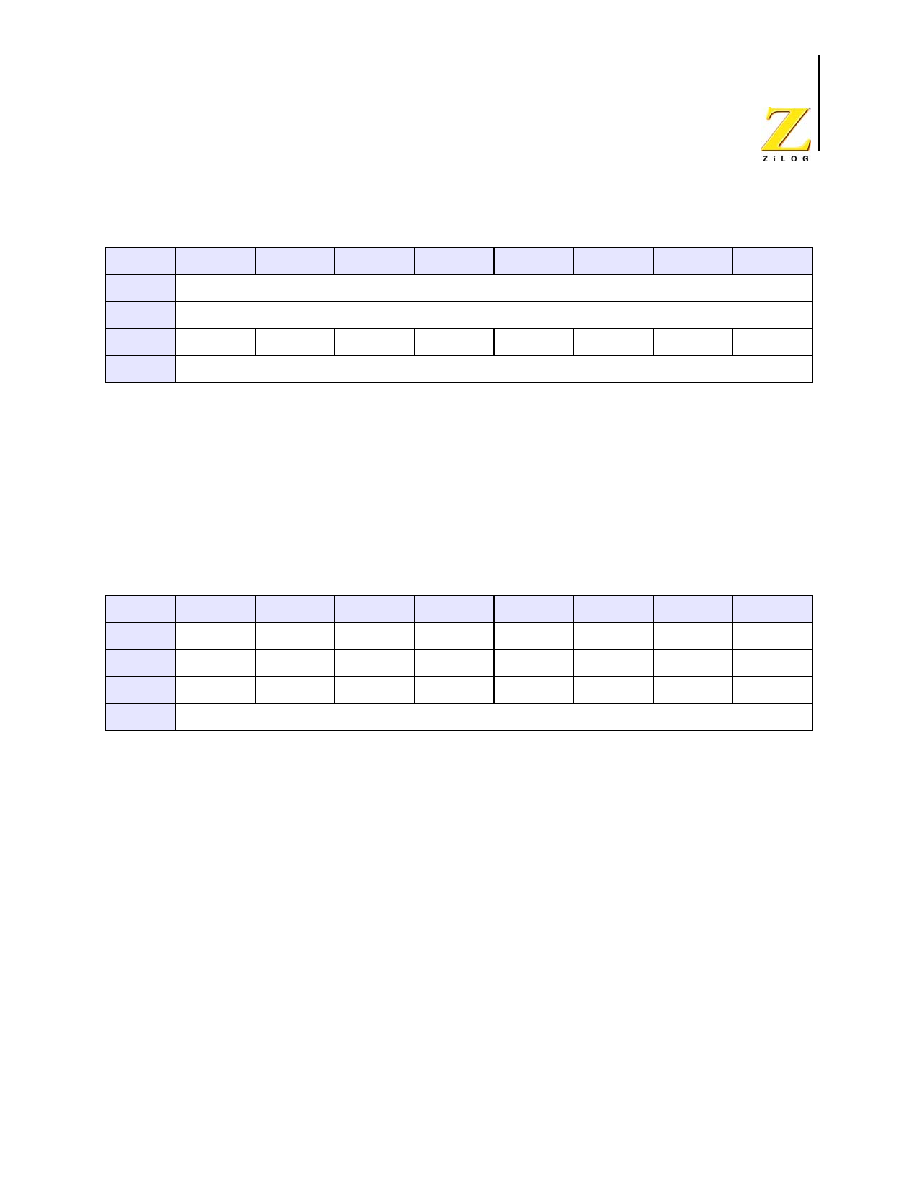
PS024302-0904
P R E L I M I N A R Y General-Purpose
I/O
Z8 Encore!
Æ
4K Series
Product Specification
40
PCTL[7:0]--Port Control
The Port Control register provides access to all sub-registers that configure the GPIO Port
operation.
Port A≠C Data Direction Sub-Registers
The Port A≠C Data Direction sub-register is accessed through the Port A≠C Control regis-
ter by writing 01H to the Port A≠C Address register (Table 20).
DD[7:0]--Data Direction
These bits control the direction of the associated port pin. Port Alternate Function opera-
tion overrides the Data Direction register setting.
0 = Output. Data in the Port A≠C Output Data register is driven onto the port pin.
1 = Input. The port pin is sampled and the value written into the Port A≠C Input Data Reg-
ister. The output driver is tristated.
Port A≠C Alternate Function Sub-Registers
The Port A≠C Alternate Function sub-register (Table 21) is accessed through the Port A≠C
Control register by writing
02H
to the Port A≠C Address register. The Port A≠C Alternate
Function sub-registers enable the alternate function selection on pins. If disabled, pins
functions as GPIO. If enabled, select one of four alternate functions using alternate func-
tion set subregisters 1 and 2 as described in the
"Port A≠C Alternate Function Set 1 Sub-
Registers" on page 43
and
"Port A≠C Alternate Function Set 2 Sub-Registers" on page 44.
Refer
to the
"GPIO Alternate Functions" on page 32
to determine the alternate function
associated with each port pin.
Table 19. Port A≠C Control Registers (PxCTL)
BITS
7
6
5
4
3
2
1
0
FIELD
PCTL
RESET
00H
R/W
R/W
R/W
R/W
R/W
R/W
R/W
R/W
R/W
ADDR
FD1H, FD5H, FD9H
Table 20. Port A≠C Data Direction Sub-Registers (PxDD)
BITS
7
6
5
4
3
2
1
0
FIELD
DD7
DD6
DD5
DD4
DD3
DD2
DD1
DD0
RESET
1
1
1
1
1
1
1
1
R/W
R/W
R/W
R/W
R/W
R/W
R/W
R/W
R/W
ADDR
If 01H in Port A≠C Address Register, accessible through the Port A≠C Control Register
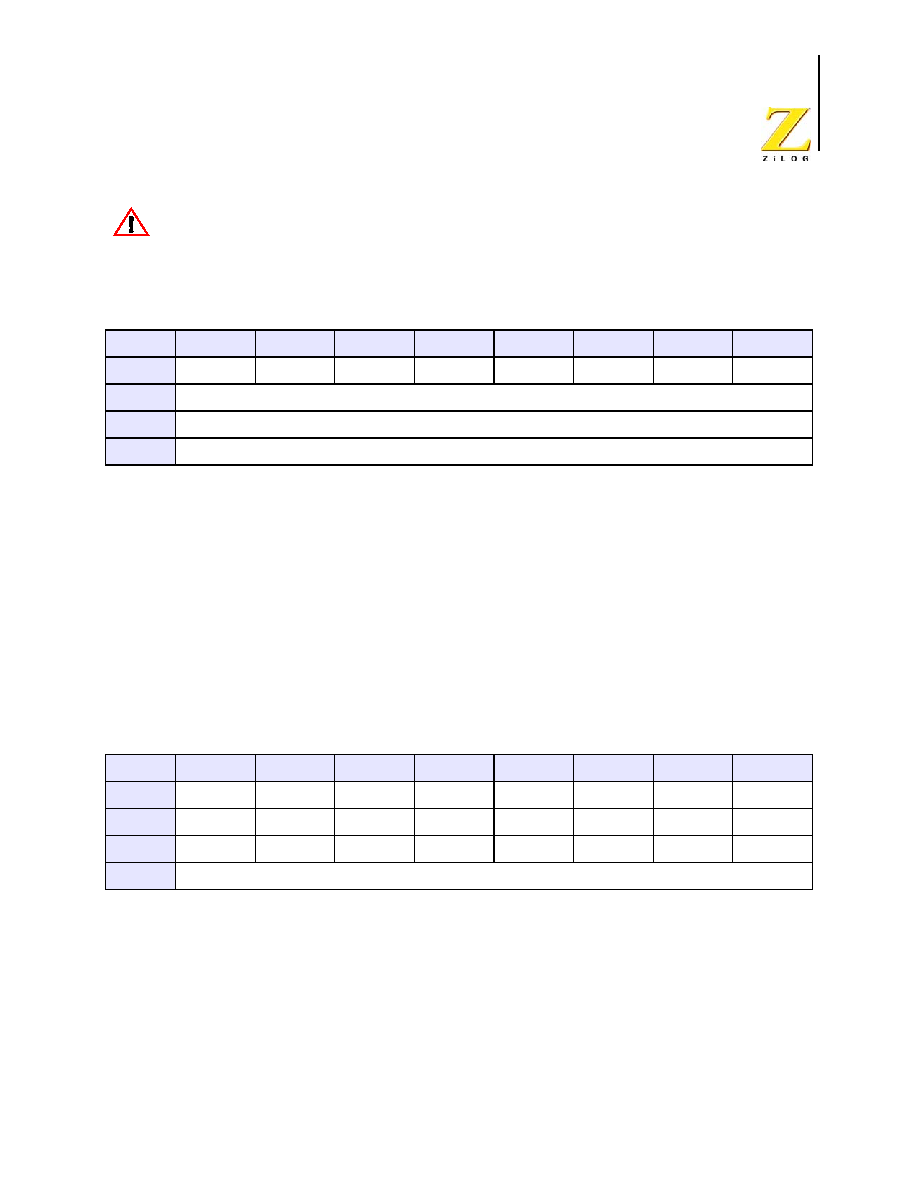
PS024302-0904
P R E L I M I N A R Y General-Purpose
I/O
Z8 Encore!
Æ
4K Series
Product Specification
41
Do not enable alternate functions for GPIO port pins for which there is no
associated alternate function. Failure to follow this guideline can result in
unpredictable operation.
AF[7:0]--Port Alternate Function enabled
0 = The port pin is in normal mode and the DDx bit in the Port A≠C Data Direction sub-
register determines the direction of the pin.
1 = The alternate function selected through Alternate Function Set sub-registers is
enabled. Port pin operation is controlled by the alternate function.
Port A≠C Output Control Sub-Registers
The Port A≠C Output Control sub-register (Table 22) is accessed through the Port A≠C
Control register by writing
03H
to the Port A≠C Address register. Setting the bits in the
Port A≠C Output Control sub-registers to 1 configures the specified port pins for open-
drain operation. These sub-registers affect the pins directly and, as a result, alternate func-
tions are also affected.
POC[7:0]--Port Output Control
These bits function independently of the alternate function bit and always disable the
drains if set to 1.
0 = The drains are enabled for any output mode (unless overridden by the alternate func-
tion).
1 = The drain of the associated pin is disabled (open-drain mode).
Table 21. Port A≠C Alternate Function Sub-Registers (PxAF)
BITS
7
6
5
4
3
2
1
0
FIELD
AF7
AF6
AF5
AF4
AF3
AF2
AF1
AF0
RESET
00H (Ports A≠C)
R/W
R/W
ADDR
If 02H in Port A≠C Address Register, accessible through the Port A≠C Control Register
Table 22. Port A≠C Output Control Sub-Registers (PxOC)
BITS
7
6
5
4
3
2
1
0
FIELD
POC7
POC6
POC5
POC4
POC3
POC2
POC1
POC0
RESET
0
0
0
0
0
0
0
0
R/W
R/W
R/W
R/W
R/W
R/W
R/W
R/W
R/W
ADDR
If 03H in Port A≠C Address Register, accessible through the Port A≠C Control Register
Caution:
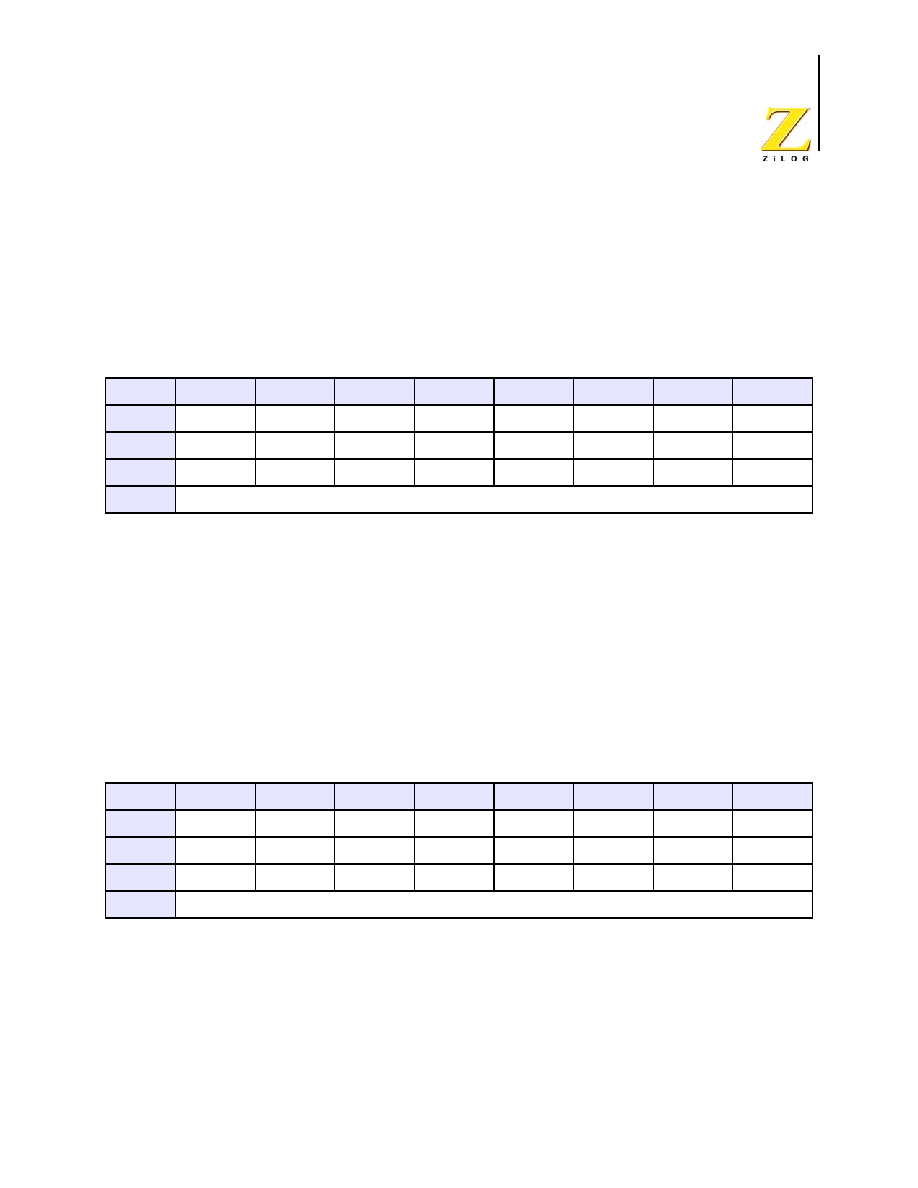
PS024302-0904
P R E L I M I N A R Y General-Purpose
I/O
Z8 Encore!
Æ
4K Series
Product Specification
42
Port A≠C High Drive Enable Sub-Registers
The Port A≠C High Drive Enable sub-register (Table 23) is accessed through the Port
A≠C Control register by writing
04H
to the Port A≠C Address register. Setting the bits in
the Port A≠C High Drive Enable sub-registers to 1 configures the specified port pins for
high current output drive operation. The Port A≠C High Drive Enable sub-register affects
the pins directly and, as a result, alternate functions are also affected.
PHDE[7:0]--Port High Drive Enabled
0 = The Port pin is configured for standard output current drive.
1 = The Port pin is configured for high output current drive.
Port A≠C STOP Mode Recovery Source Enable Sub-Registers
The Port A≠C STOP Mode Recovery Source Enable sub-register (Table 24) is accessed
through the Port A≠C Control register by writing
05H
to the Port A≠C Address register.
Setting the bits in the Port A≠C STOP Mode Recovery Source Enable sub-registers to 1
configures the specified Port pins as a STOP Mode Recovery source. During STOP Mode,
any logic transition on a Port pin enabled as a STOP Mode Recovery source initiates
STOP Mode Recovery.
PSMRE[7:0]--Port STOP Mode Recovery Source Enabled
0 = The Port pin is not configured as a STOP Mode Recovery source. Transitions on this
pin during STOP mode do not initiate STOP Mode Recovery.
1 = The Port pin is configured as a STOP Mode Recovery source. Any logic transition on
this pin during STOP mode initiates STOP Mode Recovery.
Table 23. Port A≠C High Drive Enable Sub-Registers (PxHDE)
BITS
7
6
5
4
3
2
1
0
FIELD
PHDE7
PHDE6
PHDE5
PHDE4
PHDE3
PHDE2
PHDE1
PHDE0
RESET
0
0
0
0
0
0
0
0
R/W
R/W
R/W
R/W
R/W
R/W
R/W
R/W
R/W
ADDR
If 04H in Port A≠C Address Register, accessible through the Port A≠C Control Register
Table 24. Port A≠C STOP Mode Recovery Source Enable Sub-Registers (PxSMRE)
BITS
7
6
5
4
3
2
1
0
FIELD
PSMRE7
PSMRE6
PSMRE5
PSMRE4
PSMRE3
PSMRE2
PSMRE1
PSMRE0
RESET
0
0
0
0
0
0
0
0
R/W
R/W
R/W
R/W
R/W
R/W
R/W
R/W
R/W
ADDR
If 05H in Port A≠C Address Register, accessible through the Port A≠C Control Register
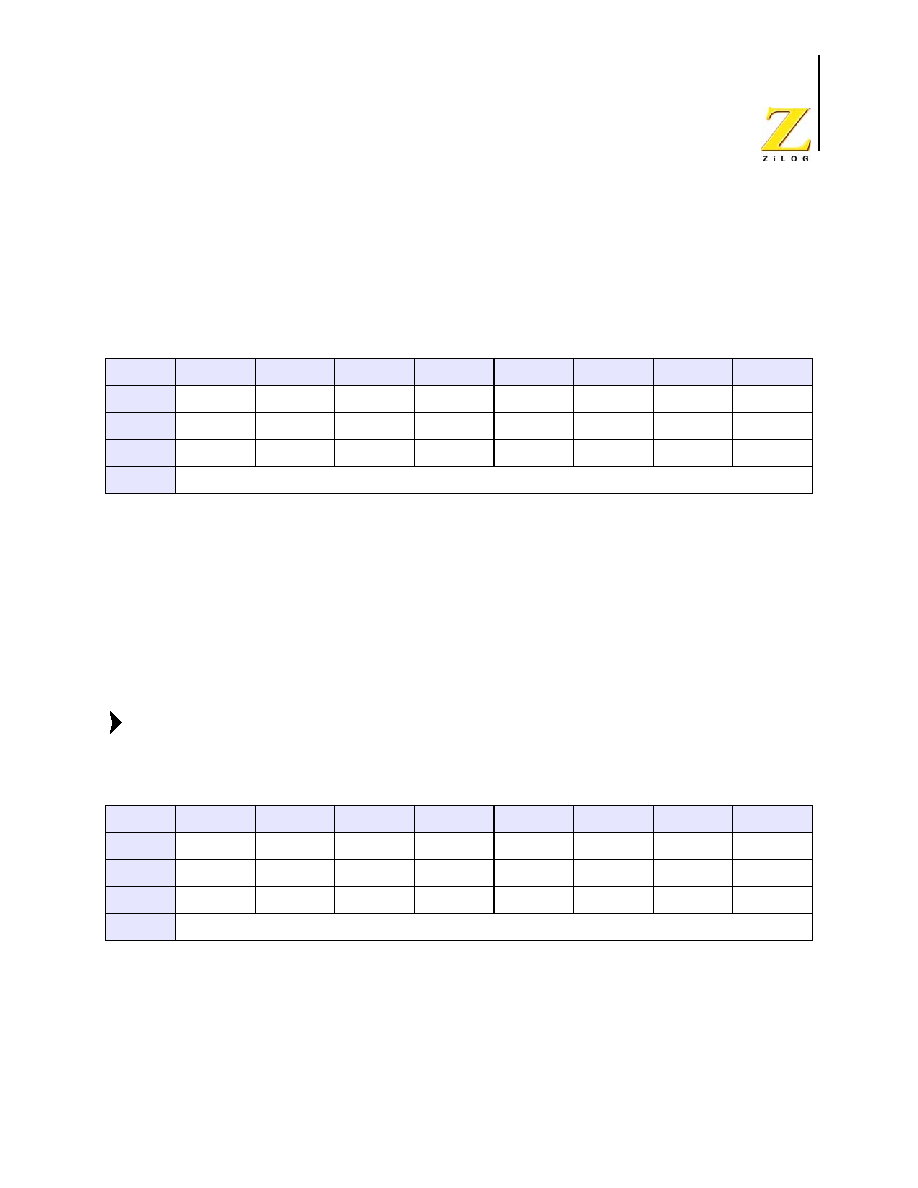
PS024302-0904
P R E L I M I N A R Y General-Purpose
I/O
Z8 Encore!
Æ
4K Series
Product Specification
43
Port A≠C Pull-up Enable Sub-Registers
The Port A≠C Pull-up Enable sub-register (Table 25) is accessed through the Port A≠C
Control register by writing
06H
to the Port A≠C Address register. Setting the bits in the
Port A≠C Pull-up Enable sub-registers enables a weak internal resistive pull-up on the
specified Port pins.
PPUE[7:0]--Port Pull-up Enabled
0 = The weak pull-up on the Port pin is disabled.
1 = The weak pull-up on the Port pin is enabled.
Port A≠C Alternate Function Set 1 Sub-Registers
The Port A≠C Alternate Function Set1 sub-register (Table 26) is accessed through the Port
A≠C Control register by writing
07H
to the Port A≠C Address register. The Alternate
Function Set 1 sub-registers selects the alternate function available at a port pin. Alternate
Functions selected by setting or clearing bits of this register are defined in
"GPIO Alternate
Functions" on page 32
.
Alternate function selection on port pins must also be enabled as described in
"Port A≠C
Alternate Function Sub-Registers" on page 40.
PAFS1[7:0]--Port Alternate Function Set 1
0 = Port Alternate Function selected as defined in Table 14 in the
GPIO Alternate Functions
section.
1 = Port Alternate Function selected as defined in Table 14 in the
GPIO Alternate Functions
section.
Table 25. Port A≠C Pull-Up Enable Sub-Registers (PxPUE)
BITS
7
6
5
4
3
2
1
0
FIELD
PPUE7
PPUE6
PPUE5
PPUE4
PPUE3
PPUE2
PPUE1
PPUE0
RESET
0
0
0
0
0
0
0
0
R/W
R/W
R/W
R/W
R/W
R/W
R/W
R/W
R/W
ADDR
If 06H in Port A
≠
C Address Register, accessible through the Port A
≠
C Control Register
Table 26. Port A≠C Alternate Function Set 1 Sub-Registers (PxAFS1)
BITS
7
6
5
4
3
2
1
0
FIELD
PAFS17
PAFS16
PAFS15
PAFS14
PAFS13
PAFS12
PAFS11
PAFS10
RESET
0
0
0
0
0
0
0
0
R/W
R/W
R/W
R/W
R/W
R/W
R/W
R/W
R/W
ADDR
If 07H in Port A≠C Address Register, accessible through the Port A≠C Control Register
Note:
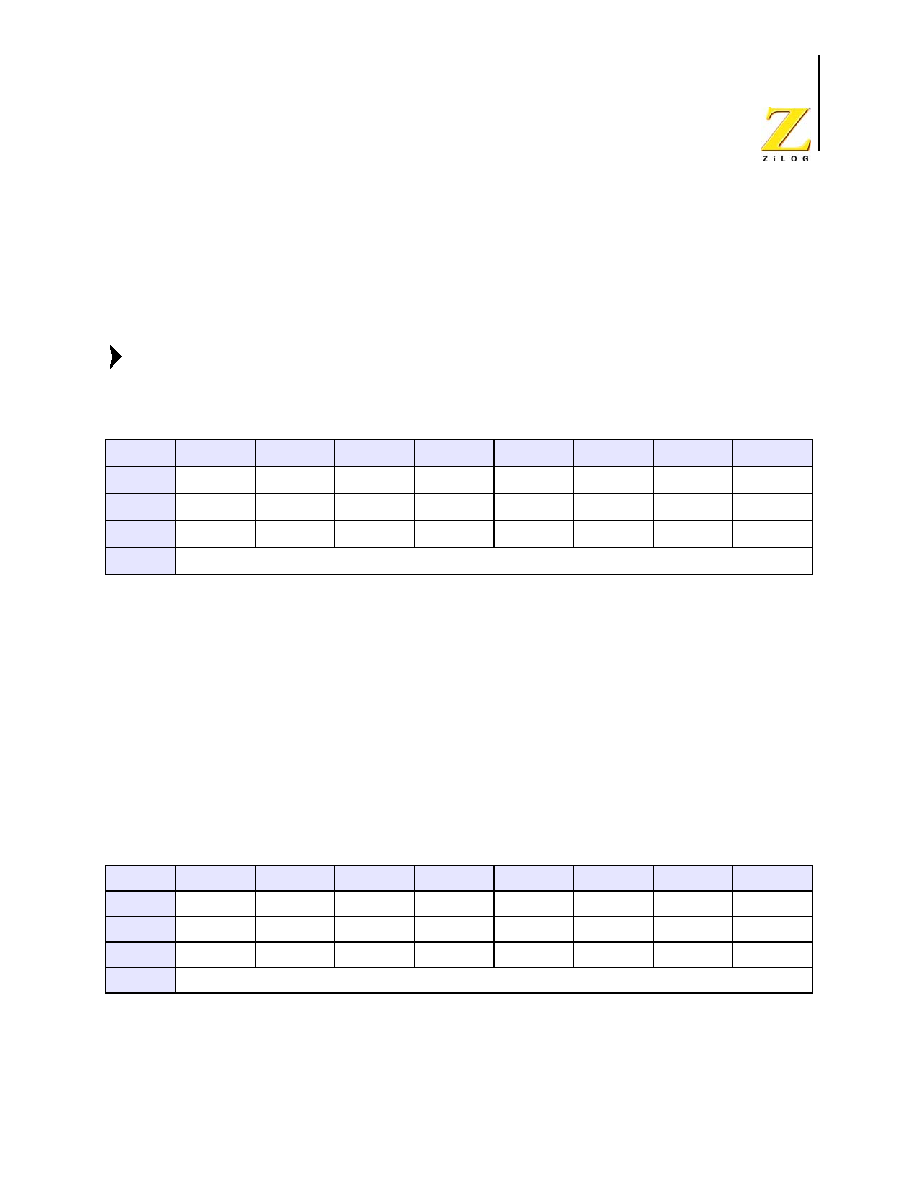
PS024302-0904
P R E L I M I N A R Y General-Purpose
I/O
Z8 Encore!
Æ
4K Series
Product Specification
44
Port A≠C Alternate Function Set 2 Sub-Registers
The Port A≠C Alternate Function Set 2 sub-register (Table 27) is accessed through the
Port A≠C Control register by writing
08H
to the Port A≠C Address register. The Alternate
Function Set 2 sub-registers selects the alternate function available at a port pin. Alternate
Functions selected by setting or clearing bits of this register is defined in Table 14 in the
section
"GPIO Alternate Functions" on page 32
.
Alternate function selection on port pins must also be enabled as described in
"Port A≠C
Alternate Function Sub-Registers" on page 40.
PAFS2[7:0]--Port Alternate Function Set 2
0 = Port Alternate Function selected as defined in Table 14
GPIO Alternate Functions
sec-
tion.
1 = Port Alternate Function selected as defined in Table 14
GPIO Alternate Functions
sec-
tion.
Port A≠C Input Data Registers
Reading from the Port A≠C Input Data registers (Table 28) returns the sampled values
from the corresponding port pins. The Port A≠C Input Data registers are read-only. The
value returned for any unused ports is 0. Unused ports include those missing on the 8- and
28-pin packages, as well as those missing on the ADC-enabled 28-pin packages.
PIN[7:0]--Port Input Data
Sampled data from the corresponding port pin input.
0 = Input data is logical 0 (Low).
1 = Input data is logical 1 (High).
Table 27. Port A≠C Alternate Function Set 2 Sub-Registers (PxAFS2)
BITS
7
6
5
4
3
2
1
0
FIELD
PAFS27
PAFS26
PAFS25
PAFS24
PAFS23
PAFS22
PAFS21
PAFS20
RESET
0
0
0
0
0
0
0
0
R/W
R/W
R/W
R/W
R/W
R/W
R/W
R/W
R/W
ADDR
If 08H in Port A≠C Address Register, accessible through the Port A≠C Control Register
Table 28. Port A≠C Input Data Registers (PxIN)
BITS
7
6
5
4
3
2
1
0
FIELD
PIN7
PIN6
PIN5
PIN4
PIN3
PIN2
PIN1
PIN0
RESET
X
X
X
X
X
X
X
X
R/W
R
R
R
R
R
R
R
R
ADDR
FD2H, FD6H, FDAH
Note:
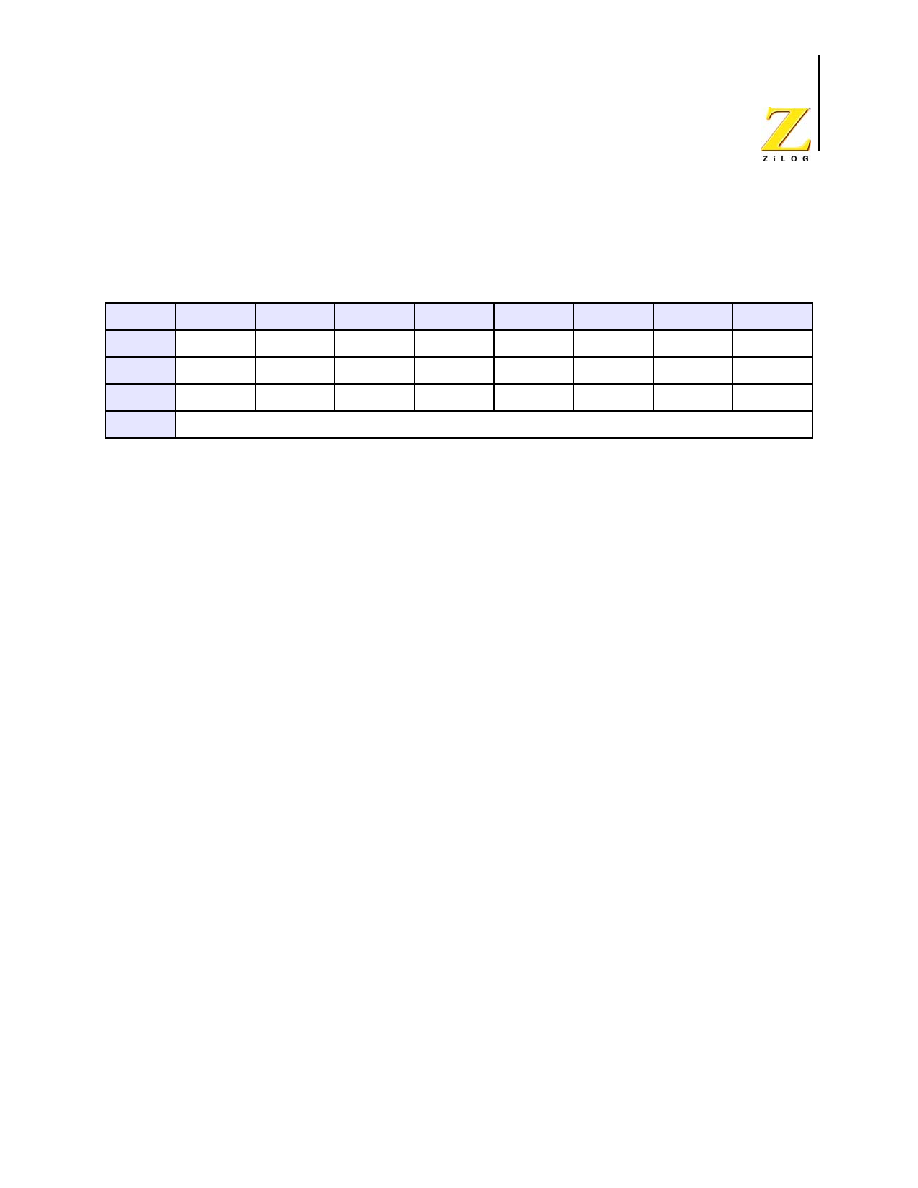
PS024302-0904
P R E L I M I N A R Y General-Purpose
I/O
Z8 Encore!
Æ
4K Series
Product Specification
45
Port A≠C Output Data Register
The Port A≠C Output Data register (Table 29) controls the output data to the pins.
POUT[7:0]--Port Output Data
These bits contain the data to be driven to the port pins. The values are only driven if the
corresponding pin is configured as an output and the pin is not configured for alternate
function operation.
0 = Drive a logical 0 (Low).
1= Drive a logical 1 (High). High value is not driven if the drain has been disabled by set-
ting the corresponding Port Output Control register bit to 1.
Table 29. Port A≠C Output Data Register (PxOUT)
BITS
7
6
5
4
3
2
1
0
FIELD
POUT7
POUT6
POUT5
POUT4
POUT3
POUT2
POUT1
POUT0
RESET
0
0
0
0
0
0
0
0
R/W
R/W
R/W
R/W
R/W
R/W
R/W
R/W
R/W
ADDR
FD3H, FD7H, FDBH

PS024302-0904
P R E L I M I N A R Y Interrupt
Controller
Z8 Encore!
Æ
4K Series
Product Specification
46
Interrupt Controller
Overview
The interrupt controller on the 4K Series products prioritizes the interrupt requests from
the on-chip peripherals and the GPIO port pins. The features of the interrupt controller
include the following:
∑
20 unique interrupt vectors:
≠
14 GPIO port pin interrupt sources (two are shared)
≠
10 on-chip peripheral interrupt sources (two are shared)
∑
Flexible GPIO interrupts
≠
8 selectable rising and falling edge GPIO interrupts
≠
4 dual-edge interrupts
∑
3 levels of individually programmable interrupt priority
∑
Watch-Dog Timer can be configured to generate an interrupt
Interrupt requests (IRQs) allow peripheral devices to suspend CPU operation in an orderly
manner and force the CPU to start an interrupt service routine (ISR). Usually this interrupt
service routine is involved with the exchange of data, status information, or control infor-
mation between the CPU and the interrupting peripheral. When the service routine is com-
pleted, the CPU returns to the operation from which it was interrupted.
The eZ8 CPU supports both vectored and polled interrupt handling. For polled interrupts,
the interrupt controller has no effect on operation. Refer to the eZ8 CPU User Manual for
more information regarding interrupt servicing by the eZ8 CPU. The eZ8 CPU User Man-
ual is available for download at
www.zilog.com
.
Interrupt Vector Listing
Table 30 lists all of the interrupts available in order of priority. The interrupt vector is
stored with the most significant byte (MSB) at the even Program Memory address and the
least significant byte (LSB) at the following odd Program Memory address.
Some port interrupts are not available on the 8- and 20-pin packages. The ADC interrupt is
unavailable on devices not containing an ADC.
Note:

PS024302-0904
P R E L I M I N A R Y Interrupt
Controller
Z8 Encore!
Æ
4K Series
Product Specification
47
Table 30. Trap and Interrupt Vectors in Order of Priority
Priority
Program
Memory
Vector Address Interrupt or Trap Source
Highest 0002H
Reset (not an interrupt)
0004H
Watch-Dog Timer (see Watch-Dog Timer chapter)
0006H
Illegal Instruction Trap (not an interrupt)
0008H
Reserved
000AH
Timer 1
000CH
Timer 0
000EH
UART 0 receiver
0010H
UART 0 transmitter
0012H
Reserved
0014H
Reserved
0016H
ADC
0018H
Port A7, selectable rising or falling input edge
001AH
Port A6, selectable rising or falling input edge
001CH
Port A5, selectable rising or falling input edge
001EH
Port A4, selectable rising or falling input edge
0020H
Port A3 or Port D3, selectable rising or falling input edge
0022H
Port A2 or Port D2, selectable rising or falling input edge
0024H
Port A1, selectable rising or falling input edge
0026H
Port A0, selectable rising or falling input edge
0028H
Reserved
002AH
Reserved
002CH
Reserved
002EH
Reserved
0030H
Port C3, both input edges
0032H
Port C2, both input edges
0034H
Port C1, both input edges
Lowest
0036H
Port C0, both input edges
0038H
Reserved

PS024302-0904
P R E L I M I N A R Y Interrupt
Controller
Z8 Encore!
Æ
4K Series
Product Specification
48
Architecture
Figure 8 illustrates the interrupt controller block diagram.
Figure 8.Interrupt Controller Block Diagram
Operation
Master Interrupt Enable
The master interrupt enable bit (IRQE) in the Interrupt Control register globally enables
and disables interrupts.
Interrupts are globally enabled by any of the following actions:
∑
Execution of an EI (Enable Interrupt) instruction
003AH
Reserved
003CH
Reserved
Table 30. Trap and Interrupt Vectors in Order of Priority (Continued)
Priority
Program
Memory
Vector Address Interrupt or Trap Source
Vector
IRQ Request
High
Priority
Medium
Priority
Low
Priority
Priority
Mux
Interrupt
Requ
est La
tch
e
s a
nd
Con
t
rol
Port Interrupts
Internal Interrupts

PS024302-0904
P R E L I M I N A R Y Interrupt
Controller
Z8 Encore!
Æ
4K Series
Product Specification
49
∑
Execution of an IRET (Return from Interrupt) instruction
∑
Writing a 1 to the IRQE bit in the Interrupt Control register
Interrupts are globally disabled by any of the following actions:
∑
Execution of a DI (Disable Interrupt) instruction
∑
eZ8 CPU acknowledgement of an interrupt service request from the interrupt controller
∑
Writing a 0 to the IRQE bit in the Interrupt Control register
∑
Reset
∑
Execution of a Trap instruction
∑
Illegal Instruction Trap
Interrupt Vectors and Priority
The interrupt controller supports three levels of interrupt priority. Level 3 is the highest
priority, Level 2 is the second highest priority, and Level 1 is the lowest priority. If all of
the interrupts are enabled with identical interrupt priority (all as Level 2 interrupts, for
example), the interrupt priority is assigned from highest to lowest as specified in Table 30
on page 47. Level 3 interrupts are always assigned higher priority than Level 2 interrupts
which, in turn, always are assigned higher priority than Level 1 interrupts. Within each
interrupt priority level (Level 1, Level 2, or Level 3), priority is assigned as specified in
Table 30, above. Reset, Watch-Dog Timer interrupt (if enabled) and Illegal Instruction
Traps always command (level 3) priority.
Interrupt Assertion
Interrupt sources assert their interrupt requests for only a single system clock period (sin-
gle pulse). When the interrupt request is acknowledged by the eZ8 CPU, the correspond-
ing bit in the Interrupt Request register is cleared until the next interrupt occurs. Writing a
0 to the corresponding bit in the Interrupt Request register likewise clears the interrupt
request.
The following coding style that clears bits in the Interrupt Request registers is NOT rec-
ommended. All incoming interrupts received between execution of the first LDX com-
mand and the final LDX command are lost.
Poor coding style that can result in lost interrupt requests:
LDX r0, IRQ0
AND r0, MASK
LDX IRQ0, r0
Caution:

PS024302-0904
P R E L I M I N A R Y Interrupt
Controller
Z8 Encore!
Æ
4K Series
Product Specification
50
To avoid missing interrupts, use the following coding style to clear bits in
the Interrupt Request 0 register:
Good coding style that avoids lost interrupt requests:
ANDX IRQ0, MASK
Software Interrupt Assertion
Program code can generate interrupts directly. Writing a 1 to the correct bit in the Interrupt
Request register triggers an interrupt (assuming that interrupt is enabled). When the inter-
rupt request is acknowledged by the eZ8 CPU, the bit in the Interrupt Request register is
automatically cleared to 0.
The following coding style used to generate software interrupts by setting bits in the In-
terrupt Request registers is NOT recommended. All incoming interrupts received be-
tween execution of the first LDX command and the final LDX command are lost.
Poor coding style that can result in lost interrupt requests:
LDX r0, IRQ0
OR r0, MASK
LDX IRQ0, r0
To avoid missing interrupts, use the following coding style to set bits in the Interrupt Re-
quest registers:
Good coding style that avoids lost interrupt requests:
ORX IRQ0, MASK
Interrupt Control Register Definitions
For all interrupts other than the Watch-Dog Timer interrupt, the Primary Oscillator Fail
Trap, and the Watchdog Oscillator Fail Trap, the interrupt control registers enable individ-
ual interrupts, set interrupt priorities, and indicate interrupt requests.
Interrupt Request 0 Register
The Interrupt Request 0 (IRQ0) register (Table 31) stores the interrupt requests for both
vectored and polled interrupts. When a request is presented to the interrupt controller, the
corresponding bit in the IRQ0 register becomes 1. If interrupts are globally enabled (vec-
tored interrupts), the interrupt controller passes an interrupt request to the eZ8 CPU. If
interrupts are globally disabled (polled interrupts), the eZ8 CPU can read the Interrupt
Request 0 register to determine if any interrupt requests are pending.
Caution:
Caution:
Caution:
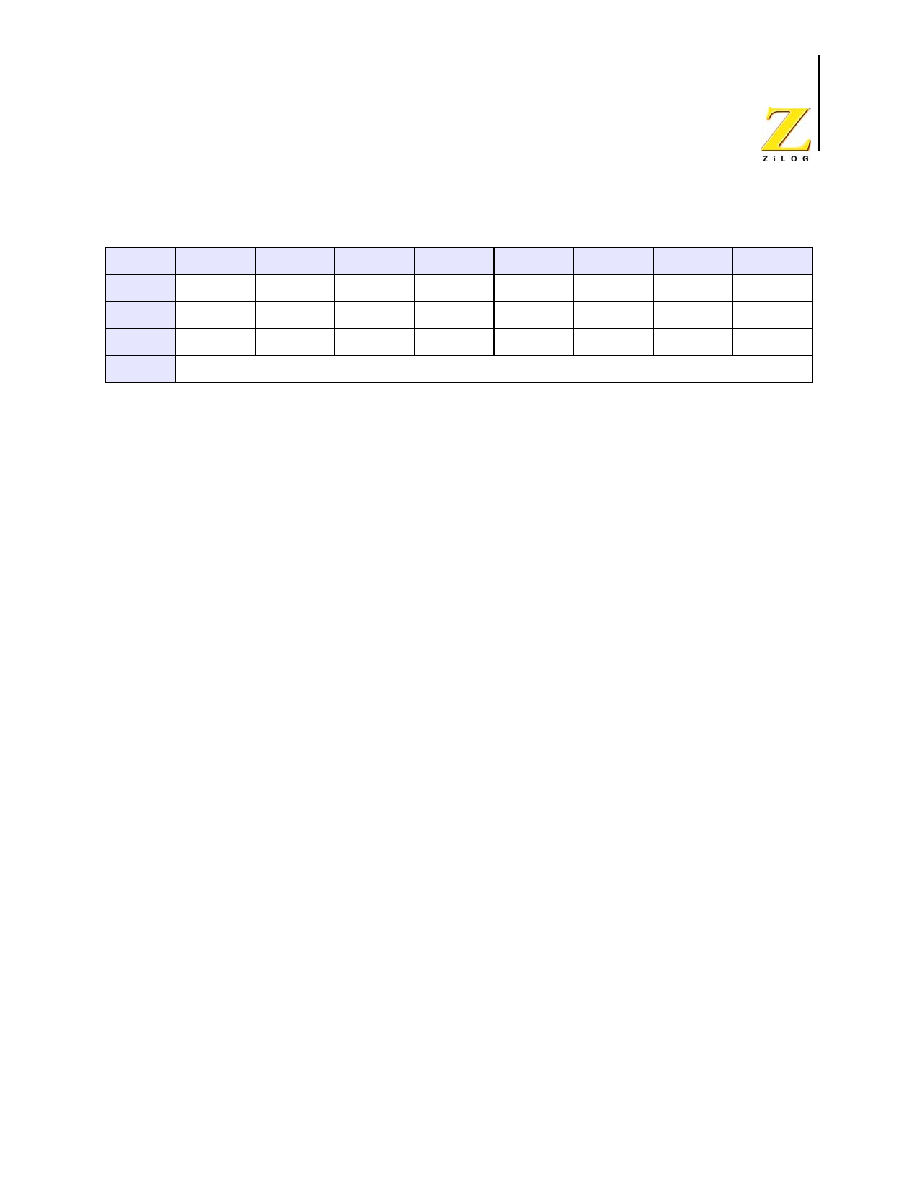
PS024302-0904
P R E L I M I N A R Y Interrupt
Controller
Z8 Encore!
Æ
4K Series
Product Specification
51
Reserved--Must be 0.
T1I--Timer 1 Interrupt Request
0 = No interrupt request is pending for Timer 1.
1 = An interrupt request from Timer 1 is awaiting service.
T0I--Timer 0 Interrupt Request
0 = No interrupt request is pending for Timer 0.
1 = An interrupt request from Timer 0 is awaiting service.
U0RXI--UART 0 Receiver Interrupt Request
0 = No interrupt request is pending for the UART 0 receiver.
1 = An interrupt request from the UART 0 receiver is awaiting service.
U0TXI--UART 0 Transmitter Interrupt Request
0 = No interrupt request is pending for the UART 0 transmitter.
1 = An interrupt request from the UART 0 transmitter is awaiting service.
ADCI--ADC Interrupt Request
0 = No interrupt request is pending for the Analog-to-Digital Converter.
1 = An interrupt request from the Analog-to-Digital Converter is awaiting service.
Interrupt Request 1 Register
The Interrupt Request 1 (IRQ1) register (Table 32) stores interrupt requests for both vec-
tored and polled interrupts. When a request is presented to the interrupt controller, the cor-
responding bit in the IRQ1 register becomes 1. If interrupts are globally enabled (vectored
interrupts), the interrupt controller passes an interrupt request to the eZ8 CPU. If interrupts
are globally disabled (polled interrupts), the eZ8 CPU can read the Interrupt Request 1
register to determine if any interrupt requests are pending.
Table 31. Interrupt Request 0 Register (IRQ0)
BITS
7
6
5
4
3
2
1
0
FIELD
Reserved
T1I
T0I
U0RXI
U0TXI
Reserved Reserved
ADCI
RESET
0
0
0
0
0
0
0
0
R/W
R/W
R/W
R/W
R/W
R/W
R/W
R/W
R/W
ADDR
FC0H
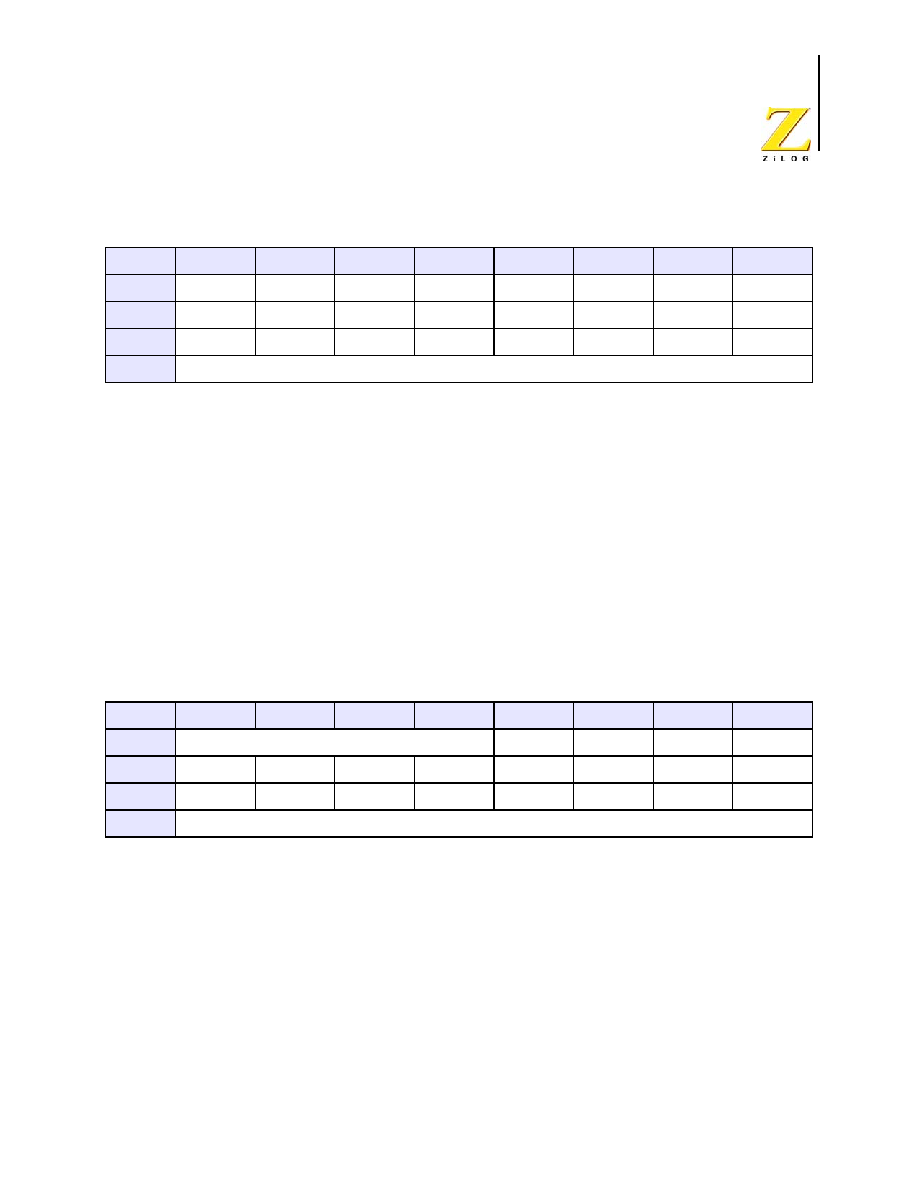
PS024302-0904
P R E L I M I N A R Y Interrupt
Controller
Z8 Encore!
Æ
4K Series
Product Specification
52
PAxI--Port A Pin x Interrupt Request
0 = No interrupt request is pending for GPIO Port A pin x.
1 = An interrupt request from GPIO Port A pin x is awaiting service.
where x indicates the specific GPIO Port pin number (0≠7).
Interrupt Request 2 Register
The Interrupt Request 2 (IRQ2) register (Table 33) stores interrupt requests for both vec-
tored and polled interrupts. When a request is presented to the interrupt controller, the cor-
responding bit in the IRQ2 register becomes 1. If interrupts are globally enabled (vectored
interrupts), the interrupt controller passes an interrupt request to the eZ8 CPU. If interrupts
are globally disabled (polled interrupts), the eZ8 CPU can read the Interrupt Request 2
register to determine if any interrupt requests are pending.
Reserved--Must be 0.
PCxI--Port C Pin x Interrupt Request
0 = No interrupt request is pending for GPIO Port C pin x.
1 = An interrupt request from GPIO Port C pin x is awaiting service.
where x indicates the specific GPIO Port C pin number (0≠3).
IRQ0 Enable High and Low Bit Registers
Table 34 describes the priority control for IRQ0. The IRQ0 Enable High and Low Bit reg-
isters (Tables 35 and 36) form a priority encoded enabling for interrupts in the Interrupt
Request 0 register. Priority is generated by setting bits in each register.
Table 32. Interrupt Request 1 Register (IRQ1)
BITS
7
6
5
4
3
2
1
0
FIELD
PA7I
PA6I
PA5I
PA4I
PA3I
PA2I
PA1I
PA0I
RESET
0
0
0
0
0
0
0
0
R/W
R/W
R/W
R/W
R/W
R/W
R/W
R/W
R/W
ADDR
FC3H
Table 33. Interrupt Request 2 Register (IRQ2)
BITS
7
6
5
4
3
2
1
0
FIELD
Reserved
PC3I
PC2I
PC1I
PC0I
RESET
0
0
0
0
0
0
0
0
R/W
R/W
R/W
R/W
R/W
R/W
R/W
R/W
R/W
ADDR
FC6H
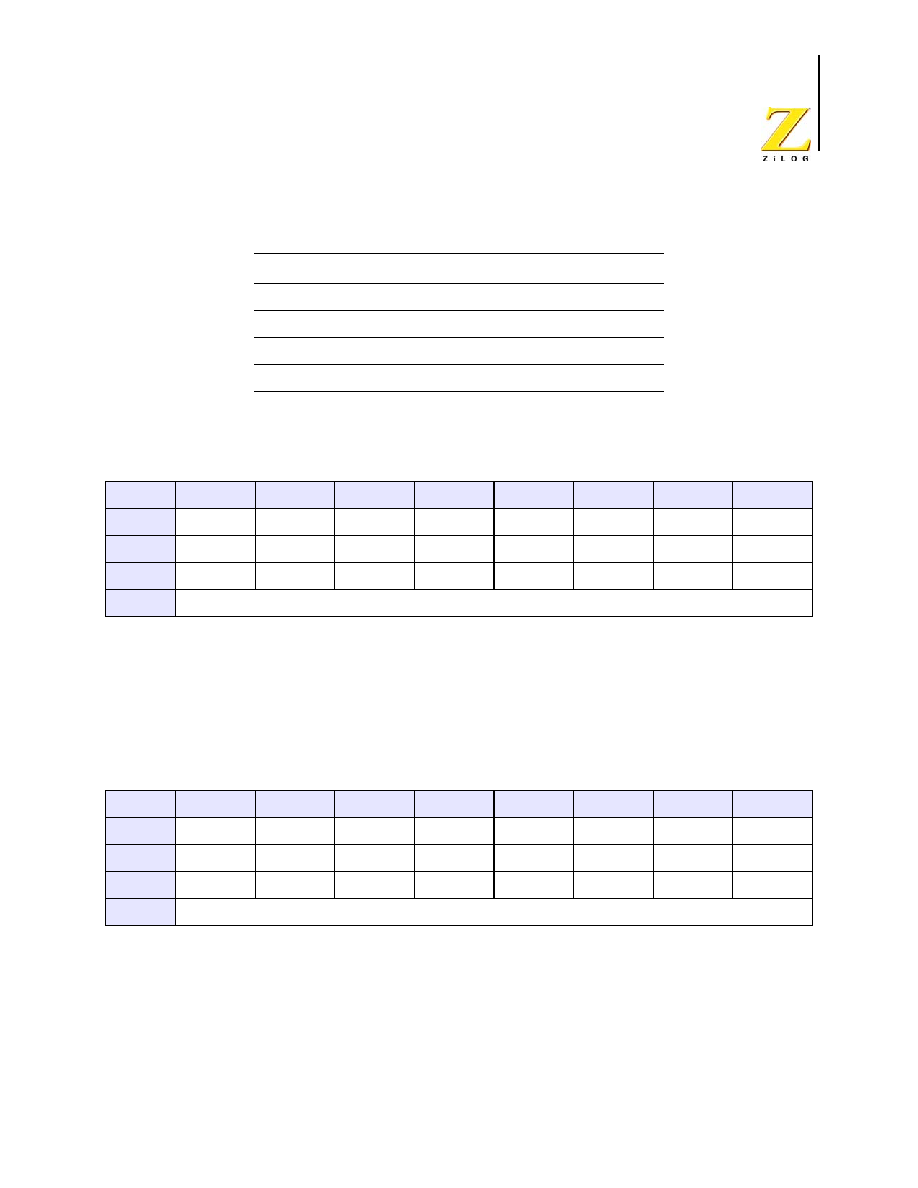
PS024302-0904
P R E L I M I N A R Y Interrupt
Controller
Z8 Encore!
Æ
4K Series
Product Specification
53
Reserved--Must be 0.
T1ENH--Timer 1 Interrupt Request Enable High Bit
T0ENH--Timer 0 Interrupt Request Enable High Bit
U0RENH--UART 0 Receive Interrupt Request Enable High Bit
U0TENH--UART 0 Transmit Interrupt Request Enable High Bit
ADCENH--ADC Interrupt Request Enable High Bit
Reserved--Must be 0.
T1ENL--Timer 1 Interrupt Request Enable Low Bit
T0ENL--Timer 0 Interrupt Request Enable Low Bit
U0RENL--UART 0 Receive Interrupt Request Enable Low Bit
U0TENL--UART 0 Transmit Interrupt Request Enable Low Bit
ADCENL--ADC Interrupt Request Enable Low Bit
Table 34. IRQ0 Enable and Priority Encoding
IRQ0ENH[x] IRQ0ENL[x] Priority
Description
0
0
Disabled
Disabled
0
1
Level 1
Low
1
0
Level 2
Nominal
1
1
Level 3
High
where x indicates the register bits from 0≠7.
Table 35. IRQ0 Enable High Bit Register (IRQ0ENH)
BITS
7
6
5
4
3
2
1
0
FIELD
Reserved
T1ENH
T0ENH
U0RENH
U0TENH
Reserved Reserved ADCENH
RESET
0
0
0
0
0
0
0
0
R/W
R/W
R/W
R/W
R/W
R/W
R/W
R/W
R/W
ADDR
FC1H
Table 36. IRQ0 Enable Low Bit Register (IRQ0ENL)
BITS
7
6
5
4
3
2
1
0
FIELD
Reserved
T1ENL
T0ENL
U0RENL
U0TENL
Reserved Reserved
ADCENL
RESET
0
0
0
0
0
0
0
0
R/W
R
R/W
R/W
R/W
R/W
R
R
R/W
ADDR
FC2H
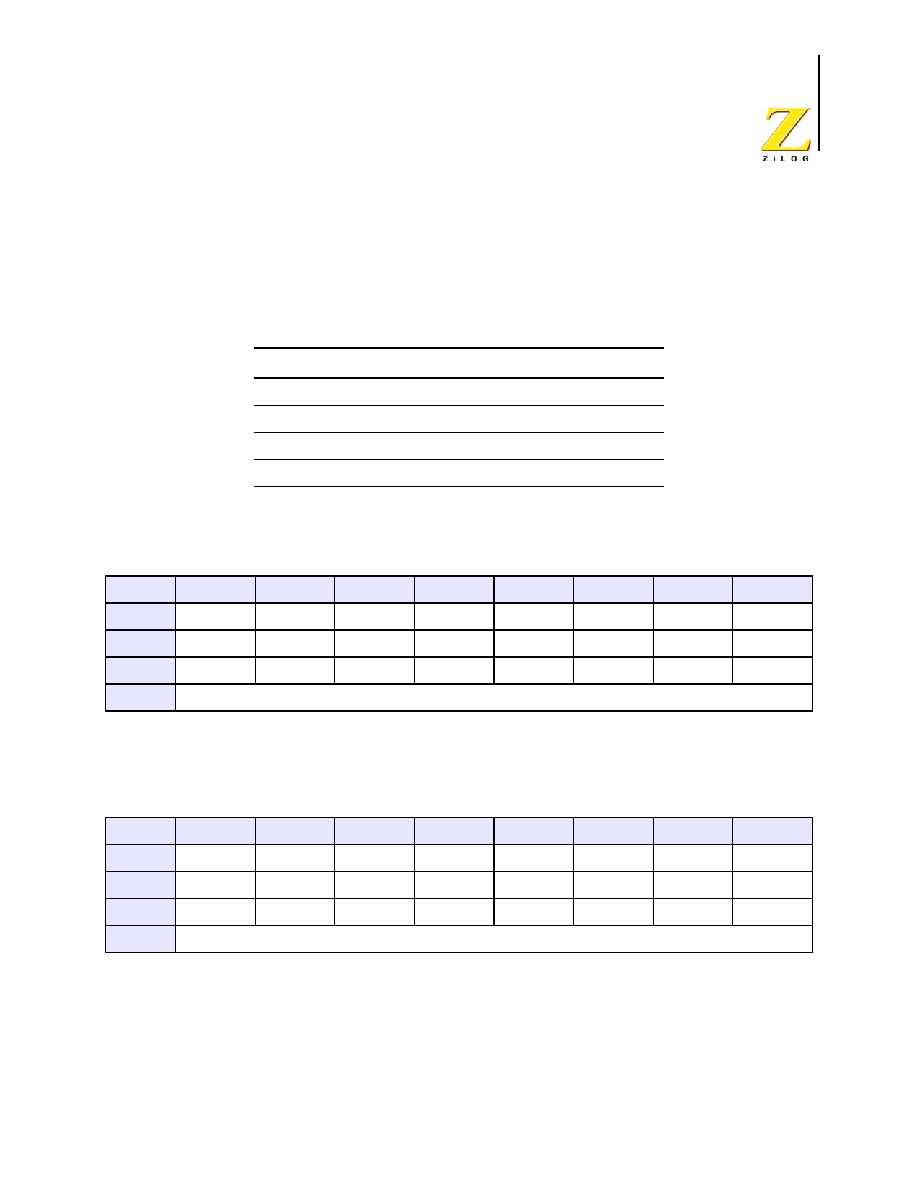
PS024302-0904
P R E L I M I N A R Y Interrupt
Controller
Z8 Encore!
Æ
4K Series
Product Specification
54
IRQ1 Enable High and Low Bit Registers
Table 37 describes the priority control for IRQ1. The IRQ1 Enable High and Low Bit reg-
isters (Tables 38 and 39) form a priority encoded enabling for interrupts in the Interrupt
Request 1 register. Priority is generated by setting bits in each register.
PAxENH--Port A Bit[x] Interrupt Request Enable High Bit
Refer to the Interrupt Port Select register for selection of either Port A or Port D as the
interrupt source.
PAxENL--Port A Bit[x] Interrupt Request Enable Low Bit
Table 37. IRQ1 Enable and Priority Encoding
IRQ1ENH[x] IRQ1ENL[x] Priority
Description
0
0
Disabled
Disabled
0
1
Level 1
Low
1
0
Level 2
Nominal
1
1
Level 3
High
where x indicates the register bits from 0≠7.
Table 38. IRQ1 Enable High Bit Register (IRQ1ENH)
BITS
7
6
5
4
3
2
1
0
FIELD
PA7ENH
PA6ENH
PA5ENH
PA4ENH PAD3ENH PAD2ENH PA1ENH
PA0ENH
RESET
0
0
0
0
0
0
0
0
R/W
R/W
R/W
R/W
R/W
R/W
R/W
R/W
R/W
ADDR
FC4H
Table 39. IRQ1 Enable Low Bit Register (IRQ1ENL)
BITS
7
6
5
4
3
2
1
0
FIELD
PA7ENL
PA6ENL
PA5ENL
PA4ENL
PA3ENL
PA2ENL
PA1ENL
PA0ENL
RESET
0
0
0
0
0
0
0
0
R/W
R/W
R/W
R/W
R/W
R/W
R/W
R/W
R/W
ADDR
FC5H
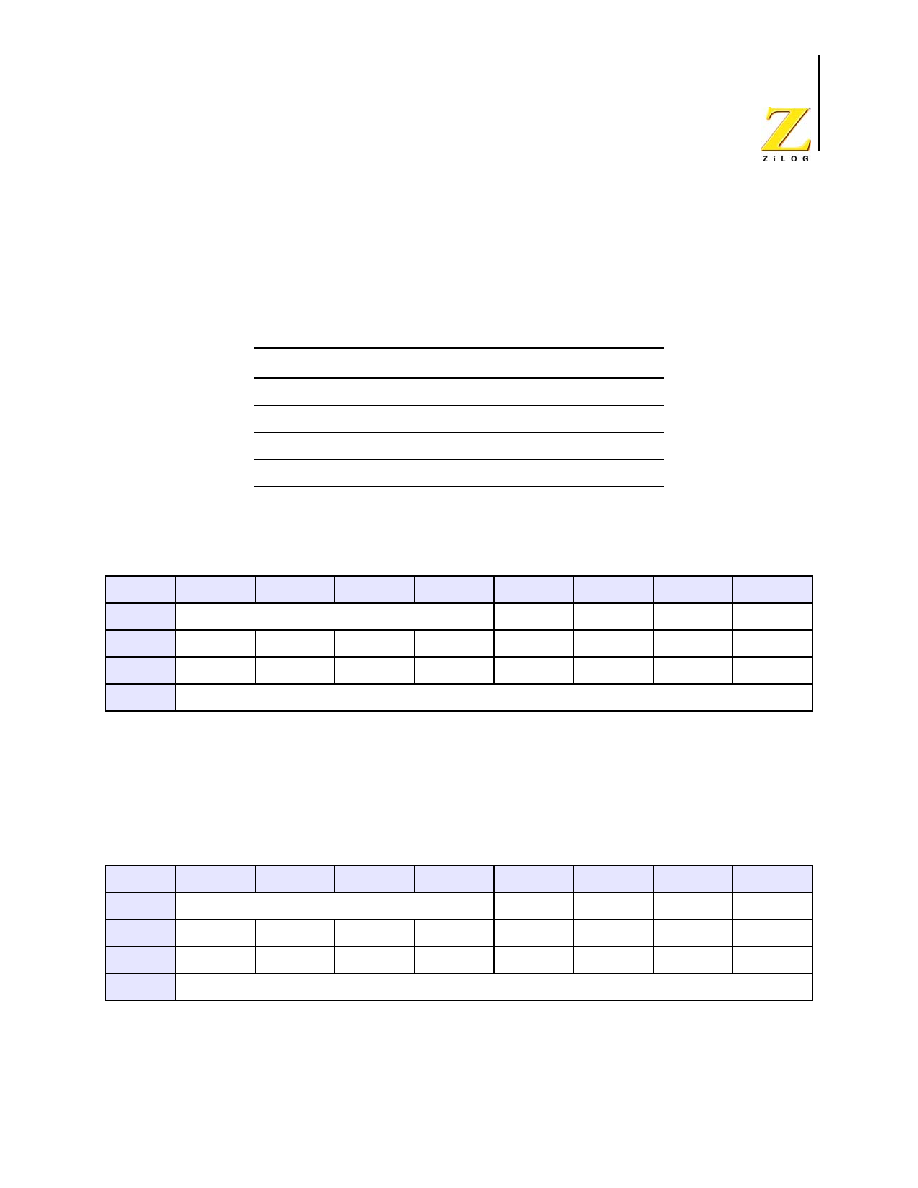
PS024302-0904
P R E L I M I N A R Y Interrupt
Controller
Z8 Encore!
Æ
4K Series
Product Specification
55
IRQ2 Enable High and Low Bit Registers
Table 40 describes the priority control for IRQ2. The IRQ2 Enable High and Low Bit reg-
isters (Tables 41 and 42) form a priority encoded enabling for interrupts in the Interrupt
Request 2 register. Priority is generated by setting bits in each register.
Reserved--Must be 0.
C3ENH--Port C3 Interrupt Request Enable High Bit
C2ENH--Port C2 Interrupt Request Enable High Bit
C1ENH--Port C1 Interrupt Request Enable High Bit
C0ENH--Port C0 Interrupt Request Enable High Bit
Reserved--Must be 0.
C3ENL--Port C3 Interrupt Request Enable Low Bit
C2ENL--Port C2 Interrupt Request Enable Low Bit
Table 40. IRQ2 Enable and Priority Encoding
IRQ2ENH[x] IRQ2ENL[x] Priority
Description
0
0
Disabled
Disabled
0
1
Level 1
Low
1
0
Level 2
Nominal
1
1
Level 3
High
where x indicates the register bits from 0≠7.
Table 41. IRQ2 Enable High Bit Register (IRQ2ENH)
BITS
7
6
5
4
3
2
1
0
FIELD
Reserved
C3ENH
C2ENH
C1ENH
C0ENH
RESET
0
0
0
0
0
0
0
0
R/W
R/W
R/W
R/W
R/W
R/W
R/W
R/W
R/W
ADDR
FC7H
Table 42. IRQ2 Enable Low Bit Register (IRQ2ENL)
BITS
7
6
5
4
3
2
1
0
FIELD
Reserved
C3ENL
C2ENL
C1ENL
C0ENL
RESET
0
0
0
0
0
0
0
0
R/W
R/W
R/W
R/W
R/W
R/W
R/W
R/W
R/W
ADDR
FC8H
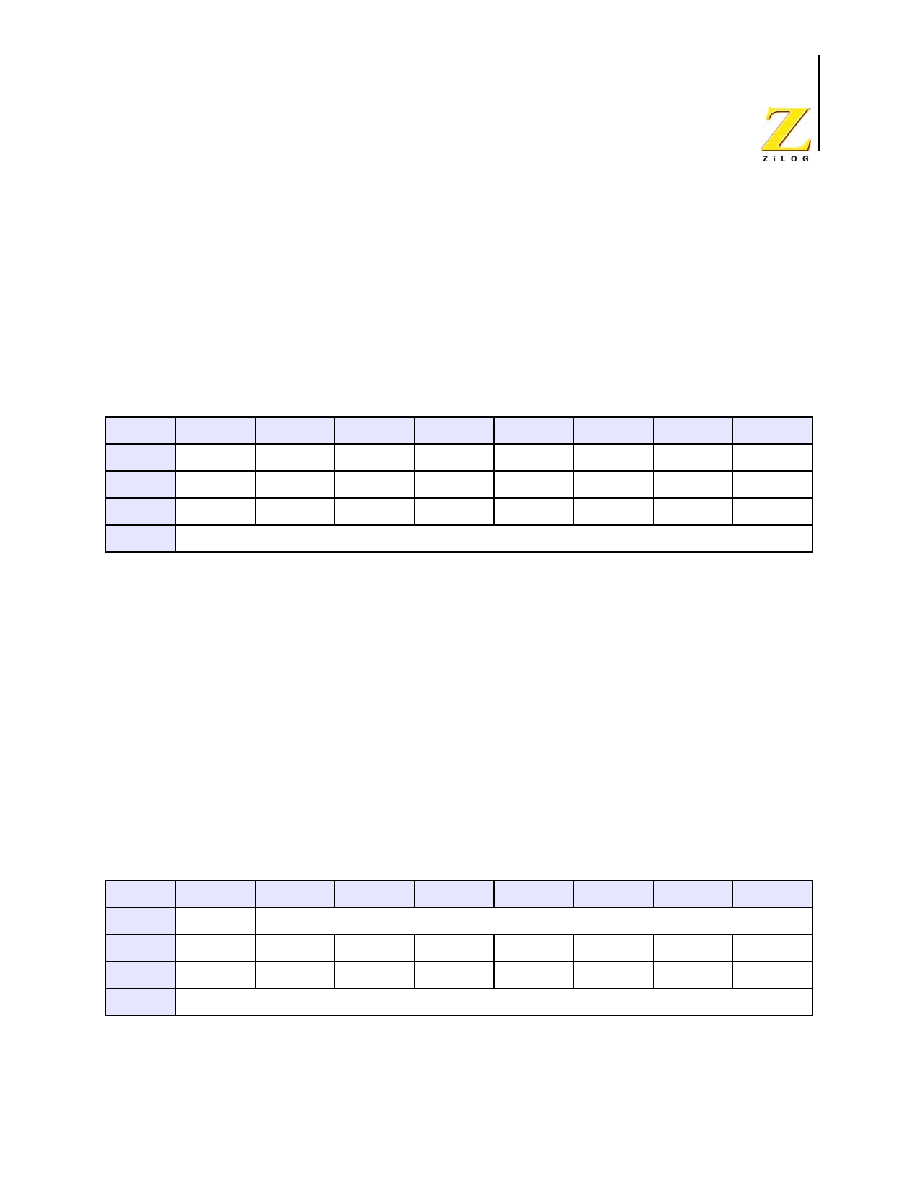
PS024302-0904
P R E L I M I N A R Y Interrupt
Controller
Z8 Encore!
Æ
4K Series
Product Specification
56
C1ENL--Port C1 Interrupt Request Enable Low Bit
C0ENL--Port C0 Interrupt Request Enable Low Bit
Interrupt Edge Select Register
The Interrupt Edge Select (IRQES) register (Table 43) determines whether an interrupt is
generated for the rising edge or falling edge on the selected GPIO Port A or Port D input
pin.
IESx--Interrupt Edge Select x
0 = An interrupt request is generated on the falling edge of the PAx input or PDx.
1 = An interrupt request is generated on the rising edge of the PAx input PDx.
where x indicates the specific GPIO Port pin number (0 through 7).
PA6CS--PA6/Comparator Selection
0 = PA6 is used for the interrupt for PA6CS interrupt request.
1 = The Comparator is used for the interrupt for PA6CS interrupt request.
Reserved--Must be 0.
Interrupt Control Register
The Interrupt Control (IRQCTL) register (Table 44) contains the master enable bit for all
interrupts.
IRQE--Interrupt Request Enable
This bit is set to 1 by executing an EI (Enable Interrupts) or IRET (Interrupt Return)
Table 43. Interrupt Edge Select Register (IRQES)
BITS
7
6
5
4
3
2
1
0
FIELD
IES7
IES6
IES5
IES4
IES3
IES2
IES1
IES0
RESET
0
0
0
0
0
0
0
0
R/W
R/W
R/W
R/W
R/W
R/W
R/W
R/W
R/W
ADDR
FCDH
Table 44. Interrupt Control Register (IRQCTL)
BITS
7
6
5
4
3
2
1
0
FIELD
IRQE
Reserved
RESET
0
0
0
0
0
0
0
0
R/W
R/W
R
R
R
R
R
R
R
ADDR
FCFH

PS024302-0904
P R E L I M I N A R Y Interrupt
Controller
Z8 Encore!
Æ
4K Series
Product Specification
57
instruction, or by a direct register write of a 1 to this bit. It is reset to 0 by executing a DI
instruction, eZ8 CPU acknowledgement of an interrupt request, Reset or by a direct regis-
ter write of a 0 to this bit.
0 = Interrupts are disabled.
1 = Interrupts are enabled.
Reserved--Must be 0.

PS024302-0904
P R E L I M I N A R Y Timers
Z8 Encore!
Æ
4K Series
Product Specification
58
Timers
Overview
These Z8 Encore!
Æ
4K Series products contain up to two 16-bit reloadable timers that can
be used for timing, event counting, or generation of pulse-width modulated (PWM) sig-
nals. The timers' features include:
∑
16-bit reload counter
∑
Programmable prescaler with prescale values from 1 to 128
∑
PWM output generation
∑
Capture and compare capability
∑
External input pin for timer input, clock gating, or capture signal. External input pin signal
frequency is limited to a maximum of one-fourth the system clock frequency.
∑
Timer output pin
∑
Timer interrupt
In addition to the timers described in this chapter, the Baud Rate Generator of the UART
(if unused) may also provide basic timing functionality. Refer to chapter
"UART" on
page 84
for information about using the Baud Rate Generator as an additional timer.
Architecture
Figure 9 illustrates the architecture of the timers.
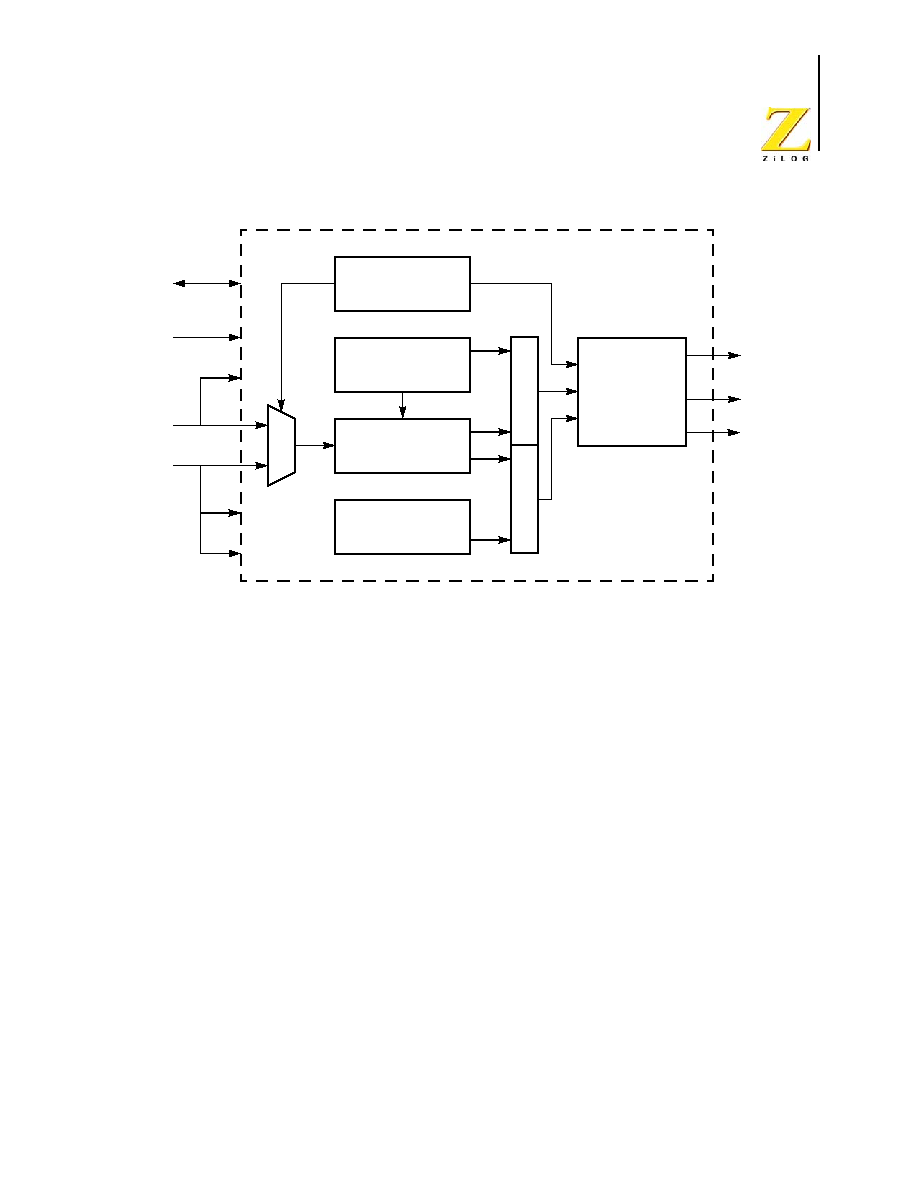
PS024302-0904
P R E L I M I N A R Y Timers
Z8 Encore!
Æ
4K Series
Product Specification
59
Figure 9.Timer Block Diagram
Operation
The timers are 16-bit up-counters. Minimum time-out delay is set by loading the value
0001H
into the Timer Reload High and Low Byte registers and setting the prescale value
to 1. Maximum time-out delay is set by loading the value
0000H
into the Timer Reload
High and Low Byte registers and setting the prescale value to 128. If the Timer reaches
FFFF
H
, the timer rolls over to
0000
H
and continues counting.
Timer Operating Modes
The timers can be configured to operate in the following modes:
ONE-SHOT Mode
In ONE-SHOT mode, the timer counts up to the 16-bit Reload value stored in the Timer
Reload High and Low Byte registers. The timer input is the system clock. Upon reaching
the Reload value, the timer generates an interrupt and the count value in the Timer High
and Low Byte registers is reset to
0001
H
. The timer is automatically disabled and stops
counting.
Also, if the Timer Output alternate function is enabled, the Timer Output pin changes state
for one system clock cycle (from Low to High or from High to Low) upon timer Reload. If
16-Bit
PWM/Compare
16-Bit Counter
with Prescaler
16-Bit
Reload Register
Timer
Control
Co
mp
are
Co
mp
are
Interrupt,
PWM,
and
Timer Output
Control
Timer
Timer Block
System
Timer
Data
Block
Output
Control
Bus
Clock
Input
Gate
Input
Capture
Input
Timer
Interrupt
Timer
Output
Complement

PS024302-0904
P R E L I M I N A R Y Timers
Z8 Encore!
Æ
4K Series
Product Specification
60
it is appropriate to have the Timer Output make a state change at a One-Shot time-out
(rather than a single cycle pulse), first set the TPOL bit in the Timer Control Register to
the start value before enabling ONE-SHOT mode. After starting the timer, set TPOL to the
opposite bit value.
The steps for configuring a timer for ONE-SHOT mode and initiating the count are as fol-
lows:
1. Write to the Timer Control register to:
≠
Disable the timer
≠
Configure the timer for ONE-SHOT mode.
≠
Set the prescale value.
≠
Set the initial output level (High or Low) if using the Timer Output alternate
function.
2. Write to the Timer High and Low Byte registers to set the starting count value.
3. Write to the Timer Reload High and Low Byte registers to set the Reload value.
4. If appropriate, enable the timer interrupt and set the timer interrupt priority by writing
to the relevant interrupt registers.
5. If using the Timer Output function, configure the associated GPIO port pin for the
Timer Output alternate function.
6. Write to the Timer Control register to enable the timer and initiate counting.
In ONE-SHOT mode, the system clock always provides the timer input. The timer period
is given by the following equation:
CONTINUOUS Mode
In CONTINUOUS mode, the timer counts up to the 16-bit Reload value stored in the
Timer Reload High and Low Byte registers. The timer input is the system clock. Upon
reaching the Reload value, the timer generates an interrupt, the count value in the Timer
High and Low Byte registers is reset to
0001H
and counting resumes. Also, if the Timer
Output alternate function is enabled, the Timer Output pin changes state (from Low to
High or from High to Low) at timer Reload.
The steps for configuring a timer for CONTINUOUS mode and initiating the count are as
follows:
1. Write to the Timer Control register to:
≠
Disable the timer
≠
Configure the timer for CONTINUOUS mode.
≠
Set the prescale value.
One-Shot Mode Time-Out Period (s)
Reload Value Start Value
≠
(
)
Prescale
◊
System Clock Frequency (Hz)
-------------------------------------------------------------------------------------------------
=

PS024302-0904
P R E L I M I N A R Y Timers
Z8 Encore!
Æ
4K Series
Product Specification
61
≠
If using the Timer Output alternate function, set the initial output level (High or
Low).
2. Write to the Timer High and Low Byte registers to set the starting count value (usually
0001H
). This action only affects the first pass in CONTINUOUS mode. After the first
timer Reload in CONTINUOUS mode, counting always begins at the reset value of
0001H
.
3. Write to the Timer Reload High and Low Byte registers to set the Reload value.
4. Enable the timer interrupt (if appropriate) and set the timer interrupt priority by
writing to the relevant interrupt registers.
5. Configure the associated GPIO port pin (if using the Timer Output function) for the
Timer Output alternate function.
6. Write to the Timer Control register to enable the timer and initiate counting.
In CONTINUOUS mode, the system clock always provides the timer input. The timer
period is given by the following equation:
If an initial starting value other than
0001H
is loaded into the Timer High and Low Byte
registers, use the ONE-SHOT mode equation to determine the first time-out period.
COUNTER Mode
In COUNTER mode, the timer counts input transitions from a GPIO port pin. The timer
input is taken from the GPIO Port pin Timer Input alternate function. The TPOL bit in the
Timer Control Register selects whether the count occurs on the rising edge or the falling
edge of the Timer Input signal. In COUNTER mode, the prescaler is disabled.
The input frequency of the Timer Input signal must not exceed one-fourth the system
clock frequency.
Upon reaching the Reload value stored in the Timer Reload High and Low Byte registers,
the timer generates an interrupt, the count value in the Timer High and Low Byte registers
is reset to
0001H
and counting resumes. Also, if the Timer Output alternate function is
enabled, the Timer Output pin changes state (from Low to High or from High to Low) at
timer Reload.
The steps for configuring a timer for COUNTER mode and initiating the count are as fol-
lows:
1. Write to the Timer Control register to:
≠
Disable the timer
≠
Configure the timer for COUNTER mode
Continuous Mode Time-Out Period (s)
Reload Value Prescale
◊
System Clock Frequency (Hz)
----------------------------------------------------------------------------
=
Caution:

PS024302-0904
P R E L I M I N A R Y Timers
Z8 Encore!
Æ
4K Series
Product Specification
62
≠
Select either the rising edge or falling edge of the Timer Input signal for the count.
This selection also sets the initial logic level (High or Low) for the Timer Output
alternate function. However, the Timer Output function is not required to be
enabled.
2. Write to the Timer High and Low Byte registers to set the starting count value. This
only affects the first pass in COUNTER mode. After the first timer Reload in
COUNTER mode, counting always begins at the reset value of
0001H
. In COUNTER
mode the Timer High and Low Byte registers must be written with the value
0001H
.
3. Write to the Timer Reload High and Low Byte registers to set the Reload value.
4. If appropriate, enable the timer interrupt and set the timer interrupt priority by writing
to the relevant interrupt registers.
5. Configure the associated GPIO port pin for the Timer Input alternate function.
6. If using the Timer Output function, configure the associated GPIO port pin for the
Timer Output alternate function.
7. Write to the Timer Control register to enable the timer.
In COUNTER mode, the number of Timer Input transitions since the timer start is given
by the following equation:
COMPARATOR COUNTER Mode
In COMPARATOR COUNTER mode, the timer counts input transitions from the analog
comparator output. The TPOL bit in the Timer Control Register selects whether the count
occurs on the rising edge or the falling edge of the comparator output signal. In COMPAR-
ATOR COUNTER mode, the prescaler is disabled.
The frequency of the comparator output signal must not exceed one-fourth the system
clock frequency.
After reaching the Reload value stored in the Timer Reload High and Low Byte registers,
the timer generates an interrupt, the count value in the Timer High and Low Byte registers
is reset to
0001H
and counting resumes. Also, if the Timer Output alternate function is
enabled, the Timer Output pin changes state (from Low to High or from High to Low) at
timer Reload.
The steps for configuring a timer for COMPARATOR COUNTER mode and initiating the
count are as follows:
1. Write to the Timer Control register to:
≠
Disable the timer
≠
Configure the timer for COMPARATOR COUNTER mode
Counter Mode Timer Input Transitions
Current Count Value Start Value
≠
=
Caution:

PS024302-0904
P R E L I M I N A R Y Timers
Z8 Encore!
Æ
4K Series
Product Specification
63
≠
Select either the rising edge or falling edge of the comparator output signal for the
count. This also sets the initial logic level (High or Low) for the Timer Output
alternate function. However, the Timer Output function is not required to be
enabled.
2. Write to the Timer High and Low Byte registers to set the starting count value. This
action only affects the first pass in COMPARATOR COUNTER mode. After the first
timer Reload in COMPARATOR COUNTER mode, counting always begins at the
reset value of
0001H
. Generally, in COMPARATOR COUNTER mode the Timer
High and Low Byte registers must be written with the value
0001H
.
3. Write to the Timer Reload High and Low Byte registers to set the Reload value.
4. If appropriate, enable the timer interrupt and set the timer interrupt priority by writing
to the relevant interrupt registers.
5. If using the Timer Output function, configure the associated GPIO port pin for the
Timer Output alternate function.
6. Write to the Timer Control register to enable the timer.
In COMPARATOR COUNTER mode, the number of comparator output transitions since
the timer start is given by the following equation:
PWM SINGLE OUTPUT Mode
In PWM SINGLE OUTPUT mode, the timer outputs a Pulse-Width Modulator (PWM)
output signal through a GPIO Port pin. The timer input is the system clock. The timer first
counts up to the 16-bit PWM match value stored in the Timer PWM High and Low Byte
registers. When the timer count value matches the PWM value, the Timer Output toggles.
The timer continues counting until it reaches the Reload value stored in the Timer Reload
High and Low Byte registers. Upon reaching the Reload value, the timer generates an
interrupt, the count value in the Timer High and Low Byte registers is reset to
0001H
and
counting resumes.
If the TPOL bit in the Timer Control register is set to 1, the Timer Output signal begins as
a High (1) and transitions to a Low (0) when the timer value matches the PWM value. The
Timer Output signal returns to a High (1) after the timer reaches the Reload value and is
reset to
0001H
.
If the TPOL bit in the Timer Control register is set to 0, the Timer Output signal begins as
a Low (0) and transitions to a High (1) when the timer value matches the PWM value. The
Timer Output signal returns to a Low (0) after the timer reaches the Reload value and is
reset to
0001H
.
The steps for configuring a timer for PWM Single Output mode and initiating the PWM
operation are as follows:
Comparator Output Transitions
Current Count Value Start Value
≠
=

PS024302-0904
P R E L I M I N A R Y Timers
Z8 Encore!
Æ
4K Series
Product Specification
64
1. Write to the Timer Control register to:
≠
Disable the timer
≠
Configure the timer for PWM mode.
≠
Set the prescale value.
≠
Set the initial logic level (High or Low) and PWM High/Low transition for the
Timer Output alternate function.
2. Write to the Timer High and Low Byte registers to set the starting count value
(typically
0001H
). This only affects the first pass in PWM mode. After the first timer
reset in PWM mode, counting always begins at the reset value of
0001H
.
3. Write to the PWM High and Low Byte registers to set the PWM value.
4. Write to the Timer Reload High and Low Byte registers to set the Reload value (PWM
period). The Reload value must be greater than the PWM value.
5. If appropriate, enable the timer interrupt and set the timer interrupt priority by writing
to the relevant interrupt registers.
6. Configure the associated GPIO port pin for the Timer Output alternate function.
7. Write to the Timer Control register to enable the timer and initiate counting.
The PWM period is represented by the following equation:
If an initial starting value other than
0001H
is loaded into the Timer High and Low Byte
registers, use the ONE-SHOT mode equation to determine the first PWM time-out period.
If TPOL is set to 0, the ratio of the PWM output High time to the total period is repre-
sented by:
If TPOL is set to 1, the ratio of the PWM output High time to the total period is repre-
sented by:
PWM Dual Output Mode
In PWM DUAL OUTPUT mode, the timer outputs a Pulse-Width Modulated (PWM) out-
put signal pair (basic PWM signal and its complement) through two GPIO Port pins. The
timer input is the system clock. The timer first counts up to the 16-bit PWM match value
PWM Period (s)
Reload Value
Prescale
◊
System Clock Frequency (Hz)
----------------------------------------------------------------------------
=
PWM Output High Time Ratio (%)
Reload Value PWM Value
≠
Reload Value
------------------------------------------------------------------------
100
◊
=
PWM Output High Time Ratio (%)
PWM Value
Reload Value
----------------------------------
100
◊
=

PS024302-0904
P R E L I M I N A R Y Timers
Z8 Encore!
Æ
4K Series
Product Specification
65
stored in the Timer PWM High and Low Byte registers. When the timer count value
matches the PWM value, the Timer Output toggles. The timer continues counting until it
reaches the Reload value stored in the Timer Reload High and Low Byte registers. Upon
reaching the Reload value, the timer generates an interrupt, the count value in the Timer
High and Low Byte registers is reset to
0001H
and counting resumes.
If the TPOL bit in the Timer Control register is set to 1, the Timer Output signal begins as
a High (1) and transitions to a Low (0) when the timer value matches the PWM value. The
Timer Output signal returns to a High (1) after the timer reaches the Reload value and is
reset to
0001H
.
If the TPOL bit in the Timer Control register is set to 0, the Timer Output signal begins as
a Low (0) and transitions to a High (1) when the timer value matches the PWM value. The
Timer Output signal returns to a Low (0) after the timer reaches the Reload value and is
reset to
0001H
.
The timer also generates a second PWM output signal Timer Output Complement. The
Timer Output Complement is the complement of the Timer Output PWM signal. A pro-
grammable deadband delay can be configured to time delay (0 to 128 system clock cycles)
PWM output transitions on these two pins from a low to a high (inactive to active). This
ensures a time gap between the deassertion of one PWM output to the assertion of its com-
plement.
The steps for configuring a timer for PWM Dual Output mode and initiating the PWM
operation are as follows:
1. Write to the Timer Control register to:
≠
Disable the timer
≠
Configure the timer for PWM Dual Output mode. Setting the mode also involves
writing to TMODEHI bit in TxCTL1 register.
≠
Set the prescale value.
≠
Set the initial logic level (High or Low) and PWM High/Low transition for the
Timer Output alternate function.
2. Write to the Timer High and Low Byte registers to set the starting count value
(typically
0001H
). This only affects the first pass in PWM mode. After the first timer
reset in PWM mode, counting always begins at the reset value of
0001H
.
3. Write to the PWM High and Low Byte registers to set the PWM value.
4. Write to the PWM Control register to set the PWM dead band delay value. The
deadband delay must be less than the duration of the positive phase of the PWM signal
(as defined by the PWM high and low byte registers). It must also be less than the
duration of the negative phase of the PWM signal (as defined by the difference
between the PWM registers and the Timer Reload registers).
5. Write to the Timer Reload High and Low Byte registers to set the Reload value (PWM
period). The Reload value must be greater than the PWM value.

PS024302-0904
P R E L I M I N A R Y Timers
Z8 Encore!
Æ
4K Series
Product Specification
66
6. If appropriate, enable the timer interrupt and set the timer interrupt priority by writing
to the relevant interrupt registers.
7. Configure the associated GPIO port pin for the Timer Output and Timer Output
Complement alternate functions. The Timer Output Complement function is shared
with the Timer Input function for both timers. Setting the timer mode to Dual PWM
automatically switches the function from Timer In to Timer Out Complement.
8. Write to the Timer Control register to enable the timer and initiate counting.
The PWM period is represented by the following equation:
If an initial starting value other than
0001H
is loaded into the Timer High and Low Byte
registers, the ONE-SHOT mode equation determines the first PWM time-out period.
If TPOL is set to 0, the ratio of the PWM output High time to the total period is repre-
sented by:
If TPOL is set to 1, the ratio of the PWM output High time to the total period is repre-
sented by:
CAPTURE Mode
In CAPTURE mode, the current timer count value is recorded when the appropriate exter-
nal Timer Input transition occurs. The Capture count value is written to the Timer PWM
High and Low Byte Registers. The timer input is the system clock. The TPOL bit in the
Timer Control register determines if the Capture occurs on a rising edge or a falling edge
of the Timer Input signal. When the Capture event occurs, an interrupt is generated and the
timer continues counting. The INPCAP bit in TxCTL1 register is set to indicate the timer
interrupt is because of an input capture event.
The timer continues counting up to the 16-bit Reload value stored in the Timer Reload
High and Low Byte registers. Upon reaching the Reload value, the timer generates an
interrupt and continues counting. The INPCAP bit in TxCTL1 register clears indicating
the timer interrupt is not because of an input capture event.
The steps for configuring a timer for CAPTURE mode and initiating the count are as fol-
lows:
PWM Period (s)
Reload Value
Prescale
◊
System Clock Frequency (Hz)
----------------------------------------------------------------------------
=
PWM Output High Time Ratio (%)
Reload Value PWM Value
≠
Reload Value
------------------------------------------------------------------------
100
◊
=
PWM Output High Time Ratio (%)
PWM Value
Reload Value
----------------------------------
100
◊
=

PS024302-0904
P R E L I M I N A R Y Timers
Z8 Encore!
Æ
4K Series
Product Specification
67
1. Write to the Timer Control register to:
≠
Disable the timer
≠
Configure the timer for CAPTURE mode.
≠
Set the prescale value.
≠
Set the Capture edge (rising or falling) for the Timer Input.
2. Write to the Timer High and Low Byte registers to set the starting count value
(typically
0001H
).
3. Write to the Timer Reload High and Low Byte registers to set the Reload value.
4. Clear the Timer PWM High and Low Byte registers to 0000H. Clearing these
registers allows user software to determine if interrupts were generated by either a
capture event or a reload. If the PWM High and Low Byte registers still contain
0000H
after the interrupt, the interrupt was generated by a Reload.
5. Enable the timer interrupt, if appropriate, and set the timer interrupt priority by writing
to the relevant interrupt registers. By default, the timer interrupt is generated for both
input capture and reload events. If appropriate, configure the timer interrupt to be
generated only at the input capture event or the reload event by setting TICONFIG
field of the TxCTL1 register.
6. Configure the associated GPIO port pin for the Timer Input alternate function.
7. Write to the Timer Control register to enable the timer and initiate counting.
In CAPTURE mode, the elapsed time from timer start to Capture event can be calculated
using the following equation:
CAPTURE RESTART Mode
In CAPTURE RESTART mode, the current timer count value is recorded when the accept-
able external Timer Input transition occurs. The Capture count value is written to the
Timer PWM High and Low Byte Registers. The timer input is the system clock. The
TPOL
bit in the Timer Control register determines if the Capture occurs on a rising edge or
a falling edge of the Timer Input signal. When the Capture event occurs, an interrupt is
generated and the count value in the Timer High and Low Byte registers is reset to
0001H
and counting resumes. The INPCAP bit in TxCTL1 register is set to indicate the timer
interrupt is because of an input capture event.
If no Capture event occurs, the timer counts up to the 16-bit Compare value stored in the
Timer Reload High and Low Byte registers. Upon reaching the Reload value, the timer
generates an interrupt, the count value in the Timer High and Low Byte registers is reset to
0001H
and counting resumes. The INPCAP bit in TxCTL1 register is cleared to indicate
the timer interrupt is not caused by an input capture event.
Capture Elapsed Time (s)
Capture Value Start Value
≠
(
)
Prescale
◊
System Clock Frequency (Hz)
----------------------------------------------------------------------------------------------------
=

PS024302-0904
P R E L I M I N A R Y Timers
Z8 Encore!
Æ
4K Series
Product Specification
68
The steps for configuring a timer for CAPTURE RESTART mode and initiating the count
are as follows:
1. Write to the Timer Control register to:
≠
Disable the timer
≠
Configure the timer for CAPTURE RESTART mode. Setting the mode also
involves writing to
TMODEHI
bit in TxCTL1 register.
≠
Set the prescale value.
≠
Set the Capture edge (rising or falling) for the Timer Input.
2. Write to the Timer High and Low Byte registers to set the starting count value
(typically
0001H
).
3. Write to the Timer Reload High and Low Byte registers to set the Reload value.
4. Clear the Timer PWM High and Low Byte registers to 0000H. This allows user
software to determine if interrupts were generated by either a capture event or a
reload. If the PWM High and Low Byte registers still contain 0000H after the
interrupt, the interrupt was generated by a Reload.
5. Enable the timer interrupt, if appropriate, and set the timer interrupt priority by writing
to the relevant interrupt registers. By default, the timer interrupt is generated for both
input capture and reload events. If appropriate, configure the timer interrupt to be
generated only at the input capture event or the reload event by setting TICONFIG
field of the TxCTL1 register.
6. Configure the associated GPIO port pin for the Timer Input alternate function.
7. Write to the Timer Control register to enable the timer and initiate counting.
In CAPTURE mode, the elapsed time from timer start to Capture event can be calculated
using the following equation:
COMPARE Mode
In COMPARE mode, the timer counts up to the 16-bit maximum Compare value stored in
the Timer Reload High and Low Byte registers. The timer input is the system clock. Upon
reaching the Compare value, the timer generates an interrupt and counting continues (the
timer value is not reset to
0001H
). Also, if the Timer Output alternate function is enabled,
the Timer Output pin changes state (from Low to High or from High to Low) upon Com-
pare.
If the Timer reaches
FFFF
H
, the timer rolls over to
0000
H
and continue counting.
The steps for configuring a timer for COMPARE mode and initiating the count are as fol-
lows:
Capture Elapsed Time (s)
Capture Value Start Value
≠
(
)
Prescale
◊
System Clock Frequency (Hz)
----------------------------------------------------------------------------------------------------
=

PS024302-0904
P R E L I M I N A R Y Timers
Z8 Encore!
Æ
4K Series
Product Specification
69
1. Write to the Timer Control register to:
≠
Disable the timer
≠
Configure the timer for Compare mode.
≠
Set the prescale value.
≠
Set the initial logic level (High or Low) for the Timer Output alternate function, if
appropriate.
2. Write to the Timer High and Low Byte registers to set the starting count value.
3. Write to the Timer Reload High and Low Byte registers to set the Compare value.
4. Enable the timer interrupt, if appropriate, and set the timer interrupt priority by writing
to the relevant interrupt registers.
5. If using the Timer Output function, configure the associated GPIO port pin for the
Timer Output alternate function.
6. Write to the Timer Control register to enable the timer and initiate counting.
In Compare mode, the system clock always provides the timer input. The Compare time
can be calculated by the following equation:
GATED Mode
In GATED mode, the timer counts only when the Timer Input signal is in its active state
(asserted), as determined by the TPOL bit in the Timer Control register. When the Timer
Input signal is asserted, counting begins. A timer interrupt is generated when the Timer
Input signal is deasserted or a timer reload occurs. To determine if a Timer Input signal
deassertion generated the interrupt, read the associated GPIO input value and compare to
the value stored in the TPOL bit.
The timer counts up to the 16-bit Reload value stored in the Timer Reload High and Low
Byte registers. The timer input is the system clock. When reaching the Reload value, the
timer generates an interrupt, the count value in the Timer High and Low Byte registers is
reset to
0001H
and counting resumes (assuming the Timer Input signal remains asserted).
Also, if the Timer Output alternate function is enabled, the Timer Output pin changes state
(from Low to High or from High to Low) at timer reset.
The steps for configuring a timer for GATED mode and initiating the count are as follows:
1. Write to the Timer Control register to:
≠
Disable the timer
≠
Configure the timer for Gated mode.
≠
Set the prescale value.
Compare Mode Time (s)
Compare Value Start Value
≠
(
)
Prescale
◊
System Clock Frequency (Hz)
-------------------------------------------------------------------------------------------------------
=

PS024302-0904
P R E L I M I N A R Y Timers
Z8 Encore!
Æ
4K Series
Product Specification
70
2. Write to the Timer High and Low Byte registers to set the starting count value. Writing
these registers only affects the first pass in GATED mode. After the first timer reset in
GATED mode, counting always begins at the reset value of
0001H
.
3. Write to the Timer Reload High and Low Byte registers to set the Reload value.
4. Enable the timer interrupt, if appropriate, and set the timer interrupt priority by writing
to the relevant interrupt registers. By default, the timer interrupt is generated for both
input deassertion and reload events. If appropriate, configure the timer interrupt to be
generated only at the input deassertion event or the reload event by setting TICONFIG
field of the TxCTL1 register.
5. Configure the associated GPIO port pin for the Timer Input alternate function.
6. Write to the Timer Control register to enable the timer.
7. Assert the Timer Input signal to initiate the counting.
CAPTURE/COMPARE Mode
In CAPTURE/COMPARE mode, the timer begins counting on the first external Timer
Input transition. The acceptable transition (rising edge or falling edge) is set by the TPOL
bit in the Timer Control Register. The timer input is the system clock.
Every subsequent acceptable transition (after the first) of the Timer Input signal captures
the current count value. The Capture value is written to the Timer PWM High and Low
Byte Registers. When the Capture event occurs, an interrupt is generated, the count value
in the Timer High and Low Byte registers is reset to
0001H
, and counting resumes. The
INPCAP
bit in TxCTL1 register is set to indicate the timer interrupt is caused by an input
capture event.
If no Capture event occurs, the timer counts up to the 16-bit Compare value stored in the
Timer Reload High and Low Byte registers. Upon reaching the Compare value, the timer
generates an interrupt, the count value in the Timer High and Low Byte registers is reset to
0001H
and counting resumes. The
INPCAP
bit in TxCTL1 register is cleared to indicate
the timer interrupt is not because of an input capture event.
The steps for configuring a timer for CAPTURE/COMPARE mode and initiating the
count are as follows:
1. Write to the Timer Control register to:
≠
Disable the timer
≠
Configure the timer for CAPTURE/COMPARE mode.
≠
Set the prescale value.
≠
Set the Capture edge (rising or falling) for the Timer Input.
2. Write to the Timer High and Low Byte registers to set the starting count value
(typically
0001H
).
3. Write to the Timer Reload High and Low Byte registers to set the Compare value.

PS024302-0904
P R E L I M I N A R Y Timers
Z8 Encore!
Æ
4K Series
Product Specification
71
4. Enable the timer interrupt, if appropriate, and set the timer interrupt priority by writing
to the relevant interrupt registers.By default, the timer interrupt are generated for both
input capture and reload events. If appropriate, configure the timer interrupt to be
generated only at the input capture event or the reload event by setting TICONFIG
field of the TxCTL1 register.
5. Configure the associated GPIO port pin for the Timer Input alternate function.
6. Write to the Timer Control register to enable the timer.
7. Counting begins on the first appropriate transition of the Timer Input signal. No
interrupt is generated by this first edge.
In CAPTURE/COMPARE mode, the elapsed time from timer start to Capture event can be
calculated using the following equation:
Reading the Timer Count Values
The current count value in the timers can be read while counting (enabled). This capability
has no effect on timer operation. When the timer is enabled and the Timer High Byte reg-
ister is read, the contents of the Timer Low Byte register are placed in a holding register. A
subsequent read from the Timer Low Byte register returns the value in the holding register.
This operation allows accurate reads of the full 16-bit timer count value while enabled.
When the timers are not enabled, a read from the Timer Low Byte register returns the
actual value in the counter.
Timer Pin Signal Operation
Timer Output is a GPIO Port pin alternate function. The Timer Output is toggled every
time the counter is reloaded.
The timer input can be used as a selectable counting source. It shares the same pin as the
complementary timer output. When selected by the GPIO Alternate Function Registers,
this pin functions as a timer input in all modes except for the DUAL PWM OUTPUT
mode. For this mode, there is no timer input available.
Capture Elapsed Time (s)
Capture Value Start Value
≠
(
) Prescale
◊
System Clock Frequency (Hz)
---------------------------------------------------------------------------------------------------------
=
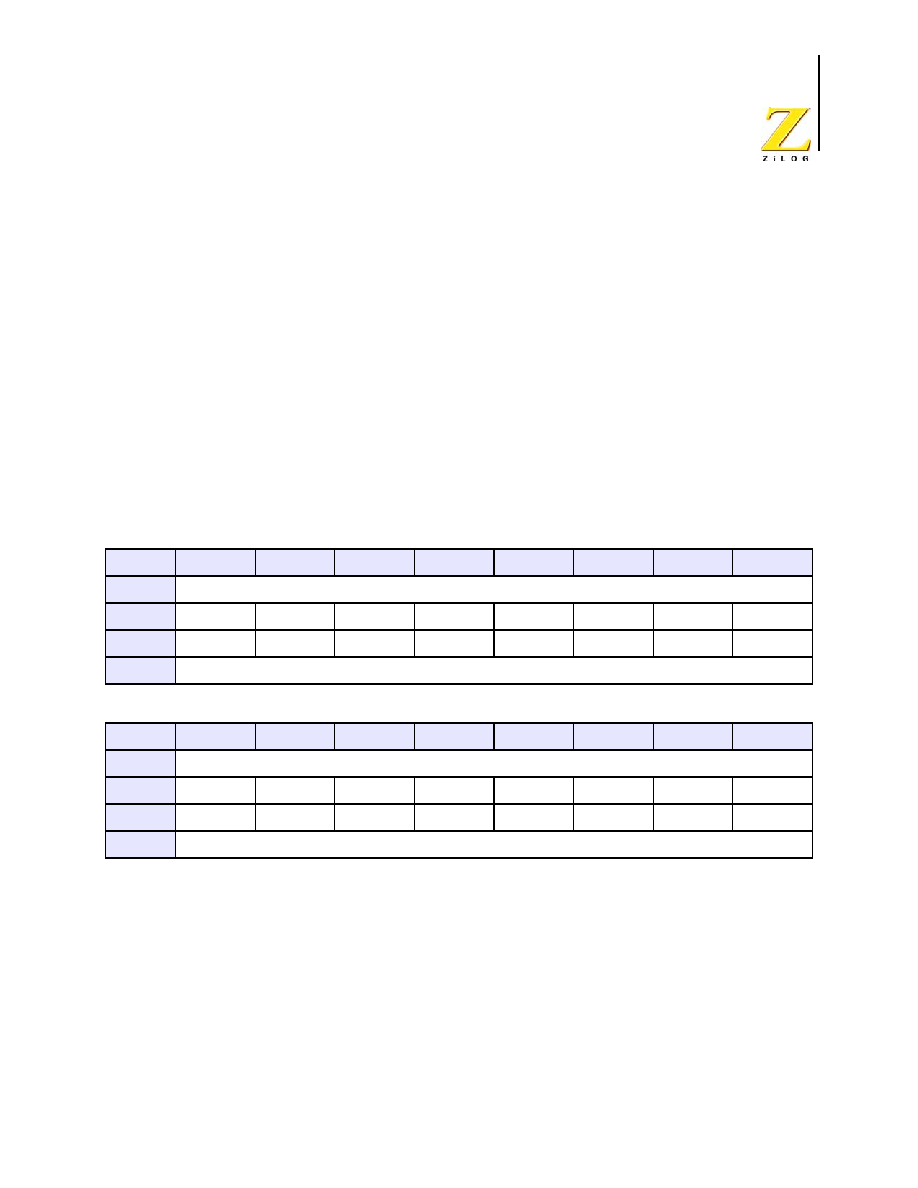
PS024302-0904
P R E L I M I N A R Y Timers
Z8 Encore!
Æ
4K Series
Product Specification
72
Timer Control Register Definitions
Timer 0≠1 High and Low Byte Registers
The Timer 0≠1 High and Low Byte (TxH and TxL) registers (Tables 45 and 39) contain
the current 16-bit timer count value. When the timer is enabled, a read from TxH causes
the value in TxL to be stored in a temporary holding register. A read from TxL always
returns this temporary register when the timers are enabled. When the timer is disabled,
reads from the TxL reads the register directly.
Writing to the Timer High and Low Byte registers while the timer is enabled is not recom-
mended. There are no temporary holding registers available for write operations, so simul-
taneous 16-bit writes are not possible. If either the Timer High or Low Byte registers are
written during counting, the 8-bit written value is placed in the counter (High or Low
Byte) at the next clock edge. The counter continues counting from the new value.
TH and TL--Timer High and Low Bytes
These 2 bytes, {TH[7:0], TL[7:0]}, contain the current 16-bit timer count value.
Timer Reload High and Low Byte Registers
The Timer 0≠1 Reload High and Low Byte (TxRH and TxRL) registers (Tables 47 and 41)
store a 16-bit reload value, {TRH[7:0], TRL[7:0]}. Values written to the Timer Reload
High Byte register are stored in a temporary holding register. When a write to the Timer
Reload Low Byte register occurs, the temporary holding register value is written to the
Timer High Byte register. This operation allows simultaneous updates of the 16-bit Timer
Table 45. Timer 0≠1 High Byte Register (TxH)
BITS
7
6
5
4
3
2
1
0
FIELD
TH
RESET
0
0
0
0
0
0
0
0
R/W
R/W
R/W
R/W
R/W
R/W
R/W
R/W
R/W
ADDR
F00H, F08H
Table 46. Timer 0≠1 Low Byte Register (TxL)
BITS
7
6
5
4
3
2
1
0
FIELD
TL
RESET
0
0
0
0
0
0
0
1
R/W
R/W
R/W
R/W
R/W
R/W
R/W
R/W
R/W
ADDR
F01H, F09H
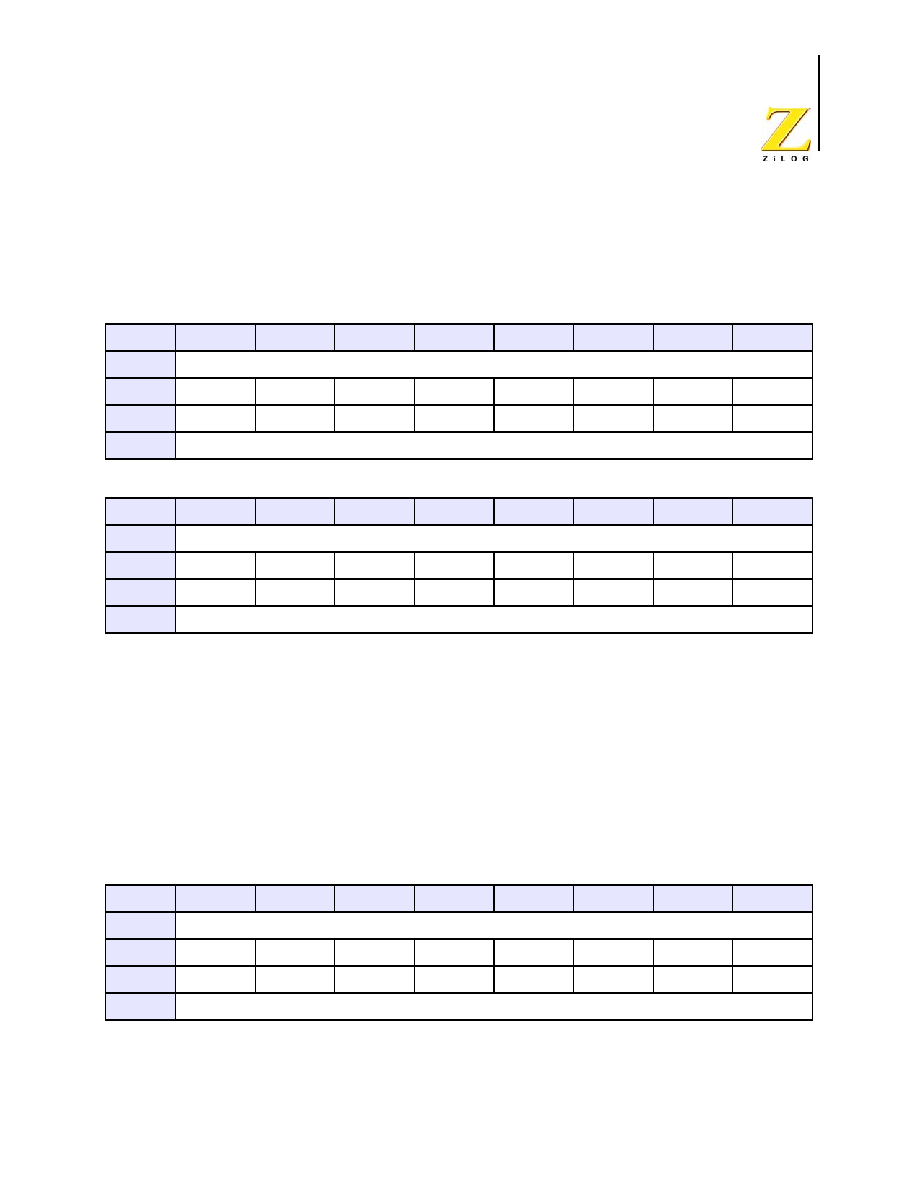
PS024302-0904
P R E L I M I N A R Y Timers
Z8 Encore!
Æ
4K Series
Product Specification
73
Reload value.
In COMPARE mode, the Timer Reload High and Low Byte registers store the 16-bit
Compare value.
TRH and TRL--Timer Reload Register High and Low
These two bytes form the 16-bit Reload value, {TRH[7:0], TRL[7:0]}. This value sets the
maximum count value which initiates a timer reload to
0001H
. In Compare mode, these
two bytes form the 16-bit Compare value.
Timer 0-1 PWM High and Low Byte Registers
The Timer 0-1 PWM High and Low Byte (TxPWMH and TxPWML) registers (Tables 49
and 43) control Pulse-Width Modulator (PWM) operations. These registers also store the
Capture values for the CAPTURE and CAPTURE/COMPARE modes.
Table 47. Timer 0≠1 Reload High Byte Register (TxRH)
BITS
7
6
5
4
3
2
1
0
FIELD
TRH
RESET
1
1
1
1
1
1
1
1
R/W
R/W
R/W
R/W
R/W
R/W
R/W
R/W
R/W
ADDR
F02H, F0AH
Table 48. Timer 0≠1 Reload Low Byte Register (TxRL)
BITS
7
6
5
4
3
2
1
0
FIELD
TRL
RESET
1
1
1
1
1
1
1
1
R/W
R/W
R/W
R/W
R/W
R/W
R/W
R/W
R/W
ADDR
F03H, F0BH
Table 49. Timer 0≠1 PWM High Byte Register (TxPWMH)
BITS
7
6
5
4
3
2
1
0
FIELD
PWMH
RESET
0
0
0
0
0
0
0
0
R/W
R/W
R/W
R/W
R/W
R/W
R/W
R/W
R/W
ADDR
F04H, F0CH
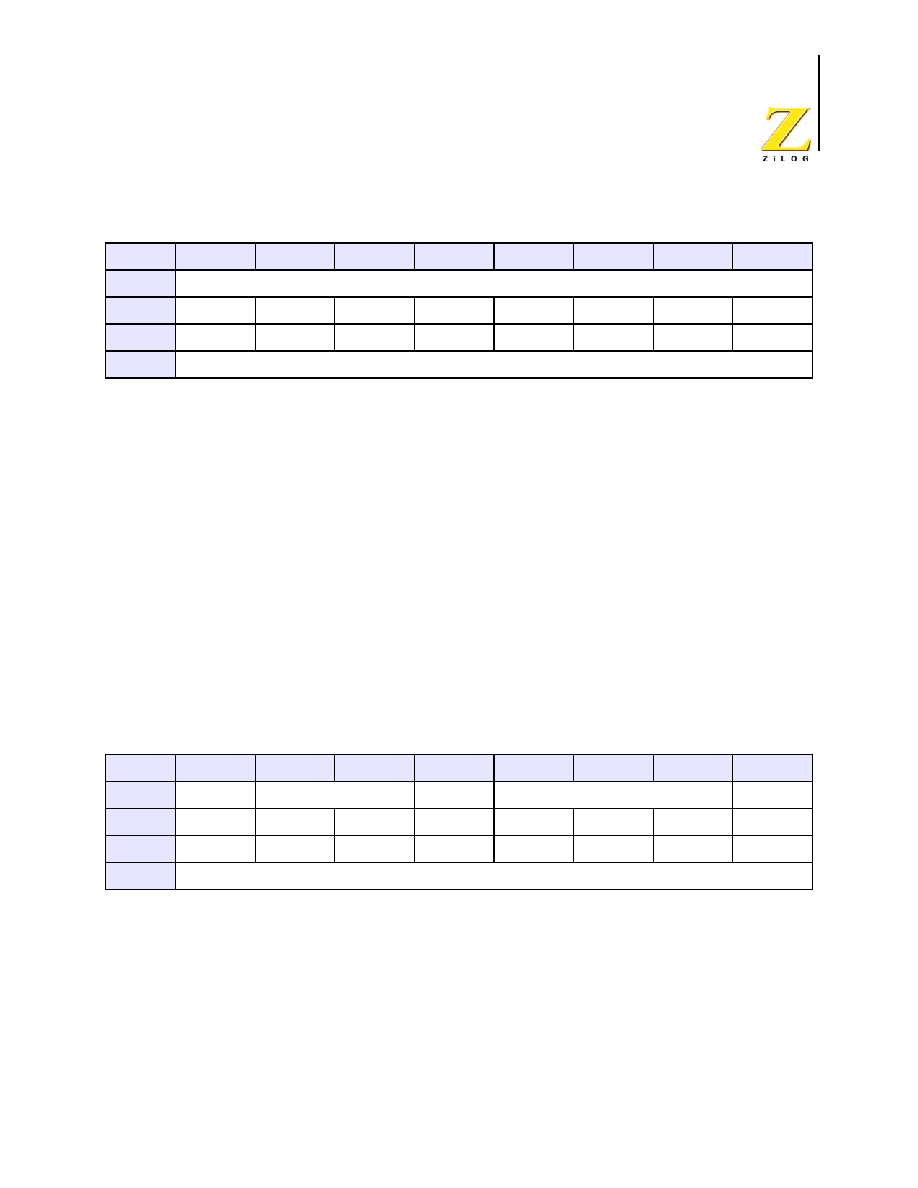
PS024302-0904
P R E L I M I N A R Y Timers
Z8 Encore!
Æ
4K Series
Product Specification
74
PWMH and PWML--Pulse-Width Modulator High and Low Bytes
These two bytes, {PWMH[7:0], PWML[7:0]}, form a 16-bit value that is compared to the
current 16-bit timer count. When a match occurs, the PWM output changes state. The
PWM output value is set by the TPOL bit in the Timer Control Register (TxCTL1) regis-
ter.
The TxPWMH and TxPWML registers also store the 16-bit captured timer value when
operating in Capture or Capture/Compare modes.
Timer 0≠1 Control Registers
Time 0≠1 Control Register 0
The Timer Control Register 0 (TxCTL0) and Timer Control Register 1 (TxCTL1) deter-
mine the timer operating mode. It also includes a programmable PWM deadband delay,
two bits to configure timer interrupt definition, and a status bit to identify if the most
recent timer interrupt is caused by an input capture event.
TMODEHI--Timer Mode High Bit
This bit along with the TMODE field in TxCTL1 register determines the operating mode
of the timer. This is the most significant bit of the Timer mode selection value. See the
TxCTL1 register description on the next page for additional details.
TICONFIG--Timer Interrupt Configuration
This field configures timer interrupt definition.
Table 50. Timer 0≠1 PWM Low Byte Register (TxPWML)
BITS
7
6
5
4
3
2
1
0
FIELD
PWML
RESET
0
0
0
0
0
0
0
0
R/W
R/W
R/W
R/W
R/W
R/W
R/W
R/W
R/W
ADDR
F05H, F0DH
Table 51. Timer 0≠1 Control Register 0 (TxCTL0)
BITS
7
6
5
4
3
2
1
0
FIELD
TMODEHI
TICONFIG Reserved
PWMD
INPCAP
RESET
0
0
0
0
0
0
0
0
R/W
R/W
R/W
R/W
R/W
R/W
R/W
R/W
R/W
ADDR
F06H, F0EH
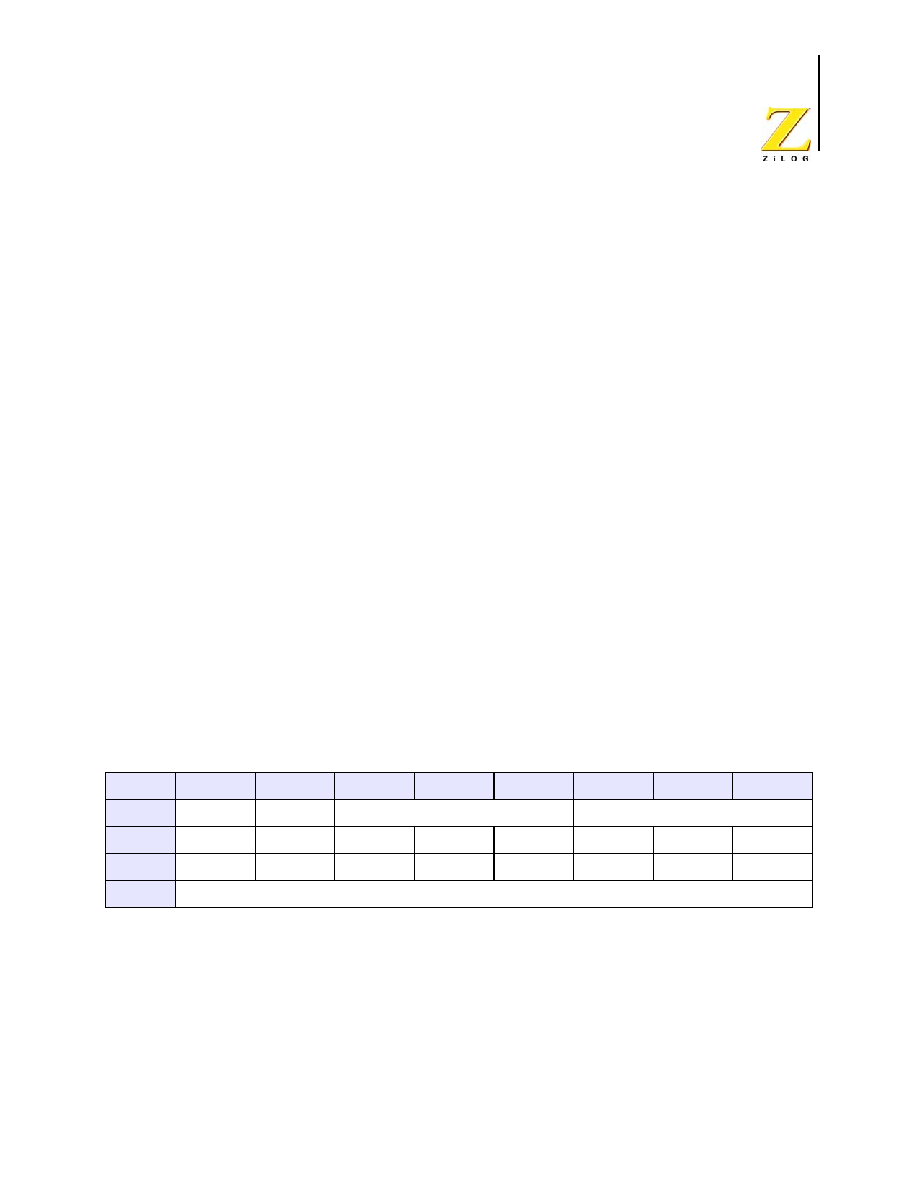
PS024302-0904
P R E L I M I N A R Y Timers
Z8 Encore!
Æ
4K Series
Product Specification
75
0x = Timer Interrupt occurs on all defined Reload, Compare and Input Events
10 = Timer Interrupt only on defined Input Capture/Deassertion Events
11 = Timer Interrupt only on defined Reload/Compare Events
Reserved--Must be 0.
PWMD--PWM Delay value
This field is a programmable delay to control the number of system clock cycles delay
before the Timer Output and the Timer Output Complement are forced to their active state.
000 = No delay
001 = 2 cycles delay
010 = 4 cycles delay
011 = 8 cycles delay
100 = 16 cycles delay
101 = 32 cycles delay
110 = 64 cycles delay
111 = 128 cycles delay
INPCAP--Input Capture Event
This bit indicates if the most recent timer interrupt is caused by a Timer Input Capture
Event.
0 = Previous timer interrupt is not a result of Timer Input Capture Event
1 = Previous timer interrupt is a result of Timer Input Capture Event
Timer 0≠1 Control Register 1
The Timer 0≠1 Control (TxCTL1) registers enable/disable the timers, set the prescaler
value, and determine the timer operating mode.
TEN--Timer Enable
0 = Timer is disabled.
1 = Timer enabled to count.
TPOL--Timer Input/Output Polarity
Operation of this bit is a function of the current operating mode of the timer.
ONE-SHOT mode
When the timer is disabled, the Timer Output signal is set to the value of this bit.
Table 52. Timer 0≠1 Control Register 1 (TxCTL1)
BITS
7
6
5
4
3
2
1
0
FIELD
TEN
TPOL
PRES
TMODE
RESET
0
0
0
0
0
0
0
0
R/W
R/W
R/W
R/W
R/W
R/W
R/W
R/W
R/W
ADDR
F07H, F0FH

PS024302-0904
P R E L I M I N A R Y Timers
Z8 Encore!
Æ
4K Series
Product Specification
76
When the timer is enabled, the Timer Output signal is complemented upon timer
Reload.
CONTINUOUS mode
When the timer is disabled, the Timer Output signal is set to the value of this bit.
When the timer is enabled, the Timer Output signal is complemented upon timer
Reload.
COUNTER mode
When the timer is disabled, the Timer Output signal is set to the value of this bit.
When the timer is enabled, the Timer Output signal is complemented upon timer
Reload.
PWM SINGLE OUTPUT mode
0 = Timer Output is forced Low (0) when the timer is disabled. When enabled, the
Timer Output is forced High (1) upon PWM count match and forced Low (0) upon
Reload.
1 = Timer Output is forced High (1) when the timer is disabled. When enabled, the
Timer Output is forced Low (0) upon PWM count match and forced High (1) upon
Reload.
CAPTURE mode
0 = Count is captured on the rising edge of the Timer Input signal.
1 = Count is captured on the falling edge of the Timer Input signal.
COMPARE mode
When the timer is disabled, the Timer Output signal is set to the value of this bit.
When the timer is enabled, the Timer Output signal is complemented upon timer
Reload.
GATED mode
0 = Timer counts when the Timer Input signal is High (1) and interrupts are generated
on the falling edge of the Timer Input.
1 = Timer counts when the Timer Input signal is Low (0) and interrupts are generated
on the rising edge of the Timer Input.
CAPTURE/COMPARE mode
0 = Counting is started on the first rising edge of the Timer Input signal. The current
count is captured on subsequent rising edges of the Timer Input signal.
1 = Counting is started on the first falling edge of the Timer Input signal. The current
count is captured on subsequent falling edges of the Timer Input signal.
PWM DUAL OUTPUT mode
0 = Timer Output is forced Low (0) and Timer Output Complement is forced High (1)
when the timer is disabled. When enabled, the Timer Output is forced High (1) upon
PWM count match and forced Low (0) upon Reload. When enabled, the Timer Output
Complement is forced Low (0) upon PWM count match and forced High (1) upon
Reload. The PWMD field in TxCTL0 register is a programmable delay to control the

PS024302-0904
P R E L I M I N A R Y Timers
Z8 Encore!
Æ
4K Series
Product Specification
77
number of cycles time delay before the Timer Output and the Timer Output
Complement is forced to High (1).
1 = Timer Output is forced High (1) and Timer Output Complement is forced Low (0)
when the timer is disabled. When enabled, the Timer Output is forced Low (0) upon
PWM count match and forced High (1) upon Reload.When enabled, the Timer Output
Complement is forced High (1) upon PWM count match and forced Low (0) upon
Reload. The PWMD field in TxCTL0 register is a programmable delay to control the
number of cycles time delay before the Timer Output and the Timer Output
Complement is forced to Low (0).
CAPTURE RESTART mode
0 = Count is captured on the rising edge of the Timer Input signal.
1 = Count is captured on the falling edge of the Timer Input signal.
COMPARATOR COUNTER mode
When the timer is disabled, the Timer Output signal is set to the value of this bit.
When the timer is enabled, the Timer Output signal is complemented upon timer
Reload.
PRES--Prescale value.
The timer input clock is divided by 2
PRES
, where PRES can be set from 0 to 7. The pres-
caler is reset each time the Timer is disabled. This reset ensures proper clock division each
time the Timer is restarted.
000 = Divide by 1
001 = Divide by 2
010 = Divide by 4
011 = Divide by 8
100 = Divide by 16
101 = Divide by 32
110 = Divide by 64
111 = Divide by 128
TMODE--Timer mode
This field along with the TMODEHI bit in TxCTL0 register determines the operating
mode of the timer. TMODEHI is the most significant bit of the Timer mode selection
value.
0000 = One-Shot mode
0001 = Continuous mode
0010 = Counter mode
0011 = PWM Single Output mode
0100 = Capture mode
0101 = Compare mode
0110 = Gated mode
0111 = Capture/Compare mode
1000 = PWM Dual Output mode

PS024302-0904
P R E L I M I N A R Y Timers
Z8 Encore!
Æ
4K Series
Product Specification
78
1001 = Capture Restart mode
1010 = Comparator Counter Mode

PS024302-0904
P R E L I M I N A R Y Watch-Dog
Timer
Z8 Encore!
Æ
4K Series
Product Specification
79
Watch-Dog Timer
Overview
The Watch-Dog Timer (WDT) protects against corrupt or unreliable software, power
faults, and other system-level problems which may place the 4K Series devices into
unsuitable operating states. The Watch-Dog Timer includes the following features:
∑
On-chip RC oscillator
∑
A selectable time-out response: reset or interrupt
∑
24-bit programmable time-out value
Operation
The Watch-Dog Timer (WDT) is a retriggerable one-shot timer that resets or interrupts the
4K Series devices when the WDT reaches its terminal count. The Watch-Dog Timer uses a
dedicated on-chip RC oscillator as its clock source. The Watch-Dog Timer operates in
only two modes: ON and OFF. Once enabled, it always counts and must be refreshed to
prevent a time-out. Perform an enable by executing the WDT instruction or by setting the
WDT_AO Flash Option Bit. The WDT_AO bit forces the Watch-Dog Timer to operate
immediately upon reset, even if a WDT instruction has not been executed.
The Watch-Dog Timer is a 24-bit reloadable downcounter that uses three 8-bit registers in
the eZ8 CPU register space to set the reload value. The nominal WDT time-out period is
described by the following equation:
where the WDT reload value is the decimal value of the 24-bit value given by
{WDTU[7:0], WDTH[7:0], WDTL[7:0]} and the typical Watch-Dog Timer RC oscillator
frequency is 10KHz. The Watch-Dog Timer cannot be refreshed after it reaches
000002H
.
The WDT Reload Value must not be set to values below
000004H
. Table 53 provides
information about approximate time-out delays for the minimum and maximum WDT
reload values.
WDT Time-out Period (ms)
WDT Reload Value
10
--------------------------------------------------
=

PS024302-0904
P R E L I M I N A R Y Watch-Dog
Timer
Z8 Encore!
Æ
4K Series
Product Specification
80
Watch-Dog Timer Refresh
When first enabled, the Watch-Dog Timer is loaded with the value in the Watch-Dog
Timer Reload registers. The Watch-Dog Timer counts down to
000000H
unless a WDT
instruction is executed by the eZ8 CPU. Execution of the WDT instruction causes the
downcounter to be reloaded with the WDT Reload value stored in the Watch-Dog Timer
Reload registers. Counting resumes following the reload operation.
When the 4K Series devices are operating in DEBUG Mode (using the On-Chip Debug-
ger), the Watch-Dog Timer is continuously refreshed to prevent any Watch-Dog Timer
time-outs.
Watch-Dog Timer Time-Out Response
The Watch-Dog Timer times out when the counter reaches
000000H
. A time-out of the
Watch-Dog Timer generates either an interrupt or a system reset. The WDT_RES Flash
Option Bit determines the time-out response of the Watch-Dog Timer. Refer to the chapter
"Flash Option Bits" on page 126
for information regarding programming of the
WDT_RES Flash Option Bit.
WDT Interrupt in Normal Operation
If configured to generate an interrupt when a time-out occurs, the Watch-Dog Timer issues
an interrupt request to the interrupt controller and sets the WDT status bit in the Watch-Dog
Timer Control register. If interrupts are enabled, the eZ8 CPU responds to the interrupt
request by fetching the Watch-Dog Timer interrupt vector and executing code from the
vector address. After time-out and interrupt generation, the Watch-Dog Timer counter
rolls over to its maximum value of
FFFFFH
and continues counting. The Watch-Dog
Timer counter is not automatically returned to its Reload Value.
The Reset Status Register (page 26) must be read before clearing the WDT interrupt. This
read clears the WDT timeout flag and prevents further WDT interrupts for immediately
occurring.
Table 53. Watch-Dog Timer Approximate Time-Out Delays
WDT Reload Value
(Hex)
WDT Reload Value
(Decimal)
Approximate Time-Out Delay
(with 10KHz typical WDT oscillator frequency)
Typical
Description
000004
4
400
µ
s
Minimum time-out delay
FFFFFF
16,777,215
28 minutes
Maximum time-out delay

PS024302-0904
P R E L I M I N A R Y Watch-Dog
Timer
Z8 Encore!
Æ
4K Series
Product Specification
81
WDT Interrupt in STOP Mode
If configured to generate an interrupt when a time-out occurs and the 4K Series devices
are in STOP mode, the Watch-Dog Timer automatically initiates a STOP Mode Recovery
and generates an interrupt request. Both the WDT status bit and the STOP bit in the
Watch-Dog Timer Control register are set to 1 following a WDT time-out in STOP mode.
Refer to the chapter
"Reset, STOP Mode Recovery and Low Voltage Detection" on
page 20
for more information about STOP Mode Recovery.
If interrupts are enabled, following completion of the STOP Mode Recovery the eZ8 CPU
responds to the interrupt request by fetching the Watch-Dog Timer interrupt vector and
executing code from the vector address.
WDT Reset in NORMAL Operation
If configured to generate a Reset when a time-out occurs, the Watch-Dog Timer forces the
device into the System Reset state. The WDT status bit in the Watch-Dog Timer Control
register is set to 1. Refer to the chapter
"Reset, STOP Mode Recovery and Low Volt-
age Detection" on page 20
for more information about system reset.
WDT Reset in STOP Mode
If configured to generate a Reset when a time-out occurs and the device is in STOP mode,
the Watch-Dog Timer initiates a STOP Mode Recovery. Both the WDT status bit and the
STOP
bit in the Watch-Dog Timer Control register are set to 1 following WDT time-out in
STOP mode. Refer to the chapter
"Reset, STOP Mode Recovery and Low Voltage
Detection" on page 20
for more information.
Watch-Dog Timer Reload Unlock Sequence
Writing the unlock sequence to the Watch-Dog Timer (WDTCTL) Control register address
unlocks the three Watch-Dog Timer Reload Byte registers (WDTU, WDTH, and WDTL)
to allow changes to the time-out period. These write operations to the WDTCTL register
address produce no effect on the bits in the WDTCTL register. The locking mechanism
prevents spurious writes to the Reload registers. The following sequence is required to
unlock the Watch-Dog Timer Reload Byte registers (WDTU, WDTH, and WDTL) for
write access.
1. Write 55
H
to the Watch-Dog Timer Control register (WDTCTL).
2. Write AA
H
to the Watch-Dog Timer Control register (WDTCTL).
3. Write the Watch-Dog Timer Reload Upper Byte register (WDTU).
4. Write the Watch-Dog Timer Reload High Byte register (WDTH).
5. Write the Watch-Dog Timer Reload Low Byte register (WDTL).
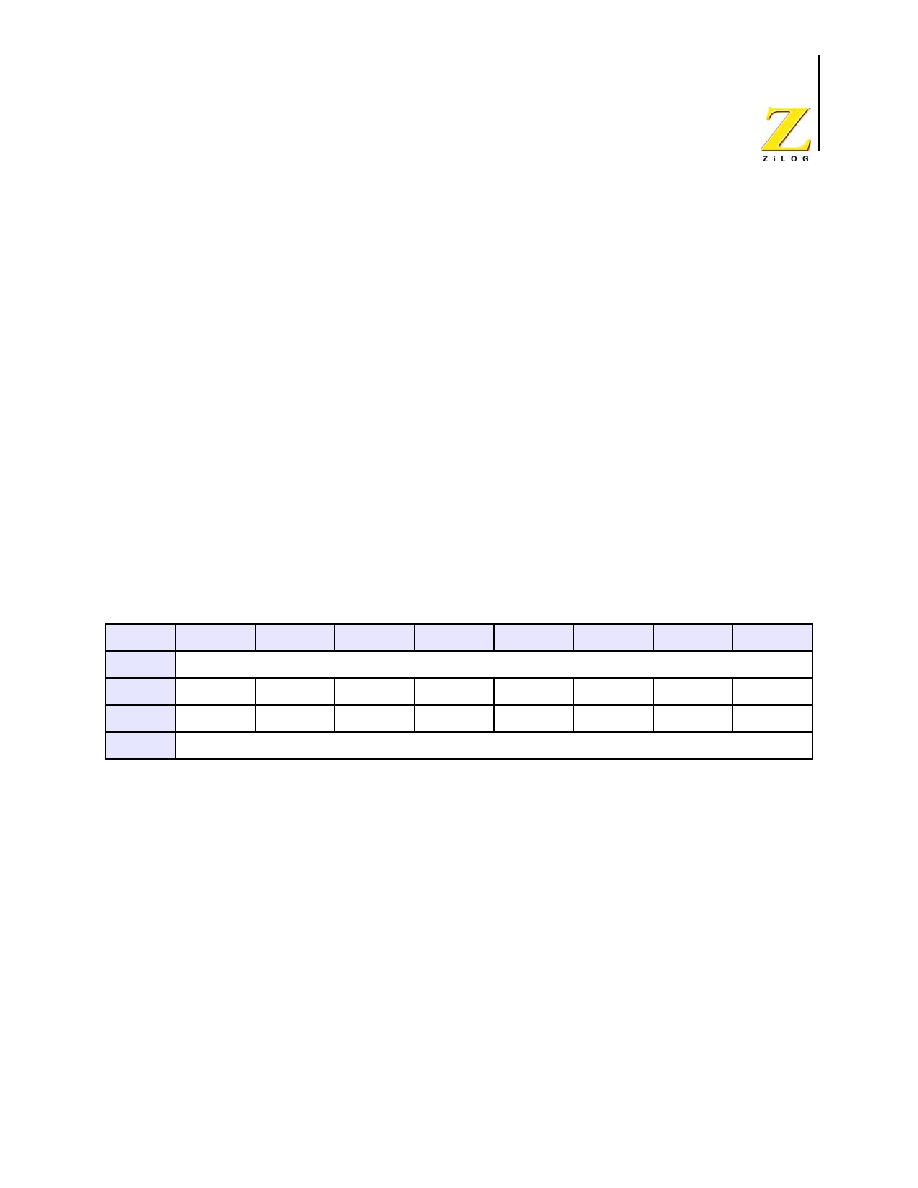
PS024302-0904
P R E L I M I N A R Y Watch-Dog
Timer
Z8 Encore!
Æ
4K Series
Product Specification
82
All three Watch-Dog Timer Reload registers must be written in the order just listed. There
must be no other register writes between each of these operations. If a register write
occurs, the lock state machine resets and no further writes can occur unless the sequence is
restarted. The value in the Watch-Dog Timer Reload registers is loaded into the counter
when the Watch-Dog Timer is first enabled and every time a WDT instruction is executed.
Watch-Dog Timer Control Register Definitions
Watch-Dog Timer Control Register
The Watch-Dog Timer Control (WDTCTL) register is a write-only control register. Writ-
ing the
55H
,
AAH
unlock sequence to the WDTCTL register address unlocks the three
Watch-Dog Timer Reload Byte registers (WDTU, WDTH, and WDTL) to allow changes
to the time-out period. These write operations to the WDTCTL register address produce
no effect on the bits in the WDTCTL register. The locking mechanism prevents spurious
writes to the Reload registers.
This register address is shared with the read-only Reset Status Register.
WDTUNLK--Watch-Dog Timer Unlock
The user software must write the correct unlocking sequence to this register before it is
allowed to modify the contents of the watch-dog timer reload registers.
Watch-Dog Timer Reload Upper, High and Low Byte Registers
The Watch-Dog Timer Reload Upper, High and Low Byte (WDTU, WDTH, WDTL) reg-
isters (Tables 55 through 57) form the 24-bit reload value that is loaded into the Watch-
Dog Timer when a WDT instruction executes. The 24-bit reload value is {WDTU[7:0],
WDTH[7:0], WDTL[7:0]}. Writing to these registers sets the appropriate Reload Value.
Reading from these registers returns the current Watch-Dog Timer count value.
Table 54. Watch-Dog Timer Control Register (WDTCTL)
BITS
7
6
5
4
3
2
1
0
FIELD
WDTUNLK
RESET
X
X
X
X
X
X
X
X
R/W
W
W
W
W
W
W
W
W
ADDR
FF0H
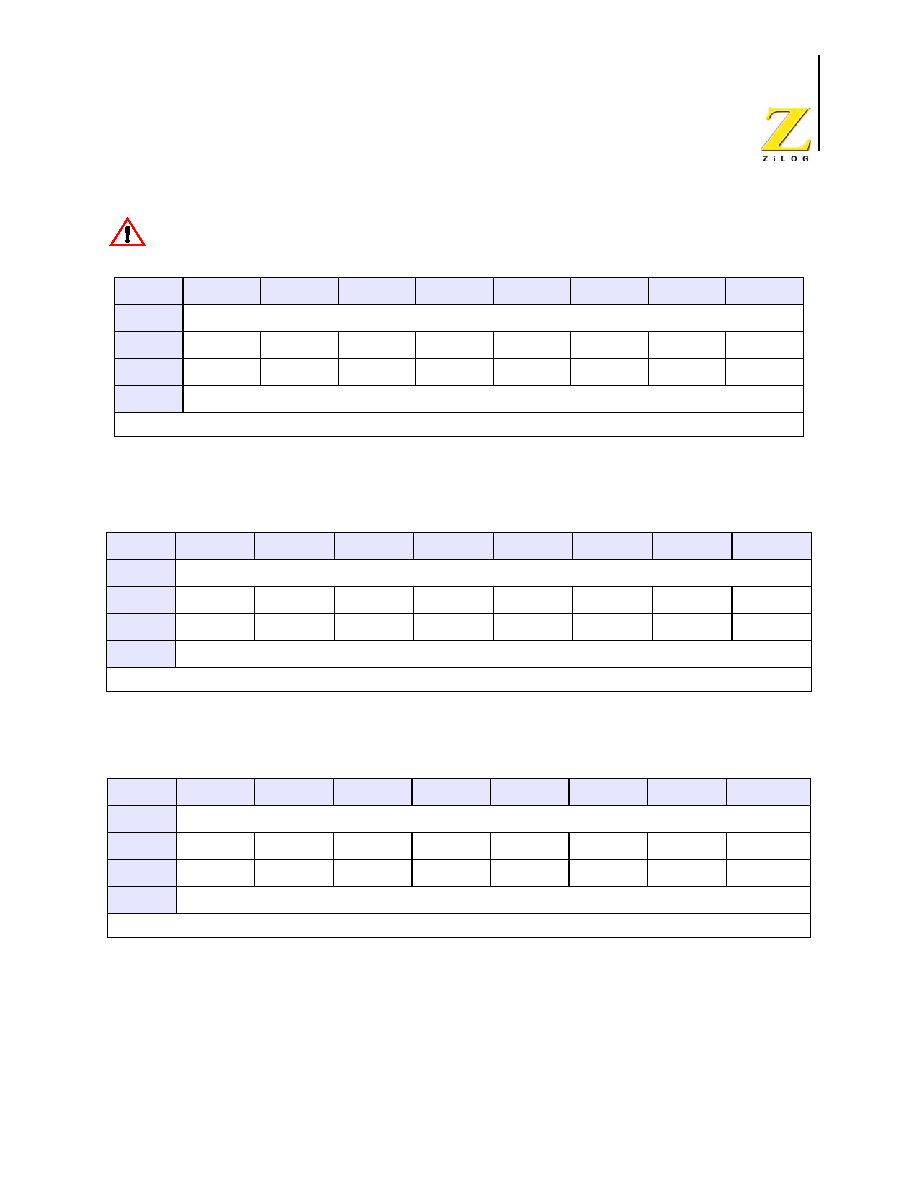
PS024302-0904
P R E L I M I N A R Y Watch-Dog
Timer
Z8 Encore!
Æ
4K Series
Product Specification
83
The 24-bit WDT Reload Value must not be set to a value less than
000004H
.
WDTU--WDT Reload Upper Byte
Most significant byte (MSB), Bits[23:16], of the 24-bit WDT reload value.
WDTH--WDT Reload High Byte
Middle byte, Bits[15:8], of the 24-bit WDT reload value.
WDTL--WDT Reload Low
Least significant byte (LSB), Bits[7:0], of the 24-bit WDT reload value.
Table 55. Watch-Dog Timer Reload Upper Byte Register (WDTU)
BITS
7
6
5
4
3
2
1
0
FIELD
WDTU
RESET
1
1
1
1
1
1
1
1
R/W
R/W*
R/W*
R/W*
R/W*
R/W*
R/W*
R/W*
R/W*
ADDR
FF1H
R/W* - Read returns the current WDT count value. Write sets the appropriate Reload Value.
Table 56. Watch-Dog Timer Reload High Byte Register (WDTH)
BITS
7
6
5
4
3
2
1
0
FIELD
WDTH
RESET
1
1
1
1
1
1
1
1
R/W
R/W*
R/W*
R/W*
R/W*
R/W*
R/W*
R/W*
R/W*
ADDR
FF2H
R/W* - Read returns the current WDT count value. Write sets the appropriate Reload Value.
Table 57. Watch-Dog Timer Reload Low Byte Register (WDTL)
BITS
7
6
5
4
3
2
1
0
FIELD
WDTL
RESET
1
1
1
1
1
1
1
1
R/W
R/W*
R/W*
R/W*
R/W*
R/W*
R/W*
R/W*
R/W*
ADDR
FF3H
R/W* - Read returns the current WDT count value. Write sets the appropriate Reload Value.
Caution:

PS024302-0904
P R E L I M I N A R Y UART
Z8 Encore!
Æ
4K Series
Product Specification
84
UART
Overview
The Universal Asynchronous Receiver/Transmitter (UART) is a full-duplex communica-
tion channel capable of handling asynchronous data transfers. The UART uses a single
8-bit data mode with selectable parity. Features of the UART include:
∑
8-bit asynchronous data transfer
∑
Selectable even- and odd-parity generation and checking
∑
Option of one or two STOP bits
∑
Separate transmit and receive interrupts
∑
Framing, parity, overrun and break detection
∑
Separate transmit and receive enables
∑
16-bit Baud Rate Generator (BRG)
∑
Selectable MULTIPROCESSOR (9-bit) mode with three configurable interrupt schemes
∑
Baud Rate Generator timer mode
∑
Driver Enable output for external bus transceivers
Architecture
The UART consists of three primary functional blocks: transmitter, receiver, and baud rate
generator. The UART's transmitter and receiver function independently, but employ the
same baud rate and data format. Figure 10 illustrates the UART architecture.
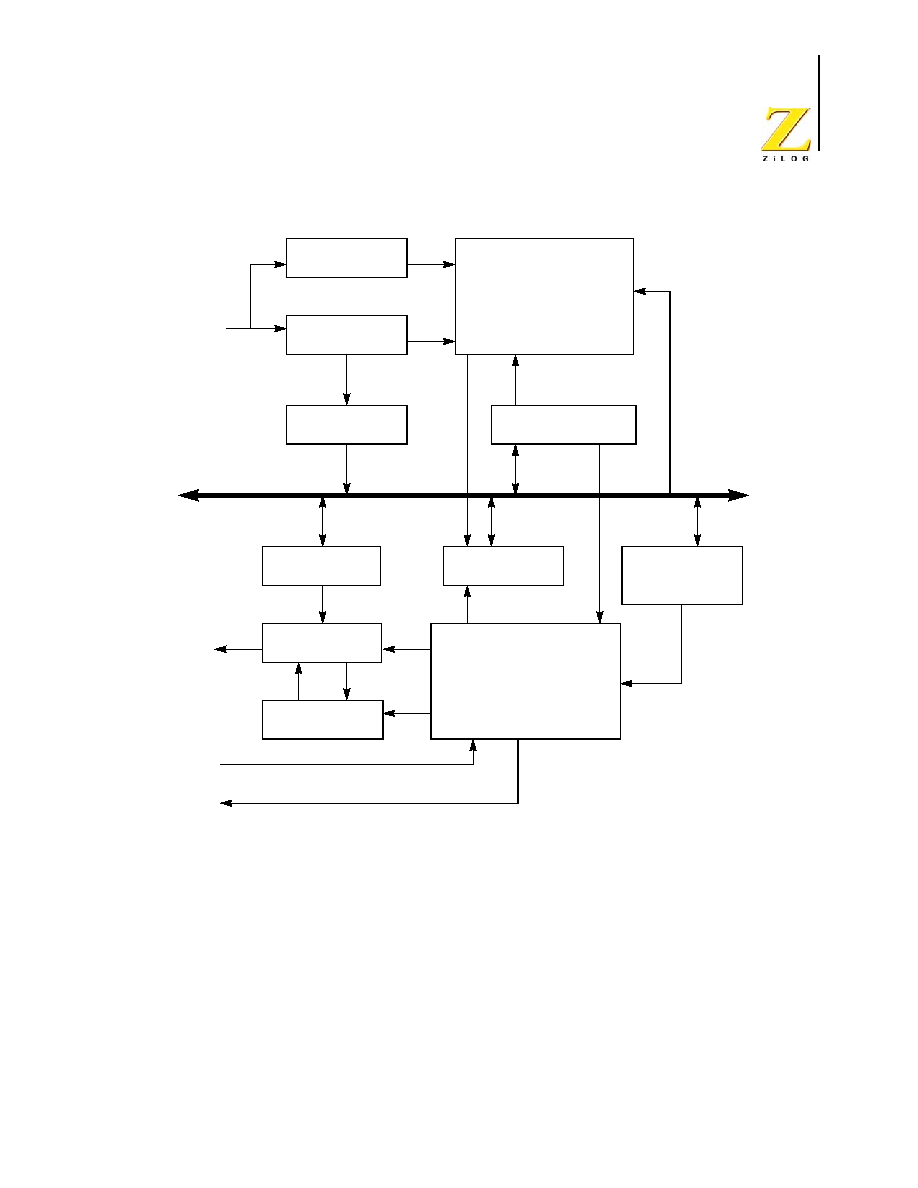
PS024302-0904
P R E L I M I N A R Y UART
Z8 Encore!
Æ
4K Series
Product Specification
85
Figure 10.UART Block Diagram
Operation
Data Format
The UART always transmits and receives data in an 8-bit data format, least-significant bit
first. An even or odd parity bit can be added to the data stream. Each character begins with
an active
Low
Start
bit and ends with either 1 or 2 active High Stop bits. Figures 11 and
12 illustrates the asynchronous data format employed by the UART without parity and
with parity, respectively.
Receive Shifter
Receive Data
Transmit Data
Transmit Shift
TXD
RXD
System Bus
Parity Checker
Parity Generator
Receiver Control
Control Registers
Transmitter Control
CTS
Status Register
Register
Register
Register
Baud Rate
Generator
DE
with Address Compare

PS024302-0904
P R E L I M I N A R Y UART
Z8 Encore!
Æ
4K Series
Product Specification
86
Figure 11.UART Asynchronous Data Format without Parity
Figure 12.UART Asynchronous Data Format with Parity
Transmitting Data using the Polled Method
Follow these steps to transmit data using the polled method of operation:
1. Write to the UART Baud Rate High and Low Byte registers to set the required baud
rate.
2. Enable the UART pin functions by configuring the associated GPIO Port pins for
alternate function operation.
3. Write to the UART Control 1 register, if MULTIPROCESSOR mode is appropriate, to
enable MULTIPROCESSOR (9-bit) mode functions.
4. Set the Multiprocessor Mode Select (MPEN) bit to enable MULTIPROCESSOR mode.
5. Write to the UART Control 0 register to:
≠
Set the transmit enable bit (TEN) to enable the UART for data transmission
≠
Set the parity enable bit (PEN), if parity is appropriate and MULTIPROCESSOR
mode is not enabled, and select either even or odd parity (PSEL).
≠
Set or clear the CTSE bit to enable or disable control from the remote receiver
using the CTS pin.
Start
Bit0
Bit1
Bit2
Bit3
Bit4
Bit5
Bit6
Bit7
Data Field
lsb
msb
Idle State
of Line
Stop Bit(s)
1
2
1
0
Start
Bit0
Bit1
Bit2
Bit3
Bit4
Bit5
Bit6
Bit7
Parity
Data Field
lsb
msb
Idle State
of Line
Stop Bit(s)
1
2
1
0

PS024302-0904
P R E L I M I N A R Y UART
Z8 Encore!
Æ
4K Series
Product Specification
87
6. Check the TDRE bit in the UART Status 0 register to determine if the Transmit Data
register is empty (indicated by a 1). If empty, continue to Step 6. If the Transmit Data
register is full (indicated by a 0), continue to monitor the TDRE bit until the Transmit
Data register becomes available to receive new data.
7. Write the UART Control 1 register to select the outgoing address bit.
8. Set the Multiprocessor Bit Transmitter (MPBT) if sending an address byte, clear it if
sending a data byte.
9. Write the data byte to the UART Transmit Data register. The transmitter automatically
transfers the data to the Transmit Shift register and transmits the data.
10. Make any changes to the Multiprocessor Bit Transmitter (
MPBT
) value, if appropriate
and MULTIPROCESSOR mode is enabled,.
11. To transmit additional bytes, return to Step 5.
Transmitting Data using the Interrupt-Driven Method
The UART Transmitter interrupt indicates the availability of the Transmit Data register to
accept new data for transmission. Follow these steps to configure the UART for interrupt-
driven data transmission:
1. Write to the UART Baud Rate High and Low Byte registers to set the appropriate baud
rate.
2. Enable the UART pin functions by configuring the associated GPIO Port pins for
alternate function operation.
3. Execute a DI instruction to disable interrupts.
4. Write to the Interrupt control registers to enable the UART Transmitter interrupt and
set the acceptable priority.
5. Write to the UART Control 1 register to enable MULTIPROCESSOR (9-bit) mode
functions, if MULTIPROCESSOR mode is appropriate.
6. Set the MULTIPROCESSOR Mode Select (MPEN) to Enable MULTIPROCESSOR
mode.
7. Write to the UART Control 0 register to:
≠
Set the transmit enable bit (TEN) to enable the UART for data transmission
≠
Enable parity, if appropriate and if MULTIPROCESSOR mode is not enabled, and
select either even or odd parity.
≠
Set or clear CTSE to enable or disable control from the remote receiver using the
CTS pin.
8. Execute an EI instruction to enable interrupts.

PS024302-0904
P R E L I M I N A R Y UART
Z8 Encore!
Æ
4K Series
Product Specification
88
The UART is now configured for interrupt-driven data transmission. Because the UART
Transmit Data register is empty, an interrupt is generated immediately. When the UART
Transmit interrupt is detected, the associated interrupt service routine (ISR) performs the
following:
1. Write the UART Control 1 register to select the multiprocessor bit for the byte to be
transmitted:
Set the Multiprocessor Bit Transmitter (MPBT) if sending an address byte, clear it if
sending a data byte.
2. Write the data byte to the UART Transmit Data register. The transmitter automatically
transfers the data to the Transmit Shift register and transmits the data.
3. Clear the UART Transmit interrupt bit in the applicable Interrupt Request register.
4. Execute the IRET instruction to return from the interrupt-service routine and wait for
the Transmit Data register to again become empty.
Receiving Data using the Polled Method
Follow these steps to configure the UART for polled data reception:
5. Write to the UART Baud Rate High and Low Byte registers to set an acceptable baud
rate for the incoming data stream.
6. Enable the UART pin functions by configuring the associated GPIO Port pins for
alternate function operation.
7. Write to the UART Control 1 register to enable MULTIPROCESSOR mode functions,
if appropriate.
8. Write to the UART Control 0 register to:
≠
Set the receive enable bit (REN) to enable the UART for data reception
≠
Enable parity, if appropriate and if Multiprocessor mode is not enabled, and select
either even or odd parity.
9. Check the RDA bit in the UART Status 0 register to determine if the Receive Data
register contains a valid data byte (indicated by a 1). If RDA is set to 1 to indicate
available data, continue to Step 5. If the Receive Data register is empty (indicated by a
0), continue to monitor the RDA bit awaiting reception of the valid data.
10. Read data from the UART Receive Data register. If operating in MULTIPROCESSOR
(9-bit) mode, further actions may be required depending on the MULTIPROCESSOR
mode bits MPMD[1:0].
11. Return to Step 4 to receive additional data.

PS024302-0904
P R E L I M I N A R Y UART
Z8 Encore!
Æ
4K Series
Product Specification
89
Receiving Data using the Interrupt-Driven Method
The UART Receiver interrupt indicates the availability of new data (as well as error condi-
tions). Follow these steps to configure the UART receiver for interrupt-driven operation:
1. Write to the UART Baud Rate High and Low Byte registers to set the acceptable baud
rate.
2. Enable the UART pin functions by configuring the associated GPIO Port pins for
alternate function operation.
3. Execute a DI instruction to disable interrupts.
4. Write to the Interrupt control registers to enable the UART Receiver interrupt and set
the acceptable priority.
5. Clear the UART Receiver interrupt in the applicable Interrupt Request register.
6. Write to the UART Control 1 Register to enable Multiprocessor (9-bit) mode
functions, if appropriate.
≠
Set the Multiprocessor Mode Select (MPEN) to Enable MULTIPROCESSOR
mode.
≠
Set the Multiprocessor Mode Bits, MPMD[1:0], to select the acceptable address
matching scheme.
≠
Configure the UART to interrupt on received data and errors or errors only
(interrupt on errors only is unlikely to be useful for Z8 Encore!
Æ
devices without a
DMA block)
7. Write the device address to the Address Compare Register (automatic
MULTIPROCESSOR modes only).
8. Write to the UART Control 0 register to:
≠
Set the receive enable bit (REN) to enable the UART for data reception
≠
Enable parity, if appropriate and if multiprocessor mode is not enabled, and select
either even or odd parity.
9. Execute an EI instruction to enable interrupts.
The UART is now configured for interrupt-driven data reception. When the UART
Receiver interrupt is detected, the associated interrupt service routine (ISR) performs the
following:
1. Checks the UART Status 0 register to determine the source of the interrupt - error,
break, or received data.
2. Reads the data from the UART Receive Data register if the interrupt was because of
data available. If operating in MULTIPROCESSOR (9-bit) mode, further actions may
be required depending on the MULTIPROCESSOR mode bits MPMD[1:0].
3. Clears the UART Receiver interrupt in the applicable Interrupt Request register.
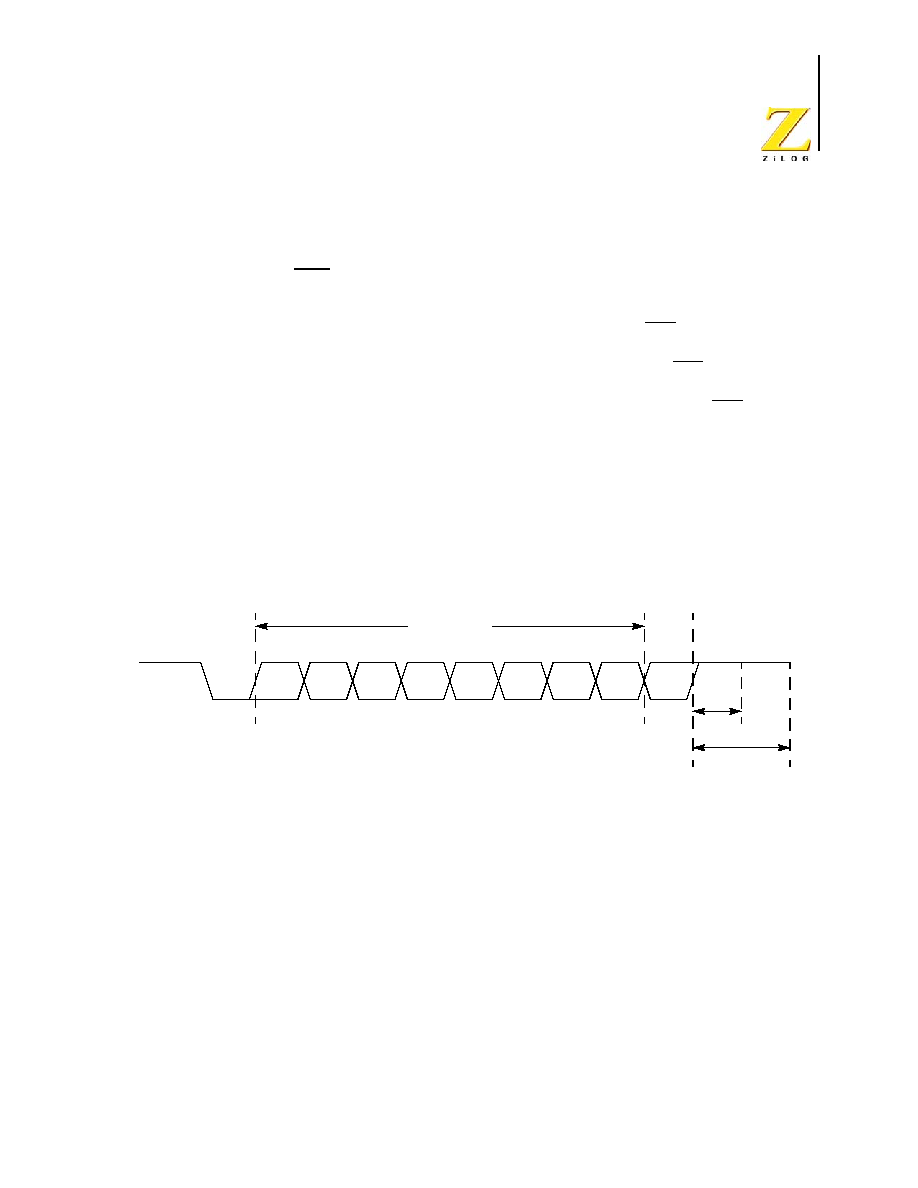
PS024302-0904
P R E L I M I N A R Y UART
Z8 Encore!
Æ
4K Series
Product Specification
90
4. Executes the IRET instruction to return from the interrupt-service routine and await
more data.
Clear To Send (CTS) Operation
The CTS pin, if enabled by the CTSE bit of the UART Control 0 register, performs flow
control on the outgoing transmit datastream. The Clear To Send (CTS) input pin is sam-
pled one system clock before beginning any new character transmission. To delay trans-
mission of the next data character, an external receiver must deassert CTS at least one
system clock cycle before a new data transmission begins. For multiple character trans-
missions, this action is typically performed during Stop Bit transmission. If CTS deasserts
in the middle of a character transmission, the current character is sent completely.
MULTIPROCESSOR (9-bit) Mode
The UART has a MULTIPROCESSOR (9-bit) mode that uses an extra (9th) bit for selec-
tive communication when a number of processors share a common UART bus. In MULTI-
PROCESSOR mode (also referred to as 9-Bit mode), the multiprocessor bit (
MP
) is
transmitted immediately following the 8-bits of data and immediately preceding the Stop
bit(s) as illustrated in Figure 13. The character format is:
Figure 13.UART Asynchronous MULTIPROCESSOR Mode Data Format
In MULTIPROCESSOR (9-bit) mode, the Parity bit location (9th bit) becomes the Multi-
processor control bit. The UART Control 1 and Status 1 registers provide MULTIPRO-
CESSOR (9-bit) mode control and status information. If an automatic address matching
scheme is enabled, the UART Address Compare register holds the network address of the
device.
MULTIPROCESSOR (9-bit) Mode Receive Interrupts
When MULTIPROCESSOR mode is enabled, the UART only processes frames addressed
to it. The determination of whether a frame of data is addressed to the UART can be made
in hardware, software or some combination of the two, depending on the multiprocessor
configuration bits. In general, the address compare feature reduces the load on the CPU,
because it does not require access to the UART when it receives data directed to other
Start
Bit0
Bit1
Bit2
Bit3
Bit4
Bit5
Bit6
Bit7
MP
Data Field
lsb
msb
Idle State
of Line
Stop Bit(s)
1
2
1
0

PS024302-0904
P R E L I M I N A R Y UART
Z8 Encore!
Æ
4K Series
Product Specification
91
devices on the multi-node network. The following three MULTIPROCESSOR modes are
available in hardware:
∑
Interrupt on all address bytes
∑
Interrupt on matched address bytes and correctly framed data bytes
∑
Interrupt only on correctly framed data bytes
These modes are selected with MPMD[1:0] in the UART Control 1 Register. For all mul-
tiprocessor modes, bit MPEN of the UART Control 1 Register must be set to 1.
The first scheme is enabled by writing
01b
to MPMD[1:0]. In this mode, all incoming
address bytes cause an interrupt, while data bytes never cause an interrupt. The interrupt
service routine must manually check the address byte that caused triggered the interrupt. If
it matches the UART address, the software clears MPMD[0]. Each new incoming byte
interrupts the CPU. The software is responsible for determining the end of the frame. It
checks for the end-of-frame by reading the MPRX bit of the UART Status 1 Register for
each incoming byte. If MPRX=1, a new frame has begun. If the address of this new frame
is different from the UART's address, MPMD[0] must be set to 1 causing the UART inter-
rupts to go inactive until the next address byte. If the new frame's address matches the
UART's, the data in the new frame is processed as well.
The second scheme requires the following: set MPMD[1:0] to
10B
and write the UART's
address into the UART Address Compare Register. This mode introduces additional hard-
ware control, interrupting only on frames that match the UART's address. When an
incoming address byte does not match the UART's address, it is ignored. All successive
data bytes in this frame are also ignored. When a matching address byte occurs, an inter-
rupt is issued and further interrupts now occur on each succesive data byte. When the first
data byte in the frame is read, the NEWFRM bit of the UART Status 1 Register is asserted.
All successive data bytes have NEWFRM=0. When the next address byte occurs, the hard-
ware compares it to the UART's address. If there is a match, the interrupts continues and
the NEWFRM bit is set for the first byte of the new frame. If there is no match, the UART
ignores all incoming bytes until the next address match.
The third scheme is enabled by setting MPMD[1:0] to
11b
and by writing the UART's
address into the UART Address Compare Register. This mode is identical to the second
scheme, except that there are no interrupts on address bytes. The first data byte of each
frame remains accompanied by a NEWFRM assertion.
External Driver Enable
The UART provides a Driver Enable (DE) signal for off-chip bus transceivers. This fea-
ture reduces the software overhead associated with using a GPIO pin to control the trans-
ceiver when communicating on a multi-transceiver bus, such as RS-485.
Driver Enable is an active High signal that envelopes the entire transmitted data frame
including parity and Stop bits as illustrated in Figure 14. The Driver Enable signal asserts
when a byte is written to the UART Transmit Data register. The Driver Enable signal
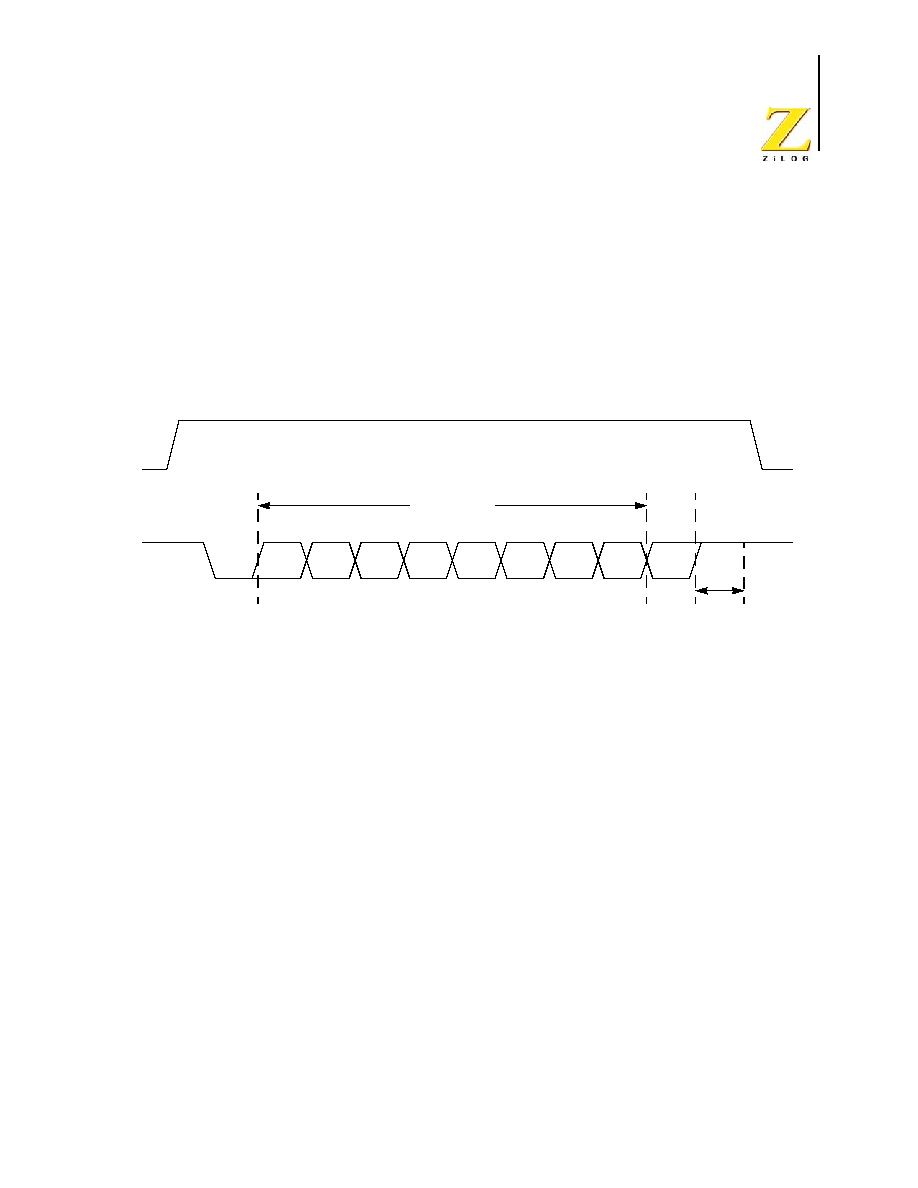
PS024302-0904
P R E L I M I N A R Y UART
Z8 Encore!
Æ
4K Series
Product Specification
92
asserts at least one UART bit period and no greater than two UART bit periods before the
Start bit is transmitted. This allows a setup time to enable the transceiver. The Driver
Enable signal deasserts one system clock period after the final Stop bit is transmitted. This
one system clock delay allows both time for data to clear the transceiver before disabling
it, as well as the ability to determine if another character follows the current character. In
the event of back to back characters (new data must be written to the Transmit Data Regis-
ter before the previous character is completely transmitted) the DE signal is not deasserted
between characters. The Depol bit in the UART Control Register 1 sets the polarity of the
Driver Enable signal.
Figure 14.UART Driver Enable Signal Timing (shown with 1 Stop Bit and Parity)
The Driver Enable to Start bit setup time is calculated as follows:
UART Interrupts
The UART features separate interrupts for the transmitter and the receiver. In addition,
when the UART primary functionality is disabled, the Baud Rate Generator can also func-
tion as a basic timer with interrupt capability.
Transmitter Interrupts
The transmitter generates a single interrupt when the Transmit Data Register Empty bit
(TDRE) is set to 1. This indicates that the transmitter is ready to accept new data for trans-
mission. The TDRE interrupt occurs after the Transmit shift register has shifted the first
bit of data out. The Transmit Data register can now be written with the next character to
send. This action provides 7 bit periods of latency to load the Transmit Data register
before the Transmit shift register completes shifting the current character. Writing to the
UART Transmit Data register clears the TDRE bit to 0.
Start
Bit0
Bit1
Bit2
Bit3
Bit4
Bit5
Bit6
Bit7
Parity
Data Field
lsb
msb
Idle State
of Line
Stop Bit
1
1
0
0
1
DE
1
Baud Rate (Hz)
-------------------------------------
DE to Start Bit Setup Time (s)
2
Baud Rate (Hz)
-------------------------------------

PS024302-0904
P R E L I M I N A R Y UART
Z8 Encore!
Æ
4K Series
Product Specification
93
Receiver Interrupts
The receiver generates an interrupt when any of the following occurs:
∑
A data byte is received and is available in the UART Receive Data register. This interrupt
can be disabled independently of the other receiver interrupt sources. The received data in-
terrupt occurs after the receive character has been received and placed in the Receive Data
register. To avoid an overrun error, software must respond to this received data available
condition before the next character is completely received.
In MULTIPROCESSOR mode (MPEN = 1), the receive data interrupts are dependent on
the multiprocessor configuration and the most recent address byte.
∑
A break is received
∑
An overrun is detected
∑
A data framing error is detected
UART Overrun Errors
When an overrun error condition occurs the UART prevents overwriting of the valid data
currently in the Receive Data register. The Break Detect and Overrun status bits are not
displayed until after the valid data has been read.
After the valid data has been read, the UART Status 0 register is updated to indicate the
overrun condition (and Break Detect, if applicable). The RDA bit is set to 1 to indicate that
the Receive Data register contains a data byte. However, because the overrun error
occurred, this byte may not contain valid data and must be ignored. The BRKD bit indi-
cates if the overrun was caused by a break condition on the line. After reading the status
byte indicating an overrun error, the Receive Data register must be read again to clear the
error bits is the UART Status 0 register. Updates to the Receive Data register occur only
when the next data word is received.
UART Data and Error Handling Procedure
Figure 15 illustrates the recommended procedure for use in UART receiver interrupt ser-
vice routines.
Note:
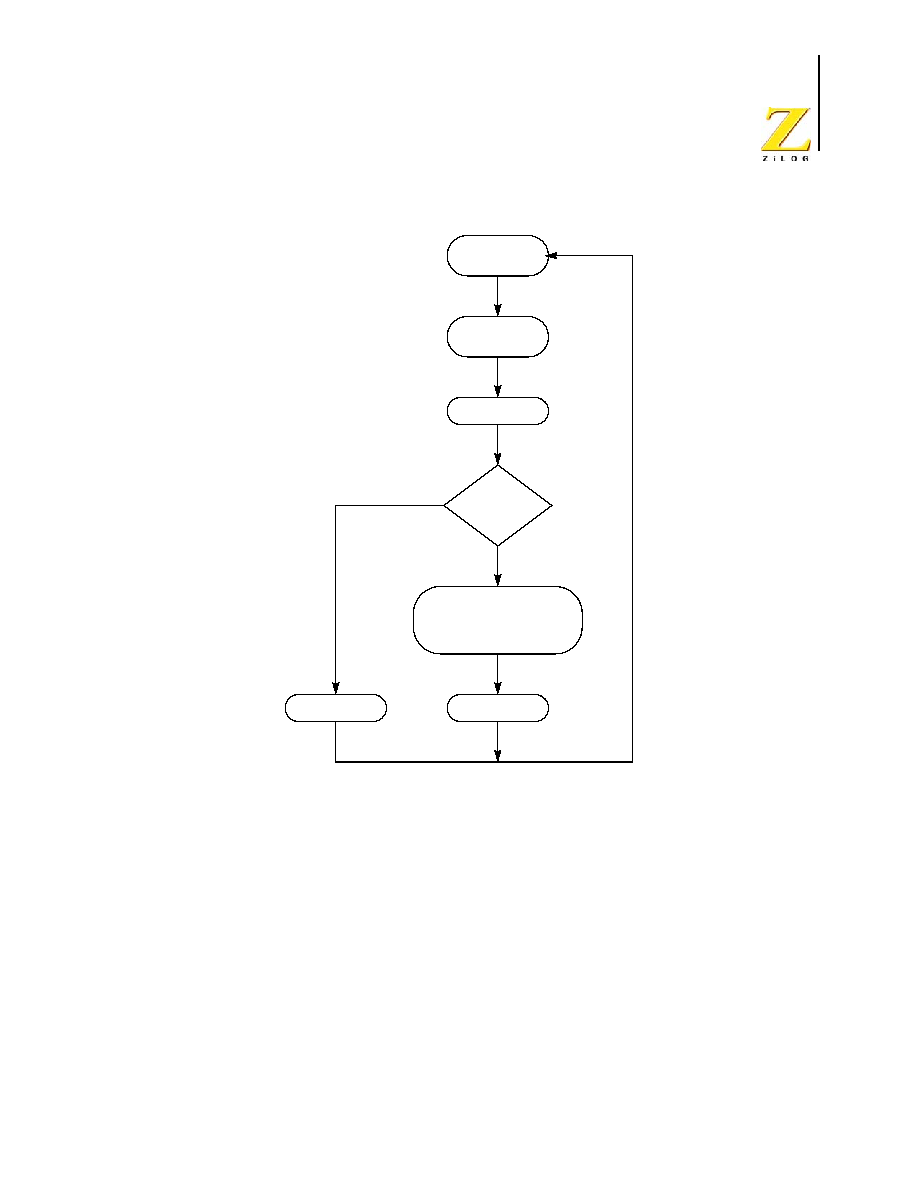
PS024302-0904
P R E L I M I N A R Y UART
Z8 Encore!
Æ
4K Series
Product Specification
94
Figure 15.UART Receiver Interrupt Service Routine Flow
Baud Rate Generator Interrupts
If the Baud Rate Generator (BRG) interrupt enable is set, the UART Receiver interrupt
asserts when the UART Baud Rate Generator reloads. This condition allows the Baud
Rate Generator to function as an additional counter if the UART functionality is not
employed.
UART Baud Rate Generator
The UART Baud Rate Generator creates a lower frequency baud rate clock for data trans-
mission. The input to the Baud Rate Generator is the system clock. The UART Baud Rate
High and Low Byte registers combine to create a 16-bit baud rate divisor value
Receiver
Errors?
No
Yes
Read Status
Discard Data
Read Data which
Interrupt
Receiver
Ready
clears RDA bit and
resets error bits
Read Data
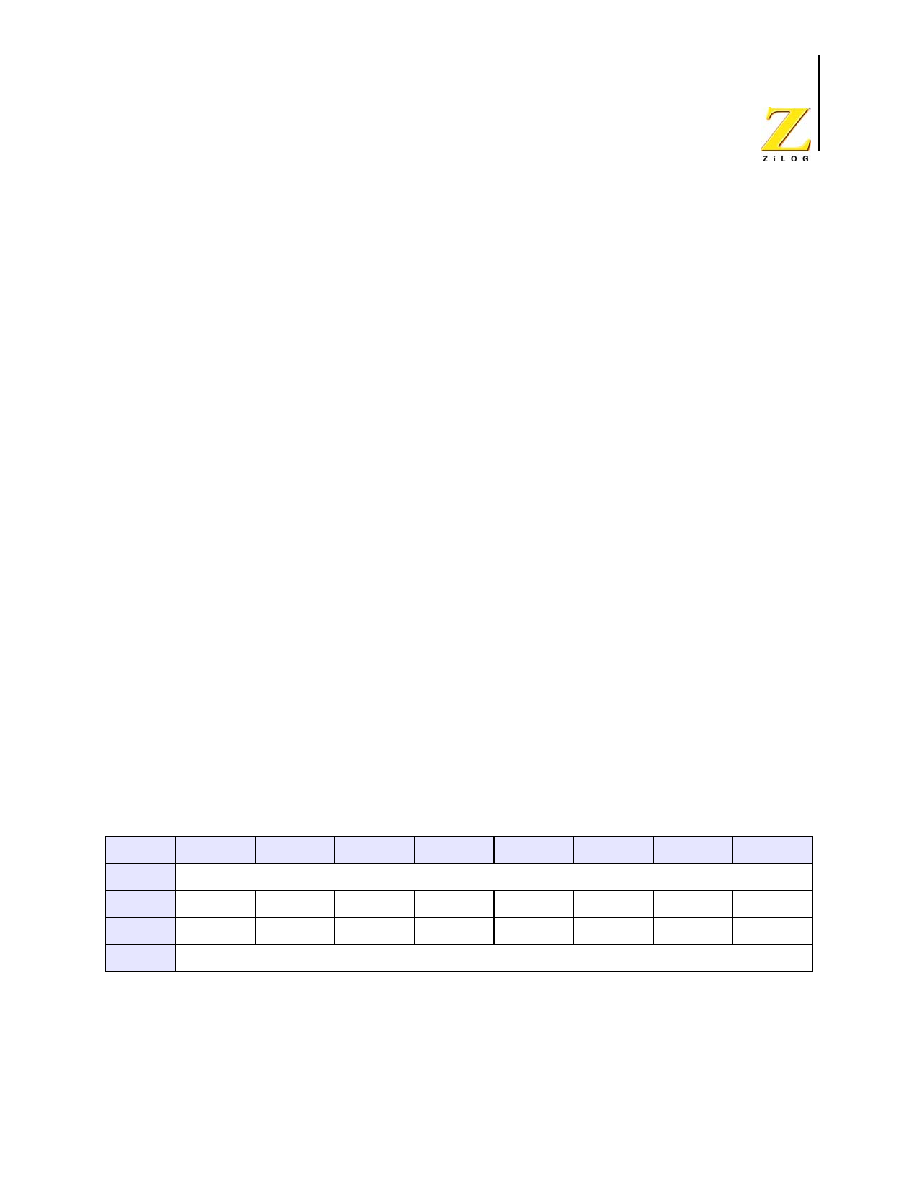
PS024302-0904
P R E L I M I N A R Y UART
Z8 Encore!
Æ
4K Series
Product Specification
95
(BRG[15:0]) that sets the data transmission rate (baud rate) of the UART. The UART data
rate is calculated using the following equation:
When the UART is disabled, the Baud Rate Generator functions as a basic 16-bit timer
with interrupt on time-out. To configure the Baud Rate Generator as a timer with interrupt
on time-out, complete the following procedure:
1. Disable the UART by clearing the REN and TEN bits in the UART Control 0 register
to 0.
2. Load the acceptable 16-bit count value into the UART Baud Rate High and Low Byte
registers.
3. Enable the Baud Rate Generator timer function and associated interrupt by setting the
BIRQ
bit in the UART Control 1 register to 1.
UART Control Register Definitions
The UART control registers support the UART and the associated Infrared Encoder/
Decoders. For more information about the infrared operation, refer to the
Infrared
Encoder/Decoder
chapter on page 103.
UART Transmit Data Register
Data bytes written to the UART Transmit Data register (Table 58) are shifted out on the
TXDx
pin. The Write-only UART Transmit Data register shares a Register File address
with the read-only UART Receive Data register.
TXD--Transmit Data
UART transmitter data byte to be shifted out through the TXDx pin.
Table 58. UART Transmit Data Register (U0TXD)
BITS
7
6
5
4
3
2
1
0
FIELD
TXD
RESET
X
X
X
X
X
X
X
X
R/W
W
W
W
W
W
W
W
W
ADDR
F40H
UART Data Rate (bits/s)
System Clock Frequency (Hz)
16 UART Baud Rate Divisor Value
◊
----------------------------------------------------------------------------------------------
=
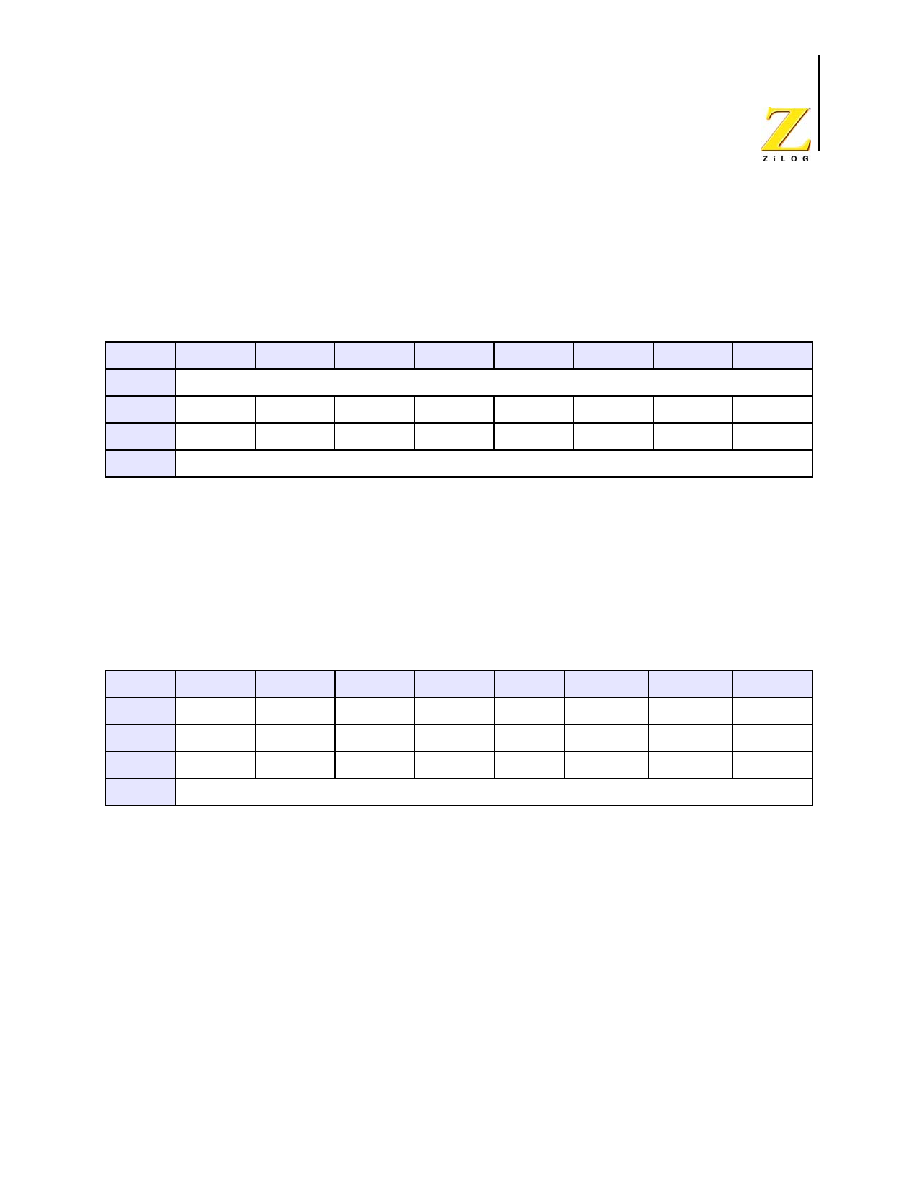
PS024302-0904
P R E L I M I N A R Y UART
Z8 Encore!
Æ
4K Series
Product Specification
96
UART Receive Data Register
Data bytes received through the RXDx pin are stored in the UART Receive Data register
(Table 59). The read-only UART Receive Data register shares a Register File address with
the Write-only UART Transmit Data register.
RXD--Receive Data
UART receiver data byte from the RXDx pin
UART Status 0 Register
The UART Status 0 and Status 1 registers (Table 60 and 54) identify the current UART
operating configuration and status.
RDA--Receive Data Available
This bit indicates that the UART Receive Data register has received data. Reading the
UART Receive Data register clears this bit.
0 = The UART Receive Data register is empty.
1 = There is a byte in the UART Receive Data register.
PE--Parity Error
This bit indicates that a parity error has occurred. Reading the UART Receive Data regis-
ter clears this bit.
0 = No parity error has occurred.
1 = A parity error has occurred.
OE--Overrun Error
This bit indicates that an overrun error has occurred. An overrun occurs when new data is
Table 59. UART Receive Data Register (U0RXD)
BITS
7
6
5
4
3
2
1
0
FIELD
RXD
RESET
X
X
X
X
X
X
X
X
R/W
R
R
R
R
R
R
R
R
ADDR
F40H
Table 60. UART Status 0 Register (U0STAT0)
BITS
7
6
5
4
3
2
1
0
FIELD
RDA
PE
OE
FE
BRKD
TDRE
TXE
CTS
RESET
0
0
0
0
0
1
1
X
R/W
R
R
R
R
R
R
R
R
ADDR
F41H
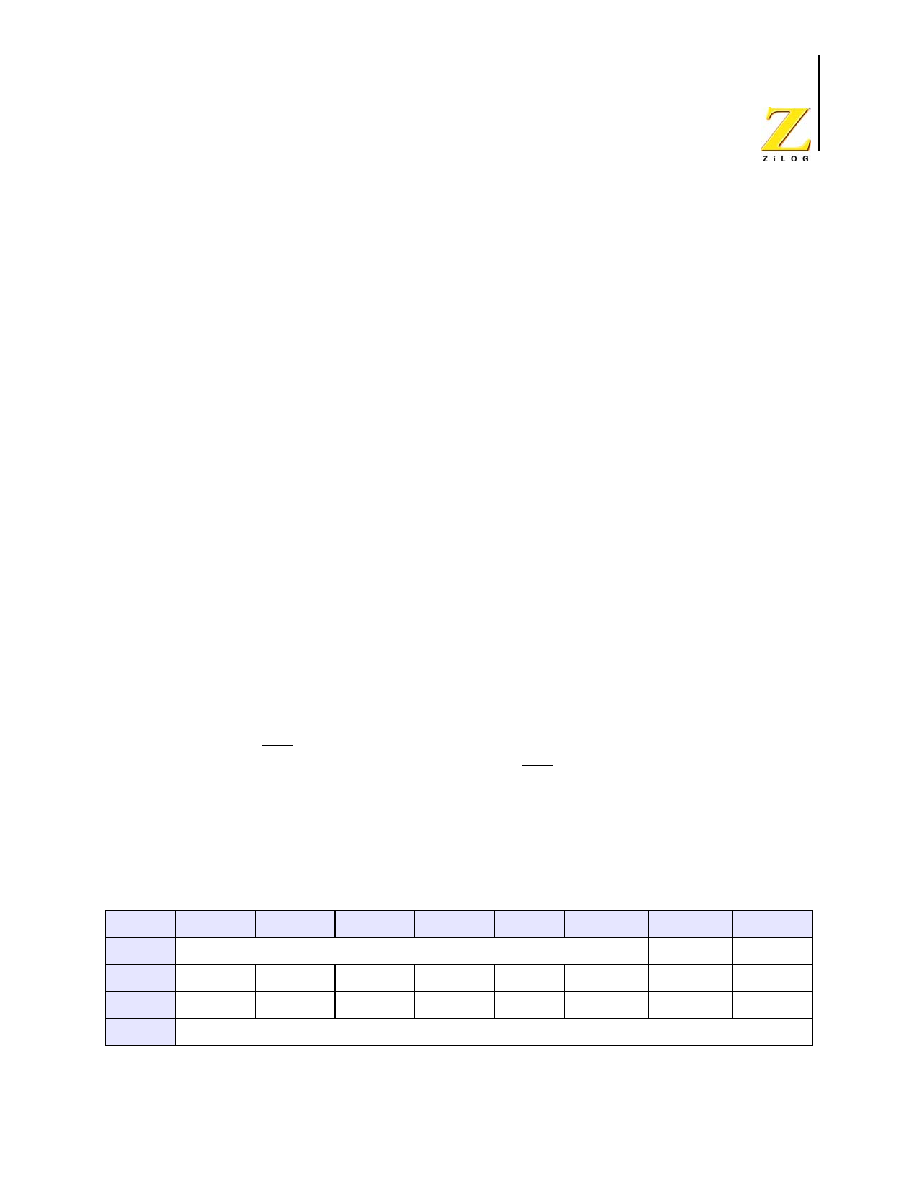
PS024302-0904
P R E L I M I N A R Y UART
Z8 Encore!
Æ
4K Series
Product Specification
97
received and the UART Receive Data register has not been read. If the RDA bit is reset to
0, reading the UART Receive Data register clears this bit.
0 = No overrun error occurred.
1 = An overrun error occurred.
FE--Framing Error
This bit indicates that a framing error (no Stop bit following data reception) was detected.
Reading the UART Receive Data register clears this bit.
0 = No framing error occurred.
1 = A framing error occurred.
BRKD--Break Detect
This bit indicates that a break occurred. If the data bits, parity/multiprocessor bit, and Stop
bit(s) are all 0s this bit is set to 1. Reading the UART Receive Data register clears this bit.
0 = No break occurred.
1 = A break occurred.
TDRE--Transmitter Data Register Empty
This bit indicates that the UART Transmit Data register is empty and ready for additional
data. Writing to the UART Transmit Data register resets this bit.
0 = Do not write to the UART Transmit Data register.
1 = The UART Transmit Data register is ready to receive an additional byte to be transmit-
ted.
TXE--Transmitter Empty
This bit indicates that the transmit shift register is empty and character transmission is fin-
ished.
0 = Data is currently transmitting.
1 = Transmission is complete.
CTS--CTS signal
When this bit is read it returns the level of the CTS signal. This signal is active Low.
UART Status 1 Register
This register contains multiprocessor control and status bits.
Table 61. UART Status 1 Register (U0STAT1)
BITS
7
6
5
4
3
2
1
0
FIELD
Reserved
NEWFRM
MPRX
RESET
0
0
0
0
0
0
0
0
R/W
R
R
R
R
R/W
R/W
R
R
ADDR
F44H
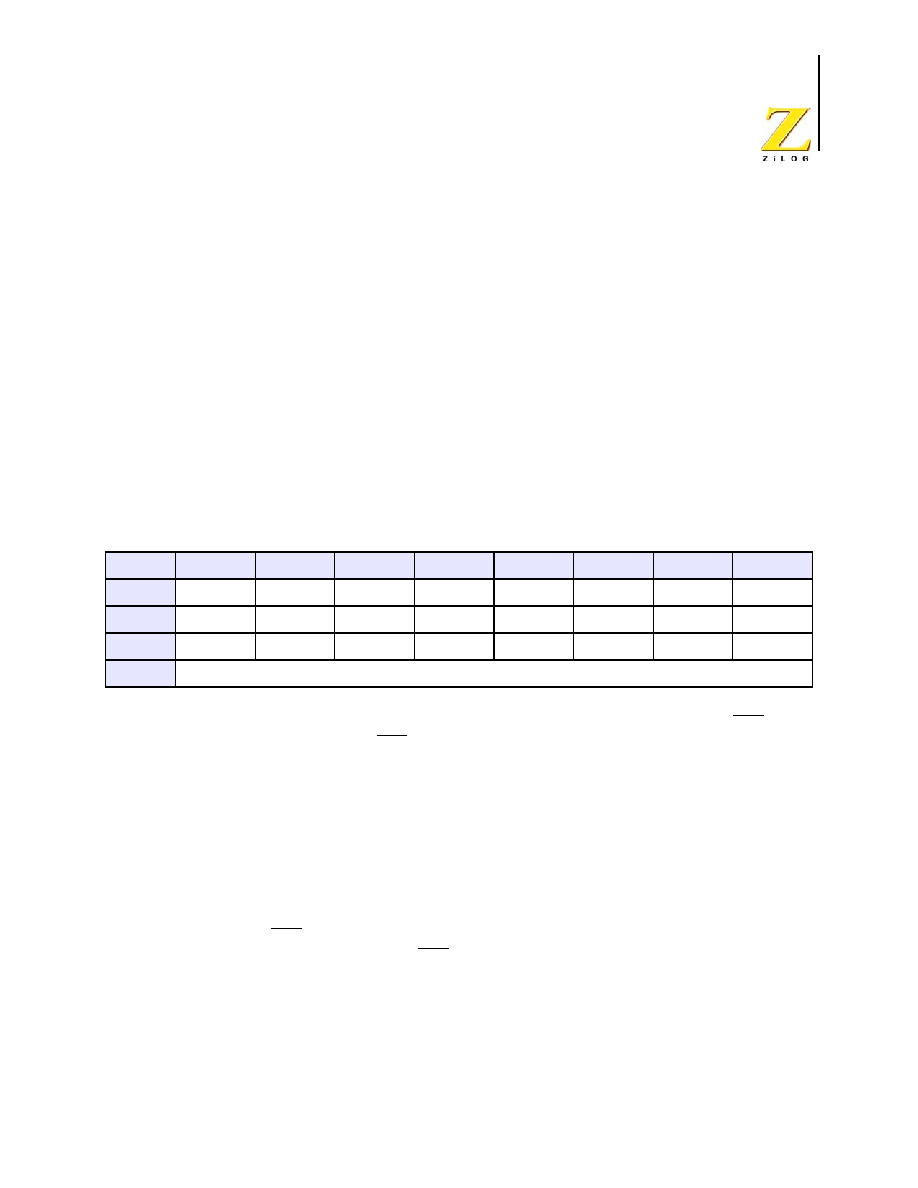
PS024302-0904
P R E L I M I N A R Y UART
Z8 Encore!
Æ
4K Series
Product Specification
98
Reserved--Must be 0.
NEWFRM--Status bit denoting the start of a new frame. Reading the UART Receive
Data register resets this bit to 0.
0 = The current byte is not the first data byte of a new frame.
1 = The current byte is the first data byte of a new frame.
MPRX--Multiprocessor Receive
Returns the value of the most recent multiprocessor bit received. Reading from the UART
Receive Data register resets this bit to 0.
UART Control 0 and Control 1 Registers
The UART Control 0 and Control 1 registers (Tables 62 and 63) configure the properties
of the UART's transmit and receive operations. The UART Control registers must not be
written while the UART is enabled.
TEN--Transmit Enable
This bit enables or disables the transmitter. The enable is also controlled by the CTS signal
and the CTSE bit. If the CTS signal is low and the CTSE bit is 1, the transmitter is
enabled.
0 = Transmitter disabled.
1 = Transmitter enabled.
REN--Receive Enable
This bit enables or disables the receiver.
0 = Receiver disabled.
1 = Receiver enabled.
CTSE--CTS Enable
0 = The CTS signal has no effect on the transmitter.
1 = The UART recognizes the CTS signal as an enable control from the transmitter.
PEN--Parity Enable
This bit enables or disables parity. Even or odd is determined by the PSEL bit.
0 = Parity is disabled.
1 = The transmitter sends data with an additional parity bit and the receiver receives an
additional parity bit.
Table 62. UART Control 0 Register (U0CTL0)
BITS
7
6
5
4
3
2
1
0
FIELD
TEN
REN
CTSE
PEN
PSEL
SBRK
STOP
LBEN
RESET
0
0
0
0
0
0
0
0
R/W
R/W
R/W
R/W
R/W
R/W
R/W
R/W
R/W
ADDR
F42H
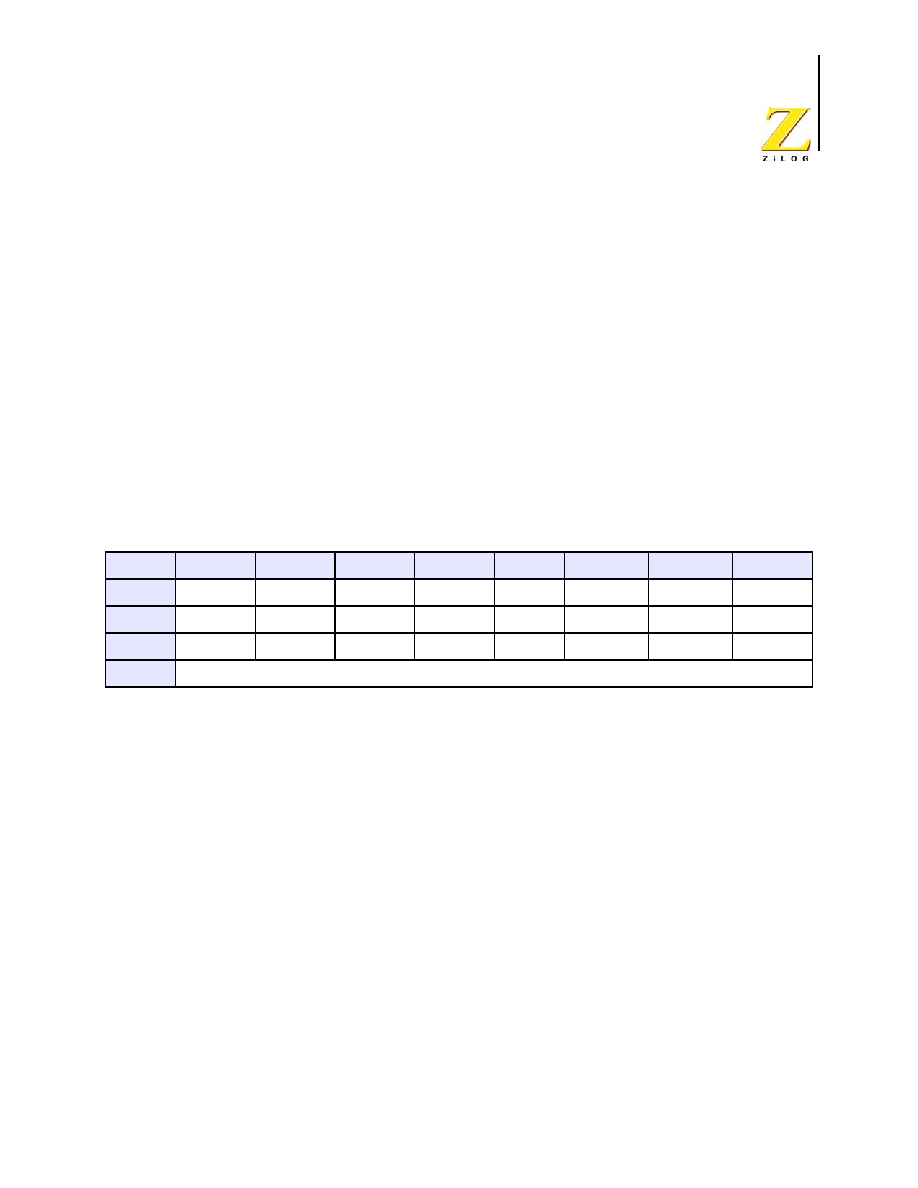
PS024302-0904
P R E L I M I N A R Y UART
Z8 Encore!
Æ
4K Series
Product Specification
99
PSEL--Parity Select
0 = Even parity is transmitted and expected on all received data.
1 = Odd parity is transmitted and expected on all received data.
SBRK--Send Break
This bit pauses or breaks data transmission. Sending a break interrupts any transmission in
progress, so ensure that the transmitter has finished sending data before setting this bit.
0 = No break is sent.
1 = Forces a break condition by setting the output of the transmitter to zero.
STOP--Stop Bit Select
0 = The transmitter sends one stop bit.
1 = The transmitter sends two stop bits.
LBEN--Loop Back Enable
0 = Normal operation.
1 = All transmitted data is looped back to the receiver.
MPMD[1:0]--MULTIPROCESSOR Mode
If MULTIPROCESSOR (9-bit) mode is enabled,
00 = The UART generates an interrupt request on all received bytes (data and address).
01 = The UART generates an interrupt request only on received address bytes.
10 = The UART generates an interrupt request when a received address byte matches the
value stored in the Address Compare Register and on all successive data bytes until an
address mismatch occurs.
11 = The UART generates an interrupt request on all received data bytes for which the
most recent address byte matched the value in the Address Compare Register.
MPEN--MULTIPROCESSOR (9-bit) Enable
This bit is used to enable MULTIPROCESSOR (9-bit) mode.
0 = Disable MULTIPROCESSOR (9-bit) mode.
1 = Enable MULTIPROCESSOR (9-bit) mode.
MPBT--Multiprocessor Bit Transmit
This bit is applicable only when MULTIPROCESSOR (9-bit) mode is enabled. The 9th bit
is used by the receiving device to determine if the data byte contains address or data infor-
mation.
Table 63. UART Control 1 Register (U0CTL1)
BITS
7
6
5
4
3
2
1
0
FIELD
MPMD[1]
MPEN
MPMD[0]
MPBT
DEPOL
BRGCTL
RDAIRQ
IREN
RESET
0
0
0
0
0
0
0
0
R/W
R/W
R/W
R/W
R/W
R/W
R/W
R/W
R/W
ADDR
F43H

PS024302-0904
P R E L I M I N A R Y UART
Z8 Encore!
Æ
4K Series
Product Specification
100
0 = Send a 0 in the multiprocessor bit location of the data stream (data byte).
1 = Send a 1 in the multiprocessor bit location of the data stream (address byte).
DEPOL--Driver Enable Polarity
0 = DE signal is Active High.
1 = DE signal is Active Low.
BRGCTL--Baud Rate Control
This bit causes an alternate UART behavior depending on the value of the REN bit in the
UART Control 0 Register.
When the UART receiver is not enabled (REN=0), this bit determines whether the Baud
Rate Generator issues interrupts.
0 = Reads from the Baud Rate High and Low Byte registers return the BRG Reload Value
1 = The Baud Rate Generator generates a receive interrupt when it counts down to 0.
Reads from the Baud Rate High and Low Byte registers return the current BRG count
value.
When the UART receiver is enabled (REN=1), this bit allows reads from the Baud Rate
Registers to return the BRG count value instead of the Reload Value.
0 = Reads from the Baud Rate High and Low Byte registers return the BRG Reload Value.
1 = Reads from the Baud Rate High and Low Byte registers return the current BRG count
value. Unlike the Timers, there is no mechanism to latch the Low Byte when the High
Byte is read.
RDAIRQ--Receive Data Interrupt Enable
0 = Received data and receiver errors generates an interrupt request to the Interrupt Con-
troller.
1 = Received data does not generate an interrupt request to the Interrupt Controller. Only
receiver errors generate an interrupt request.
IREN--Infrared Encoder/Decoder Enable
0 = Infrared Encoder/Decoder is disabled. UART operates normally.
1 = Infrared Encoder/Decoder is enabled. The UART transmits and receives data through
the Infrared Encoder/Decoder.
UART Address Compare Register
The UART Address Compare register stores the multi-node network address of the UART.
When the MPMD[1] bit of UART Control Register 0 is set, all incoming address bytes are
compared to the value stored in the Address Compare register. Receive interrupts and
RDA assertions only occur in the event of a match.
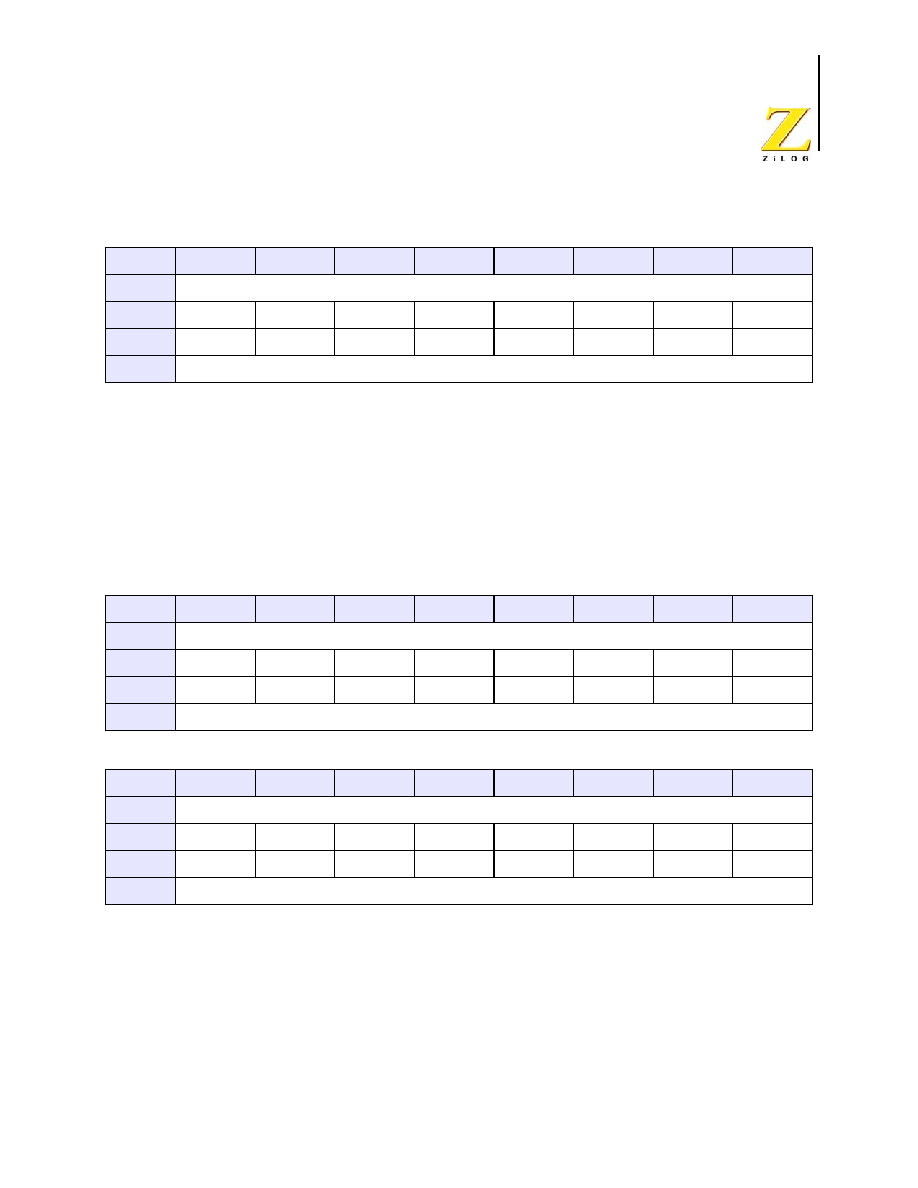
PS024302-0904
P R E L I M I N A R Y UART
Z8 Encore!
Æ
4K Series
Product Specification
101
COMP_ADDR--Compare Address
This 8-bit value is compared to incoming address bytes.
UART Baud Rate High and Low Byte Registers
The UART Baud Rate High and Low Byte registers (Tables 65 and 66) combine to create
a 16-bit baud rate divisor value (BRG[15:0]) that sets the data transmission rate (baud
rate) of the UART.
The UART data rate is calculated using the following equation:
For a given UART data rate, calculate the integer baud rate divisor value using the follow-
ing equation:
Table 64. UART Address Compare Register (U0ADDR)
BITS
7
6
5
4
3
2
1
0
FIELD
COMP_ADDR
RESET
0
0
0
0
0
0
0
0
R/W
R/W
R/W
R/W
R/W
R/W
R/W
R/W
R/W
ADDR
F45H
Table 65. UART Baud Rate High Byte Register (U0BRH)
BITS
7
6
5
4
3
2
1
0
FIELD
BRH
RESET
1
1
1
1
1
1
1
1
R/W
R/W
R/W
R/W
R/W
R/W
R/W
R/W
R/W
ADDR
F46H
Table 66. UART Baud Rate Low Byte Register (U0BRL)
BITS
7
6
5
4
3
2
1
0
FIELD
BRL
RESET
1
1
1
1
1
1
1
1
R/W
R/W
R/W
R/W
R/W
R/W
R/W
R/W
R/W
ADDR
F47H
UART Baud Rate (bits/s)
System Clock Frequency (Hz)
16 UART Baud Rate Divisor Value
◊
----------------------------------------------------------------------------------------------
=

PS024302-0904
P R E L I M I N A R Y UART
Z8 Encore!
Æ
4K Series
Product Specification
102
The baud rate error relative to the acceptable baud rate is calculated using the following
equation:
For reliable communication, the UART baud rate error must never exceed 5 percent.
Table 67 provides information about data rate errors for 5.5296MHz system clock.
Table 67. UART Baud Rates
5.5296 MHz System Clock
Acceptable
Rate (KHz)
BRG Divisor
(Decimal)
Actual Rate
(KHz)
Error
(%)
1250.0
N/A
N/A
N/A
625.0
N/A
N/A
N/A
250.0
1
345.6
38.24
115.2
3
115.2
0.00
57.6
6
57.6
0.00
38.4
9
38.4
0.00
19.2
18
19.2
0.00
9.60
36
9.60
0.00
4.80
72
4.80
0.00
2.40
144
2.40
0.00
1.20
288
1.20
0.00
0.60
576
0.60
0.00
0.30
1152
0.30
0.00
UART Baud Rate Divisor Value (BRG)
Round
System Clock Frequency (Hz)
16 UART Data Rate (bits/s)
◊
----------------------------------------------------------------------------
=
UART Baud Rate Error (%)
100
Actual Data Rate Desired Data Rate
≠
Desired Data Rate
-------------------------------------------------------------------------------------------------
◊
=
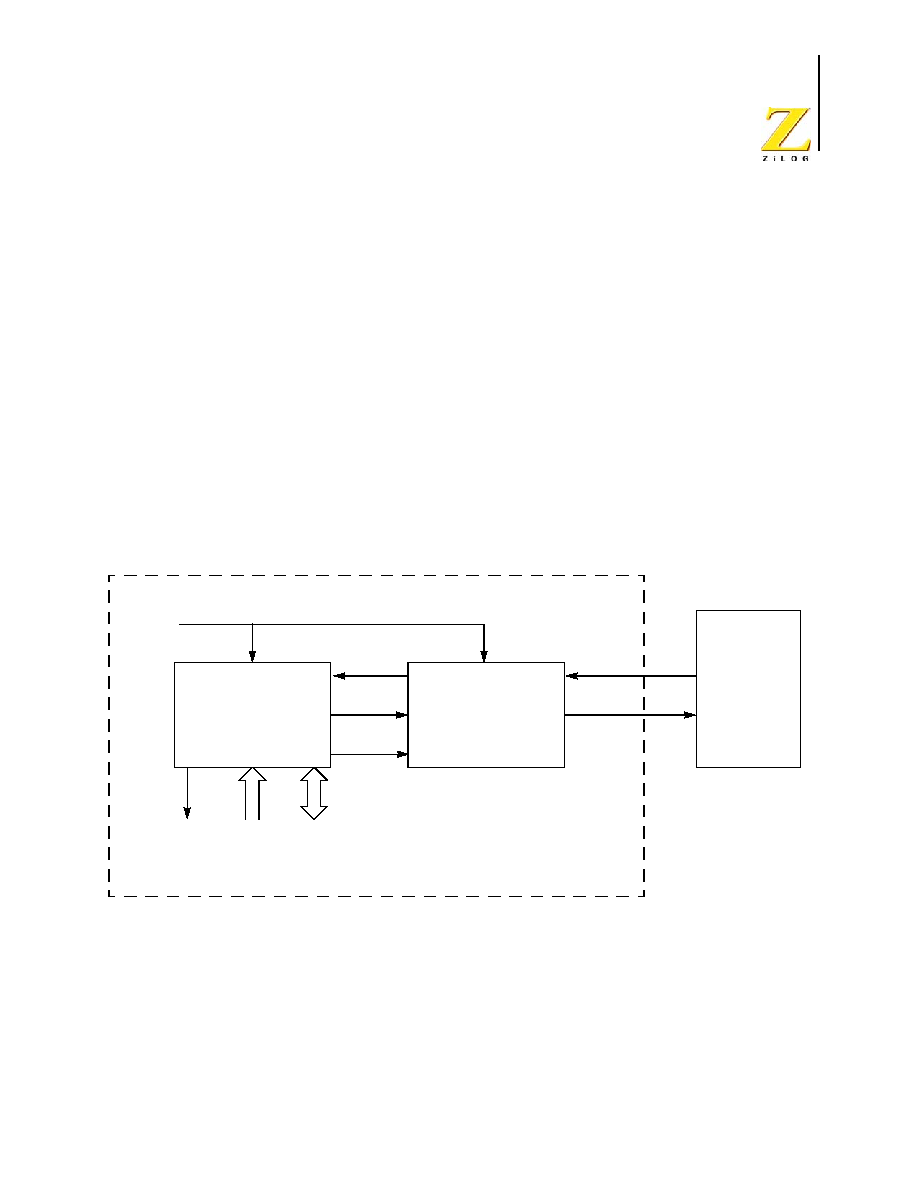
PS024302-0904
P R E L I M I N A R Y Infrared
Encoder/Decoder
Z8 Encore!
Æ
4K Series
Product Specification
103
Infrared Encoder/Decoder
Overview
The 4K Series products contain a fully-functional, high-performance UART to Infrared
Encoder/Decoder (Endec). The Infrared Endec is integrated with an on-chip UART to
allow easy communication between the Z8 Encore!
Æ
and IrDA Physical Layer Specifica-
tion, Version 1.3-compliant infrared transceivers. Infrared communication provides
secure, reliable, low-cost, point-to-point communication between PCs, PDAs, cell phones,
printers and other infrared enabled devices.
Architecture
Figure 16 illustrates the architecture of the Infrared Endec.
Figure 16.Infrared Data Communication System Block Diagram
Operation
When the Infrared Endec is enabled, the transmit data from the associated on-chip UART
is encoded as digital signals in accordance with the IrDA standard and output to the infra-
red transceiver through the TXD pin. Likewise, data received from the infrared transceiver
Interrupt
Signal
RXD
TXD
Infrared
Encoder/Decoder
UART
RxD
TxD
System
Clock
I/O
Address
Data
Infrared
Transceiver
RXD
TXD
Baud Rate
Clock
(Endec)
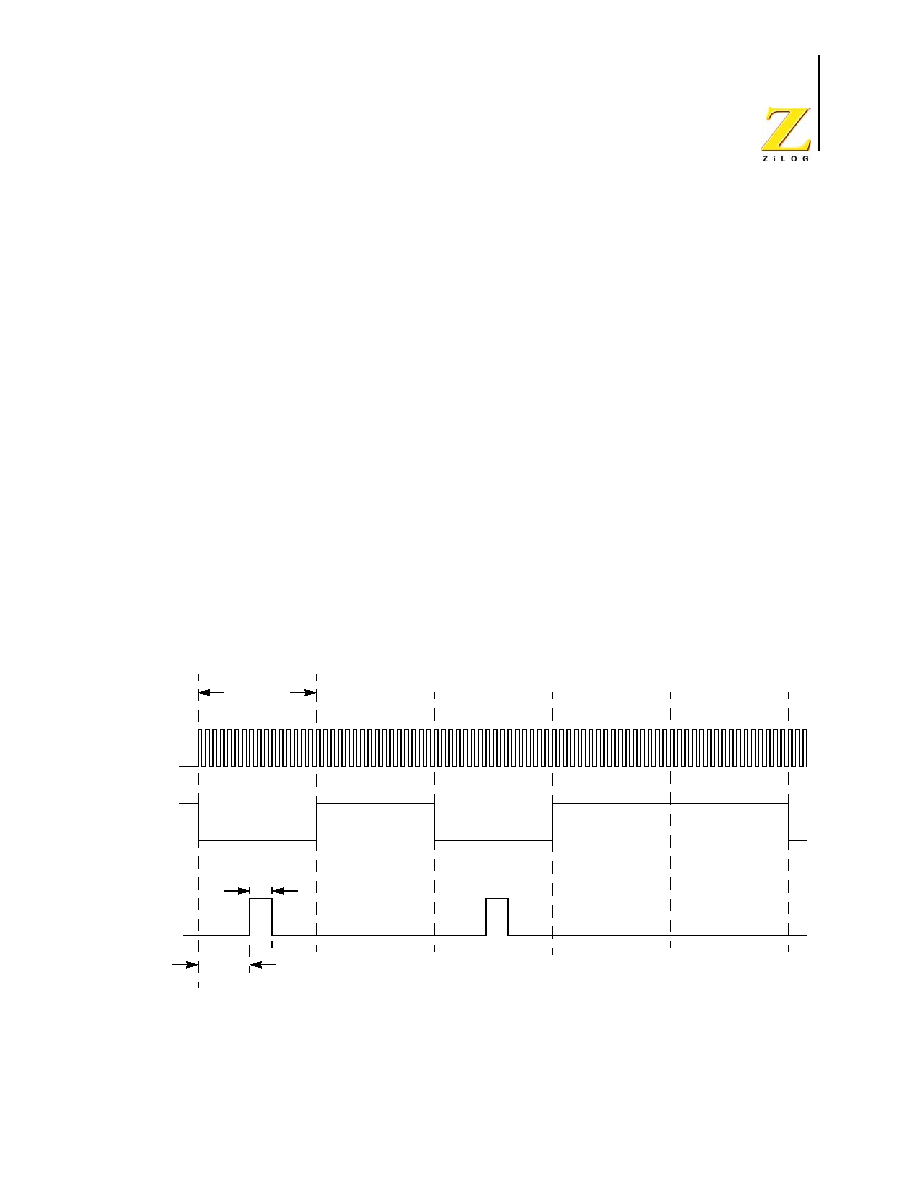
PS024302-0904
P R E L I M I N A R Y Infrared
Encoder/Decoder
Z8 Encore!
Æ
4K Series
Product Specification
104
is passed to the Infrared Endec through the RXD pin, decoded by the Infrared Endec, and
passed to the UART. Communication is half-duplex, which means simultaneous data
transmission and reception is not allowed.
The baud rate is set by the UART's Baud Rate Generator and supports IrDA standard baud
rates from 9600 baud to 115.2 Kbaud. Higher baud rates are possible, but do not meet
IrDA specifications. The UART must be enabled to use the Infrared Endec. The Infrared
Endec data rate is calculated using the following equation:
:
Transmitting IrDA Data
The data to be transmitted using the infrared transceiver is first sent to the UART. The
UART's transmit signal (TXD) and baud rate clock are used by the IrDA to generate the
modulation signal (IR_TXD) that drives the infrared transceiver. Each UART/Infrared
data bit is 16 clocks wide. If the data to be transmitted is 1, the IR_TXD signal remains
low for the full 16 clock period. If the data to be transmitted is 0, the transmitter first out-
puts a 7 clock low period, followed by a 3 clock high pulse. Finally, a 6 clock low pulse is
output to complete the full 16 clock data period. Figure 17 illustrates IrDA data transmis-
sion. When the Infrared Endec is enabled, the UART's TXD signal is internal to the 4K
Series products while the IR_TXD signal is output through the TXD pin.
Figure 17.Infrared Data Transmission
Infrared
Data Rate (bits/s)
System Clock Frequency (Hz)
16 UART Baud Rate Divisor Value
◊
----------------------------------------------------------------------------------------------
=
Baud Rate
IR_TXD
UART's
16 clock
period
Start Bit = 0
Data Bit 0 = 1
Data Bit 1 = 0
Data Bit 2 = 1
Data Bit 3 = 1
7-clock
delay
3 clock
pulse
TXD
Clock
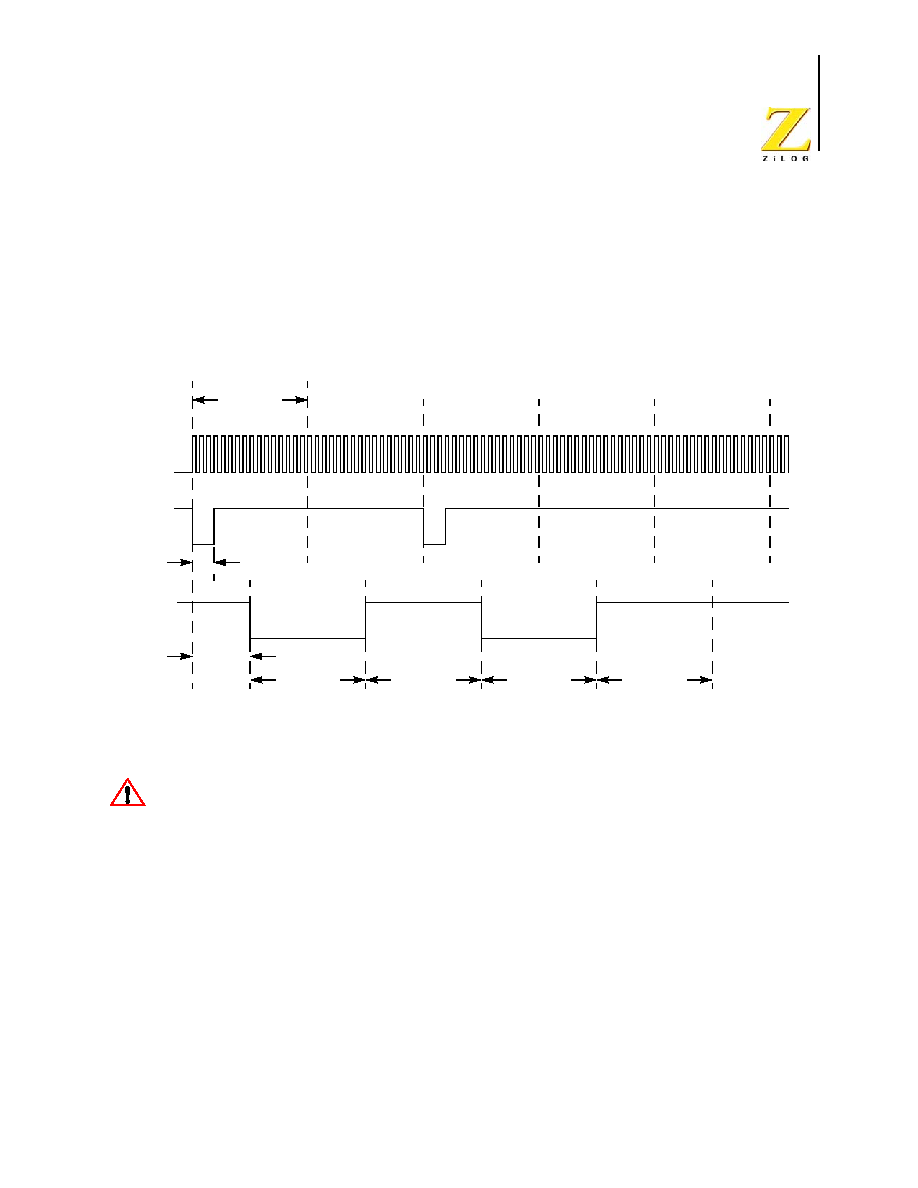
PS024302-0904
P R E L I M I N A R Y Infrared
Encoder/Decoder
Z8 Encore!
Æ
4K Series
Product Specification
105
Receiving IrDA Data
Data received from the infrared transceiver using the IR_RXD signal through the RXD pin
is decoded by the Infrared Endec and passed to the UART. The UART's baud rate clock is
used by the Infrared Endec to generate the demodulated signal (RXD) that drives the
UART. Each UART/Infrared data bit is 16-clocks wide. Figure 18 illustrates data recep-
tion. When the Infrared Endec is enabled, the UART's RXD signal is internal to the 4K
Series products while the IR_RXD signal is received through the RXD pin.
Figure 18.IrDA Data Reception
Infrared Data Reception
The system clock frequency must be at least 1.0MHz to ensure proper reception of the
1.4
µs minimum width pulses allowed by the IrDA standard.
Endec Receiver Synchronization
The IrDA receiver uses a local baud rate clock counter (0 to 15 clock periods) to generate
an input stream for the UART and to create a sampling window for detection of incoming
pulses. The generated UART input (UART RXD) is delayed by 8 baud rate clock periods
with respect to the incoming IrDA data stream. When a falling edge in the input data
stream is detected, the Endec counter is reset. When the count reaches a value of 8, the
UART RXD value is updated to reflect the value of the decoded data. When the count
reaches 12 baud clock periods, the sampling window for the next incoming pulse opens.
The window remains open until the count again reaches 8 (in other words, 24 baud clock
periods since the previous pulse was detected), giving the Endec a sampling window of
minus four baud rate clocks to plus eight baud rate clocks around the expected time of an
Baud Rate
UART's
IR_RXD
16 clock
period
Start Bit = 0
Data Bit 0 = 1
Data Bit 1 = 0
Data Bit 2 = 1
Data Bit 3 = 1
8 clock
delay
Clock
RXD
16 clock
period
16 clock
period
16 clock
period
16 clock
period
Start Bit = 0
Data Bit 0 = 1
Data Bit 1 = 0
Data Bit 2 = 1
Data Bit 3 = 1
min. 1.4
µ
s
pulse
Caution:

PS024302-0904
P R E L I M I N A R Y Infrared
Encoder/Decoder
Z8 Encore!
Æ
4K Series
Product Specification
106
incoming pulse. If an incoming pulse is detected inside this window this process is
repeated. If the incoming data is a logical 1 (no pulse), the Endec returns to the initial state
and waits for the next falling edge. As each falling edge is detected, the Endec clock
counter is reset, resynchronizing the Endec to the incoming signal, allowing the Endec to
tolerate jitter and baud rate errors in the incoming datastream. Resynchronizing the Endec
does not alter the operation of the UART, which ultimately receives the data. The UART is
only synchronized to the incoming data stream when a Start bit is received.
Infrared Encoder/Decoder Control Register Definitions
All Infrared Endec configuration and status information is set by the UART control regis-
ters as defined beginning on page 84.
To prevent spurious signals during IrDA data transmission, set the IREN bit in the
UART Control 1 register to 1 to enable the Infrared Encoder/Decoder before enabling
the GPIO Port alternate function for the corresponding pin.
Caution:

PS024302-0904
P R E L I M I N A R Y Analog-to-Digital
Converter
Z8 Encore!
Æ
4K Series
Product Specification
107
Analog-to-Digital Converter
Overview
The Analog-to-Digital Converter (ADC) converts an analog input signal to its digital rep-
resentation. The features of this sigma-delta ADC include:
∑
10-bit resolution
∑
8 single-ended analog input sources are multiplexed with general-purpose I/O ports
∑
Interrupt upon conversion complete
∑
Internal voltage reference generator with three selectable levels
Architecture
Figure 19 illustrates the major functional blocks of the ADC. An analog multiplexer net-
work selects the ADC input from the available analog pins, ANA0 through ANA7. The
ADC requires an input reference voltage for the conversion. The voltage reference for the
conversion can be input through the external VREF pin or generated internally by the volt-
age reference generator.
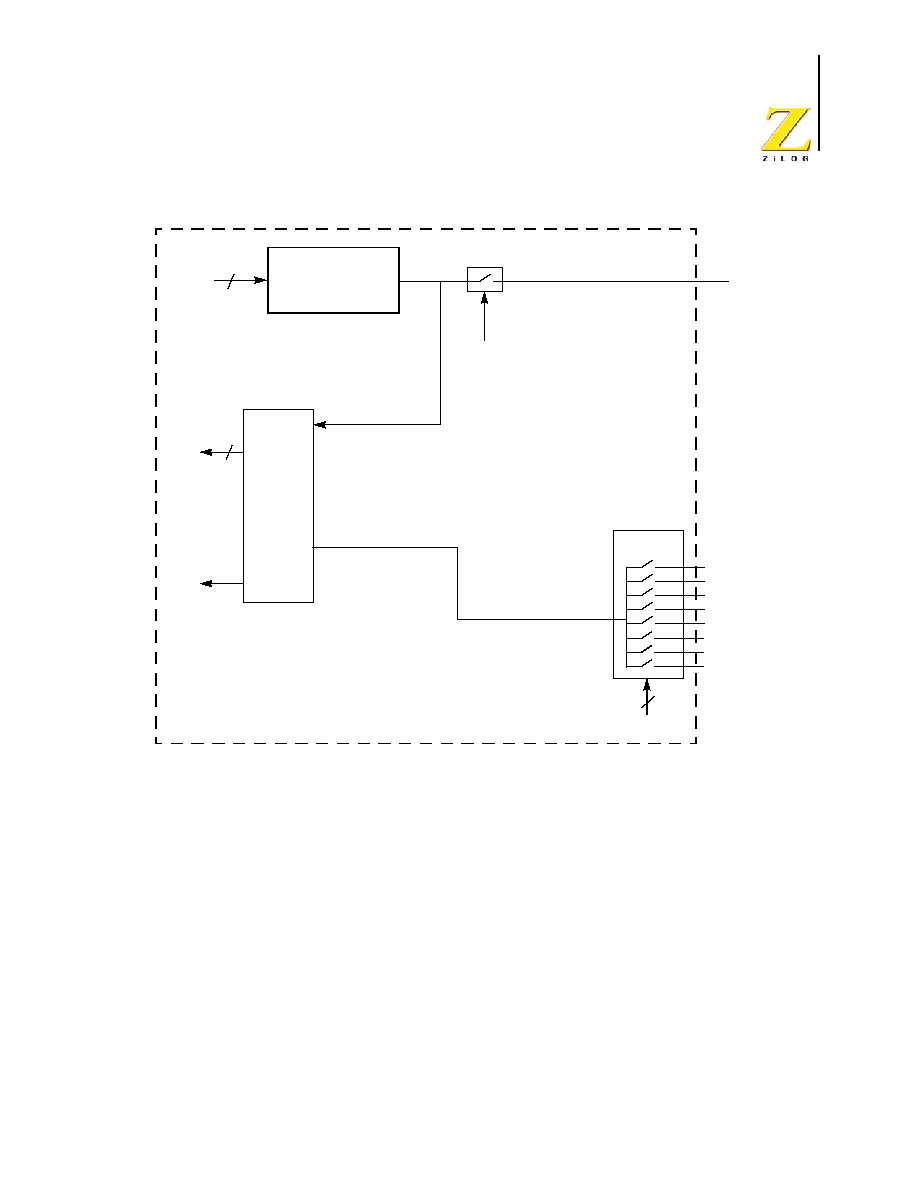
PS024302-0904
P R E L I M I N A R Y Analog-to-Digital
Converter
Z8 Encore!
Æ
4K Series
Product Specification
108
Figure 19.Analog-to-Digital Converter Block Diagram
Operation
Data Format
The output of the ADC is an 11- bit, signed, two's complement digital value. The output
generally ranges from 0 to +1023, but offset errors can cause small negative values.
The ADC registers return 13 bits of data, but the two LSBs are intended for compensation
use only. When the compensation routine is performed on the 13 bit raw ADC value, two
bits of resolution are lost because of a rounding error. As a result, the final value is an 11-
bit number.
Analog Input
Multiplexer
Internal Voltage
Reference Generator
Ref
ADC
IRQ
ADC
Data
Vrefsel
2
11
ANA7
ANA6
ANA5
ANA4
ANA3
ANA2
ANA1
ANA0
VREFEXT
Analog
Input
Input
ANAIN
4
Vref

PS024302-0904
P R E L I M I N A R Y Analog-to-Digital
Converter
Z8 Encore!
Æ
4K Series
Product Specification
109
Automatic Powerdown
If the ADC is idle (no conversions in progress) for 160 consecutive system clock cycles,
portions of the ADC are automatically powered down. From this powerdown state, the
ADC requires 40 system clock cycles to powerup. The ADC powers up when a conversion
is requested by the ADC Control register.
Single-Shot Conversion
When configured for single-shot conversion, the ADC performs a single analog-to-digital
conversion on the selected analog input channel. After completion of the conversion, the
ADC shuts down. The steps for setting up the ADC and initiating a single-shot conversion
are as follows:
1. Enable the acceptable analog inputs by configuring the general-purpose I/O pins for
alternate function. This configuration disables the digital input and output drivers.
2. Write the
ADC Control/Status Register 1
to configure the ADC
≠
Write the
REFSELH
bit of the pair {
REFSELH
,
REFSELL
} to select the internal
voltage reference level or to disable the internal reference. The
REFSELL
bit is
contained in the
ADC Control Register 0
.
3. Write to the
ADC Control Register 0
to configure the ADC and begin the
conversion. The bit fields in the ADC Control register can be written simultaneously:
≠
Write to the ANAIN[3:0] field to select from the available analog input sources
(different input pins available depending on the device)
≠
Clear CONT to 0 to select a single-shot conversion.
≠
If the internal voltage reference must be output to a pin, set the
REFEXT
bit to 1.
The internal voltage reference must be enabled in this case.
≠
Write the
REFSELL
bit of the pair {
REFSELH
,
REFSELL
} to select the internal
voltage reference level or to disable the internal reference. The
REFSELH
bit is
contained in the
ADC Control/Status Register 1
.
≠
Set CEN to 1 to start the conversion.
4. CEN remains 1 while the conversion is in progress. A single-shot conversion requires
5129 system clock cycles to complete. If a single-shot conversion is requested from an
ADC powered-down state, the ADC uses 40 additional clock cycles to power-up
before beginning the 5129 cycle conversion.
5. When the conversion is complete, the ADC control logic performs the following
operations:
≠
11-bit two's-complement result written to {ADCD_H[7:0], ADCD_L[7:5]}.
≠
CEN
resets to 0 to indicate the conversion is complete.
≠
An interrupt request is sent to the Interrupt Controller denoting conversion
complete.

PS024302-0904
P R E L I M I N A R Y Analog-to-Digital
Converter
Z8 Encore!
Æ
4K Series
Product Specification
110
6. If the ADC remains idle for 160 consecutive system clock cycles, it is automatically
powered-down.
Continuous Conversion
When configured for continuous conversion, the ADC continuously performs an analog-
to-digital conversion on the selected analog input. Each new data value over-writes the
previous value stored in the ADC Data registers. An interrupt is generated after each con-
version.
In CONTINUOUS mode, ADC updates are limited by the input signal bandwidth of the
ADC and the latency of the ADC and its digital filter. Step changes at the input are not
detected at the next output from the ADC. The response of the ADC (in all modes) is
limited by the input signal bandwidth and the latency.
Follow these steps for setting up the ADC and initiating continuous conversion:
1. Enable the acceptable analog input by configuring the general-purpose I/O pins for
alternate function. This action disables the digital input and output driver.
2. Write the
ADC Control/Status Register 1
to configure the ADC
≠
Write the
REFSELH
bit of the pair {
REFSELH
,
REFSELL
} to select the internal
voltage reference level or to disable the internal reference. The
REFSELL
bit is
contained in the
ADC Control Register 0
.
3. Write to the
ADC Control Register 0
to configure the ADC for continuous
conversion. The bit fields in the ADC Control register may be written simultaneously:
≠
Write to the ANAIN[3:0] field to select from the available analog input sources
(different input pins available depending on the device)
≠
Set CONT to 1 to select continuous conversion.
≠
If the internal VREF must be output to a pin, set the
REFEXT
bit to 1. The internal
voltage reference must be enabled in this case.
≠
Write the
REFSELL
bit of the pair {
REFSELH,
REFSELL
} to select the internal
voltage reference level or to disable the internal reference. The
REFSELH
bit is
contained in
ADC Control/Status Register 1
.
≠
Set CEN to 1 to start the conversions.
4. When the first conversion in continuous operation is complete (after 5129 system
clock cycles, plus the 40 cycles for power-up, if necessary), the ADC control logic
performs the following operations:
≠
CEN
resets to 0 to indicate the first conversion is complete. CEN remains 0 for all
subsequent conversions in continuous operation.
≠
An interrupt request is sent to the Interrupt Controller to indicate the conversion is
complete.
Caution:
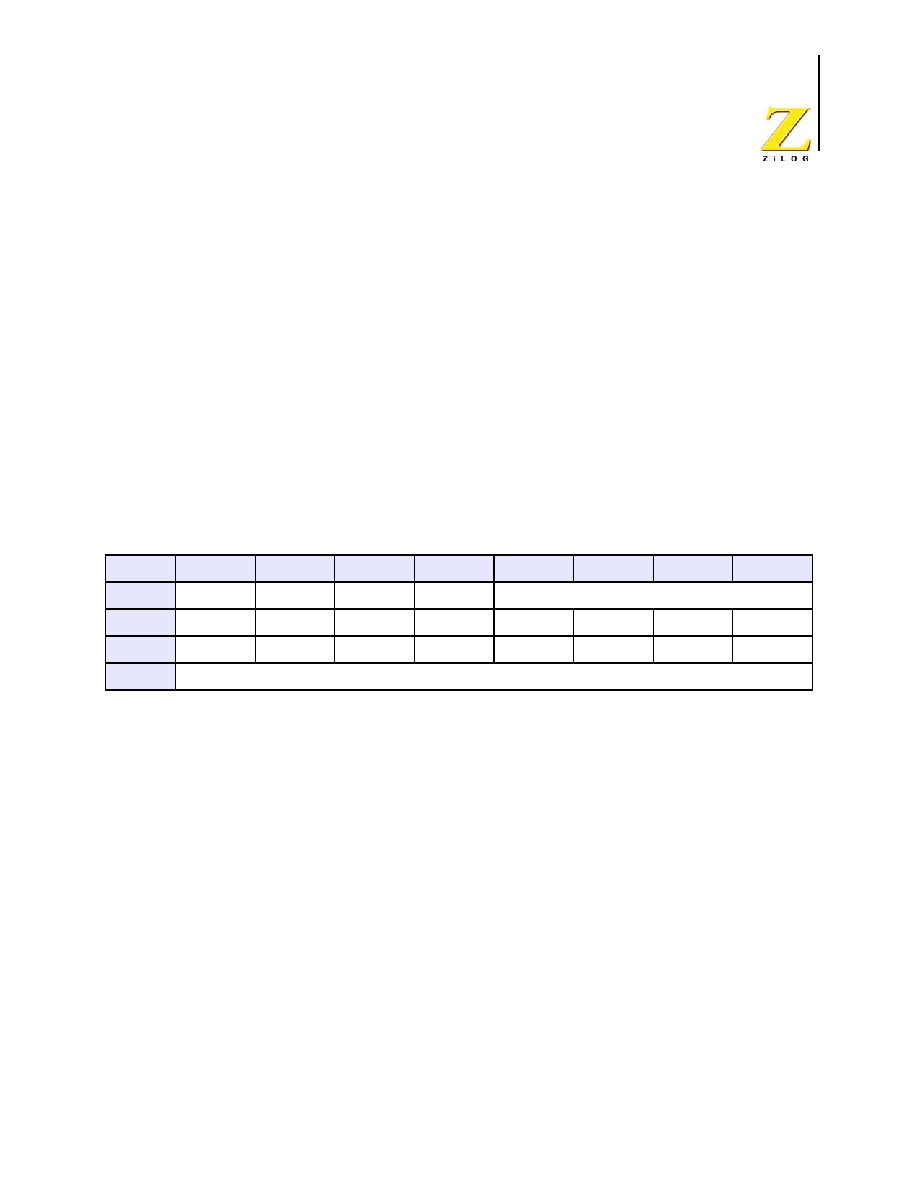
PS024302-0904
P R E L I M I N A R Y Analog-to-Digital
Converter
Z8 Encore!
Æ
4K Series
Product Specification
111
5. The ADC writes a new data result every 256 system clock cycles. For each completed
conversion, the ADC control logic performs the following operations:
≠
Writes the 11-bit two's complement result to {ADCD_H[7:0], ADCD_L[7:5]}.
≠
An interrupt request to the Interrupt Controller denoting conversion complete.
6. To disable continuous conversion, clear the CONT bit in the ADC Control Register
to 0.
ADC Control Register Definitions
ADC Control Register 0
The ADC Control register selects the analog input channel and initiates the analog-to-dig-
ital conversion.
CEN--Conversion Enable
0 = Conversion is complete. Writing a 0 produces no effect. The ADC automatically clears
this bit to 0 when a conversion is complete.
1 = Begin conversion. Writing a 1 to this bit starts a conversion. If a conversion is already
in progress, the conversion restarts. This bit remains 1 until the conversion is complete.
REFSELL--Voltage Reference Level Select Low Bit; in conjunction with the High bit
(REFSELH) in
ADC Control/Status Register 1
, this determines the level of the internal
voltage reference; the following details the effects of {REFSELH, REFSELL}; note that
this reference is independent of the Comparator reference
00= Internal Reference Disabled, reference comes from external pin
01= Internal Reference set to 1.0 V
10= Internal Reference set to 2.0 V (default)
11= Internal Reference set to 2.2 V
REFEXT
-
External Reference Select
0 = External reference buffer is disabled; Vref pin is available for GPIO functions
1 = The internal ADC reference is buffered and connected to the Vref pin
CONT
0 = Single-shot conversion. ADC data is output once at completion of the 5129 system
Table 68. ADC Control Register 0 (ADCCTL0)
BITS
7
6
5
4
3
2
1
0
FIELD
CEN
REFSELL
REFEXT
CONT
ANAIN[3:0]
RESET
0
0
0
0
0
0
0
0
R/W
R/W
R/W
R/W
R/W
R/W
R/W
R/W
R/W
ADDR
F70H

PS024302-0904
P R E L I M I N A R Y Analog-to-Digital
Converter
Z8 Encore!
Æ
4K Series
Product Specification
112
clock cycles
1 = Continuous conversion. ADC data updated every 256 system clock cycles
ANAIN[3:0]--Analog Input Select
These bits select the analog input for conversion. Not all Port pins in this list are available
in all packages for the 4K Series. Refer to the chapter
"Pin Description" on page 7
for
information regarding the Port pins available with each package style. Do not enable
unavailable analog inputs. Usage of these bits changes depending on the buffer mode
selected in
ADC Control/Status Register 1
.
For the reserved values, all input switches are disabled to avoid leakage or other undesir-
able operation. ADC samples taken with reserved bit settings are undefined.
Single-Ended:
0000 = ANA0
0001 = ANA1
0010 = ANA2
0011 = ANA3
0100 = ANA4
0101 = ANA5
0110 = ANA6
0111 = ANA7
1000 = Reserved
1001 = Reserved
1010 = Reserved
1011 = Reserved
1100 = Reserved.
1101 = Reserved
1110 = Reserved
1111 = Reserved
ADC Control/Status Register 1
The second ADC Control register configures the input buffer stage, enables the threshold
interrupts and contains the status of both threshold triggers.
Table 69. ADC Control/Status Register 1 (ADCCTL1)
BITS
7
6
5
4
3
2
1
0
FIELD
REFSELH
Reserved
RESET
1
0
0
0
0
0
0
0
R/W
R/W
R/W
R/W
R/W
R/W
R/W
R/W
R/W
ADDR
F71H
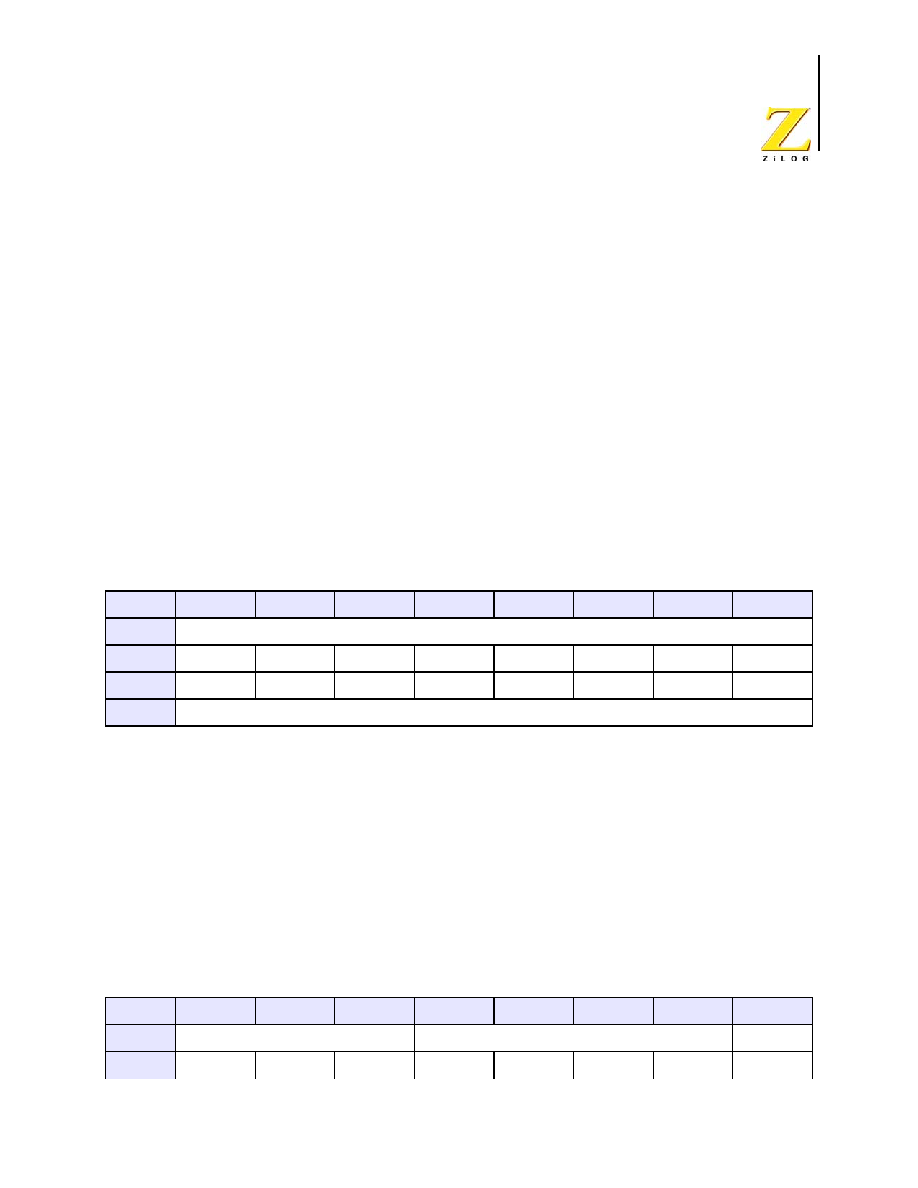
PS024302-0904
P R E L I M I N A R Y Analog-to-Digital
Converter
Z8 Encore!
Æ
4K Series
Product Specification
113
REFSELH--Voltage Reference Level Select High Bit; in conjunction with the Low bit
(REFSELL) in
ADC Control Register 0
, this determines the level of the internal voltage
reference; the following details the effects of {REFSELH, REFSELL}; this reference is
independent of the Comparator reference
00= Internal Reference Disabled, reference comes from external pin
01= Internal Reference set to 1.0 V
10= Internal Reference set to 2.0 V (default)
11= Internal Reference set to 2.2 V
Reserved--Must be 0
ADC Data High Byte Register
The ADC Data High Byte register contains the upper eight bits of the ADC output. The
output is an 11-bit two's complement value. During a single-shot conversion, this value is
invalid. Access to the ADC Data High Byte register is read-only. Reading the ADC Data
High Byte register latches data in the ADC Low Bits register.
ADCDH--ADC Data High Byte
This byte contains the upper eight bits of the ADC output. These bits are not valid during a
single-shot conversion. During a continuous conversion, the most recent conversion out-
put is held in this register. These bits are undefined after a Reset.
ADC Data Low Bits Register
The ADC Data Low Byte register contains the lower bits of the ADC output as well as an
overflow status bit. The output is a 11-bit two's complement value. During a single-shot
conversion, this value is invalid. Access to the ADC Data Low Byte register is read-only.
Reading the ADC Data High Byte register latches data in the ADC Low Bits register.
Table 70. ADC Data High Byte Register (ADCD_H)
BITS
7
6
5
4
3
2
1
0
FIELD
ADCDH
RESET
X
X
X
X
X
X
X
X
R/W
R
R
R
R
R
R
R
R
ADDR
F72H
Table 71. ADC Data Low Bits Register (ADCD_L)
BITS
7
6
5
4
3
2
1
0
FIELD
ADCDL
Reserved
OVF
RESET
X
X
X
X
X
X
X
X
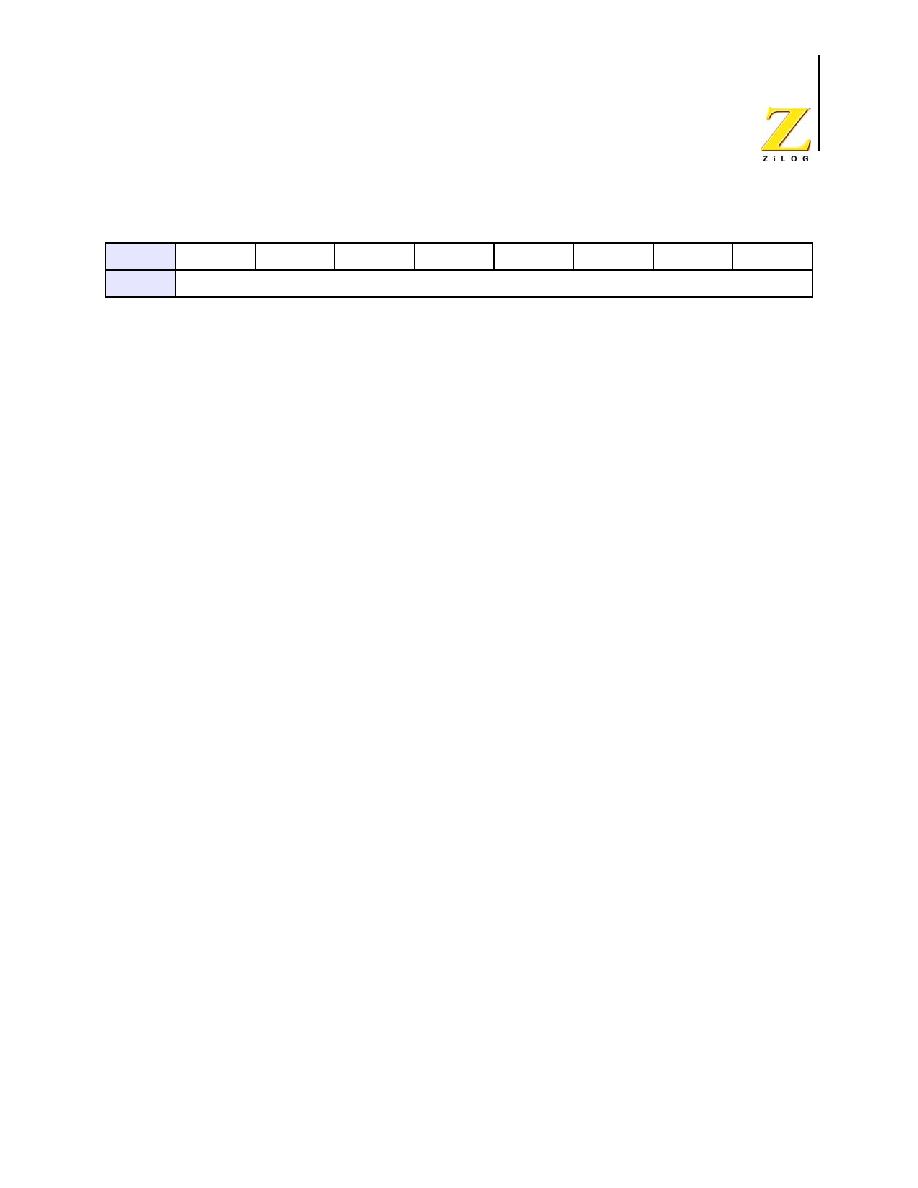
PS024302-0904
P R E L I M I N A R Y Analog-to-Digital
Converter
Z8 Encore!
Æ
4K Series
Product Specification
114
ADCDL--ADC Data Low Bits
These bits are the least significant three bits of the 11-bits of the differential ADC output.
In single-ended mode, they are the least significant two bits of the 10-bit output. These bits
are undefined after a Reset.
Reserved--Must be undefined.
OVF--Overflow Status
0= An overflow did not occur in the digital filter for the current sample.
1= An overflow did occur in the digital filter for the current sample.
R/W
R
R
R
R
R
R
R
R
ADDR
F73H
Table 71. ADC Data Low Bits Register (ADCD_L)

PS024302-0904
P R E L I M I N A R Y Flash
Memory
Z8 Encore!
Æ
4K Series
Product Specification
115
Flash Memory
Overview
The products in the PartName features either 4KB (4096) or 2KB (2048 bytes) or 1KB
(1024) of non-volatile Flash memory with read/write/erase capability. The Flash Memory
can be programmed and erased in-circuit by either user code or through the On-Chip
Debugger.
The Flash memory array is arranged in pages with 512 bytes per page. The 512-byte page
is the minimum Flash block size that can be erased. Each page is divided into 8 rows of 64
bytes.
For program/data protection, the Flash memory is also divided into sectors. In the Part-
Name, these sectors are 512 bytes in size; each sector maps to a page. Page and sector
sizes are not equal for other members of the Z8 Encore!
Æ
family.
The first 2 bytes of the Flash Program memory are used as Flash Option Bits. Refer to the
chapter "Flash Option Bits" on page 126 for more information about their operation.
Table 72 describes the Flash memory configuration for each device in the PartName.
Figure 20 illustrates the Flash memory arrangement.
Table 72. 4K Series Flash Memory Configurations
Part Number
Flash Size
KB (Bytes)
Flash
Pages
Program Memory
Addresses
Flash Sector
Size (bytes)
Z8F04xA
4 (4096)
8
0000H≠0FFFH
512
Z8F02xA
2 (2048)
4
0000H≠07FFH
512
Z8F01xA
1 (1024)
2
0000H≠03FFH
512
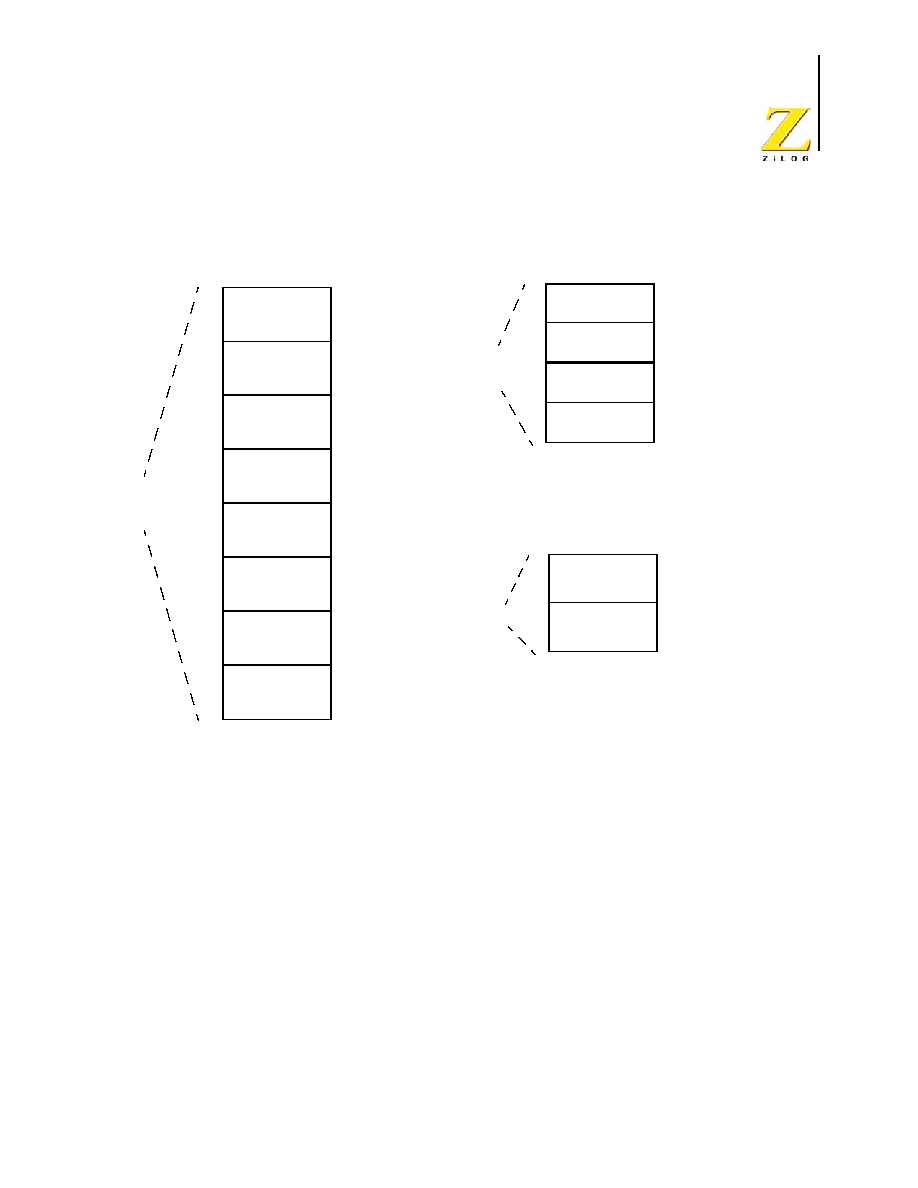
PS024302-0904
P R E L I M I N A R Y Flash
Memory
Z8 Encore!
Æ
4K Series
Product Specification
116
Figure 20.Flash Memory Arrangement
Flash Information Area
The Flash information area is separate from program memory and is mapped to the
address range
FE00H
to
FFFFH
. Not all of these addresses are user accessible. Factory trim
values for the Temperature Sensor and Internal Precision Oscillator are stored here. Fac-
tory calibration data for the ADC is also stored here.
4KB Flash
Program Memory
0000
8 Pages/Sectors
512 Bytes each
01FF
0200
0FFF
Addresses (hex)
03FF
0400
05FF
0600
07FF
0800
09FF
0A00
0BFF
0C00
0DFF
0E00
2KB Flash
Program Memory
0000
4 Pages/Sectors
Addresses (hex)
07FF
05FF
0600
03FF
0400
01FF
0200
1KB Flash
Program Memory
0000
Addresses (hex)
03FF
01FF
0200
2 Pages/Sectors
Sector 7
Sector 6
Sector 5
Sector 4
Sector 3
Sector 2
Sector 1
Sector 0
Sector 0
Sector 1
Sector 0
Sector 1
Sector 2
Sector 3

PS024302-0904
P R E L I M I N A R Y Flash
Memory
Z8 Encore!
Æ
4K Series
Product Specification
117
Operation
The Flash Controller programs and erases Flash memory. The Flash Controller provides
the proper Flash controls and timing for byte programming, Page Erase, and Mass Erase of
Flash memory.
The Flash Controller contains several protection mechanisms to prevent accidental pro-
gramming or erasure. These mechanism operate on the page, sector and full-memory lev-
els.
The Flow Chart in Figure 21 illustrates basic Flash Controller operation. The following
subsections provide details about the various operations (Lock, Unlock, Byte Program-
ming, Page Protect, Page Unprotect, Page Select Page Erase, and Mass Erase) listed in
Figure 21.
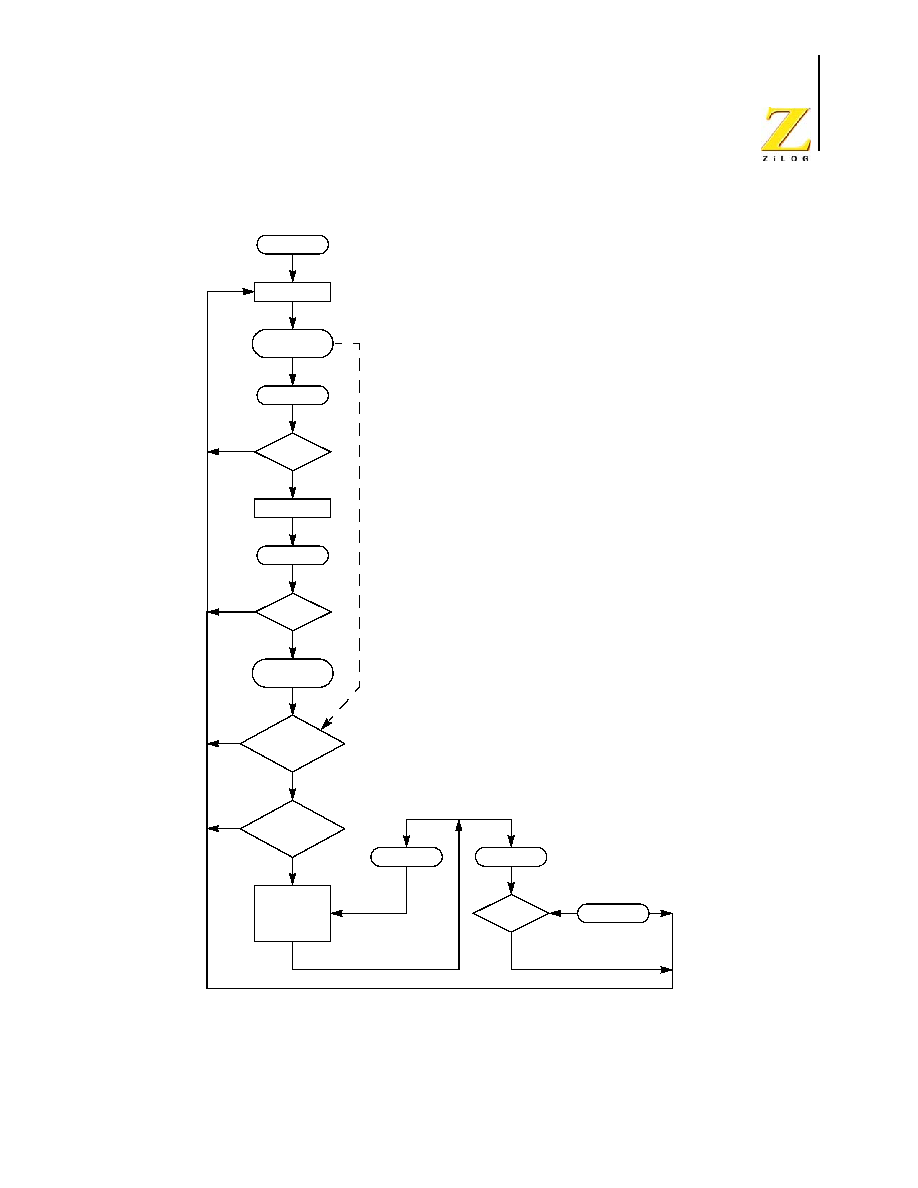
PS024302-0904
P R E L I M I N A R Y Flash
Memory
Z8 Encore!
Æ
4K Series
Product Specification
118
Figure 21.Flash Controller Operation Flow Chart
Reset
Page
73H
No
Yes
8CH
No
Yes
Program/Erase
Enabled
95H
No
Yes
Write FCTL
Lock State 0
Lock State 1
Write FCTL
Write FCTL
Byte Program
Page Erase
Write Page
Select Register
Write Page
Select Register
Page in
No
No
Unlocked
Protected Sector?
Writes to Page Select
Register in Lock State 1
result in a return to
Lock State 0
Page Select
Yes
values match?
Yes

PS024302-0904
P R E L I M I N A R Y Flash
Memory
Z8 Encore!
Æ
4K Series
Product Specification
119
Flash Operation Timing Using the Flash Frequency Registers
Before performing either a program or erase operation on Flash memory, the user must
first configure the Flash Frequency High and Low Byte registers. The Flash Frequency
registers allow programming and erasing of the Flash with system clock frequencies rang-
ing from 32KHz (32768Hz) through 5.53MHz.
The Flash Frequency High and Low Byte registers combine to form a 16-bit value,
FFREQ
, to control timing for Flash program and erase operations. The 16-bit binary Flash
Frequency value must contain the system clock frequency (in KHz). This value is calcu-
lated using the following equation:
.
Flash programming and erasure are not supported for system clock frequencies below
32KHz (32768Hz) or above 5.53MHz. The Flash Frequency High and Low Byte regis-
ters must be loaded with the correct value to ensure operation of the 4K Series devices.
Flash Code Protection Against External Access
The user code contained within the Flash memory can be protected against external access
with the On-Chip Debugger. Programming the FRP Flash Option Bit prevents reading of
the user code with the On-Chip Debugger. Refer to the chapter
"Flash Option Bits" on
page 126
and the chapter
"On-Chip Debugger" on page 131
for more information.
Flash Code Protection Against Accidental Program and Erasure
The 4K Series provides several levels of protection against accidental program and erasure
of the Flash memory contents. This protection is provided by a combination of the Flash
Option bits, the register locking mechanism, the page select redundancy and the sector
level protection control of the Flash Controller.
Flash Code Protection Using the Flash Option Bits
The FHSWP and FWP Flash Option Bits combine to provide three levels of Flash Program
Memory protection as listed in Table 73. Refer to the chapter
"Flash Option Bits" on page 126
for more information.
FFREQ[15:0]
System Clock Frequency (Hz)
1000
----------------------------------------------------------------------------
=
Caution:

PS024302-0904
P R E L I M I N A R Y Flash
Memory
Z8 Encore!
Æ
4K Series
Product Specification
120
.
Flash Code Protection Using the Flash Controller
At Reset, the Flash Controller locks to prevent accidental program or erasure of the Flash
memory. To program or erase the Flash memory, first write the Page Select Register with
the target page. Unlock the Flash Controller by making two consecutive writes to the
Flash Control register with the values
73H
and
8CH
, sequentially. The Page Select Register
must be rewritten with the same page previously stored there. If the two Page Select writes
do not match, the controller reverts to a locked state. If the two writes match, the selected
page becomes active. See Figure 21 for details.
After unlocking a specific page, the user can enable either Page Program or Erase. Writing
the value
95H
causes a Page Erase only if the active page resides in a sector that is not pro-
tected. Any other value written to the Flash Control register locks the Flash Controller.
Mass Erase is not allowed in the user code but only in through the Debug Port.
After unlocking a specific page, the user can also write to any byte on that page. After a
byte is written, the page remains unlocked, allowing for subsequent writes to other bytes
on the same page. Further writes to the Flash Control Register cause the active page to
revert to a locked state.
Sector Based Flash Protection
The final protection mechanism is implemented on a per-sector basis. The Flash memories
of Z8 Encore!
Æ
devices are divided into maximum number of 8 sectors. A sector is 1/8 of
the total size of the Flash memory, unless this value is smaller than the page size, in which
case the sector and page sizes are equal. On the 4K Series devices, the sector size is 512
bytes, equal to the page size.
The Sector Protect Register controls the protection state of each Flash sector. This register
is shared with the Page Select Register. It is accessed by unlocking the Flash controller
and writing the command byte
5EH
. The next write to the Page Select Register targets the
Sector Protect Register.
The Sector Protect Register is initialized to 0 on reset, putting each sector into an unpro-
tected state. When a bit in the Sector Protect Register is written to 1, the corresponding
Table 73. Flash Code Protection Using the Flash Option Bits
FHSWP
FWP
Flash Code Protection Description
0
0
Programming and erasing disabled for all of Flash Program
Memory. In user code programming, Page Erase, and Mass Erase
are all disabled. Mass Erase is available through the On-Chip
Debugger.
0 or 1
1
Programming, Page Erase, and Mass Erase are enabled for all of
Flash Program Memory.

PS024302-0904
P R E L I M I N A R Y Flash
Memory
Z8 Encore!
Æ
4K Series
Product Specification
121
sector can no longer be written or erased. After a bit of the Sector Protect Register has
been set, it can not be cleared except by powering down the device.
Byte Programming
The Flash Memory is enabled for byte programming after unlocking the Flash Controller
and successfully enabling either Mass Erase or Page Erase. When the Flash Controller is
unlocked and Mass Erase is successfully enabled, all Program Memory locations are
available for byte programming. In contrast, when the Flash Controller is unlocked and
Page Erase is successfully enabled, only the locations of the selected page are available for
byte programming. An erased Flash byte contains all 1's (
FF
H
). The programming opera-
tion can only be used to change bits from 1 to 0. To change a Flash bit (or multiple bits)
from 0 to 1 requires execution of either the Page Erase or Mass Erase commands.
Byte Programming can be accomplished using the On-Chip Debugger's Write Memory
command or eZ8 CPU execution of the LDC or LDCI instructions. Refer to the eZ8 CPU
User Manual (available for download at
www.zilog.com
)for a description of the LDC and
LDCI instructions. While the Flash Controller programs the Flash memory, the eZ8 CPU
idles but the system clock and on-chip peripherals continue to operate. To exit program-
ming mode and lock the Flash, write any value to the Flash Control register, except the
Mass Erase or Page Erase commands.
The byte at each address of the Flash memory cannot be programmed (any bits written
to 0) more than twice before an erase cycle occurs.
Page Erase
The Flash memory can be erased one page (512 bytes) at a time. Page Erasing the Flash
memory sets all bytes in that page to the value
FFH
. The Flash Page Select register identi-
fies the page to be erased. Only a page residing in an unprotected sector can be erased.
With the Flash Controller unlocked and the active page set, writing the value
95h
to the
Flash Control register initiates the Page Erase operation. While the Flash Controller exe-
cutes the Page Erase operation, the eZ8 CPU idles but the system clock and on-chip
peripherals continue to operate. The eZ8 CPU resumes operation after the Page Erase
operation completes. If the Page Erase operation is performed using the On-Chip Debug-
ger, poll the Flash Status register to determine when the Page Erase operation is complete.
When the Page Erase is complete, the Flash Controller returns to its locked state.
Mass Erase
The Flash memory can also be Mass Erased using the Flash Controller, but only by using
the On-Chip Debugger. Mass Erasing the Flash memory sets all bytes to the value
FFH
.
With the Flash Controller unlocked and the Mass Erase successfully enabled, writing the
value
63H
to the Flash Control register initiates the Mass Erase operation. While the Flash
Caution:
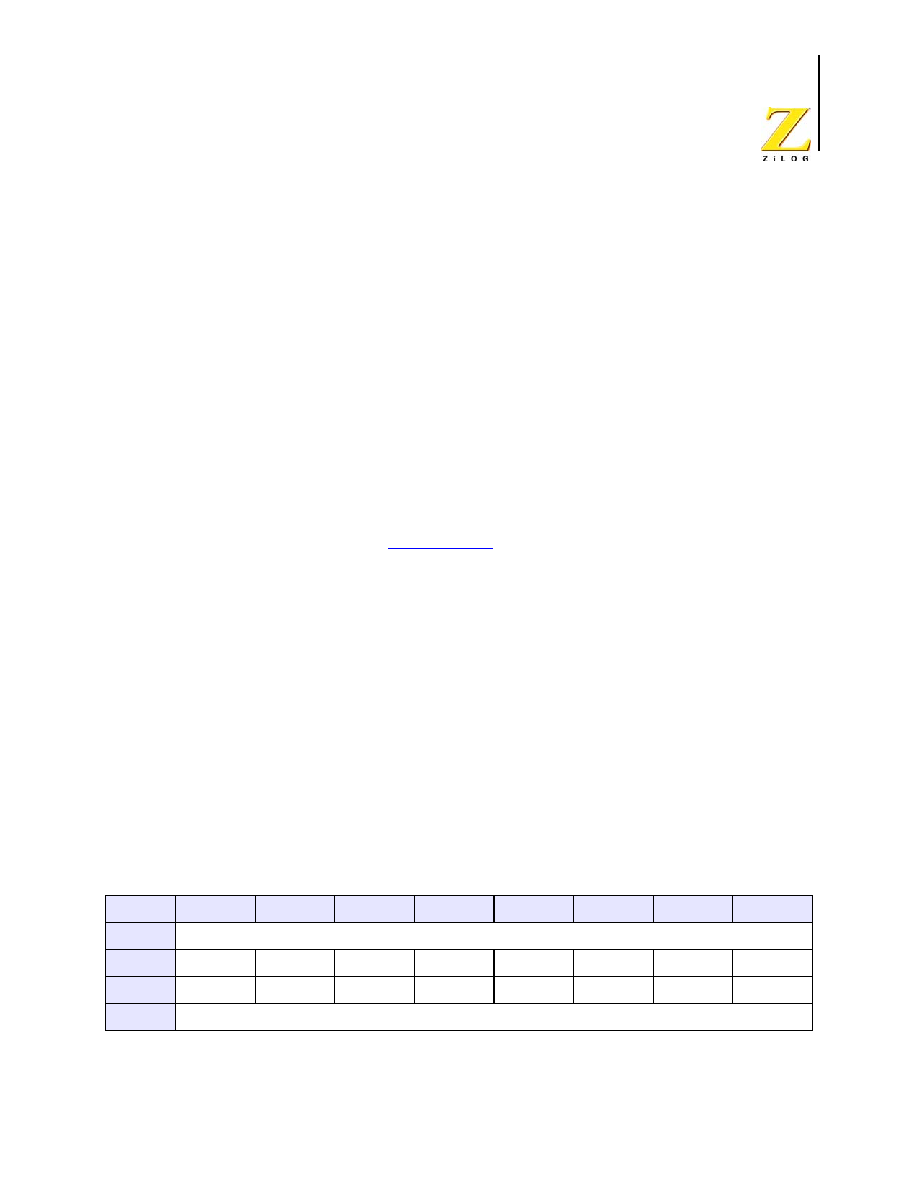
PS024302-0904
P R E L I M I N A R Y Flash
Memory
Z8 Encore!
Æ
4K Series
Product Specification
122
Controller executes the Mass Erase operation, the eZ8 CPU idles but the system clock and
on-chip peripherals continue to operate. Using the On-Chip Debugger, poll the Flash Sta-
tus register to determine when the Mass Erase operation is complete. When the Mass
Erase is complete, the Flash Controller returns to its locked state.
Flash Controller Bypass
The Flash Controller can be bypassed and the control signals for the Flash memory
brought out to the GPIO pins. Bypassing the Flash Controller allows faster Row Program-
ming algorithms by controlling the Flash programming signals directly.
Row programing is recommended for gang programming applications and large volume
customers who do not require in-circuit initial programming of the Flash memory. Mass
Erase and Page Erase operations are also supported when the Flash Controller is bypassed.
Please refer to the document entitled Third-Party Flash Programming Support for Z8
Encore!
Æ
for more information about bypassing the Flash Controller. This document is
available for download at
www.zilog.com
.
Flash Control Register Definitions
Flash Control Register
The Flash Controller must be unlocked using the Flash Control register before program-
ming or erasing the Flash memory. Writing the sequence
73H
8CH
, sequentially, to the
Flash Control register unlocks the Flash Controller. When the Flash Controller is
unlocked, the Flash memory can be enabled for Mass Erase or Page Erase by writing the
appropriate enable command to the FCTL. Page Erase applies only to the active page
selected in Flash Page Select register. Mass Erase is enabled only through the On-Chip
Debugger. Writing an invalid value or an invalid sequence returns the Flash Controller to
its locked state. The Write-only Flash Control Register shares its Register File address
with the read-only Flash Status Register
.
Table 74. Flash Control Register (FCTL)
BITS
7
6
5
4
3
2
1
0
FIELD
FCMD
RESET
0
0
0
0
0
0
0
0
R/W
W
W
W
W
W
W
W
W
ADDR
FF8H
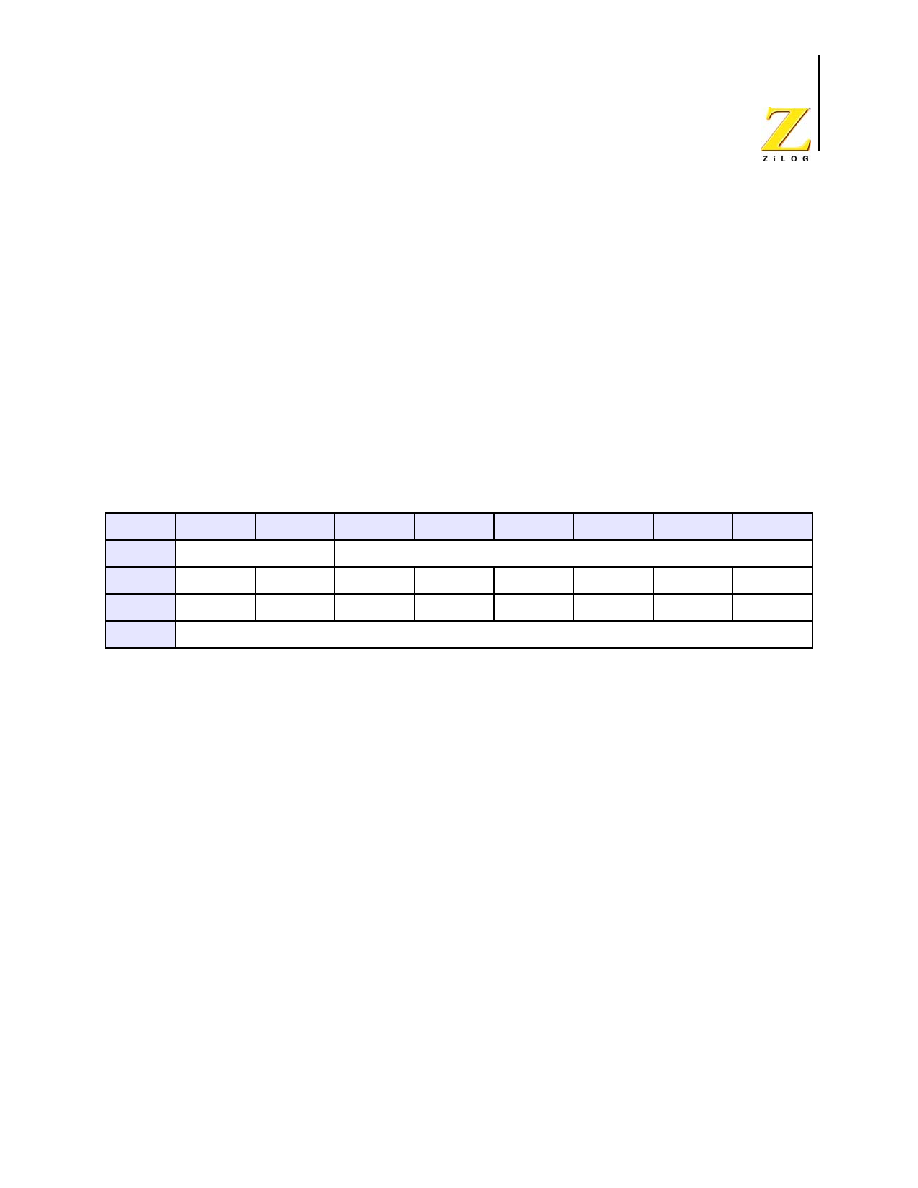
PS024302-0904
P R E L I M I N A R Y Flash
Memory
Z8 Encore!
Æ
4K Series
Product Specification
123
FCMD--Flash Command
73H = First unlock command.
8CH = Second unlock command.
95H = Page Erase command (must be third command in sequence to initiate Page Erase).
63H = Mass Erase command (must be third command in sequence to initiate Mass Erase).
5EH = Enable Flash Sector Protect Register Access
Flash Status Register
The Flash Status register indicates the current state of the Flash Controller. This register
can be read at any time. The read-only Flash Status Register shares its Register File
address with the Write-only Flash Control Register.
Reserved--Must be 0.
FSTAT--Flash Controller Status
000000 = Flash Controller locked.
000001 = First unlock command received (73H written).
000010 = Second unlock command received (8CH written).
000011 = Flash Controller unlocked.
000100 = Sector protect register selected.
001xxx = Program operation in progress.
010xxx = Page erase operation in progress.
100xxx = Mass erase operation in progress
Flash Page Select Register
The Flash Page Select register shares address space with the Flash Sector Protect Register.
Unless the Flash controller is unlocked and written with 5EH, writes to this address target
the Flash Page Select Register.
The register is used to select one of the 8 available Flash memory pages to be programmed
or erased. Each Flash Page contains 512 bytes of Flash memory. During a Page Erase
Table 75. Flash Status Register (FSTAT)
BITS
7
6
5
4
3
2
1
0
FIELD
Reserved
FSTAT
RESET
0
0
0
0
0
0
0
0
R/W
R
R
R
R
R
R
R
R
ADDR
FF8H
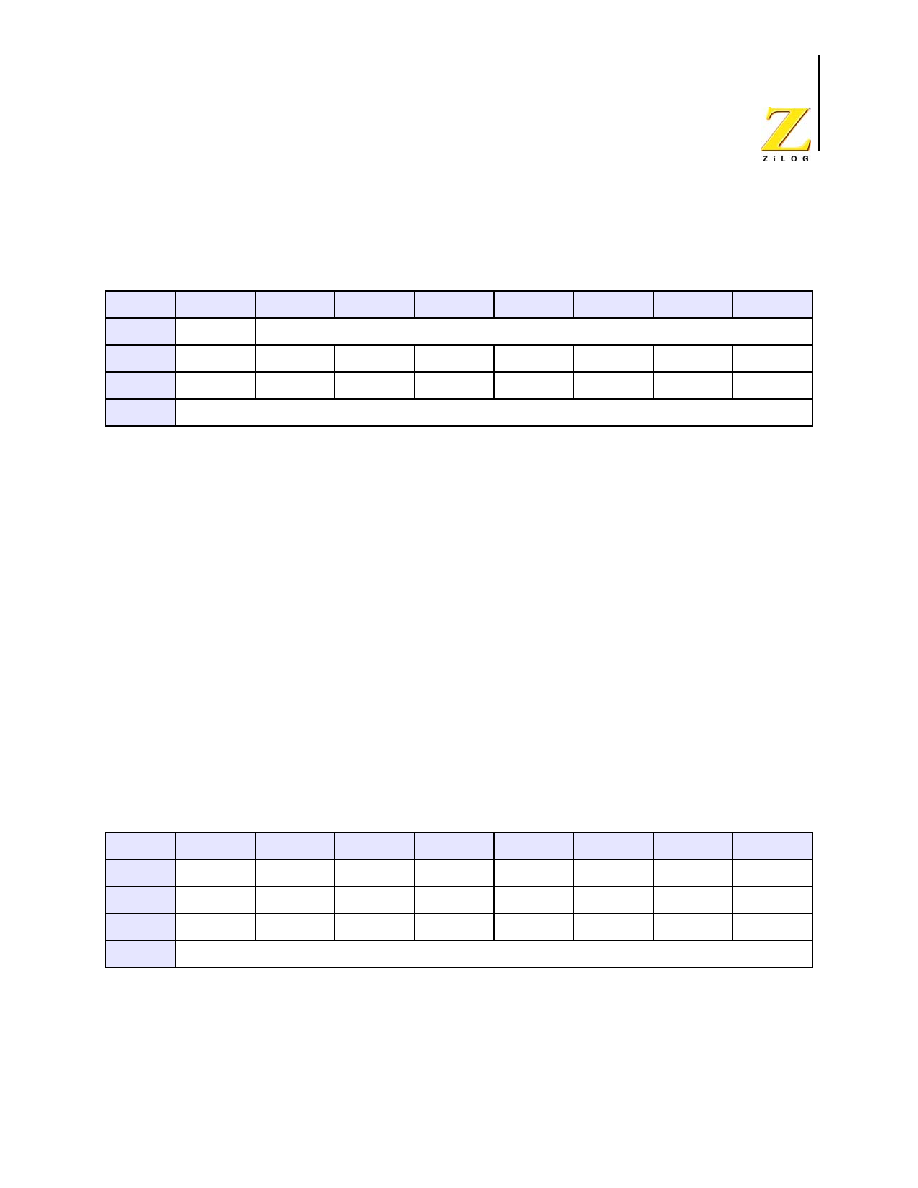
PS024302-0904
P R E L I M I N A R Y Flash
Memory
Z8 Encore!
Æ
4K Series
Product Specification
124
operation, all Flash memory having addresses with the most significant 7-bits given by
FPS[6:0] are chosen for program/erase operation.
Reserved--Must be 0.
PAGE--Page Select
This 7-bit field identifies the Flash memory page for Page Erase and page unlocking.
Program Memory Address[15:9] = PAGE[6:0]. For the Z8F04xx and Z8F02xx devices,
the upper 4 bits must always be 0. For the Z8F01xx devices, the upper 5 bits must always
to 0.
Flash Sector Protect Register
The Flash Sector Protect register is shared with the Flash Page Select Register. When the
Flash Control Register
is unlocked and written with 5EH, the next write to this address tar-
gets the Flash Sector Protect Register. In all other cases, it targets the Flash Page Select
Register.
This register selects one of the 8 available Flash memory sectors to be protected. The reset
state of each Sector Protect bit is an unprotected state. After a sector is protected by setting
its corresponding register bit, it cannot be unprotected (the register bit cannot be cleared)
without powering down the device.
SPROT7-SPROT0--Sector Protection
Each bit corresponds to a 512 byte Flash sector. For the Z8F04xx devices all bits are used.
For the Z8F02xx devices, the upper 4 bits are unused. For the Z8F01xx devices, the upper
6 bits are unused.
Table 76. Flash Page Select Register (FPS)
BITS
7
6
5
4
3
2
1
0
FIELD
Reserved
PAGE
RESET
0
0
0
0
0
0
0
0
R/W
R/W
R/W
R/W
R/W
R/W
R/W
R/W
R/W
ADDR
FF9H
Table 77. Flash Sector Protect Register (FPROT)
BITS
7
6
5
4
3
2
1
0
FIELD
SPROT7
SPROT6
SPROT5
SPROT4
SPROT3
SPROT2
SPROT1
SPROT0
RESET
0
0
0
0
0
0
0
0
R/W
R/W
R/W
R/W
R/W
R/W
R/W
R/W
R/W
ADDR
FF9H
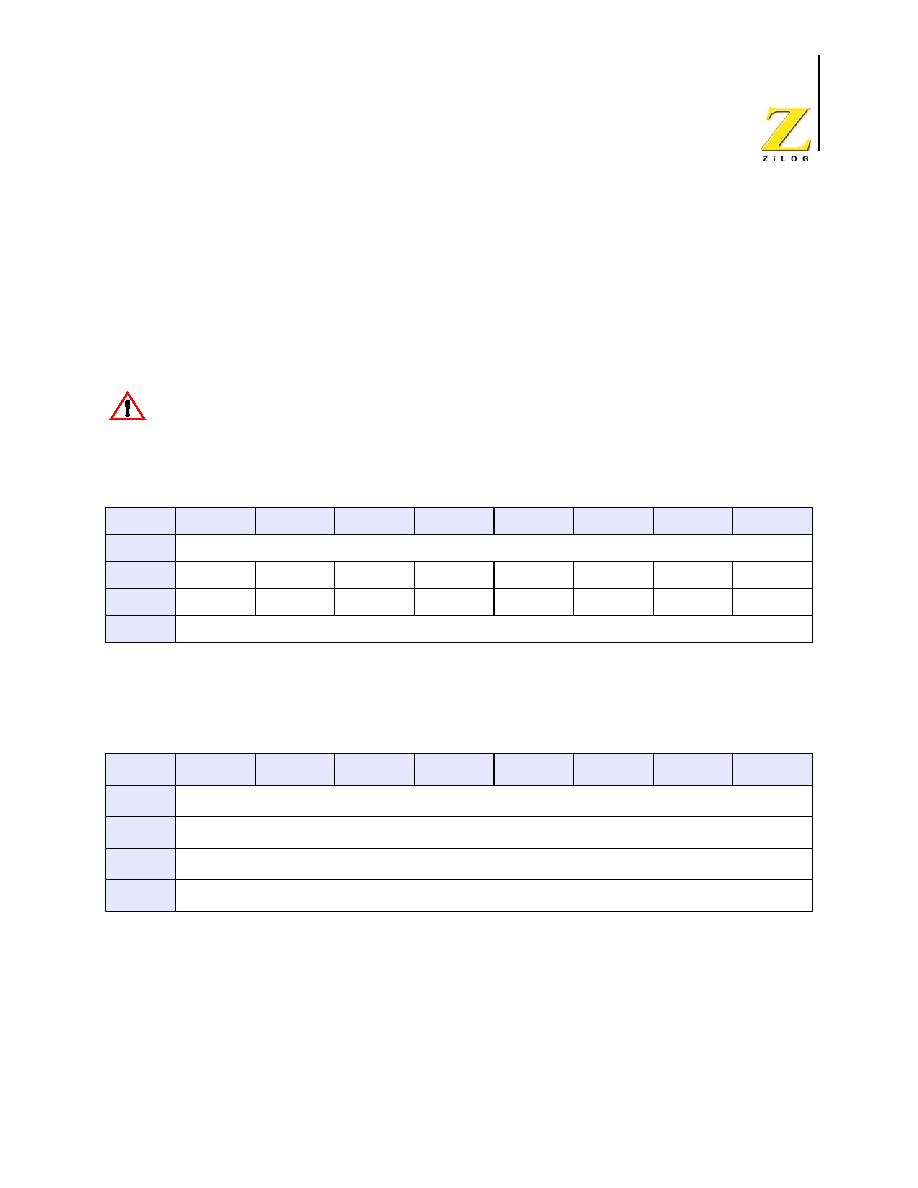
PS024302-0904
P R E L I M I N A R Y Flash
Memory
Z8 Encore!
Æ
4K Series
Product Specification
125
Flash Frequency High and Low Byte Registers
The Flash Frequency High and Low Byte registers combine to form a 16-bit value,
FFREQ, to control timing for Flash program and erase operations. The 16-bit binary Flash
Frequency value must contain the system clock frequency (in KHz) and is calculated using
the following equation:.
Flash programming and erasure is not supported for system clock frequencies below
20KHz or above 5.53MHz. The Flash Frequency High and Low Byte registers must be
loaded with the correct value to ensure proper operation of the device.
FFREQH--Flash Frequency High Byte
High byte of the 16-bit Flash Frequency value.
FFREQL--Flash Frequency Low Byte
Low byte of the 16-bit Flash Frequency value.
Table 78. Flash Frequency High Byte Register (FFREQH)
BITS
7
6
5
4
3
2
1
0
FIELD
FFREQH
RESET
0
0
0
0
0
0
0
0
R/W
R/W
R/W
R/W
R/W
R/W
R/W
R/W
R/W
ADDR
FFAH
Table 79. Flash Frequency Low Byte Register (FFREQL)
BITS
7
6
5
4
3
2
1
0
FIELD
FFREQL
RESET
0
R/W
R/W
ADDR
FFBH
FFREQ[15:0]
FFREQH[7:0],FFREQL[7:0]
{
}
System Clock Frequency
1000
---------------------------------------------------------------
=
=
Caution:

PS024302-0904
P R E L I M I N A R Y
Flash Option Bits
Z8 Encore!
Æ
4K Series
Product Specification
126
Flash Option Bits
Overview
Programmable Flash Option Bits allow user configuration of certain aspects of 4K Series
operation. The feature configuration data is stored in the Flash Program Memory and read
during Reset. The features available for control through the Flash Option Bits are:
∑
Watch-Dog Timer time-out response selection≠interrupt or system reset
∑
Watch-Dog Timer enabled at Reset
∑
The ability to prevent unwanted read access to user code in Program Memory
∑
The ability to prevent accidental programming and erasure of all or a portion of the user
code in Program Memory
∑
Voltage Brown-Out configuration-always enabled or disabled during STOP mode to re-
duce STOP mode power consumption
∑
Factory trimming information for the Internal Precision Oscillator and Temperature Sen-
sor
∑
Factory calibration values for ADC compensation
Operation
Option Bit Configuration By Reset
Each time the Flash Option Bits are programmed or erased, the device must be Reset for
the change to take effect. During any reset operation (System Reset or STOP Mode
Recovery), the Flash Option Bits are automatically read from the Flash Program Memory
and written to Option Configuration registers. The Option Configuration registers control
operation of the devices within the 4K Series. Option Bit control is established before the
device exits Reset and the eZ8 CPU begins code execution. The Option Configuration reg-
isters are not part of the Register File and are not accessible for read or write access.
Option Bit Types
User Option Bits
The user option bits are contained in the first two bytes of program memory. User access
to these bits has been provided because these locations contain application-specific device
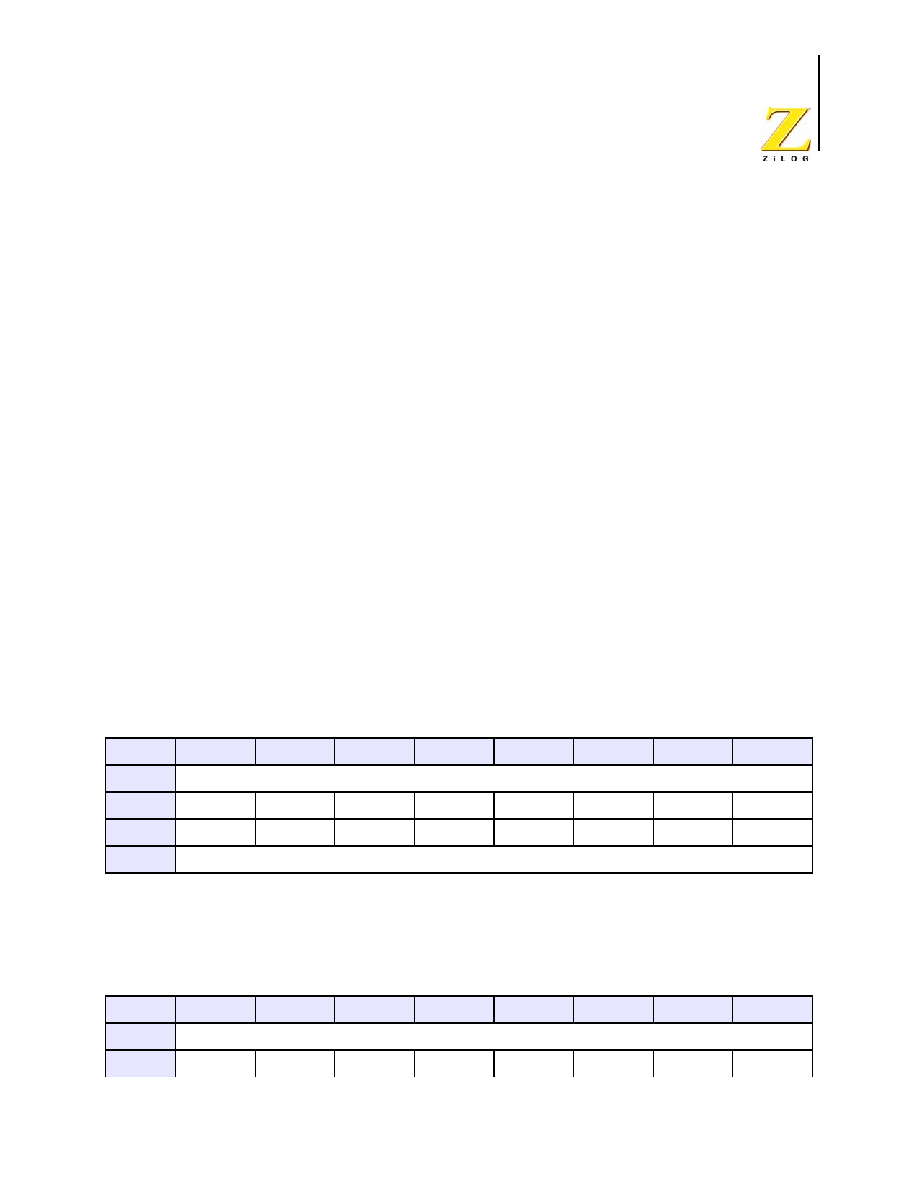
PS024302-0904
P R E L I M I N A R Y
Flash Option Bits
Z8 Encore!
Æ
4K Series
Product Specification
127
configurations. The information contained here is lost when page 0 of the program mem-
ory is erased.
Trim Option Bits
The trim option bits are contained in the information page of the Flash memory. These bits
are factory programmed values required to optimize the operation of onboard analog cir-
cuitry and cannot be permanently altered by the user. Program memory may be erased
without endangering these values. It is possible to alter working values of these bits by
accessing the Trim Bit Address and Data Registers, but these working values are lost after
a power loss.
There are 32 bytes of trim data. To modify one of these values the user code must first
write a value between
00H
and
1FH
into the Trim Bit Address Register. The next write to
the Trim Bit Data register changes the working value of the target trim data byte.
Reading the trim data requires the user code to write a value between
00H
and
1FH
into the
Trim Bit Address Register. The next read from the Trim Bit Data register returns the work-
ing value of the target trim data byte.
Flash Option Bit Control Register Definitions
Trim Bit Address Register
This register contains the target address for an access to the trim option bits.
Trim Bit Data Register
This register contains the read or write data for access to the trim option bits.
Table 80. Trim Bit Address Register (TRMADR)
BITS
7
6
5
4
3
2
1
0
FIELD
TRMADR - Trim Bit Address (00H to 1FH)
RESET
0
0
0
0
0
0
0
0
R/W
R/W
R/W
R/W
R/W
R/W
R/W
R/W
R/W
ADDR
FF6H
Table 81. Trim Bit Data Register (TRMDR)
BITS
7
6
5
4
3
2
1
0
FIELD
TRMDR - Trim Bit Data
RESET
0
0
0
0
0
0
0
0
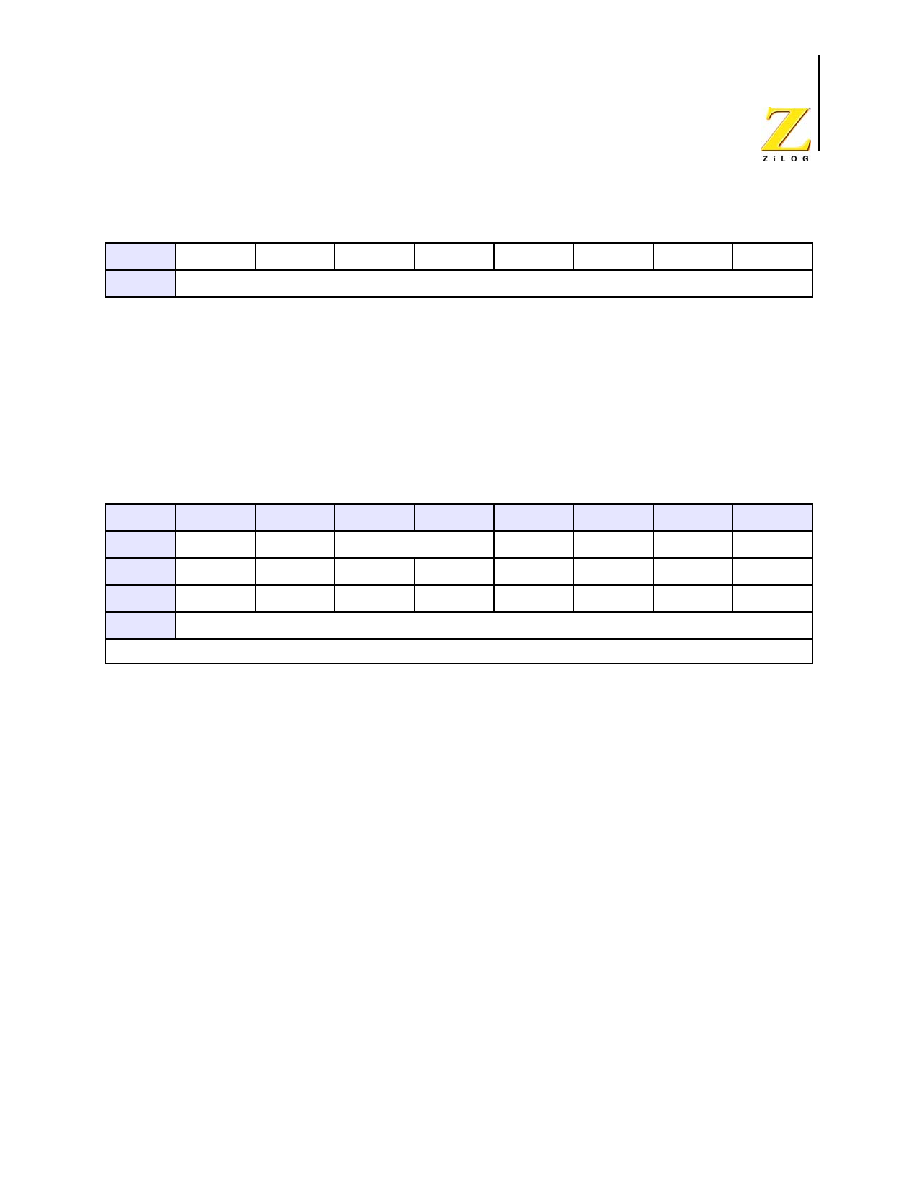
PS024302-0904
P R E L I M I N A R Y
Flash Option Bits
Z8 Encore!
Æ
4K Series
Product Specification
128
Flash Option Bit Address Space
The first two bytes of Flash Program Memory at addresses
0000H
and
0001H
are reserved
for the user-programmable Flash Option Bits.
Flash Program Memory Address 0000H
WDT_RES--Watch-Dog Timer Reset
0 = Watch-Dog Timer time-out generates an interrupt request. Interrupts must be globally
enabled for the eZ8 CPU to acknowledge the interrupt request.
1 = Watch-Dog Timer time-out causes a system reset. This setting is the default for unpro-
grammed (erased) Flash.
WDT_AO--Watch-Dog Timer Always On
0 = Watch-Dog Timer is automatically enabled upon application of system power. Watch-
Dog Timer can not be disabled.
1 = Watch-Dog Timer is enabled upon execution of the WDT instruction. Once enabled,
the Watch-Dog Timer can only be disabled by a Reset or STOP Mode Recovery. This set-
ting is the default for unprogrammed (erased) Flash.
VBO_AO--Voltage Brown-Out Protection Always On
0 = Voltage Brown-Out Protection is disabled in STOP mode to reduce total power con-
sumption.
1 = Voltage Brown-Out Protection is always enabled including during STOP mode. This
setting is the default for unprogrammed (erased) Flash.
FRP--Flash Read Protect
0 = User program code is inaccessible. Limited control features are available through the
On-Chip Debugger.
R/W
R/W
R/W
R/W
R/W
R/W
R/W
R/W
R/W
ADDR
FF7H
Table 82. Flash Option Bits at Program Memory Address 0000H
BITS
7
6
5
4
3
2
1
0
FIELD
WDT_RES WDT_AO
Reserved
VBO_AO
FRP
Reserved
FWP
RESET
U
U
U
U
U
U
U
U
R/W
R/W
R/W
R/W
R/W
R/W
R/W
R/W
R/W
ADDR
Program Memory 0000H
Note: U = Unchanged by Reset. R/W = Read/Write.
Table 81. Trim Bit Data Register (TRMDR)

PS024302-0904
P R E L I M I N A R Y
Flash Option Bits
Z8 Encore!
Æ
4K Series
Product Specification
129
1 = User program code is accessible. All On-Chip Debugger commands are enabled. This
setting is the default for unprogrammed (erased) Flash.
Reserved--Must be 1.
FWP--Flash Write Protect
This Option Bit provides Flash Program Memory protection:
0 = Programming and erasure disabled for all of Flash Program Memory. Programming,
Page Erase, and Mass Erase through User Code is disabled. Mass Erase is available using
the On-Chip Debugger.
1 = Programming, Page Erase, and Mass Erase are enabled for all of Flash Program Mem-
ory.
Flash Program Memory Address 0001H
Reserved--Must be 1.
Trim Bit Address Space
Trim Bit Address 0000H - Reserved
Trim Bit Address 0001H - Reserved
Trim Bit Address 0002H
Table 83. Flash Options Bits at Program Memory Address 0001H
BITS
7
6
5
4
3
2
1
0
FIELD
Reserved
RESET
U
U
U
U
U
U
U
U
R/W
R/W
R/W
R/W
R/W
R/W
R/W
R/W
R/W
ADDR
Program Memory 0001H
Note: U = Unchanged by Reset. R/W = Read/Write.
Table 84. Trim Option Bits at 0002H (TIPO)
BITS
7
6
5
4
3
2
1
0
FIELD
IPO_TRIM
RESET
U
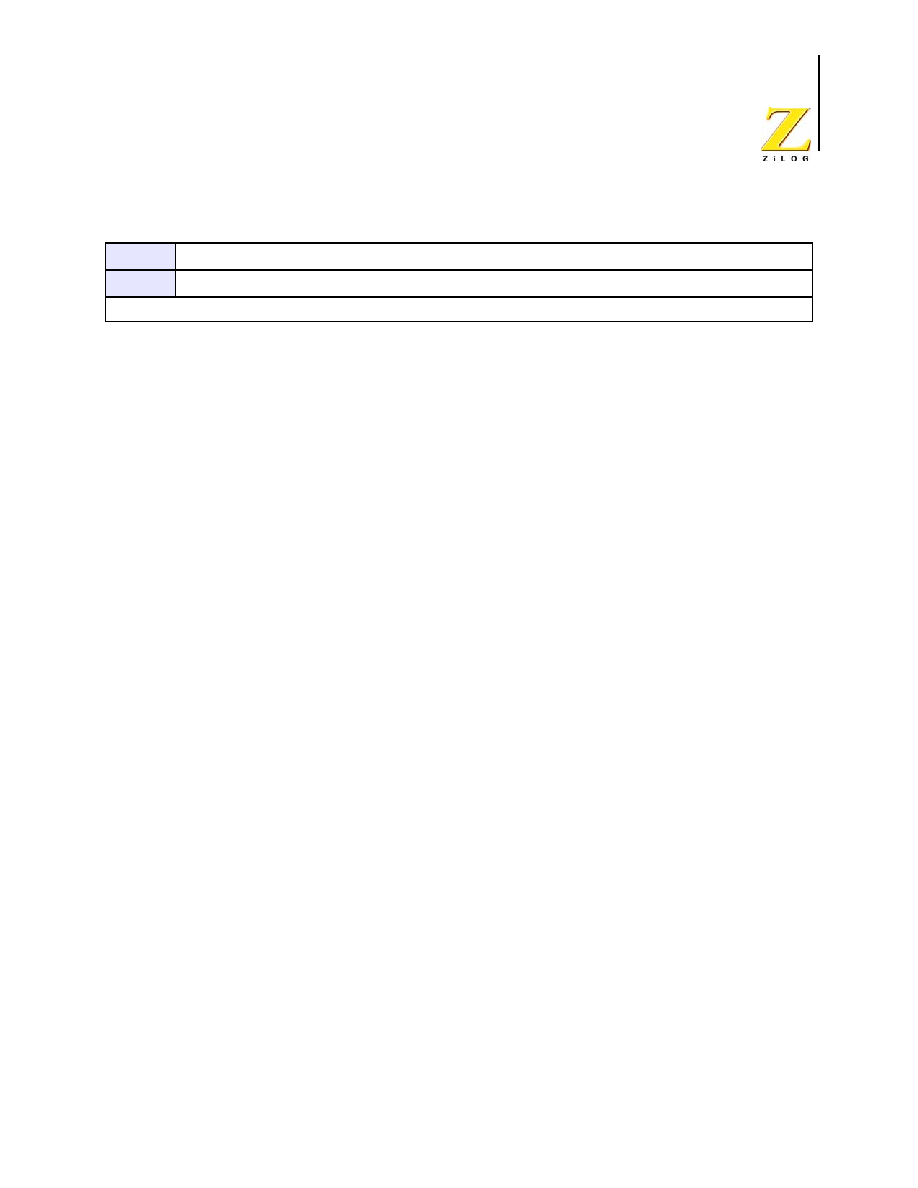
PS024302-0904
P R E L I M I N A R Y
Flash Option Bits
Z8 Encore!
Æ
4K Series
Product Specification
130
IPO_TRIM--Internal Precision Oscillator Trim Byte
Contains trimming bits for Internal Precision Oscillator.
Trim Bit Address 0003H - Reserved
Trim Bit Address 0004H - Reserved
R/W
R/W
ADDR
Information Page Memory 0022H
Note: U = Unchanged by Reset. R/W = Read/Write.
Table 84. Trim Option Bits at 0002H (TIPO)
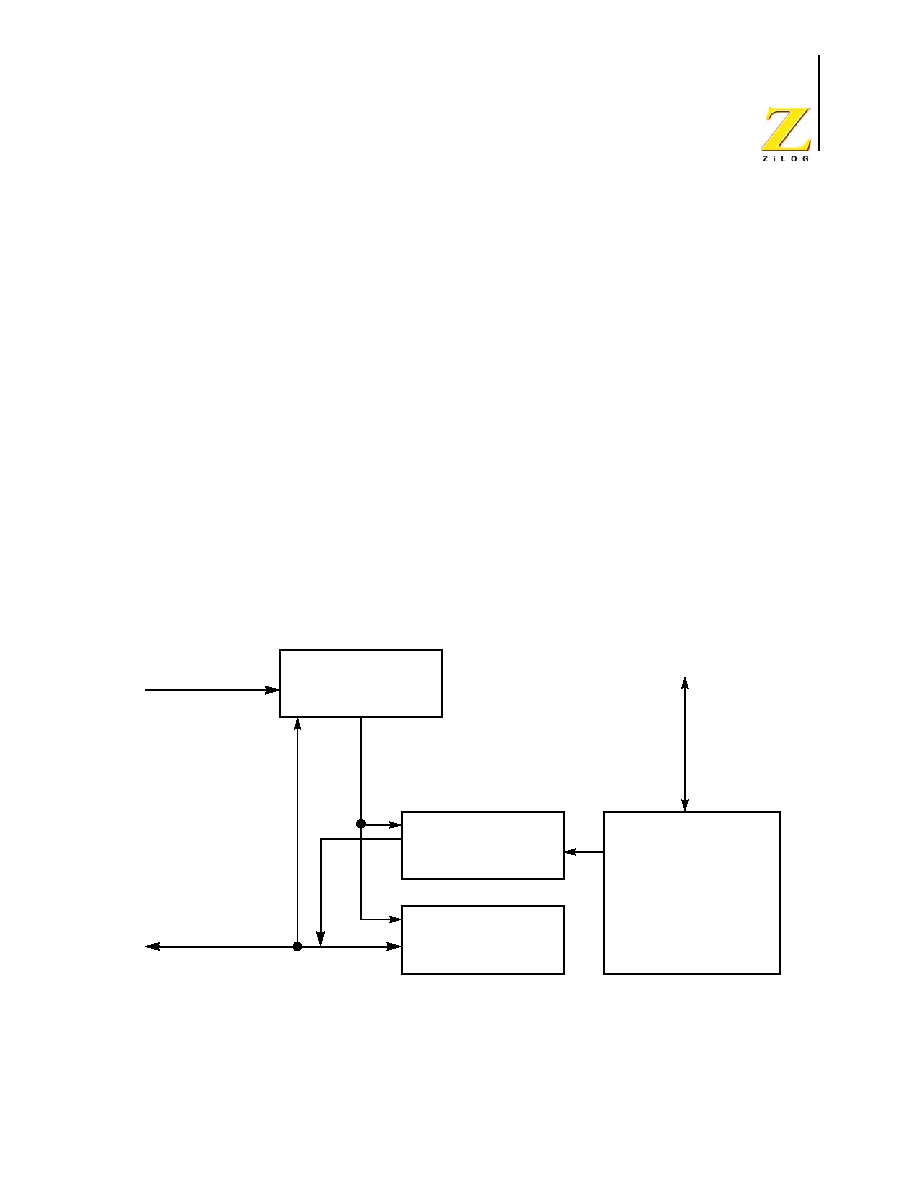
PS024302-0904
P R E L I M I N A R Y On-Chip
Debugger
Z8 Encore!
Æ
4K Series
Product Specification
131
On-Chip Debugger
Overview
The Z8 Encore!
Æ
4K Series devices contain an integrated On-Chip Debugger (OCD) that
provides advanced debugging features including:
∑
Reading and writing of the Register File
∑
Reading and writing of Program and Data Memory
∑
Setting of Breakpoints and Watchpoints
∑
Executing eZ8 CPU instructions
Architecture
The On-Chip Debugger consists of four primary functional blocks: transmitter, receiver,
auto-baud detector/generator, and debug controller. Figure 22 illustrates the architecture of
the On-Chip Debugger
Figure 22.On-Chip Debugger Block Diagram
Auto-Baud
System Clock
Transmitter
Receiver
DBG Pin
Debug Controller
eZ
8 CPU Control
Detector/Generator
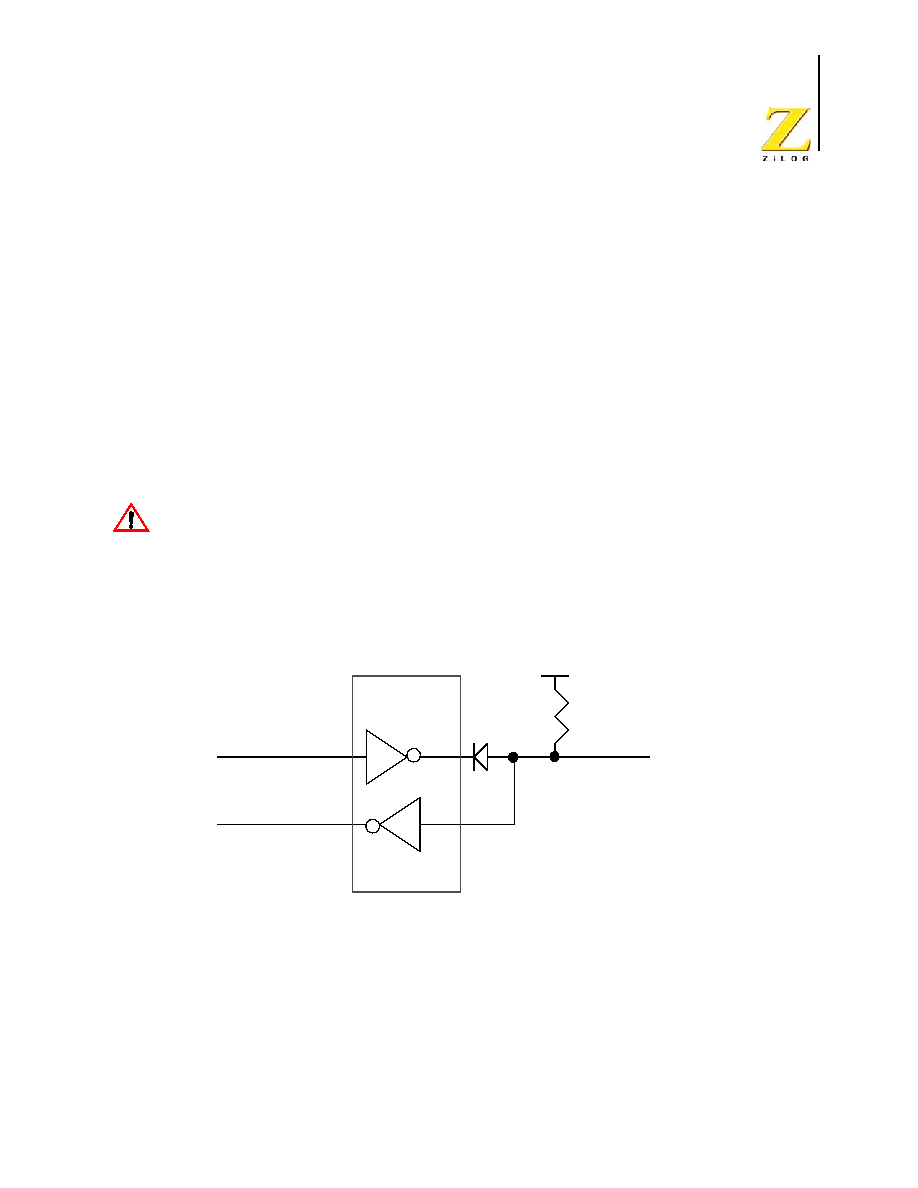
PS024302-0904
P R E L I M I N A R Y On-Chip
Debugger
Z8 Encore!
Æ
4K Series
Product Specification
132
Operation
OCD Interface
The On-Chip Debugger uses the DBG pin for communication with an external host. This
one-pin interface is a bi-directional open-drain interface that transmits and receives data.
Data transmission is half-duplex, in that transmit and receive cannot occur simultaneously.
The serial data on the DBG pin is sent using the standard asynchronous data format
defined in RS-232. This pin creates an interface from the PartName products to the serial
port of a host PC using minimal external hardware.Two different methods for connecting
the DBG pin to an RS-232 interface are depicted in Figures 23 and 24 . The recommended
method is the buffered implementation depicted in Figure 24 . The DBG pin must always
be connected to V
DD
through an external pull-up resistor.
For operation of the On-Chip Debugger, all power pins (V
DD
and AV
DD
)
must be supplied with power, and all ground pins (V
SS
and AV
SS
) must be
properly grounded.
The
DBG
pin is open-drain and must always be connected to V
DD
through
an external pull-up resistor to insure proper operation.
Figure 23.Interfacing the On-Chip Debugger's DBG Pin with an RS-232 Interface (1)
Caution:
RS-232 TX
RS-232 RX
RS-232
Transceiver
VDD
DBG Pin
10KOhm
Schottky
Diode
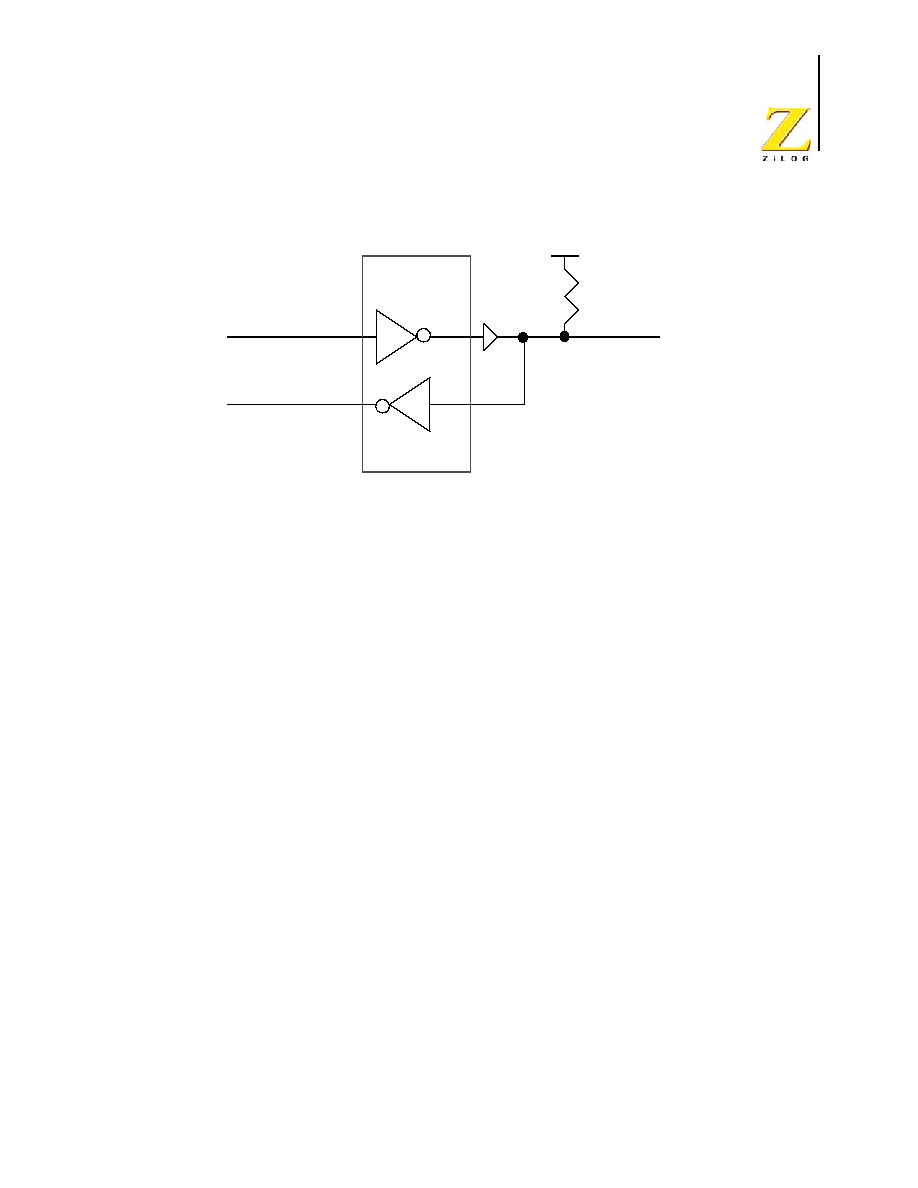
PS024302-0904
P R E L I M I N A R Y On-Chip
Debugger
Z8 Encore!
Æ
4K Series
Product Specification
133
Figure 24.Interfacing the On-Chip Debugger's DBG Pin with an RS-232 Interface (2)
DEBUG Mode
The operating characteristics of the devices in DEBUG mode are:
∑
The eZ8 CPU fetch unit stops, idling the eZ8 CPU, unless directed by the OCD to execute
specific instructions
∑
The system clock operates unless in STOP mode
∑
All enabled on-chip peripherals operate unless in STOP mode
∑
Automatically exits HALT mode
∑
Constantly refreshes the Watch-Dog Timer, if enabled
Entering DEBUG Mode
∑
The device enters DEBUG mode after the eZ8 CPU executes a BRK (Breakpoint) instruc-
tion.
∑
If the DBG pin is held Low during the most recent clock cycle of system reset, the part
enters DEBUG mode upon exiting system reset.
Exiting DEBUG Mode
The device exits DEBUG mode following any of these operations:
∑
Clearing the DBGMODE bit in the OCD Control Register to 0.
∑
Power-on reset
∑
Voltage Brown-Out reset
∑
Watch-Dog Timer reset
RS-232 TX
RS-232 RX
RS-232
Transceiver
VDD
DBG Pin
10KOhm
Open-Drain
Buffer

PS024302-0904
P R E L I M I N A R Y On-Chip
Debugger
Z8 Encore!
Æ
4K Series
Product Specification
134
∑
Asserting the RESET pin Low to initiate a Reset.
∑
Driving the DBG pin Low while the device is in STOP mode initiates a System Reset.
OCD Data Format
The OCD interface uses the asynchronous data format defined for RS-232. Each character
is transmitted as 1 Start bit, 8 data bits (least-significant bit first), and 1.5 Stop bits
(Figure 25)
Figure 25.OCD Data Format
OCD Auto-Baud Detector/Generator
To run over a range of baud rates (data bits per second) with various system clock frequen-
cies, the On-Chip Debugger contains an Auto-Baud Detector/Generator. After a reset, the
OCD is idle until it receives data. The OCD requires that the first character sent from the
host is the character
80H
. The character
80H
has eight continuous bits Low (one Start bit
plus 7 data bits), framed between High bits. The Auto-Baud Detector measures this period
and sets the OCD Baud Rate Generator accordingly.
The Auto-Baud Detector/Generator is clocked by the system clock. The minimum baud
rate is the system clock frequency divided by 512. For optimal operation with asynchro-
nous datastreams, the maximum recommended baud rate is the system clock frequency
divided by 8. The maximum possible baud rate for asynchronous datastreams is the sys-
tem clock frequency divided by 4, but this theoretical maximum is possible only for low
noise designs with clean signals. Table 85 lists minimum and recommended maximum
baud rates for IPO frequencies.
If the OCD receives a Serial Break (nine or more continuous bits Low) the Auto-Baud
Detector/Generator resets. Reconfigure the Auto-Baud Detector/Generator by sending
80H
.
Table 85. OCD Baud-Rate Limits
System Clock
Frequency
(MHz)
Recommended
Maximum Baud
Rate (Kbps)
Recommended
Standard PC
Baud Rate (bps)
Minimum Baud
Rate (Kbps)
5.5296
1382.4
691,200
1.08
0.032768 (32KHz)
4.096
2400
0.064
START
D0
D1
D2
D3
D4
D5
D6
D7
STOP

PS024302-0904
P R E L I M I N A R Y On-Chip
Debugger
Z8 Encore!
Æ
4K Series
Product Specification
135
OCD Serial Errors
The On-Chip Debugger can detect any of the following error conditions on the DBG pin:
∑
Serial Break (a minimum of nine continuous bits Low)
∑
Framing Error (received
Stop
bit is Low)
∑
Transmit Collision (OCD and host simultaneous transmission detected by the OCD)
When the OCD detects one of these errors, it aborts any command currently in progress,
transmits a four character long Serial Break back to the host, and resets the Auto-Baud
Detector/Generator. A Framing Error or Transmit Collision may be caused by the host
sending a Serial Break to the OCD. Because of the open-drain nature of the interface,
returning a Serial Break break back to the host only extends the length of the Serial Break
if the host releases the Serial Break early.
The host transmits a Serial Break on the
DBG
pin when first connecting to the 4K Series
devices or when recovering from an error. A Serial Break from the host resets the Auto-
Baud Generator/Detector but does not reset the OCD Control register. A Serial Break
leaves the device in DEBUG mode if that is the current mode. The OCD is held in Reset
until the end of the Serial Break when the DBG pin returns High. Because of the open-
drain nature of the DBG pin, the host can send a Serial Break to the OCD even if the OCD
is transmitting a character.
Breakpoints
Execution Breakpoints are generated using the BRK instruction (opcode
00H
). When the
eZ8 CPU decodes a BRK instruction, it signals the On-Chip Debugger. If Breakpoints are
enabled, the OCD enters DEBUG mode and idles the eZ8 CPU. If Breakpoints are not
enabled, the OCD ignores the BRK signal and the
BRK
instruction operates as an NOP
instruction.
Breakpoints in Flash Memory
The
BRK
instruction is opcode
00H
, which corresponds to the fully programmed state of a
byte in Flash memory. To implement a Breakpoint, write
00H
to the required break
address, overwriting the current instruction. To remove a Breakpoint, the corresponding
page of Flash memory must be erased and reprogrammed with the original data.
Runtime Counter
The On-Chip Debugger contains a 16-bit Runtime Counter. It counts system clock cycles
between Breakpoints. The counter starts counting when the On-Chip Debugger leaves
DEBUG mode and stops counting when it enters DEBUG mode again or when it reaches
the maximum count of
FFFFH
.

PS024302-0904
P R E L I M I N A R Y On-Chip
Debugger
Z8 Encore!
Æ
4K Series
Product Specification
136
On-Chip Debugger Commands
The host communicates to the On-Chip Debugger by sending OCD commands using the
DBG interface. During normal operation, only a subset of the OCD commands are avail-
able. In DEBUG mode, all OCD commands become available unless the user code and
control registers are protected by programming the Flash Read Protect Option bit (
FRP
).
The Flash Read Protect Option bit prevents the code in memory from being read out of the
4K Series products. When this option is enabled, several of the OCD commands are dis-
abled. Table 86 on page 141 is a summary of the On-Chip Debugger commands. Each
OCD command is described in further detail in the bulleted list following this table.
Table 86 also indicates those commands that operate when the device is not in DEBUG
mode (normal operation) and those commands that are disabled by programming the Flash
Read Protect Option bit.
Debug Command
Command
Byte
Enabled when
NOT in DEBUG
mode?
Disabled by
Flash Read Protect Option Bit
Read OCD Revision
00H
Yes
≠
Reserved
01H
≠
≠
Read OCD Status Register
02H
Yes
≠
Read Runtime Counter
03H
≠
≠
Write OCD Control Register
04H
Yes
Cannot clear DBGMODE bit
Read OCD Control Register
05H
Yes
≠
Write Program Counter
06H
≠
Disabled
Read Program Counter
07H
≠
Disabled
Write Register
08H
≠
Only writes of the Flash Memory Control
registers are allowed. Additionally, only
the Mass Erase command is allowed to
be written to the Flash Control register.
Read Register
09H
≠
Disabled
Write Program Memory
0AH
≠
Disabled
Read Program Memory
0BH
≠
Disabled
Write Data Memory
0CH
≠
Yes
Read Data Memory
0DH
≠
≠
Read Program Memory CRC
0EH
≠
≠
Reserved
0FH
≠
≠
Step Instruction
10H
≠
Disabled

PS024302-0904
P R E L I M I N A R Y On-Chip
Debugger
Z8 Encore!
Æ
4K Series
Product Specification
137
In the following bulleted list of OCD Commands, data and commands sent from the host
to the On-Chip Debugger are identified by '
DBG
Command/Data
'. Data sent from the
On-Chip Debugger back to the host is identified by '
DBG
Data
'
∑
Read OCD Revision (00H)--The Read OCD Revision command determines the ver-
sion of the On-Chip Debugger. If OCD commands are added, removed, or changed, this
revision number changes.
DBG
00H
DBG
OCDRev[15:8] (Major revision number)
DBG
OCDRev[7:0] (Minor revision number)
∑
Read OCD Status Register (02H)--The Read OCD Status Register command reads the
OCDSTAT register.
DBG
02H
DBG
OCDSTAT[7:0]
∑
Read Runtime Counter (03H)--The Runtime Counter counts system clock cycles in
between Breakpoints. The 16-bit Runtime Counter counts up from
0000H
and stops at the
maximum count of
FFFFH
. The Runtime Counter is overwritten during the Write Memo-
ry, Read Memory, Write Register, Read Register, Read Memory CRC, Step Instruction,
Stuff Instruction, and Execute Instruction commands.
DBG
03H
DBG
RuntimeCounter[15:8]
DBG
RuntimeCounter[7:0]
∑
Write OCD Control Register (04H)--The Write OCD Control Register command
writes the data that follows to the OCDCTL register. When the Flash Read Protect Option
Bit is enabled, the DBGMODE bit (
OCDCTL
[7]) can only be set to 1, it cannot be cleared
to 0 and the only method of returning the device to normal operating mode is to reset the
device.
DBG
04H
DBG
OCDCTL[7:0]
∑
Read OCD Control Register (05H)--The Read OCD Control Register command reads
the value of the OCDCTL register.
Stuff Instruction
11H
≠
Disabled
Execute Instruction
12H
≠
Disabled
Reserved
13H≠FFH
≠
≠
Debug Command
Command
Byte
Enabled when
NOT in DEBUG
mode?
Disabled by
Flash Read Protect Option Bit

PS024302-0904
P R E L I M I N A R Y On-Chip
Debugger
Z8 Encore!
Æ
4K Series
Product Specification
138
DBG
05H
DBG
OCDCTL[7:0]
∑
Write Program Counter (06H)--The Write Program Counter command writes the data
that follows to the eZ8 CPU's Program Counter (PC). If the device is not in DEBUG mode
or if the Flash Read Protect Option bit is enabled, the Program Counter (PC) values are
discarded.
DBG
06H
DBG
ProgramCounter[15:8]
DBG
ProgramCounter[7:0]
∑
Read Program Counter (07H)--The Read Program Counter command reads the value
in the eZ8 CPU's Program Counter (PC). If the device is not in DEBUG mode or if the
Flash Read Protect Option bit is enabled, this command returns
FFFFH
.
DBG
07H
DBG
ProgramCounter[15:8]
DBG
ProgramCounter[7:0]
∑
Write Register (08H)--The Write Register command writes data to the Register File.
Data can be written 1≠256 bytes at a time (256 bytes can be written by setting size to 0). If
the device is not in DEBUG mode, the address and data values are discarded. If the Flash
Read Protect Option
bit is enabled, only writes to the Flash Control Registers are allowed
and all other register write data values are discarded.
DBG
08H
DBG
{4'h0,Register Address[11:8]}
DBG
Register Address[7:0]
DBG
Size[7:0]
DBG
1-256 data bytes
∑
Read Register (09H)--The Read Register command reads data from the Register File.
Data can be read 1≠256 bytes at a time (256 bytes can be read by setting size to 0). If the
device is not in DEBUG mode or if the Flash Read Protect Option bit is enabled, this com-
mand returns
FFH
for all the data values.
DBG
09H
DBG
{4'h0,Register Address[11:8]
DBG
Register Address[7:0]
DBG
Size[7:0]
DBG
1-256 data bytes
∑
Write Program Memory (0AH)--The Write Program Memory command writes data
to Program Memory. This command is equivalent to the LDC and LDCI instructions. Data
can be written 1≠65536 bytes at a time (65536 bytes can be written by setting size to 0).
The on-chip Flash Controller must be written to and unlocked for the programming oper-
ation to occur. If the Flash Controller is not unlocked, the data is discarded. If the device

PS024302-0904
P R E L I M I N A R Y On-Chip
Debugger
Z8 Encore!
Æ
4K Series
Product Specification
139
is not in DEBUG mode or if the Flash Read Protect Option bit is enabled, the data is dis-
carded.
DBG
0AH
DBG
Program Memory Address[15:8]
DBG
Program Memory Address[7:0]
DBG
Size[15:8]
DBG
Size[7:0]
DBG
1-65536 data bytes
∑
Read Program Memory (0BH)--The Read Program Memory command reads data
from Program Memory. This command is equivalent to the LDC and LDCI instructions.
Data can be read 1≠65536 bytes at a time (65536 bytes can be read by setting size to 0). If
the device is not in DEBUG mode or if the Flash Read Protect Option Bit is enabled, this
command returns
FFH
for the data.
DBG
0BH
DBG
Program Memory Address[15:8]
DBG
Program Memory Address[7:0]
DBG
Size[15:8]
DBG
Size[7:0]
DBG
1-65536 data bytes
∑
Write Data Memory (0CH)--The Write Data Memory command writes data to Data
Memory. This command is equivalent to the LDE and LDEI instructions. Data can be writ-
ten 1≠65536 bytes at a time (65536 bytes can be written by setting size to 0). If the device
is not in DEBUG mode or if the Flash Read Protect Option Bit is enabled, the data is dis-
carded.
DBG
0CH
DBG
Data Memory Address[15:8]
DBG
Data Memory Address[7:0]
DBG
Size[15:8]
DBG
Size[7:0]
DBG
1-65536 data bytes
∑
Read Data Memory (0DH)--The Read Data Memory command reads from Data Mem-
ory. This command is equivalent to the LDE and LDEI instructions. Data can be read 1 to
65536 bytes at a time (65536 bytes can be read by setting size to 0). If the device is not in
DEBUG mode, this command returns
FFH
for the data.
DBG
0DH
DBG
Data Memory Address[15:8]
DBG
Data Memory Address[7:0]
DBG
Size[15:8]
DBG
Size[7:0]
DBG
1-65536 data bytes

PS024302-0904
P R E L I M I N A R Y On-Chip
Debugger
Z8 Encore!
Æ
4K Series
Product Specification
140
∑
Read Program Memory CRC (0EH)--The Read Program Memory CRC command
computes and returns the Cyclic Redundancy Check (CRC) of Program Memory using the
16-bit CRC-CCITT polynomial. If the device is not in DEBUG mode, this command re-
turns
FFFFH
for the CRC value. Unlike most other OCD Read commands, there is a delay
from issuing of the command until the OCD returns the data. The OCD reads the Program
Memory, calculates the CRC value, and returns the result. The delay is a function of the
Program Memory size and is approximately equal to the system clock period multiplied
by the number of bytes in the Program Memory.
DBG
0EH
DBG
CRC[15:8]
DBG
CRC[7:0]
∑
Step Instruction (10H)--The Step Instruction command steps one assembly instruction
at the current Program Counter (PC) location. If the device is not in DEBUG mode or the
Flash Read Protect Option bit is enabled, the OCD ignores this command.
DBG
10H
∑
Stuff Instruction (11H)--The Stuff Instruction command steps one assembly instruction
and allows specification of the first byte of the instruction. The remaining 0-4 bytes of the
instruction are read from Program Memory. This command is useful for stepping over in-
structions where the first byte of the instruction has been overwritten by a Breakpoint. If
the device is not in DEBUG mode or the Flash Read Protect Option bit is enabled, the
OCD ignores this command.
DBG
11H
DBG
opcode[7:0]
∑
Execute Instruction (12H)--The Execute Instruction command allows sending an en-
tire instruction to be executed to the eZ8 CPU. This command can also step over Break-
points. The number of bytes to send for the instruction depends on the opcode. If the device
is not in DEBUG mode or the Flash Read Protect Option bit is enabled, this command
reads and discards one byte.
DBG
12H
DBG
1-5 byte opcode
On-Chip Debugger Control Register Definitions
OCD Control Register
The OCD Control register controls the state of the On-Chip Debugger. This register is
used to enter or exit DEBUG mode and to enable the
BRK
instruction. It can also reset the
4K Series device.

PS024302-0904
P R E L I M I N A R Y On-Chip
Debugger
Z8 Encore!
Æ
4K Series
Product Specification
141
A reset and stop function can be achieved by writing
81H
to this register. A reset
and
go
function can be achieved by writing
41H
to this register. If the device is in DEBUG mode,
a run function can be implemented by writing
40H
to this register.
.
DBGMODE--Debug Mode
The device enters DEBUG mode when this bit is 1. When in DEBUG mode, the eZ8 CPU
stops fetching new instructions. Clearing this bit causes the eZ8 CPU to restart. This bit is
automatically set when a BRK instruction is decoded and Breakpoints are enabled. If the
Flash Read Protect Option Bit is enabled, this bit can only be cleared by resetting the
device. It cannot be written to 0.
0 = The 4K Series device is operating in NORMAL mode.
1 = The 4K Series device is in DEBUG mode.
BRKEN--Breakpoint Enable
This bit controls the behavior of the
BRK
instruction (opcode
00H
). By default, Break-
points are disabled and the
BRK
instruction behaves similar to an NOP instruction. If this
bit is 1, when a
BRK
instruction is decoded, the
DBGMODE
bit of the OCDCTL register is
automatically set to 1.
0 = Breakpoints are disabled.
1 = Breakpoints are enabled.
DBGACK--Debug Acknowledge
This bit enables the debug acknowledge feature. If this bit is set to 1, the OCD sends a
Debug Acknowledge character (
FFH
) to the host when a Breakpoint occurs.
0 = Debug Acknowledge is disabled.
1 = Debug Acknowledge is enabled.
Reserved--Must be 0.
RST--Reset
Setting this bit to 1 resets the Z8F04xA family device. The device goes through a normal
Power-On Reset sequence with the exception that the On-Chip Debugger is not reset. This
bit is automatically cleared to 0 at the end of reset.
0 = No effect.
1 = Reset the Flash Read Protect Option Bit device.
Table 86. OCD Control Register (OCDCTL)
BITS
7
6
5
4
3
2
1
0
FIELD
DBGMODE BRKEN DBGACK
Reserved
RST
RESET
0
0
0
0
0
0
0
0
R/W
R/W
R/W
R/W
R
R
R
R
R/W
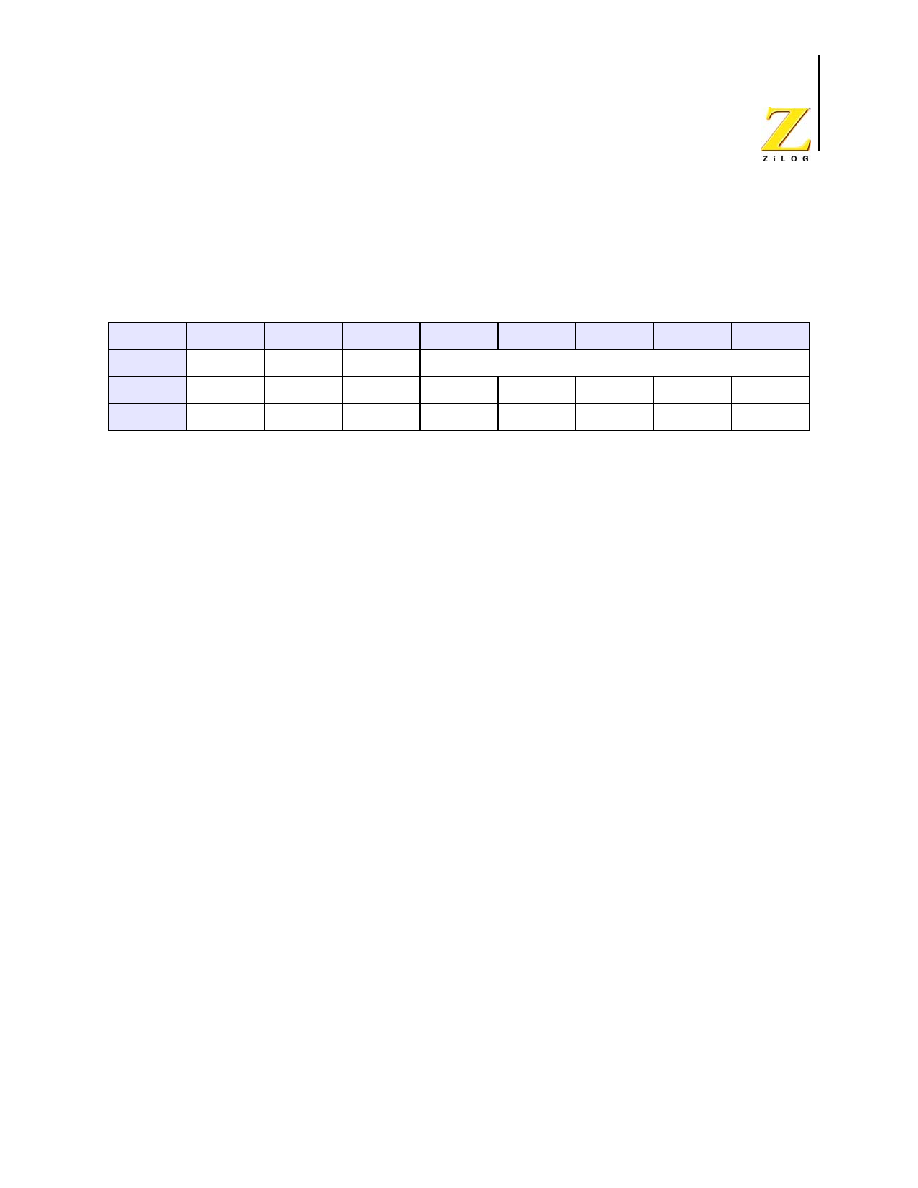
PS024302-0904
P R E L I M I N A R Y On-Chip
Debugger
Z8 Encore!
Æ
4K Series
Product Specification
142
OCD Status Register
The OCD Status register reports status information about the current state of the debugger
and the system.
DBG--Debug Status
0 = NORMAL mode
1 = DEBUG mode
HALT--HALT Mode
0 = Not in HALT mode
1 = In HALT mode
FRPENB--Flash Read Protect Option Bit Enable
0 = FRP bit enabled, that allows disabling of many OCD commands
1 = FRP bit has no effect
Reserved--Must be 0.
------------
Table 87. OCD Status Register (OCDSTAT)
BITS
7
6
5
4
3
2
1
0
FIELD
DBG
HALT
FRPENB
Reserved
RESET
0
0
0
0
0
0
0
0
R/W
R
R
R
R
R
R
R
R

PS024302-0904
P R E L I M I N A R Y Oscillator
Control
Z8 Encore!
Æ
4K Series
Product Specification
143
Oscillator Control
Overview
The PartName devices uses three possible clocking schemes, each user-selectable:
∑
On-chip precision trimmed RC oscillator
∑
External clock drive
∑
On-chip low precision Watch-Dog Timer oscillator
Operation
This chapter discusses the logic used to select the system clock. A description of the spe-
cific operation of each oscillator is outlined elsewhere in this document. The detailed
description of the Watch-Dog Timer Oscillator starts on page 79 and the Internal Precision
Oscillator description begins on page 146.
System Clock Selection
The oscillator control block selects from the available clocks. Table 88 details each clock
source and its usage.
Table 88. Oscillator Configuration and Selection
Clock Source
Characteristics
Required Setup
Internal Precision
RC Oscillator
∑ 32.8KHz or 5.53MHz
∑ ± 4% accuracy when trimmed
∑ No external components required
∑ Unlock and write Oscillator Control
Register (OSCCTL) to enable and
select oscillator at either 5.53MHz or
32.8KHz
External Clock
Drive
∑ 0 to 5.53MHz
∑ Accuracy dependent on external clock
source
∑ Write GPIO registers to configure PB3
pin for external clock function
∑ Unlock and write OSCCTL to select
external system clock
∑ Apply external clock signal to GPIO
Internal Watchdog
Timer Oscillator
∑ 32KHz nominal
∑ ± 40% accuracy; no external
components required
∑ Low power consumption
∑ Enable WDT if not enabled and wait
until WDT Oscillator is operating.
∑ Unlock and write Oscillator Control
Register (OSCCTL) to enable and
select oscillator
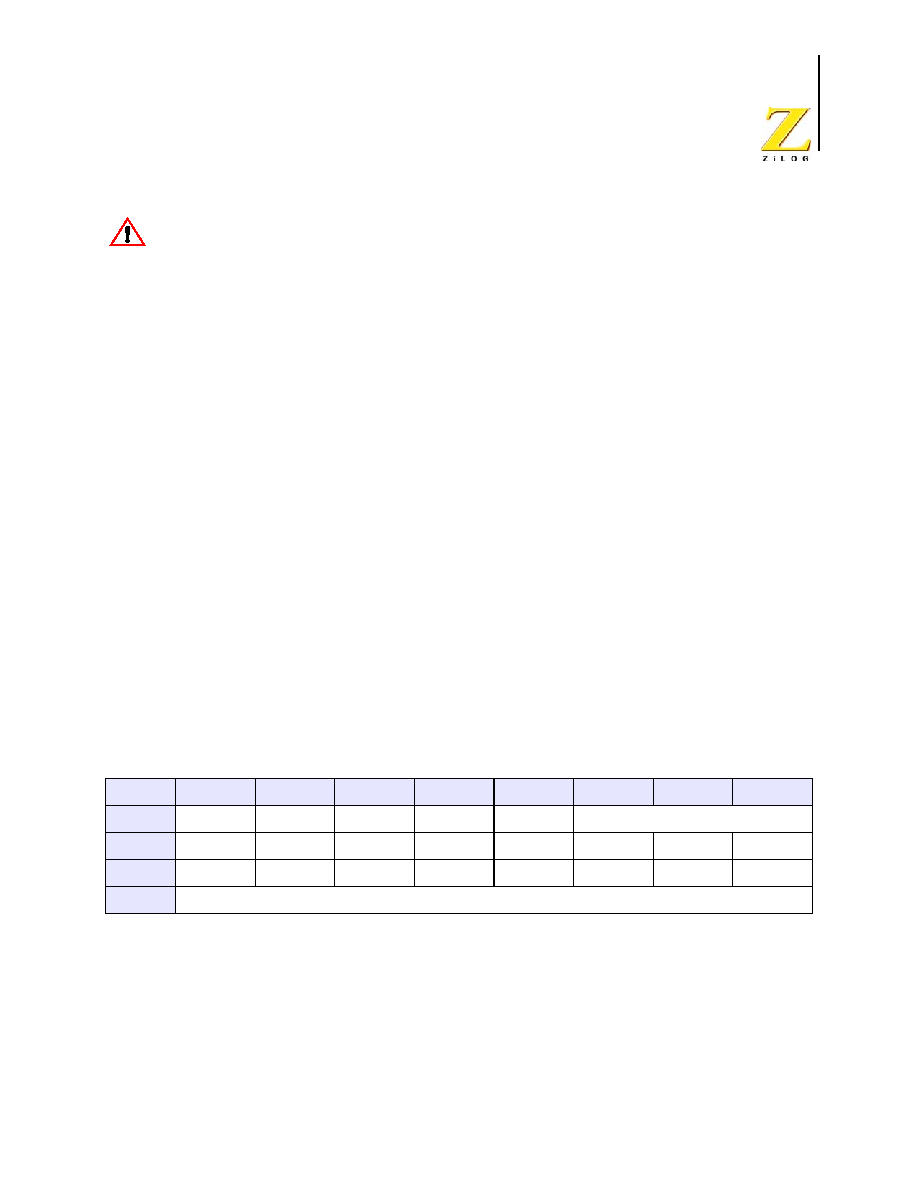
PS024302-0904
P R E L I M I N A R Y Oscillator
Control
Z8 Encore!
Æ
4K Series
Product Specification
144
Unintentional accesses to the oscillator control register can actually stop the chip by
switching to a non-functioning oscillator. To prevent this condition, the oscillator con-
trol block employs a register unlocking/locking scheme.
OSC Control Register Unlocking/Locking
To write the oscillator control register, unlock it by making two writes to the OSCCTL
register with the values
E7H
followed by
18H
. A third write to the OSCCTL register
changes the value of the actual register and returns the register to a locked state. Any other
sequence of oscillator control register writes has no effect. The values written to unlock
the register must be ordered correctly, but are not necessarily consecutive. It is possible to
write to or read from other registers within the unlocking/locking operation.
The internal precision oscillator is enabled by default. If the user code changes to a differ-
ent oscillator, it may be appropriate to disable the IPO for power savings. Disabling the
IPO does not occur automatically.
Oscillator Control Register Definitions
Oscillator Control Register
The Oscillator Control Register (OSCCTL) enables/disables the various oscillator circuits
and selects the primary oscillator, which becomes the system clock.
The Oscillator Control Register must be unlocked before writing. Writing the two step
sequence
E7H
followed by
18H
to the Oscillator Control Register unlocks it. The register
is locked at successful completion of a register write to the OSCCTL.
INTEN--Internal Precision Oscillator Enable
1 = Internal precision oscillator is enabled
0 = Internal precision oscillator is disabled
WDTEN--Watchdog Timer Oscillator Enable
1 = Watch-Dog Timer oscillator is enabled
0 = Watch-Dog Timer oscillator is disabled
Table 89. Oscillator Control Register (OSCCTL)
BITS
7
6
5
4
3
2
1
0
FIELD
INTEN
Reserved
WDTEN
Reserved Reserved
SCKSEL
RESET
1
0
1
0
0
0
0
0
R/W
R/W
R/W
R/W
R/W
R/W
R/W
R/W
R/W
ADDR
F86H
Caution:

PS024302-0904
P R E L I M I N A R Y Oscillator
Control
Z8 Encore!
Æ
4K Series
Product Specification
145
SCKSEL--System Clock Oscillator Select
000 = Internal precision oscillator functions as system clock at 5.53MHz
001 = Internal precision oscillator functions as system clock at 32KHz
010 = Reserved - Must be 0
011 = Watch-Dog Timer oscillator functions as system
100 = External clock signal on PB3 functions as system clock
101 = Reserved - Must be 0
110 = Reserved - Must be 0
111 = Reserved - Must be 0
It is possible to disable all functioning clock sources. In this event the 4K Series device
ceases functioning and can only be recovered by a Power-On Reset.
Caution:

PS024302-0904
P R E L I M I N A R Y Internal
Precision
Oscillator
Z8 Encore!
Æ
4K Series
Product Specification
146
Internal Precision Oscillator
Overview
The Internal Precision Oscillator (IPO) is designed for use without external components.
The user can either manually trim the oscillator for a non-standard frequency or use the
automatic factory-trimmed version to achieve a 5.53MHz frequency with ±4% accuracy
over the operating temperature and supply voltage range of the device. IPO features
include:
∑
On-chip RC oscillator that does not require external components
∑
Output frequency of either 5.53MHz or 32.8KHz (contains both a fast and a slow mode)
∑
Trimming possible through Flash option bits with user override
Operation
The internal oscillator is an RC relaxation oscillator that has had its sensitivity to power
supply variation minimized. By using ratio tracking thresholds, the effect of power supply
voltage is cancelled out. The dominant source of oscillator error is the absolute variance of
chip level fabricated components, such as capacitors. An 8-bit trimming register, incorpo-
rated into the design, compensates for absolute variation of oscillator frequency. Once
trimmed the oscillator frequency is relatively stable and does not require subsequent cali-
bration. Trimming was performed during manufacturing and is not necessary for the user
to repeat unless a frequency other than 5.53MHz (fast mode) or 32.8kHz (slow mode) is
required.
Power down this block for minimum system power.
By default, the oscillator is configured through the Flash Option bits. However, the user
code can override these trim values as described in
"Trim Bit Address Space" on page 129
.
Select one of two frequencies for the oscillator: 5.53MHz and 32.8KHz, using the OSC-
SEL bits in the "Oscillator Control" on page 143.

PS024302-0904
P R E L I M I N A R Y
eZ8 CPU Instruction Set
Z8 Encore!
Æ
4K Series
Product Specification
147
eZ8 CPU Instruction Set
Assembly Language Programming Introduction
The eZ8 CPU assembly language provides a means for writing an application program
without concern for actual memory addresses or machine instruction formats. A program
written in assembly language is called a source program. Assembly language allows the
use of symbolic addresses to identify memory locations. It also allows mnemonic codes
(opcodes and operands) to represent the instructions themselves. The opcodes identify the
instruction while the operands represent memory locations, registers, or immediate data
values.
Each assembly language program consists of a series of symbolic commands called state-
ments. Each statement can contain labels, operations, operands and comments.
Labels can be assigned to a particular instruction step in a source program. The label iden-
tifies that step in the program as an entry point for use by other instructions.
The assembly language also includes assembler directives that supplement the machine
instruction. The assembler directives, or pseudo-ops, are not translated into a machine
instruction. Rather, the pseudo-ops are interpreted as directives that control or assist the
assembly process.
The source program is processed (assembled) by the assembler to obtain a machine lan-
guage program called the object code. The object code is executed by the eZ8 CPU. An
example segment of an assembly language program is detailed in the following example.
Assembly Language Source Program Example
JP START
; Everything after the semicolon is a comment.
START:
; A label called "START". The first instruction (
JP START
) in this
; example causes program execution to jump to the point within the
; program where the
START
label occurs.
LD R4, R7
; A Load (LD) instruction with two operands. The first operand,
; Working Register R4, is the destination. The second operand,
; Working Register R7, is the source. The contents of R7 is
; written into R4.
LD 234H, #%01
; Another Load (LD) instruction with two operands.
; The first operand, Extended Mode Register Address
234H
,
; identifies the destination. The second operand, Immediate Data
; value
01H
, is the source. The value
01H
is written into the
; Register at address
234H
.

PS024302-0904
P R E L I M I N A R Y
eZ8 CPU Instruction Set
Z8 Encore!
Æ
4K Series
Product Specification
148
Assembly Language Syntax
For proper instruction execution, eZ8 CPU assembly language syntax requires that the
operands be written as `destination, source'. After assembly, the object code usually has
the operands in the order 'source, destination', but ordering is opcode-dependent. The fol-
lowing instruction examples illustrate the format of some basic assembly instructions and
the resulting object code produced by the assembler. This binary format must be followed
by users that prefer manual program coding or intend to implement their own assembler.
Example 1: If the contents of Registers 43H and 08H are added and the result is stored in
43H, the assembly syntax and resulting object code is:
Example 2: In general, when an instruction format requires an 8-bit register address, that
address can specify any register location in the range 0≠255 or, using Escaped Mode
Addressing, a Working Register R0≠R15. If the contents of Register 43H and Working
Register R8 are added and the result is stored in 43H, the assembly syntax and resulting
object code is:
See the device-specific Product Specification to determine the exact register file range
available. The register file size varies, depending on the device type.
eZ8 CPU Instruction Notation
In the eZ8 CPU Instruction Summary and Description sections, the operands, condition
codes, status flags, and address modes are represented by a notational shorthand that is
described in Table 92
Table 90. Assembly Language Syntax Example 1
Assembly Language Code ADD
43H,
08H
(ADD dst, src)
Object Code
04
08
43
(OPC src, dst)
Table 91. Assembly Language Syntax Example 2
Assembly Language Code ADD
43H,
R8
(ADD dst, src)
Object Code
04
E8
43
(OPC src, dst)

PS024302-0904
P R E L I M I N A R Y
eZ8 CPU Instruction Set
Z8 Encore!
Æ
4K Series
Product Specification
149
.
Table 93 contains additional symbols that are used throughout the Instruction Summary
and Instruction Set Description sections.
Table 92. Notational Shorthand
Notation Description
Operand Range
b
Bit
b
b represents a value from 0 to 7 (000B to 111B).
cc
Condition Code
--
See Condition Codes overview in the eZ8 CPU
User Manual.
DA
Direct Address
Addrs
Addrs. represents a number in the range of
0000H to FFFFH
ER
Extended Addressing Register
Reg
Reg. represents a number in the range of 000H to
FFFH
IM
Immediate Data
#Data
Data is a number between 00H to FFH
Ir
Indirect Working Register
@Rn
n = 0 ≠15
IR
Indirect Register
@Reg
Reg. represents a number in the range of 00H to
FFH
Irr
Indirect Working Register Pair
@RRp
p = 0, 2, 4, 6, 8, 10, 12, or 14
IRR
Indirect Register Pair
@Reg
Reg. represents an even number in the range
00H to FEH
p
Polarity
p
Polarity is a single bit binary value of either 0B or
1B.
r
Working Register
Rn
n = 0 ≠ 15
R
Register
Reg
Reg. represents a number in the range of 00H to
FFH
RA
Relative Address
X
X represents an index in the range of +127 to ≠
128 which is an offset relative to the address of
the next instruction
rr
Working Register Pair
RRp
p = 0, 2, 4, 6, 8, 10, 12, or 14
RR
Register Pair
Reg
Reg. represents an even number in the range of
00H to FEH
Vector
Vector Address
Vector
Vector represents a number in the range of 00H
to FFH
X
Indexed
#Index
The register or register pair to be indexed is offset
by the signed Index value (#Index) in a +127 to
-128 range.

PS024302-0904
P R E L I M I N A R Y
eZ8 CPU Instruction Set
Z8 Encore!
Æ
4K Series
Product Specification
150
Assignment of a value is indicated by an arrow. For example,
dst
dst + src
indicates the source data is added to the destination data and the result is stored in the des-
tination location.
eZ8 CPU Instruction Classes
eZ8 CPU instructions can be divided functionally into the following groups:
∑
Arithmetic
∑
Bit Manipulation
∑
Block Transfer
∑
CPU Control
∑
Load
∑
Logical
∑
Program Control
∑
Rotate and Shift
Table 93. Additional Symbols
Symbol
Definition
dst
Destination Operand
src
Source Operand
@
Indirect Address Prefix
SP
Stack Pointer
PC
Program Counter
FLAGS
Flags Register
RP
Register Pointer
#
Immediate Operand Prefix
B
Binary Number Suffix
%
Hexadecimal Number
Prefix
H
Hexadecimal Number
Suffix

PS024302-0904
P R E L I M I N A R Y
eZ8 CPU Instruction Set
Z8 Encore!
Æ
4K Series
Product Specification
151
Tables 94 through 101 contain the instructions belonging to each group and the number of
operands required for each instruction. Some instructions appear in more than one table as
these instruction can be considered as a subset of more than one category. Within these
tables, the source operand is identified as 'src', the destination operand is 'dst' and a con-
dition code is 'cc'.
Table 94. Arithmetic Instructions
Mnemonic
Operands
Instruction
ADC
dst, src
Add with Carry
ADCX
dst, src
Add with Carry using Extended Addressing
ADD
dst, src
Add
ADDX
dst, src
Add using Extended Addressing
CP
dst, src
Compare
CPC
dst, src
Compare with Carry
CPCX
dst, src
Compare with Carry using Extended Addressing
CPX
dst, src
Compare using Extended Addressing
DA
dst
Decimal Adjust
DEC
dst
Decrement
DECW
dst
Decrement Word
INC
dst
Increment
INCW
dst
Increment Word
MULT
dst
Multiply
SBC
dst, src
Subtract with Carry
SBCX
dst, src
Subtract with Carry using Extended Addressing
SUB
dst, src
Subtract
SUBX
dst, src
Subtract using Extended Addressing

PS024302-0904
P R E L I M I N A R Y
eZ8 CPU Instruction Set
Z8 Encore!
Æ
4K Series
Product Specification
152
Table 95. Bit Manipulation Instructions
Mnemonic
Operands Instruction
BCLR
bit, dst
Bit Clear
BIT
p, bit, dst
Bit Set or Clear
BSET
bit, dst
Bit Set
BSWAP
dst
Bit Swap
CCF
--
Complement Carry Flag
RCF
--
Reset Carry Flag
SCF
--
Set Carry Flag
TCM
dst, src
Test Complement Under Mask
TCMX
dst, src
Test Complement Under Mask using Extended Addressing
TM
dst, src
Test Under Mask
TMX
dst, src
Test Under Mask using Extended Addressing
Table 96. Block Transfer Instructions
Mnemonic Operands
Instruction
LDCI
dst, src
Load Constant to/from Program Memory and Auto-Increment Addresses
LDEI
dst, src
Load External Data to/from Data Memory and Auto-Increment Addresses
Table 97. CPU Control Instructions
Mnemonic
Operands
Instruction
CCF
--
Complement Carry Flag
DI
--
Disable Interrupts
EI
--
Enable Interrupts
HALT
--
Halt Mode
NOP
--
No Operation
RCF
--
Reset Carry Flag
SCF
--
Set Carry Flag
SRP
src
Set Register Pointer

PS024302-0904
P R E L I M I N A R Y
eZ8 CPU Instruction Set
Z8 Encore!
Æ
4K Series
Product Specification
153
STOP
--
STOP Mode
WDT
--
Watch-Dog Timer Refresh
Table 98. Load Instructions
Mnemonic Operands Instruction
CLR
dst
Clear
LD
dst, src
Load
LDC
dst, src
Load Constant to/from Program Memory
LDCI
dst, src
Load Constant to/from Program Memory and Auto-Increment
Addresses
LDE
dst, src
Load External Data to/from Data Memory
LDEI
dst, src
Load External Data to/from Data Memory and Auto-Increment
Addresses
LDX
dst, src
Load using Extended Addressing
LEA
dst, X(src) Load Effective Address
POP
dst
Pop
POPX
dst
Pop using Extended Addressing
PUSH
src
Push
PUSHX
src
Push using Extended Addressing
Table 99. Logical Instructions
Mnemonic Operands Instruction
AND
dst, src
Logical AND
ANDX
dst, src
Logical AND using Extended Addressing
COM
dst
Complement
OR
dst, src
Logical OR
ORX
dst, src
Logical OR using Extended Addressing
XOR
dst, src
Logical Exclusive OR
XORX
dst, src
Logical Exclusive OR using Extended Addressing
Table 97. CPU Control Instructions
Mnemonic
Operands
Instruction

PS024302-0904
P R E L I M I N A R Y
eZ8 CPU Instruction Set
Z8 Encore!
Æ
4K Series
Product Specification
154
Table 100. Program Control Instructions
Mnemonic
Operands
Instruction
BRK
--
On-Chip Debugger Break
BTJ
p, bit, src, DA Bit Test and Jump
BTJNZ
bit, src, DA
Bit Test and Jump if Non-Zero
BTJZ
bit, src, DA
Bit Test and Jump if Zero
CALL
dst
Call Procedure
DJNZ
dst, src, RA
Decrement and Jump Non-Zero
IRET
--
Interrupt Return
JP
dst
Jump
JP cc
dst
Jump Conditional
JR
DA
Jump Relative
JR cc
DA
Jump Relative Conditional
RET
--
Return
TRAP
vector
Software Trap
Table 101. Rotate and Shift Instructions
Mnemonic
Operands
Instruction
BSWAP
dst
Bit Swap
RL
dst
Rotate Left
RLC
dst
Rotate Left through Carry
RR
dst
Rotate Right
RRC
dst
Rotate Right through Carry
SRA
dst
Shift Right Arithmetic
SRL
dst
Shift Right Logical
SWAP
dst
Swap Nibbles

PS024302-0904
P R E L I M I N A R Y
eZ8 CPU Instruction Set
Z8 Encore!
Æ
4K Series
Product Specification
155
eZ8 CPU Instruction Summary
Table 102 summarizes the eZ8 CPU instructions. The table identifies the addressing
modes employed by the instruction, the effect upon the Flags register, the number of CPU
clock cycles required for the instruction fetch, and the number of CPU clock cycles
required for the instruction execution.
.
Table 102. eZ8 CPU Instruction Summary
Assembly
Mnemonic
Symbolic Operation
Address Mode
Opcode(s)
(Hex)
Flags
Fetch
Cycles
Instr.
Cycles
dst
src
C Z S V D
H
ADC dst, src
dst
dst + src + C
r
r
12
*
*
*
*
0
*
2
3
r
Ir
13
2
4
R
R
14
3
3
R
IR
15
3
4
R
IM
16
3
3
IR
IM
17
3
4
ADCX dst, src
dst
dst + src + C
ER
ER
18
*
*
*
*
0
*
4
3
ER
IM
19
4
3
ADD dst, src
dst
dst + src
r
r
02
*
*
*
*
0
*
2
3
r
Ir
03
2
4
R
R
04
3
3
R
IR
05
3
4
R
IM
06
3
3
IR
IM
07
3
4
ADDX dst, src
dst
dst + src
ER
ER
08
*
*
*
*
0
*
4
3
ER
IM
09
4
3
AND dst, src
dst
dst AND src
r
r
52
≠
*
*
0
≠
≠
2
3
r
Ir
53
2
4
R
R
54
3
3
R
IR
55
3
4
R
IM
56
3
3
IR
IM
57
3
4
Flags Notation:
* = Value is a function of the result of the operation.
≠ = Unaffected
X = Undefined
0 = Reset to 0
1 = Set to 1

PS024302-0904
P R E L I M I N A R Y
eZ8 CPU Instruction Set
Z8 Encore!
Æ
4K Series
Product Specification
156
ANDX dst, src
dst
dst AND src
ER
ER
58
≠
*
*
0
≠
≠
4
3
ER
IM
59
4
3
BCLR bit, dst
dst[bit]
0
r
E2
≠
*
*
0
≠
≠
2
2
BIT p, bit, dst
dst[bit]
p
r
E2
≠
*
*
0
≠
≠
2
2
BRK
Debugger Break
00
≠
≠
≠
≠
≠
≠
1
1
BSET bit, dst
dst[bit]
1
r
E2
≠
*
*
0
≠
≠
2
2
BSWAP dst
dst[7:0]
dst[0:7]
R
D5
X
*
*
0
≠
≠
2
2
BTJ p, bit, src, dst if src[bit] = p
PC
PC + X
r
F6
≠
≠
≠
≠
≠
≠
3
3
Ir
F7
3
4
BTJNZ bit, src, dst if src[bit] = 1
PC
PC + X
r
F6
≠
≠
≠
≠
≠
≠
3
3
Ir
F7
3
4
BTJZ bit, src, dst
if src[bit] = 0
PC
PC + X
r
F6
≠
≠
≠
≠
≠
≠
3
3
Ir
F7
3
4
CALL dst
SP
SP -2
@SP
PC
PC
dst
IRR
D4
≠
≠
≠
≠
≠
≠
2
6
DA
D6
3
3
CCF
C
~C
EF
*
≠
≠
≠
≠
≠-
1
2
CLR dst
dst
00H
R
B0
≠
≠
≠
≠
≠
≠
2
2
IR
B1
2
3
COM dst
dst
~dst
R
60
≠
*
*
0
≠
≠
2
2
IR
61
2
3
CP dst, src
dst - src
r
r
A2
*
*
*
*
≠
≠
2
3
r
Ir
A3
2
4
R
R
A4
3
3
R
IR
A5
3
4
R
IM
A6
3
3
IR
IM
A7
3
4
Table 102. eZ8 CPU Instruction Summary (Continued)
Assembly
Mnemonic
Symbolic Operation
Address Mode
Opcode(s)
(Hex)
Flags
Fetch
Cycles
Instr.
Cycles
dst
src
C Z S V D
H
Flags Notation:
* = Value is a function of the result of the operation.
≠ = Unaffected
X = Undefined
0 = Reset to 0
1 = Set to 1

PS024302-0904
P R E L I M I N A R Y
eZ8 CPU Instruction Set
Z8 Encore!
Æ
4K Series
Product Specification
157
CPC dst, src
dst - src - C
r
r
1F A2
*
*
*
*
≠
≠
3
3
r
Ir
1F A3
3
4
R
R
1F A4
4
3
R
IR
1F A5
4
4
R
IM
1F A6
4
3
IR
IM
1F A7
4
4
CPCX dst, src
dst - src - C
ER
ER
1F A8
*
*
*
*
≠
≠
5
3
ER
IM
1F A9
5
3
CPX dst, src
dst - src
ER
ER
A8
*
*
*
*
≠
≠
4
3
ER
IM
A9
4
3
DA dst
dst
DA(dst)
R
40
*
*
*
X
≠
≠
2
2
IR
41
2
3
DEC dst
dst
dst - 1
R
30
≠
*
*
*
≠
≠
2
2
IR
31
2
3
DECW dst
dst
dst - 1
RR
80
≠
*
*
*
≠
≠
2
5
IRR
81
2
6
DI
IRQCTL[7]
0
8F
≠
≠
≠
≠
≠
≠
1
2
DJNZ dst, RA
dst
dst ≠ 1
if dst
0
PC
PC + X
r
0A-FA
≠
≠
≠
≠
≠
≠
2
3
EI
IRQCTL[7]
1
9F
≠
≠
≠
≠
≠
≠
1
2
HALT
Halt Mode
7F
≠
≠
≠
≠
≠
≠
1
2
INC dst
dst
dst + 1
R
20
≠
*
*
≠
≠
≠
2
2
IR
21
2
3
r
0E-FE
1
2
INCW dst
dst
dst + 1
RR
A0
≠
*
*
*
≠
≠
2
5
IRR
A1
2
6
Table 102. eZ8 CPU Instruction Summary (Continued)
Assembly
Mnemonic
Symbolic Operation
Address Mode
Opcode(s)
(Hex)
Flags
Fetch
Cycles
Instr.
Cycles
dst
src
C Z S V D
H
Flags Notation:
* = Value is a function of the result of the operation.
≠ = Unaffected
X = Undefined
0 = Reset to 0
1 = Set to 1

PS024302-0904
P R E L I M I N A R Y
eZ8 CPU Instruction Set
Z8 Encore!
Æ
4K Series
Product Specification
158
IRET
FLAGS
@SP
SP
SP + 1
PC
@SP
SP
SP + 2
IRQCTL[7]
1
BF
*
*
*
*
*
*
1
5
JP dst
PC
dst
DA
8D
≠
≠
≠
≠
≠
≠
3
2
IRR
C4
2
3
JP cc, dst
if cc is true
PC
dst
DA
0D-FD
≠
≠
≠
≠
≠
≠
3
2
JR dst
PC
PC + X
DA
8B
≠
≠
≠
≠
≠
≠
2
2
JR cc, dst
if cc is true
PC
PC + X
DA
0B-FB
≠
≠
≠
≠
≠
≠
2
2
LD dst, rc
dst
src
r
IM
0C-FC
≠
≠
≠
≠
≠
≠
2
2
r
X(r)
C7
3
3
X(r)
r
D7
3
4
r
Ir
E3
2
3
R
R
E4
3
2
R
IR
E5
3
4
R
IM
E6
3
2
IR
IM
E7
3
3
Ir
r
F3
2
3
IR
R
F5
3
3
LDC dst, src
dst
src
r
Irr
C2
≠
≠
≠
≠
≠
≠
2
5
Ir
Irr
C5
2
9
Irr
r
D2
2
5
LDCI dst, src
dst
src
r
r + 1
rr
rr + 1
Ir
Irr
C3
≠
≠
≠
≠
≠
≠
2
9
Irr
Ir
D3
2
9
LDE dst, src
dst
src
r
Irr
82
≠
≠
≠
≠
≠
≠
2
5
Irr
r
92
2
5
Table 102. eZ8 CPU Instruction Summary (Continued)
Assembly
Mnemonic
Symbolic Operation
Address Mode
Opcode(s)
(Hex)
Flags
Fetch
Cycles
Instr.
Cycles
dst
src
C Z S V D
H
Flags Notation:
* = Value is a function of the result of the operation.
≠ = Unaffected
X = Undefined
0 = Reset to 0
1 = Set to 1

PS024302-0904
P R E L I M I N A R Y
eZ8 CPU Instruction Set
Z8 Encore!
Æ
4K Series
Product Specification
159
LDEI dst, src
dst
src
r
r + 1
rr
rr + 1
Ir
Irr
83
≠
≠
≠
≠
≠
≠
2
9
Irr
Ir
93
2
9
LDX dst, src
dst
src
r
ER
84
≠
≠
≠
≠
≠
≠
3
2
Ir
ER
85
3
3
R
IRR
86
3
4
IR
IRR
87
3
5
r
X(rr)
88
3
4
X(rr)
r
89
3
4
ER
r
94
3
2
ER
Ir
95
3
3
IRR
R
96
3
4
IRR
IR
97
3
5
ER
ER
E8
4
2
ER
IM
E9
4
2
LEA dst, X(src)
dst
src + X
r
X(r)
98
≠
≠
≠
≠
≠
≠
3
3
rr
X(rr)
99
3
5
MULT dst
dst[15:0]
dst[15:8] * dst[7:0]
RR
F4
≠
≠
≠
≠
≠
≠
2
8
NOP
No operation
0F
≠
≠
≠
≠
≠
≠
1
2
OR dst, src
dst
dst OR src
r
r
42
≠
*
*
0
≠
≠
2
3
r
Ir
43
2
4
R
R
44
3
3
R
IR
45
3
4
R
IM
46
3
3
IR
IM
47
3
4
ORX dst, src
dst
dst OR src
ER
ER
48
≠
*
*
0
≠
≠
4
3
ER
IM
49
4
3
Table 102. eZ8 CPU Instruction Summary (Continued)
Assembly
Mnemonic
Symbolic Operation
Address Mode
Opcode(s)
(Hex)
Flags
Fetch
Cycles
Instr.
Cycles
dst
src
C Z S V D
H
Flags Notation:
* = Value is a function of the result of the operation.
≠ = Unaffected
X = Undefined
0 = Reset to 0
1 = Set to 1
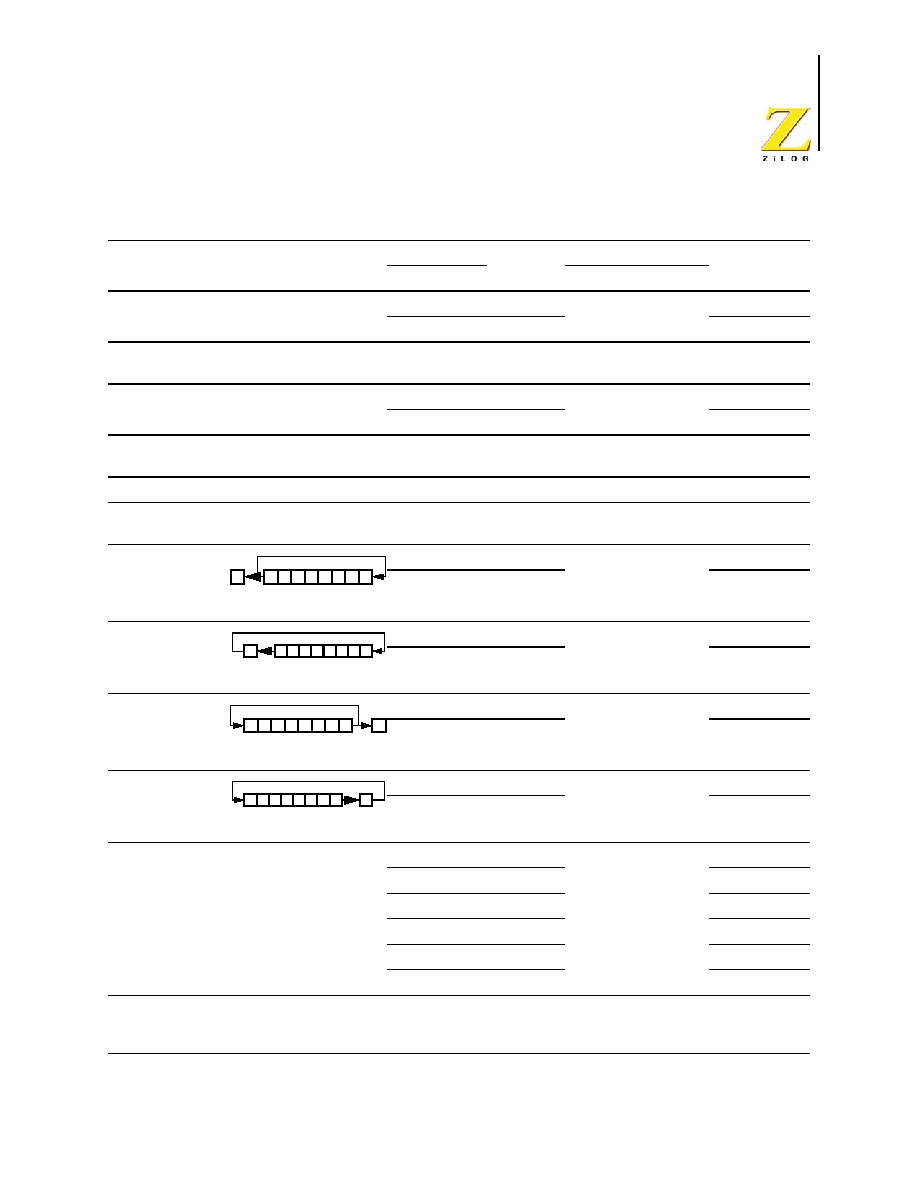
PS024302-0904
P R E L I M I N A R Y
eZ8 CPU Instruction Set
Z8 Encore!
Æ
4K Series
Product Specification
160
POP dst
dst
@SP
SP
SP + 1
R
50
≠
≠
≠
≠
≠
≠
2
2
IR
51
2
3
POPX dst
dst
@SP
SP
SP + 1
ER
D8
≠
≠
≠
≠
≠
≠
3
2
PUSH src
SP
SP ≠ 1
@SP
src
R
70
≠
≠
≠
≠
≠
≠
2
2
IR
71
2
3
PUSHX src
SP
SP ≠ 1
@SP
src
ER
C8
≠
≠
≠
≠
≠
≠
3
2
RCF
C
0
CF
0
≠
≠
≠
≠
≠
1
2
RET
PC
@SP
SP
SP + 2
AF
≠
≠
≠
≠
≠
≠
1
4
RL dst
R
90
*
*
*
*
≠
≠
2
2
IR
91
2
3
RLC dst
R
10
*
*
*
*
≠
≠
2
2
IR
11
2
3
RR dst
R
E0
*
*
*
*
≠
≠
2
2
IR
E1
2
3
RRC dst
R
C0
*
*
*
*
≠
≠
2
2
IR
C1
2
3
SBC dst, src
dst
dst ≠ src - C
r
r
32
*
*
*
*
1
*
2
3
r
Ir
33
2
4
R
R
34
3
3
R
IR
35
3
4
R
IM
36
3
3
IR
IM
37
3
4
Table 102. eZ8 CPU Instruction Summary (Continued)
Assembly
Mnemonic
Symbolic Operation
Address Mode
Opcode(s)
(Hex)
Flags
Fetch
Cycles
Instr.
Cycles
dst
src
C Z S V D
H
Flags Notation:
* = Value is a function of the result of the operation.
≠ = Unaffected
X = Undefined
0 = Reset to 0
1 = Set to 1
D7 D6 D5 D4 D3 D2 D1 D0
dst
C
D7 D6 D5 D4 D3 D2 D1 D0
dst
C
D7 D6 D5 D4 D3 D2 D1 D0
dst
C
D7 D6 D5 D4 D3 D2 D1 D0
dst
C
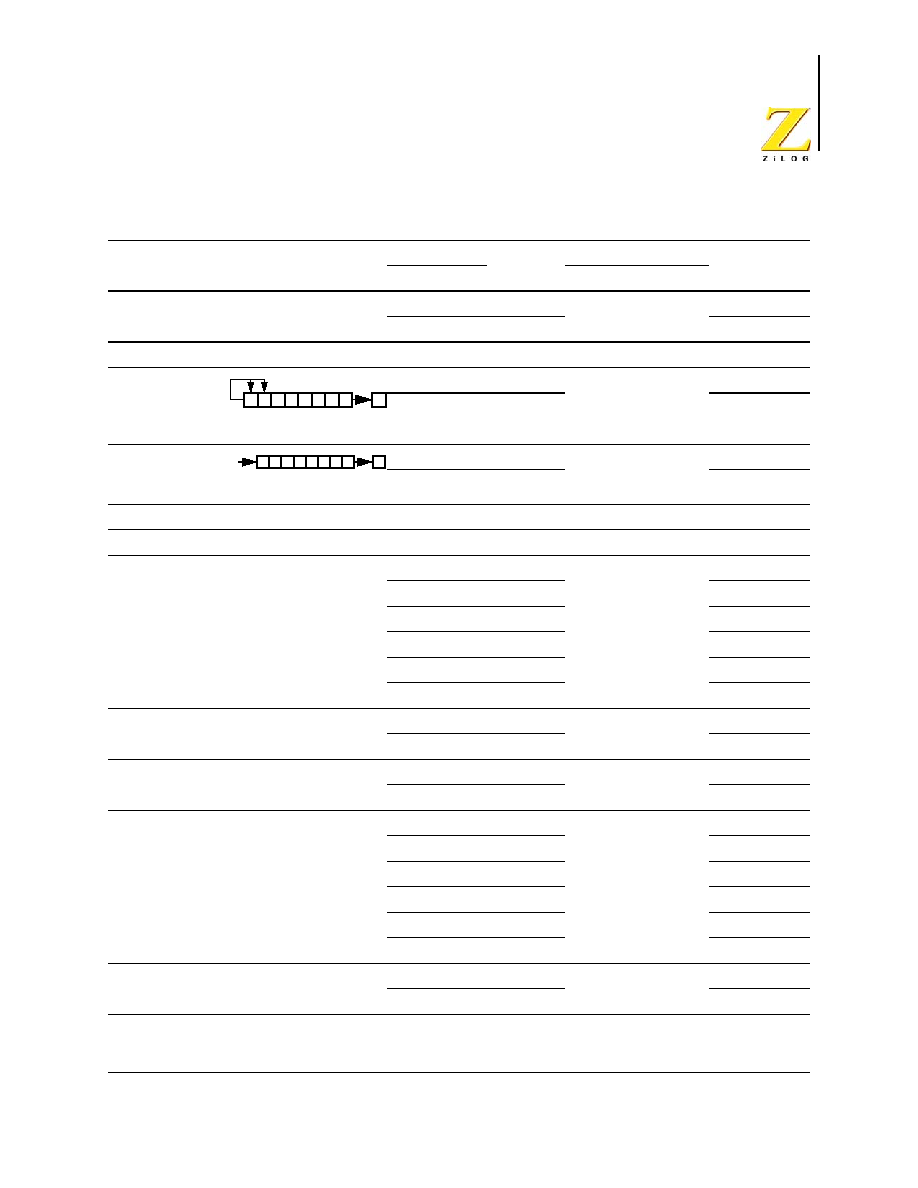
PS024302-0904
P R E L I M I N A R Y
eZ8 CPU Instruction Set
Z8 Encore!
Æ
4K Series
Product Specification
161
SBCX dst, src
dst
dst ≠ src - C
ER
ER
38
*
*
*
*
1
*
4
3
ER
IM
39
4
3
SCF
C
1
DF
1
≠
≠
≠
≠
≠
1
2
SRA dst
R
D0
*
*
*
0
≠
≠
2
2
IR
D1
2
3
SRL dst
R
1F C0
*
*
0
*
≠
≠
3
2
IR
1F C1
3
3
SRP src
RP
src
IM
01
≠
≠
≠
≠
≠
≠
2
2
STOP
STOP Mode
6F
≠
≠
≠
≠
≠
≠
1
2
SUB dst, src
dst
dst ≠ src
r
r
22
*
*
*
*
1
*
2
3
r
Ir
23
2
4
R
R
24
3
3
R
IR
25
3
4
R
IM
26
3
3
IR
IM
27
3
4
SUBX dst, src
dst
dst ≠ src
ER
ER
28
*
*
*
*
1
*
4
3
ER
IM
29
4
3
SWAP dst
dst[7:4]
dst[3:0]
R
F0
X
*
*
X
≠
≠
2
2
IR
F1
2
3
TCM dst, src
(NOT dst) AND src
r
r
62
≠
*
*
0
≠
≠
2
3
r
Ir
63
2
4
R
R
64
3
3
R
IR
65
3
4
R
IM
66
3
3
IR
IM
67
3
4
TCMX dst, src
(NOT dst) AND src
ER
ER
68
≠
*
*
0
≠
≠
4
3
ER
IM
69
4
3
Table 102. eZ8 CPU Instruction Summary (Continued)
Assembly
Mnemonic
Symbolic Operation
Address Mode
Opcode(s)
(Hex)
Flags
Fetch
Cycles
Instr.
Cycles
dst
src
C Z S V D
H
Flags Notation:
* = Value is a function of the result of the operation.
≠ = Unaffected
X = Undefined
0 = Reset to 0
1 = Set to 1
D7 D6 D5 D4 D3 D2 D1 D0
dst
C
D7 D6 D5 D4 D3 D2 D1 D0
dst
C
0

PS024302-0904
P R E L I M I N A R Y
eZ8 CPU Instruction Set
Z8 Encore!
Æ
4K Series
Product Specification
162
TM dst, src
dst AND src
r
r
72
≠
*
*
0
≠
≠
2
3
r
Ir
73
2
4
R
R
74
3
3
R
IR
75
3
4
R
IM
76
3
3
IR
IM
77
3
4
TMX dst, src
dst AND src
ER
ER
78
≠
*
*
0
≠
≠
4
3
ER
IM
79
4
3
TRAP Vector
SP
SP ≠ 2
@SP
PC
SP
SP ≠ 1
@SP
FLAGS
PC
@Vector
Vector
F2
≠
≠
≠
≠
≠
≠
2
6
WDT
5F
≠
≠
≠
≠
≠
≠
1
2
XOR dst, src
dst
dst XOR src
r
r
B2
≠
*
*
0
≠
≠
2
3
r
Ir
B3
2
4
R
R
B4
3
3
R
IR
B5
3
4
R
IM
B6
3
3
IR
IM
B7
3
4
XORX dst, src
dst
dst XOR src
ER
ER
B8
≠
*
*
0
≠
≠
4
3
ER
IM
B9
4
3
Table 102. eZ8 CPU Instruction Summary (Continued)
Assembly
Mnemonic
Symbolic Operation
Address Mode
Opcode(s)
(Hex)
Flags
Fetch
Cycles
Instr.
Cycles
dst
src
C Z S V D
H
Flags Notation:
* = Value is a function of the result of the operation.
≠ = Unaffected
X = Undefined
0 = Reset to 0
1 = Set to 1
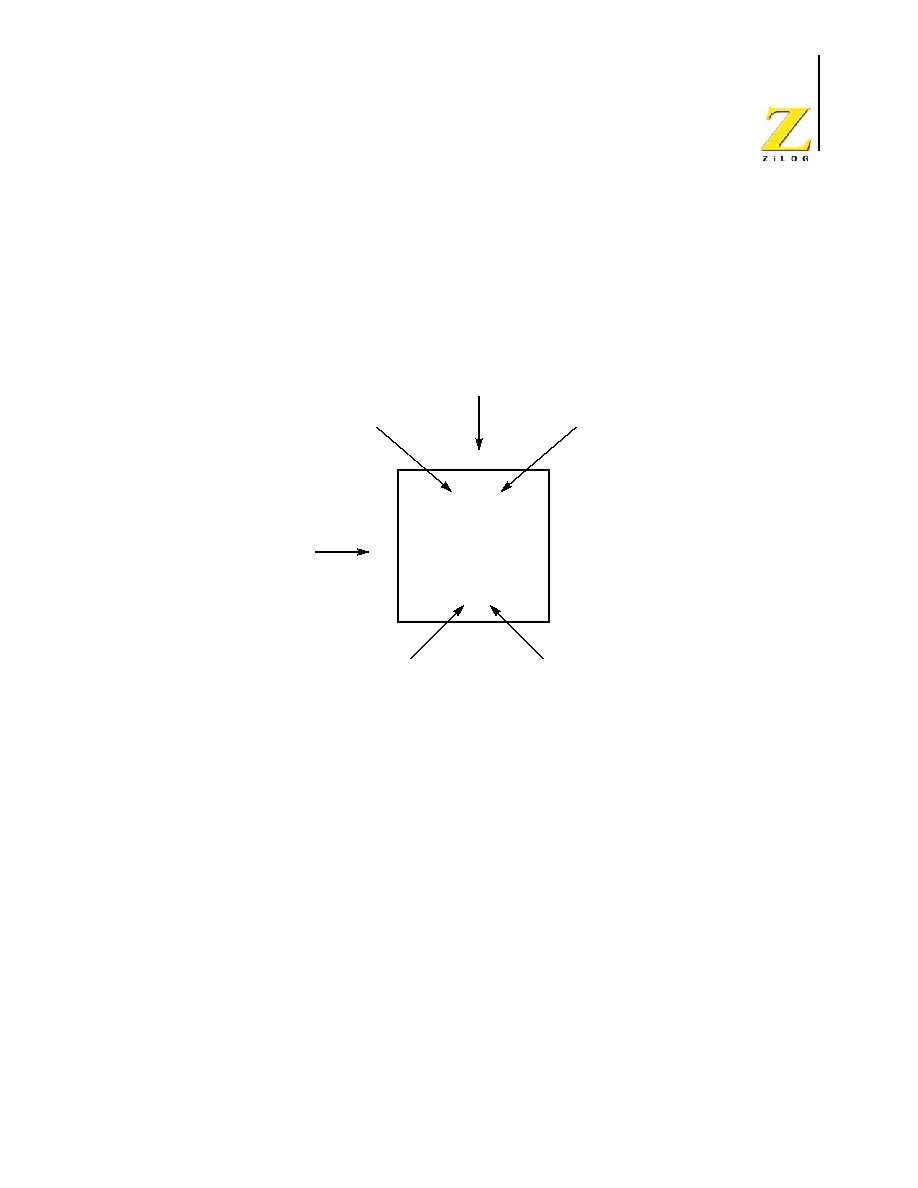
PS024302-0904
P R E L I M I N A R Y Opcode
Maps
Z8 Encore!
Æ
4K Series
Product Specification
163
Opcode Maps
A description of the opcode map data and the abbreviations are provided in Figure 26.
Figures 27 and 32 provide information about each of the eZ8 CPU instructions. Table 103
lists Opcode Map abbreviations.
Figure 26.Opcode Map Cell Description
CP
3.3
R2,R1
A
4
Opcode
Lower Nibble
Second Operand
After Assembly
First Operand
After Assembly
Opcode
Upper Nibble
Instruction Cycles
Fetch Cycles

PS024302-0904
P R E L I M I N A R Y Opcode
Maps
Z8 Encore!
Æ
4K Series
Product Specification
164
Table 103. Opcode Map Abbreviations
Abbreviation
Description
Abbreviation
Description
b
Bit position
IRR
Indirect Register Pair
cc
Condition code
p
Polarity (0 or 1)
X
8-bit signed index or
displacement
r
4-bit Working Register
DA
Destination address
R
8-bit register
ER
Extended Addressing register
r1, R1, Ir1, Irr1, IR1,
rr1, RR1, IRR1, ER1
Destination address
IM
Immediate data value
r2, R2, Ir2, Irr2, IR2,
rr2, RR2, IRR2, ER2
Source address
Ir
Indirect Working Register
RA
Relative
IR
Indirect register
rr
Working Register Pair
Irr
Indirect Working Register Pair RR
Register Pair
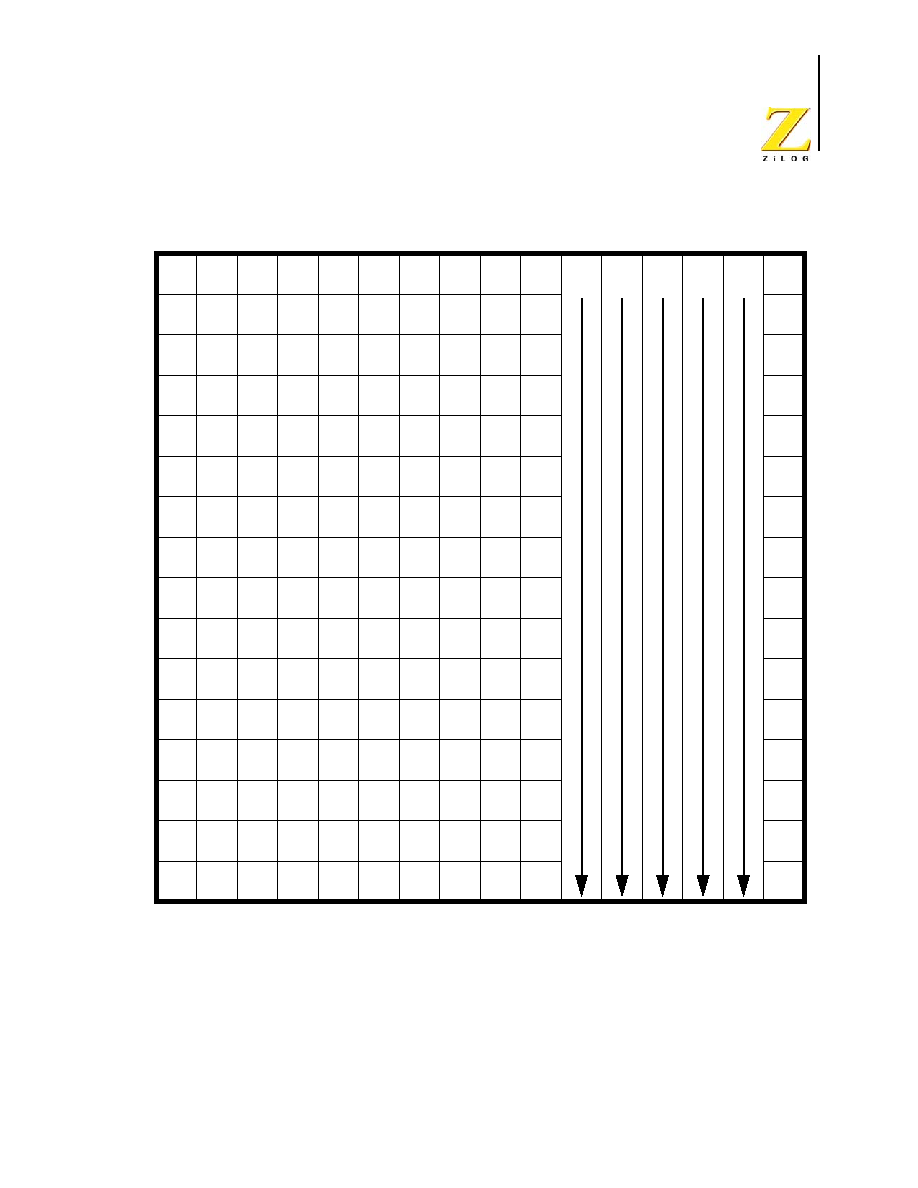
PS024302-0904
P R E L I M I N A R Y Opcode
Maps
Z8 Encore!
Æ
4K Series
Product Specification
165
Figure 27.First Opcode Map
CP
3.3
R2,R1
CP
3.4
IR2,R1
CP
2.3
r1,r2
CP
2.4
r1,Ir2
CPX
4.3
ER2,ER1
CPX
4.3
IM,ER1
CP
3.3
R1,IM
CP
3.4
IR1,IM
RRC
2.2
R1
RRC
2.3
IR1
0
1
2
3
4
5
6
7
8
9
A
B
C
D
E
F
0
1
2
3
4
5
6
7
8
9
A
B
C
D
E
F
Lower Nibble (Hex)
Up
per
Nibble (
H
ex
)
BRK
1.1
SRP
2.2
IM
ADD
2.3
r1,r2
ADD
2.4
r1,Ir2
ADD
3.3
R2,R1
ADD
3.4
IR2,R1
ADD
3.3
R1,IM
ADD
3.4
IR1,IM
ADDX
4.3
ER2,ER1
ADDX
4.3
IM,ER1
DJNZ
2.3
r1,X
JR
2.2
cc,X
LD
2.2
r1,IM
JP
3.2
cc,DA
INC
1.2
r1
NOP
1.2
RLC
2.2
R1
RLC
2.3
IR1
ADC
2.3
r1,r2
ADC
2.4
r1,Ir2
ADC
3.3
R2,R1
ADC
3.4
IR2,R1
ADC
3.3
R1,IM
ADC
3.4
IR1,IM
ADCX
4.3
ER2,ER1
ADCX
4.3
IM,ER1
INC
2.2
R1
INC
2.3
IR1
SUB
2.3
r1,r2
SUB
2.4
r1,Ir2
SUB
3.3
R2,R1
SUB
3.4
IR2,R1
SUB
3.3
R1,IM
SUB
3.4
IR1,IM
SUBX
4.3
ER2,ER1
SUBX
4.3
IM,ER1
DEC
2.2
R1
DEC
2.3
IR1
SBC
2.3
r1,r2
SBC
2.4
r1,Ir2
SBC
3.3
R2,R1
SBC
3.4
IR2,R1
SBC
3.3
R1,IM
SBC
3.4
IR1,IM
SBCX
4.3
ER2,ER1
SBCX
4.3
IM,ER1
DA
2.2
R1
DA
2.3
IR1
OR
2.3
r1,r2
OR
2.4
r1,Ir2
OR
3.3
R2,R1
OR
3.4
IR2,R1
OR
3.3
R1,IM
OR
3.4
IR1,IM
ORX
4.3
ER2,ER1
ORX
4.3
IM,ER1
POP
2.2
R1
POP
2.3
IR1
AND
2.3
r1,r2
AND
2.4
r1,Ir2
AND
3.3
R2,R1
AND
3.4
IR2,R1
AND
3.3
R1,IM
AND
3.4
IR1,IM
ANDX
4.3
ER2,ER1
ANDX
4.3
IM,ER1
COM
2.2
R1
COM
2.3
IR1
TCM
2.3
r1,r2
TCM
2.4
r1,Ir2
TCM
3.3
R2,R1
TCM
3.4
IR2,R1
TCM
3.3
R1,IM
TCM
3.4
IR1,IM
TCMX
4.3
ER2,ER1
TCMX
4.3
IM,ER1
PUSH
2.2
R2
PUSH
2.3
IR2
TM
2.3
r1,r2
TM
2.4
r1,Ir2
TM
3.3
R2,R1
TM
3.4
IR2,R1
TM
3.3
R1,IM
TM
3.4
IR1,IM
TMX
4.3
ER2,ER1
TMX
4.3
IM,ER1
DECW
2.5
RR1
DECW
2.6
IRR1
LDE
2.5
r1,Irr2
LDEI
2.9
Ir1,Irr2
LDX
3.2
r1,ER2
LDX
3.3
Ir1,ER2
LDX
3.4
IRR2,R1
LDX
3.5
IRR2,IR1
LDX
3.4
r1,rr2,X
LDX
3.4
rr1,r2,X
RL
2.2
R1
RL
2.3
IR1
LDE
2.5
r2,Irr1
LDEI
2.9
Ir2,Irr1
LDX
3.2
r2,ER1
LDX
3.3
Ir2,ER1
LDX
3.4
R2,IRR1
LDX
3.5
IR2,IRR1
LEA
3.3
r1,r2,X
LEA
3.5
rr1,rr2,X
INCW
2.5
RR1
INCW
2.6
IRR1
CLR
2.2
R1
CLR
2.3
IR1
XOR
2.3
r1,r2
XOR
2.4
r1,Ir2
XOR
3.3
R2,R1
XOR
3.4
IR2,R1
XOR
3.3
R1,IM
XOR
3.4
IR1,IM
XORX
4.3
ER2,ER1
XORX
4.3
IM,ER1
LDC
2.5
r1,Irr2
LDCI
2.9
Ir1,Irr2
LDC
2.5
r2,Irr1
LDCI
2.9
Ir2,Irr1
JP
2.3
IRR1
LDC
2.9
Ir1,Irr2
LD
3.4
r1,r2,X
PUSHX
3.2
ER2
SRA
2.2
R1
SRA
2.3
IR1
POPX
3.2
ER1
LD
3.4
r2,r1,X
CALL
2.6
IRR1
BSWAP
2.2
R1
CALL
3.3
DA
LD
3.2
R2,R1
LD
3.3
IR2,R1
BIT
2.2
p,b,r1
LD
2.3
r1,Ir2
LDX
4.2
ER2,ER1
LDX
4.2
IM,ER1
LD
3.2
R1,IM
LD
3.3
IR1,IM
RR
2.2
R1
RR
2.3
IR1
MULT
2.8
RR1
LD
3.3
R2,IR1
TRAP
2.6
Vector
LD
2.3
Ir1,r2
BTJ
3.3
p,b,r1,X
BTJ
3.4
p,b,Ir1,X
SWAP
2.2
R1
SWAP
2.3
IR1
RCF
1.2
WDT
1.2
STOP
1.2
HALT
1.2
DI
1.2
EI
1.2
RET
1.4
IRET
1.5
SCF
1.2
CCF
1.2
Opcode
See 2nd
Map

PS024302-0904
P R E L I M I N A R Y Opcode
Maps
Z8 Encore!
Æ
4K Series
Product Specification
166
Figure 28.Second Opcode Map after 1FH
CPC
4.3
R2,R1
CPC
4.4
IR2,R1
CPC
3.3
r1,r2
CPC
3.4
r1,Ir2
CPCX
5.3
ER2,ER1
CPCX
5.3
IM,ER1
CPC
4.3
R1,IM
CPC
4.4
IR1,IM
SRL
3.2
R1
SRL
3.3
IR1
0
1
2
3
4
5
6
7
8
9
A
B
C
D
E
F
0
1
2
3
4
5
6
7
8
9
A
B
C
D
E
F
Lower Nibble (Hex)
Upp
e
r Nib
b
le
(He
x
)

PS024302-0904
P R E L I M I N A R Y Electrical
Characteristics
Z8 Encore!
Æ
4K Series
Product Specification
167
Electrical Characteristics
The data in this chapter is pre-qualification and pre-characterization and is subject to
change. Additional electrical characteristics may be found in the individual chapters.
Absolute Maximum Ratings
Stresses greater than those listed in Table 104 may cause permanent damage to the device.
These ratings are stress ratings only. Operation of the device at any condition outside those
indicated in the operational sections of these specifications is not implied. Exposure to
absolute maximum rating conditions for extended periods may affect device reliability.
For improved reliability, tie unused inputs to one of the supply voltages (V
DD
or V
SS
).
Table 104. Absolute Maximum Ratings
Parameter
Minimum Maximum
Units
Notes
Ambient temperature under bias
0
+105
∞C
1
Storage temperature
-65
+150
∞C
Voltage on any pin with respect to V
SS
-0.3
+5.5
V
2
Voltage on V
DD
pin with respect to V
SS
-0.3
+3.6
V
Maximum current on input and/or inactive output pin
-5
+5
µA
Maximum output current from active output pin
-25
+25
mA
8-pin Packages Maximum Ratings at 0∞C to 70∞C
Total power dissipation
220
mW
Maximum current into V
DD
or out of V
SS
60
mA
20-pin Packages Maximum Ratings at 0∞C to 70∞C
Total power dissipation
430
mW
Maximum current into V
DD
or out of V
SS
120
mA
28-pin Packages Maximum Ratings at 0∞C to 70∞C
Total power dissipation
450
mW
Maximum current into V
DD
or out of V
SS
125
mA
Operating temperature is specified in DC Characteristics
1. This voltage applies to all pins except the following: V
DD
, AV
DD
, and pins supporting analog input (Port B[5:0],
Port C[2:0]). On the 8-pin packages, this applies to all pins but V
DD
.

PS024302-0904
P R E L I M I N A R Y Electrical
Characteristics
Z8 Encore!
Æ
4K Series
Product Specification
168
DC Characteristics
Table 105 lists the DC characteristics of the 4K Series products. All voltages are refer-
enced to V
SS
, the primary system ground.
Table 105. DC Characteristics
Symbol Parameter
T
A
= -40∞C to +105∞C
Units Conditions
Minimum Typical Maximum
V
DD
Supply Voltage
2.7
≠
3.6
V
V
IL1
Low Level Input Voltage
-0.3
≠
0.3*V
DD
V
For all input pins except RESET.
V
IL2
Low Level Input Voltage
-0.3
≠
0.8
V
For RESET.
V
IH1
High Level Input Voltage
2.0
≠
5.5
V
For all input pins without analog
or oscillator function. For all
signal pins on the 8-pin devices.
V
IH2
High Level Input Voltage
2.0
≠
V
DD
+0.3
V
For those pins with analog or
oscillator function.
V
OL1
Low Level Output
Voltage
≠
≠
0.4
V
I
OL
= 2mA; V
DD
= 3.0V
High Output Drive disabled.
V
OH1
High Level Output
Voltage
2.4
≠
≠
V
I
OH
= -2mA; V
DD
= 3.0V
High Output Drive disabled.
V
OL2
Low Level Output
Voltage
≠
≠
0.6
V
I
OL
= 20mA; V
DD
= 3.3V
High Output Drive enabled.
V
OH2
High Level Output
Voltage
2.4
≠
≠
V
I
OH
= -20mA; V
DD
= 3.3V
High Output Drive enabled.
I
IL
Input Leakage Current
-5
≠
+5
µ
A V
DD
= 3.6V;
V
IN
= V
DD
or VSS
1
I
TL
Tristate Leakage Current
-5
≠
+5
µ
A V
DD
= 3.6V
C
PAD
GPIO Port Pad
Capacitance
≠
8.0
2
≠
pF
TBD
C
XIN
XIN Pad Capacitance
≠
8.0
2
≠
pF
TBD
C
XOUT
XOUT Pad Capacitance
≠
9.5
2
≠
pF
TBD
I
PU
Weak Pull-up Current
30
100
350
µ
A V
DD
= 3.0 - 3.6V
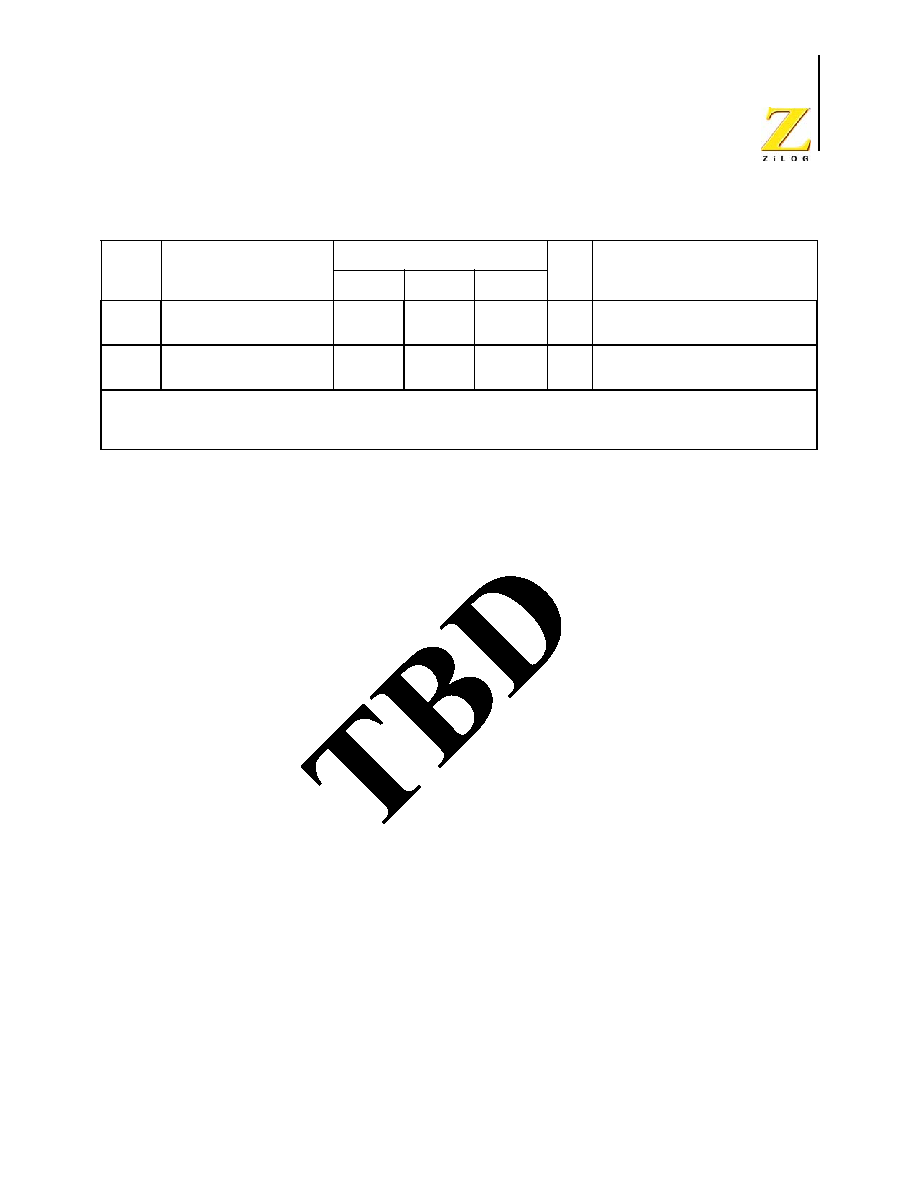
PS024302-0904
P R E L I M I N A R Y Electrical
Characteristics
Z8 Encore!
Æ
4K Series
Product Specification
169
Figure 29 illustrates the typical current consumption while operating at 25∫C, 3.3V, versus
the system clock frequency.
ICCH
Supply Current in Halt
Mode
TBD
µ
A
TBD
ICCS
Supply Current in STOP
Mode
2
µ
A
With watchdog timer running
1
This condition excludes all pins that have on-chip pull-ups, when driven Low.
2
These values are provided for design guidance only and are not tested in production.
Figure 29.ICC Versus System Clock Frequency
Table 105. DC Characteristics (Continued)
Symbol Parameter
T
A
= -40∞C to +105∞C
Units Conditions
Minimum Typical Maximum

PS024302-0904
P R E L I M I N A R Y Electrical
Characteristics
Z8 Encore!
Æ
4K Series
Product Specification
170
AC Characteristics
The section provides information about the AC characteristics and timing. All AC timing
information assumes a standard load of 50pF on all outputs.
Table 106. AC Characteristics
Symbol Parameter
V
DD
= 2.7 to 3.6V
T
A
= -40∞C to
+105∞C
Units Conditions
Minimu
m
Maximu
m
F
SYSCLK
System Clock Frequency
≠
20.0
MHz
Read-only from Flash memory
0.032768
20.0
MHz
Program or erasure of the
Flash memory
F
IPO
Internal Precision Oscillator
Frequency
0.032768 5.5296
MHz
Oscillator is not adjustable over
the entire range. User may
select Min or Max value only.
F
IPO
Internal Precision Oscillator
Frequency
4.8
5.2
MHz
High speed with trimming
F
IPO
Internal Precision Oscillator
Frequency
3.75
6.25
MHz
High speed without trimming
F
IPO
Internal Precision Oscillator
Frequency
30.7
33.3
KHz
Low speed with trimming
F
IPO
Internal Precision Oscillator
Frequency
24
40
KHz
Low speed without trimming
T
XIN
System Clock Period
50
≠
ns
T
CLK
= 1/F
sysclk
T
XINH
System Clock High Time
20
30
ns
T
CLK
= 50ns
T
XINL
System Clock Low Time
20
30
ns
T
CLK
= 50ns
T
XINR
System Clock Rise Time
≠
3
ns
T
CLK
= 50ns
T
XINF
System Clock Fall Time
≠
3
ns
T
CLK
= 50ns

PS024302-0904
P R E L I M I N A R Y Electrical
Characteristics
Z8 Encore!
Æ
4K Series
Product Specification
171
On-Chip Peripheral AC and DC Electrical Characteristics
Table 107. Power-On Reset and Voltage Brown-Out Electrical Characteristics and Timing
Symb
ol
Parameter
T
A
= -40∞C to +105∞C
Units Conditions
Minimu
m
Typical
1
Maximum
V
POR
Power-On Reset Voltage
Threshold
2.20
2.45
2.70
V
V
DD
= V
POR
(default VBO
trim)
V
VBO
Voltage Brown-Out
Reset Voltage Threshold
2.15
2.40
2.65
V
V
DD
= V
VBO
(default VBO
trim)
V
POR
to V
VBO
hysteresis
50
75
mV
Starting V
DD
voltage to
ensure valid Power-On
Reset.
≠
V
SS
≠
V
T
ANA
Power-On Reset Analog
Delay
≠
50
≠
µ
s
V
DD
> V
POR
; T
POR
Digital
Reset delay follows T
ANA
T
POR
Power-On Reset Digital
Delay
TBD
13
TBD
µ
s
43 Internal Precision
Oscillator cycles
T
POR
Power-On Reset Digital
Delay
TBD
8
TBD
ms
5000 Internal Precision
Oscillator cycles
T
VBO
Voltage Brown-Out
Pulse Rejection Period
≠
10
≠
µs
V
DD
< V
VBO
to generate a
Reset.
T
RAMP
Time for V
DD
to transition
from V
SS
to V
POR
to
ensure valid Reset
0.10
≠
100
ms
1 Data in the typical column is from characterization at 3.3V and 0∞C. These values are provided for
design guidance only and are not tested in production.
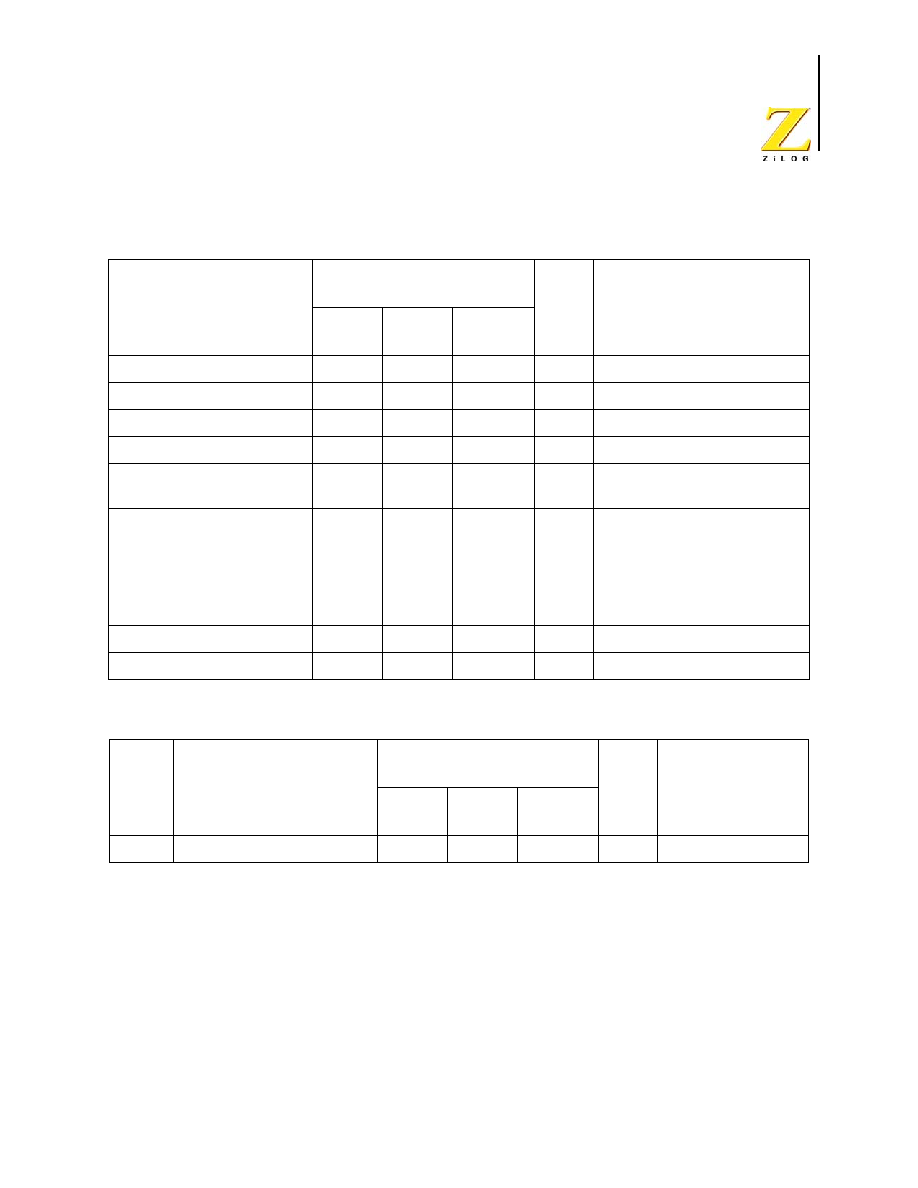
PS024302-0904
P R E L I M I N A R Y Electrical
Characteristics
Z8 Encore!
Æ
4K Series
Product Specification
172
Table 108. Flash Memory Electrical Characteristics and Timing
Parameter
V
DD
= 2.7 to 3.6V
T
A
= -40∞C to +105∞C
Units Notes
Minimu
m
Typical Maximum
Flash Byte Read Time
100
≠
≠
ns
Flash Byte Program Time
20
≠
40
µ
s
Flash Page Erase Time
10
≠
≠
ms
Flash Mass Erase Time
200
≠
≠
ms
Writes to Single Address
Before Next Erase
≠
≠
2
Flash Row Program Time
≠
≠
8
ms
Cumulative program time for
single row cannot exceed limit
before next erase. This
parameter is only an issue
when bypassing the Flash
Controller.
Data Retention
100
≠
≠
years 25∞C
Endurance
20,000
≠
≠
cycles Program / erase cycles
Table 109. Watch-Dog Timer Electrical Characteristics and Timing
Symbol Parameter
V
DD
= 2.7 - 3.6V
T
A
= -40∞C to +105∞C
Units Conditions
Minimu
m
Typical Maximum
F
WDT
WDT Oscillator Frequency
10
KHz
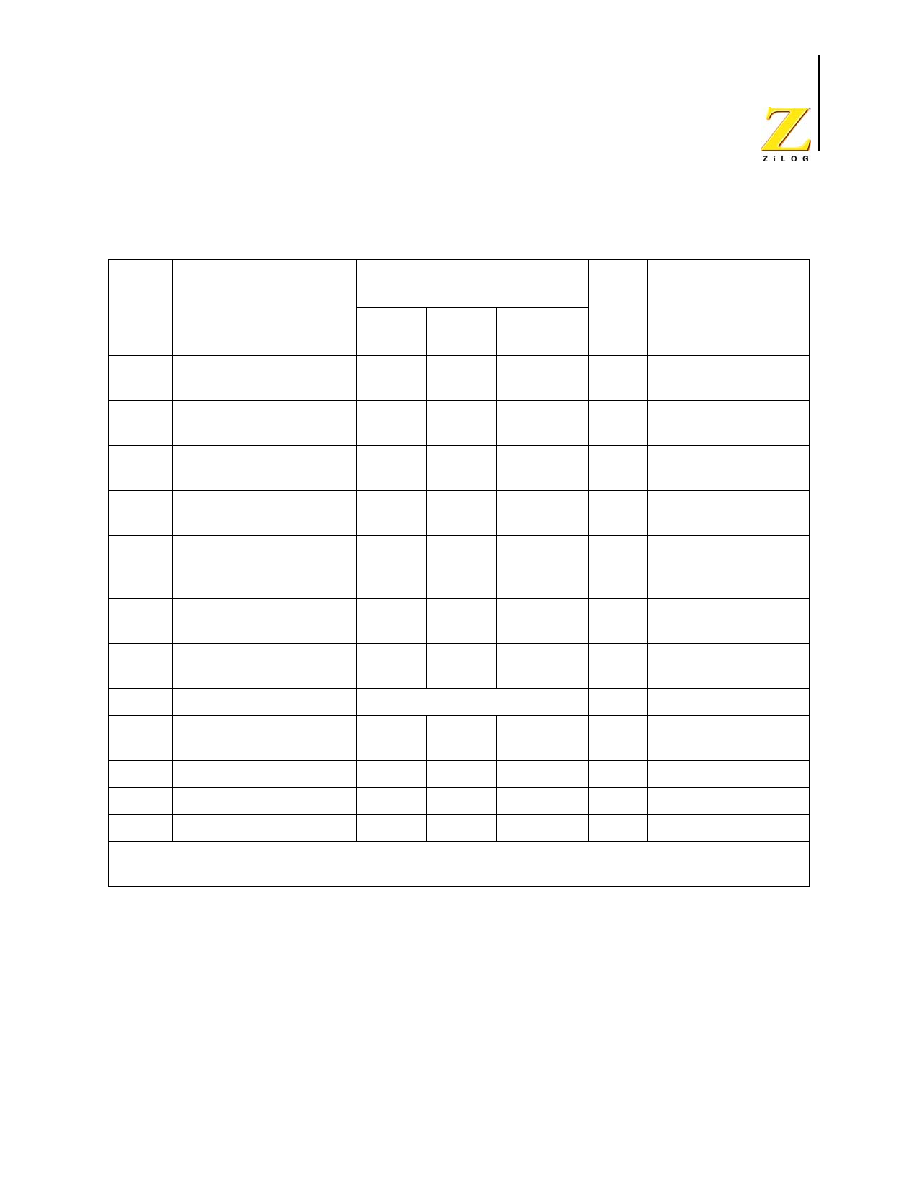
PS024302-0904
P R E L I M I N A R Y Electrical
Characteristics
Z8 Encore!
Æ
4K Series
Product Specification
173
General Purpose I/O Port Input Data Sample Timing
Figure 30 illustrates timing of the GPIO Port input sampling. The input value on a GPIO
Port pin is sampled on the rising edge of the system clock. The Port value is available to
the eZ8 CPU on the second rising clock edge following the change of the Port value.
Table 110. Analog-to-Digital Converter Electrical Characteristics and Timing
Symbol Parameter
V
DD
= 2.7 to 3.6V
T
A
= -40∞C to +105∞C
Units Conditions
Minimu
m
Typical
Maximum
Resolution
≠
10
≠
bits
External V
REF
= 3.0V;
R
S
3.0K
Differential Nonlinearity
(DNL)
-1.0
≠
1.0
LSB
External V
REF
= 3.0V;
R
S
3.0K
Integral Nonlinearity (INL)
-3.0
≠
3.0
LSB
External V
REF
= 3.0V;
R
S
3.0K
DC Offset Error (single-
ended)
-35
≠
25
mV
Unbuffered Mode
V
REF
Internal Reference Voltage
0.9
1.8
2.0
1.0
2.0
2.2
1.1
2.2
2.4
V
REFSEL=00
REFSEL=01
REFSEL=10
Single-Shot Conversion
Time
≠
5129
≠
cycles System clock cycles
Continuous Conversion
Time
≠
256
≠
cycles System clock cycles
Sampling Rate
System Clock /256
Hz
Signal Input Bandwidth
≠
10
KHz
As defined by -3dB
point
R
S
Analog Source Impedance
≠
≠
10
k
In unbuffered mode
Zin
Input Impedance
TBD
150
k
In unbuffered mode
Vin
Input Voltage Range
0
V
DD
V
Unbuffered Mode
1
Analog source impedance affects the ADC offset voltage (because of pin leakage) and input settling
time.
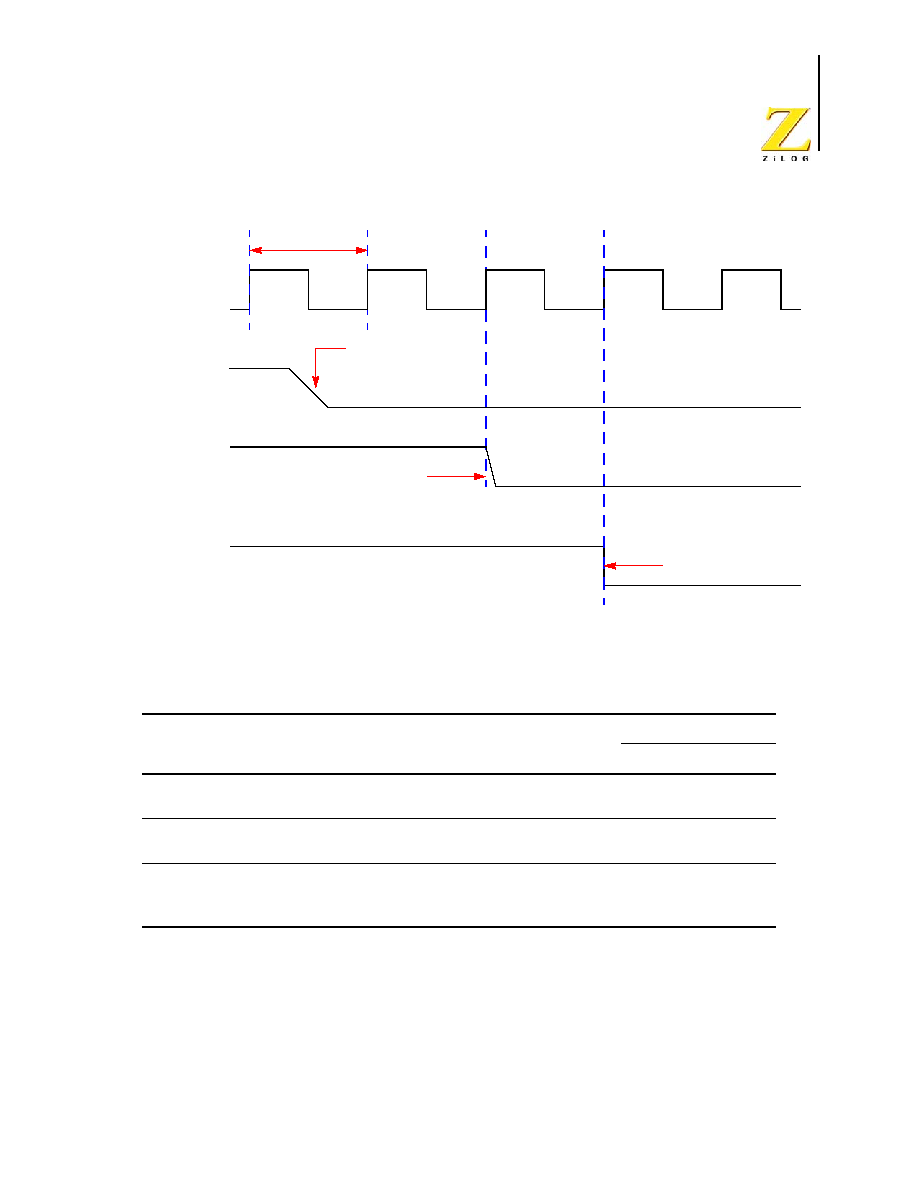
PS024302-0904
P R E L I M I N A R Y Electrical
Characteristics
Z8 Encore!
Æ
4K Series
Product Specification
174
Figure 30.Port Input Sample Timing
Table 111. GPIO Port Input Timing
Parameter Abbreviation
Delay (ns)
Minimum Maximum
T
S_PORT
Port Input Transition to XIN Rise Setup Time
(Not pictured)
5
≠
T
H_PORT
XIN Rise to Port Input Transition Hold Time
(Not pictured)
0
≠
T
SMR
GPIO Port Pin Pulse Width to ensure STOP Mode
Recovery
(for GPIO Port Pins enabled as SMR sources)
1
µ
s
System
TCLK
Port Pin
Port Value
Changes to 0
0 Latched
Into Port Input
Input Value
Port Input Data
Register Latch
Clock
Data Register
Port Input Data
Read on Data Bus
Port Input Data Register
Value 0 Read
by eZ8
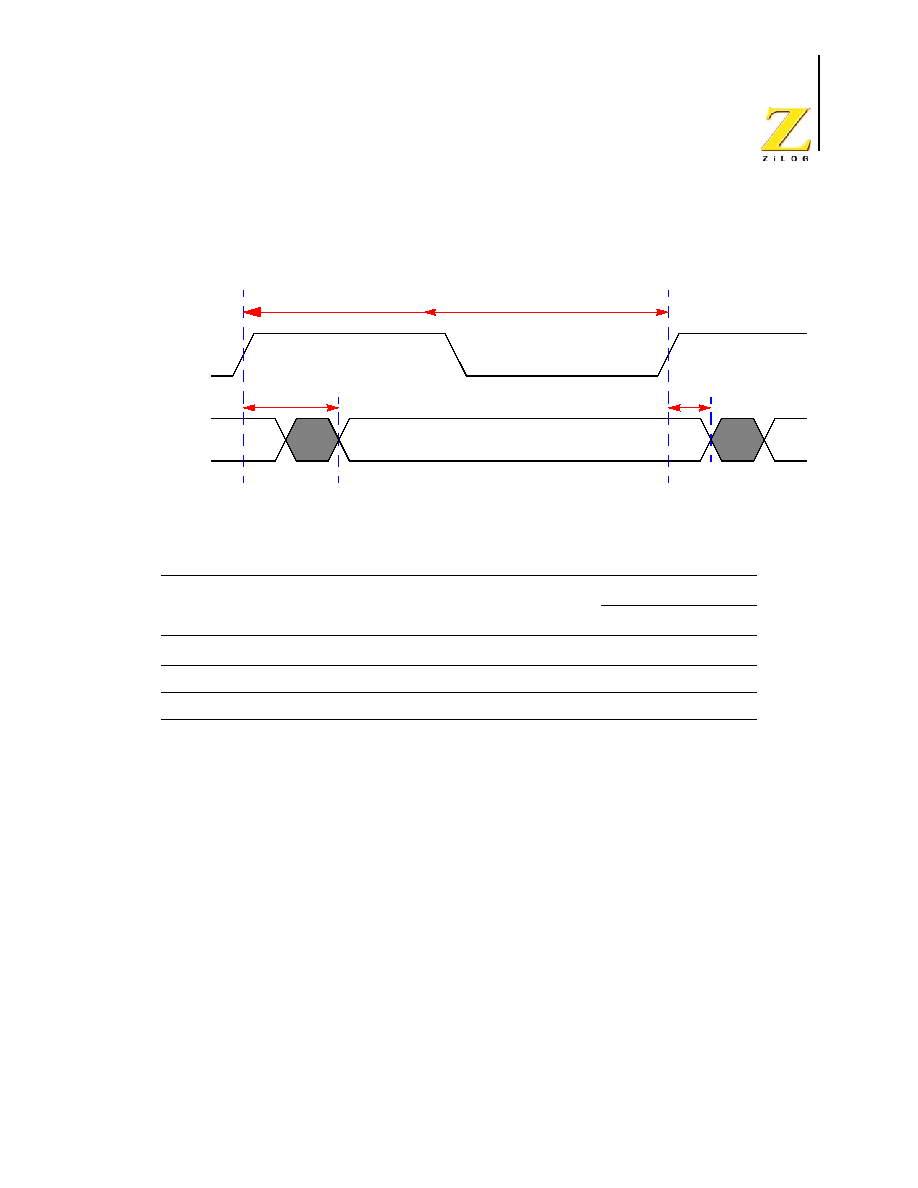
PS024302-0904
P R E L I M I N A R Y Electrical
Characteristics
Z8 Encore!
Æ
4K Series
Product Specification
175
General Purpose I/O Port Output Timing
Figure 31 and Table 112 provide timing information for GPIO Port pins.
Figure 31.GPIO Port Output Timing
Table 112. GPIO Port Output Timing
Parameter
Abbreviation
Delay (ns)
Minimum Maximum
GPIO Port pins
T
1
XIN Rise to Port Output Valid Delay
≠
15
T
2
XIN Rise to Port Output Hold Time
2
≠
XIN
Port Output
TCLK
T1
T2
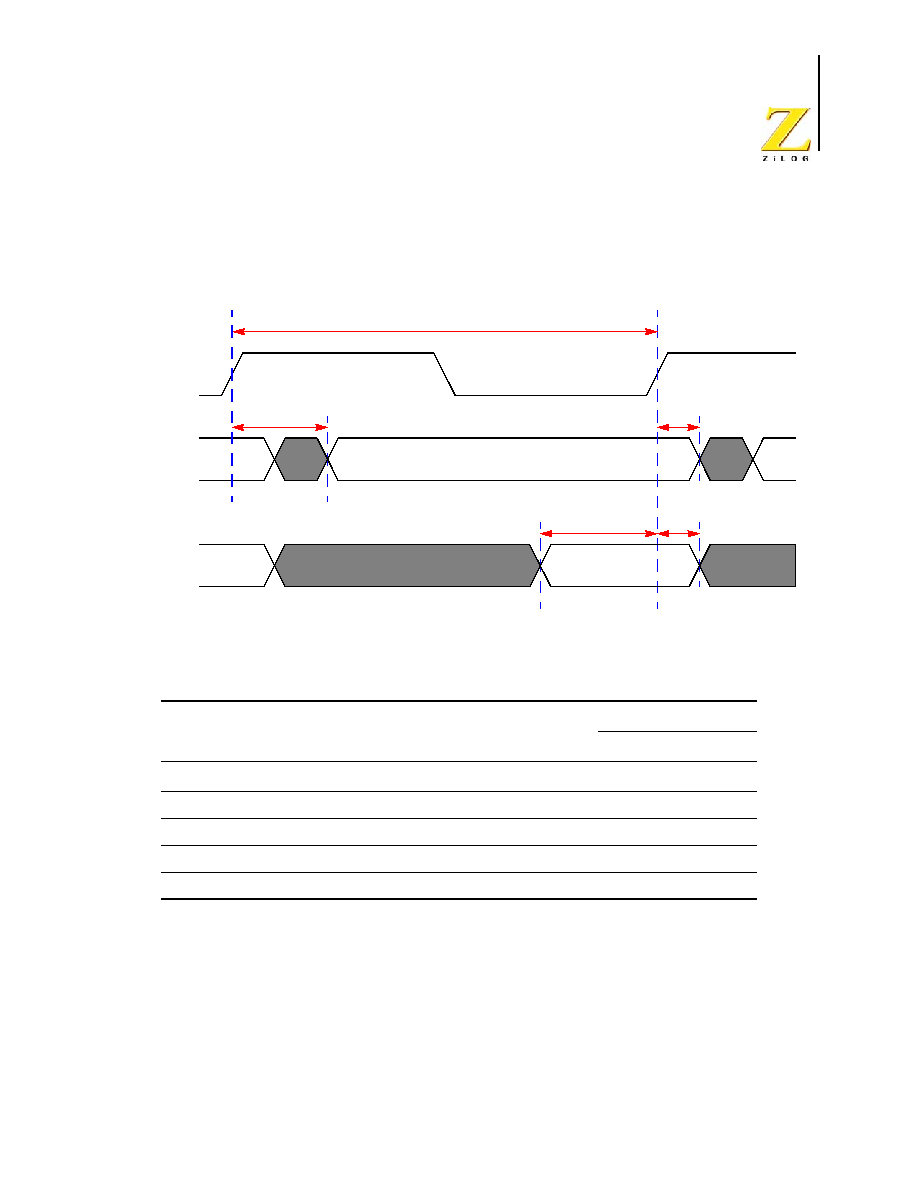
PS024302-0904
P R E L I M I N A R Y Electrical
Characteristics
Z8 Encore!
Æ
4K Series
Product Specification
176
On-Chip Debugger Timing
Figure 32 and Table 113 provide timing information for the DBG pin. The DBG pin tim-
ing specifications assume a 4ns maximum rise and fall time.
Figure 32.On-Chip Debugger Timing
Table 113. On-Chip Debugger Timing
Parameter
Abbreviation
Delay (ns)
Minimum Maximum
DBG
T
1
XIN Rise to DBG Valid Delay
≠
15
T
2
XIN Rise to DBG Output Hold Time
2
≠
T
3
DBG to XIN Rise Input Setup Time
5
≠
T
4
DBG to XIN Rise Input Hold Time
5
≠
XIN
DBG
TCLK
T1
T2
(Output)
DBG
T3
T4
(Input)
Output Data
Input Data
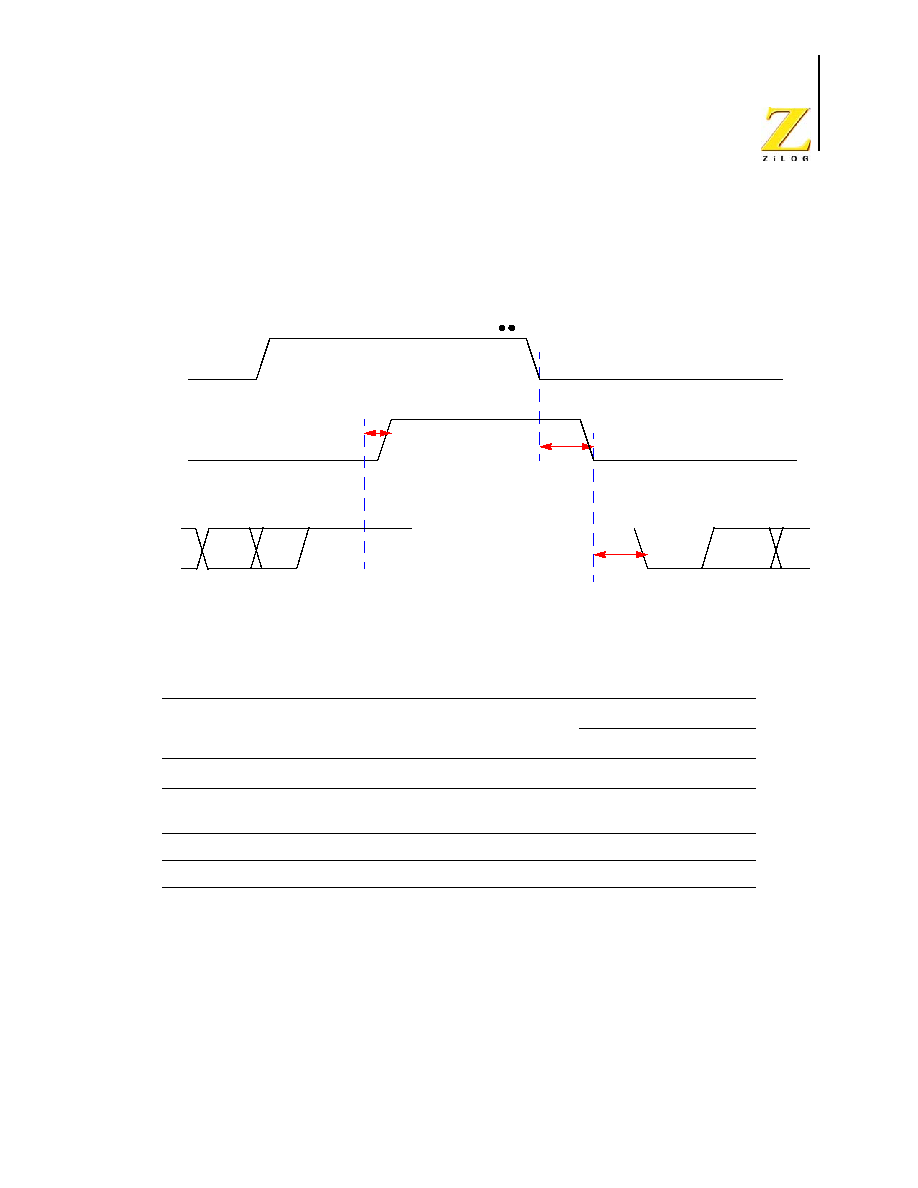
PS024302-0904
P R E L I M I N A R Y Electrical
Characteristics
Z8 Encore!
Æ
4K Series
Product Specification
177
UART Timing
Figure 33 and Table 114 provide timing information for UART pins for the case where
CTS is used for flow control. The CTS to DE assertion delay (T1) assumes the transmit
data register has been loaded with data prior to CTS assertion.
Figure 33.UART Timing With CTS
Table 114. UART Timing With CTS
Parameter
Abbreviation
Delay (ns)
Minimum
Maximum
UART
T
1
CTS Fall to DE output delay
2 * XIN
period
2 * XIN period
+ 1 bit time
T
2
DE assertion to TXD falling edge (start bit) delay ± 5
T
3
End of Stop Bit(s) to DE deassertion delay
± 5
CTS
DE
T1
(Output)
TXD
T2
(Output)
(Input)
start
bit 0
bit 1
bit 7
parity
stop
end of
stop bit(s)
T3
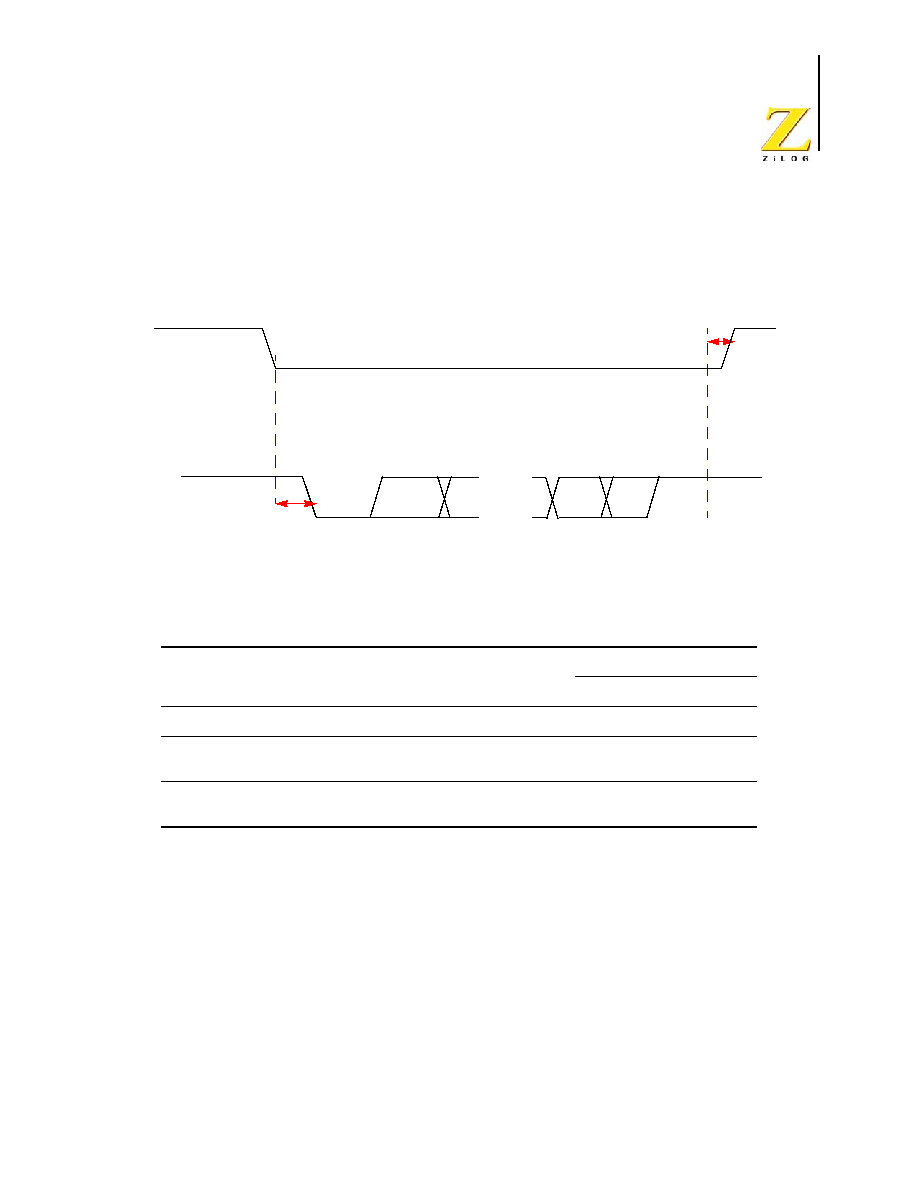
PS024302-0904
P R E L I M I N A R Y Electrical
Characteristics
Z8 Encore!
Æ
4K Series
Product Specification
178
Figure 34 and Table 115 provide timing information for UART pins for the case where
CTS is not used for flow control. DE asserts after the transmit data register has been writ-
ten. DE remains asserted for multiple characters as long as the transmit data register is
written with the next character before the current character has completed.
Figure 34.UART Timing Without CTS
Table 115. UART Timing Without CTS
Parameter
Abbreviation
Delay (ns)
Minimum
Maximum
UART
T
1
DE assertion to TXD falling edge (start bit) delay
1 * XIN
period
1 bit time
T
2
End of Stop Bit(s) to DE deassertion delay (Tx
data register is empty)
± 5
DE
T1
(Output)
TXD
T2
(Output)
start
bit0
bit 1
bit 7
parity
stop
end of
stop bit(s)
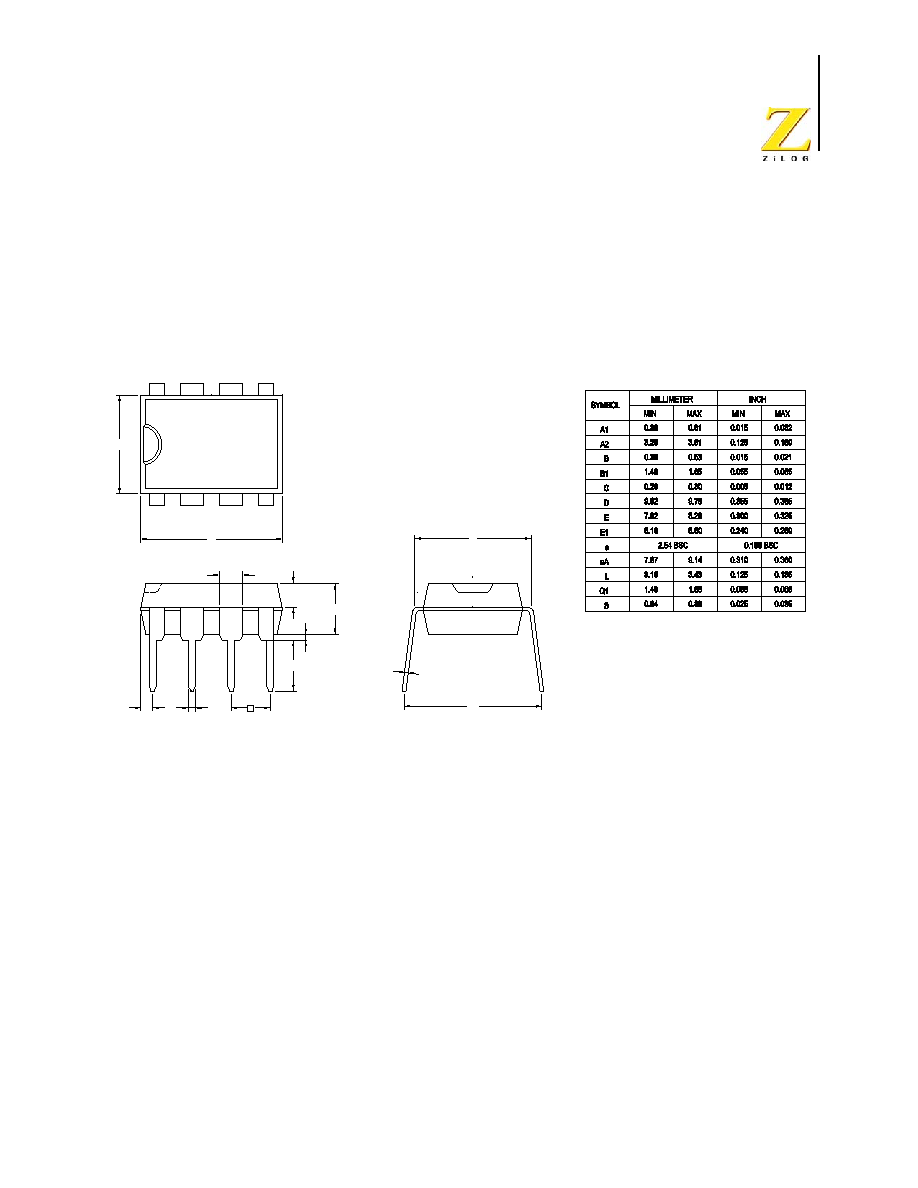
PS024302-0904
P R E L I M I N A R Y Packaging
Z8 Encore!
Æ
4K Series
Product Specification
179
Packaging
Figure 38 illustrates the 8-pin Plastic Dual Inline Package (PDIP) available for the Z8
Encore! XP
TM
4K Series devices.
Figure 35.8-Pin Plastic Dual Inline Package (PDIP)
Figure 36 illustrates the 8-pin Small Outline Integrated Circuit package (SOIC) available
for the Z8 Encore! XP
TM
4K Series devices.
eA
E
B1
Q1
B
S
A2
L
e
A1
C
D
E1
1
8
4
5
CONTROLLING DIMENSIONS : MM.
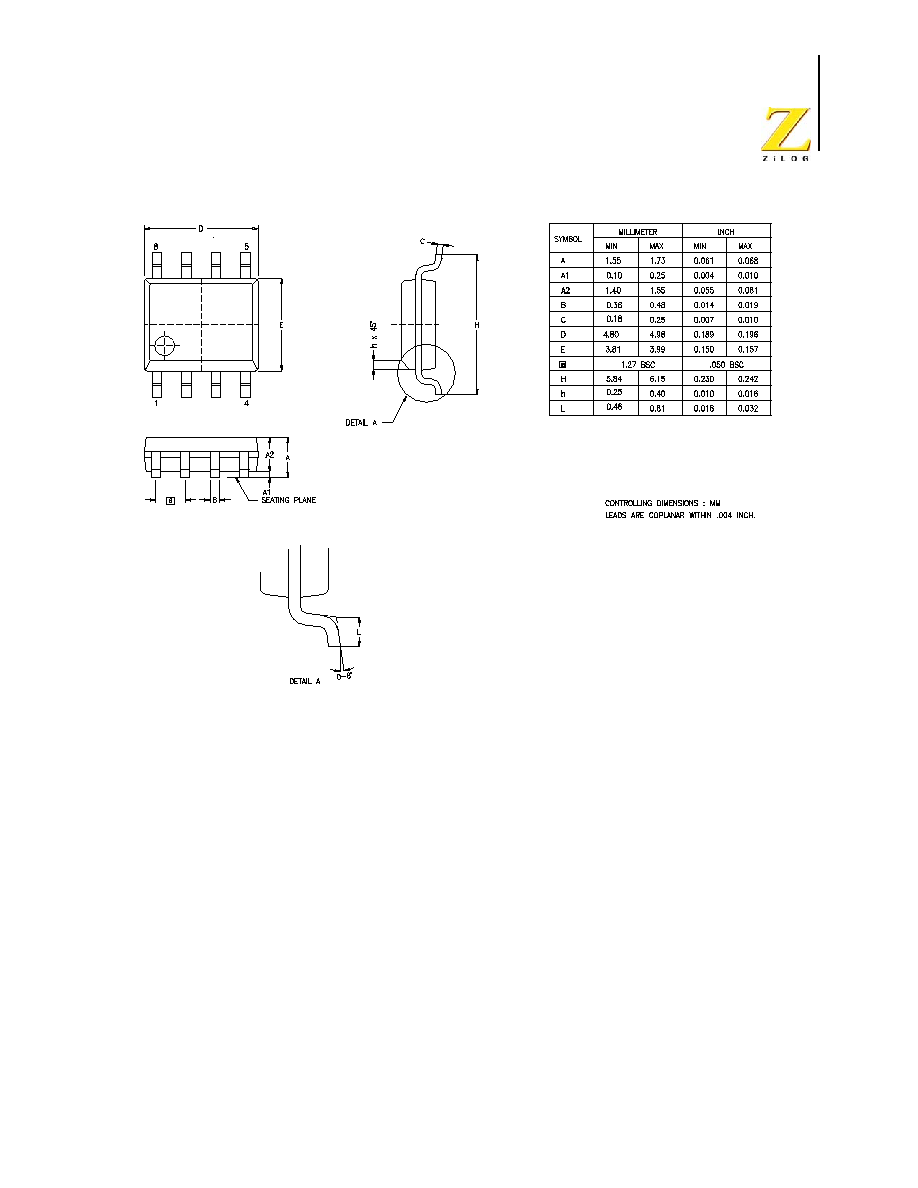
PS024302-0904
P R E L I M I N A R Y Packaging
Z8 Encore!
Æ
4K Series
Product Specification
180
Figure 36. 8-Pin Small Outline Integrated Circuit Package (SOIC)
Figure 38 illustrates the 20-pin Plastic Dual Inline Package (PDIP) available for the Z8
Encore! XP
TM
4K Series devices.
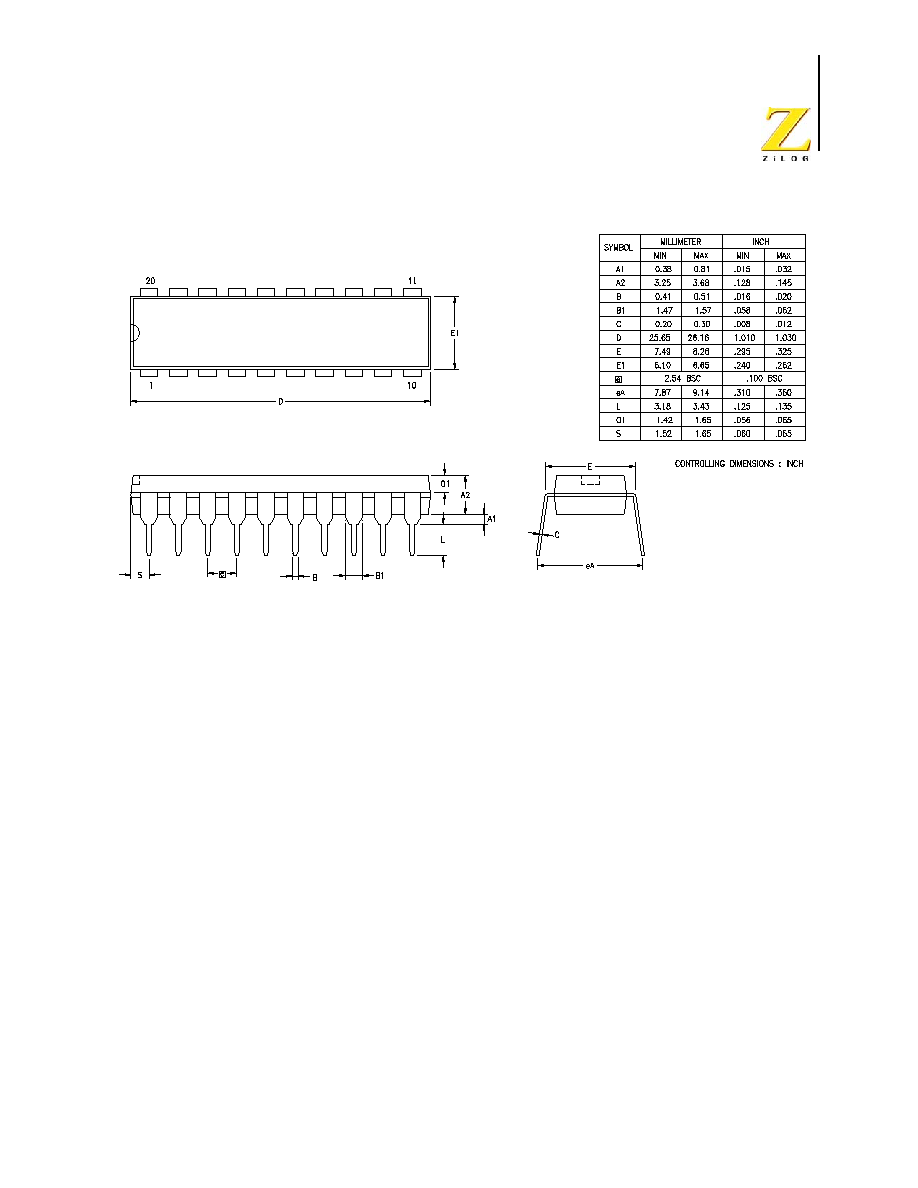
PS024302-0904
P R E L I M I N A R Y Packaging
Z8 Encore!
Æ
4K Series
Product Specification
181
Figure 37.20-Pin Plastic Dual Inline Package (PDIP)
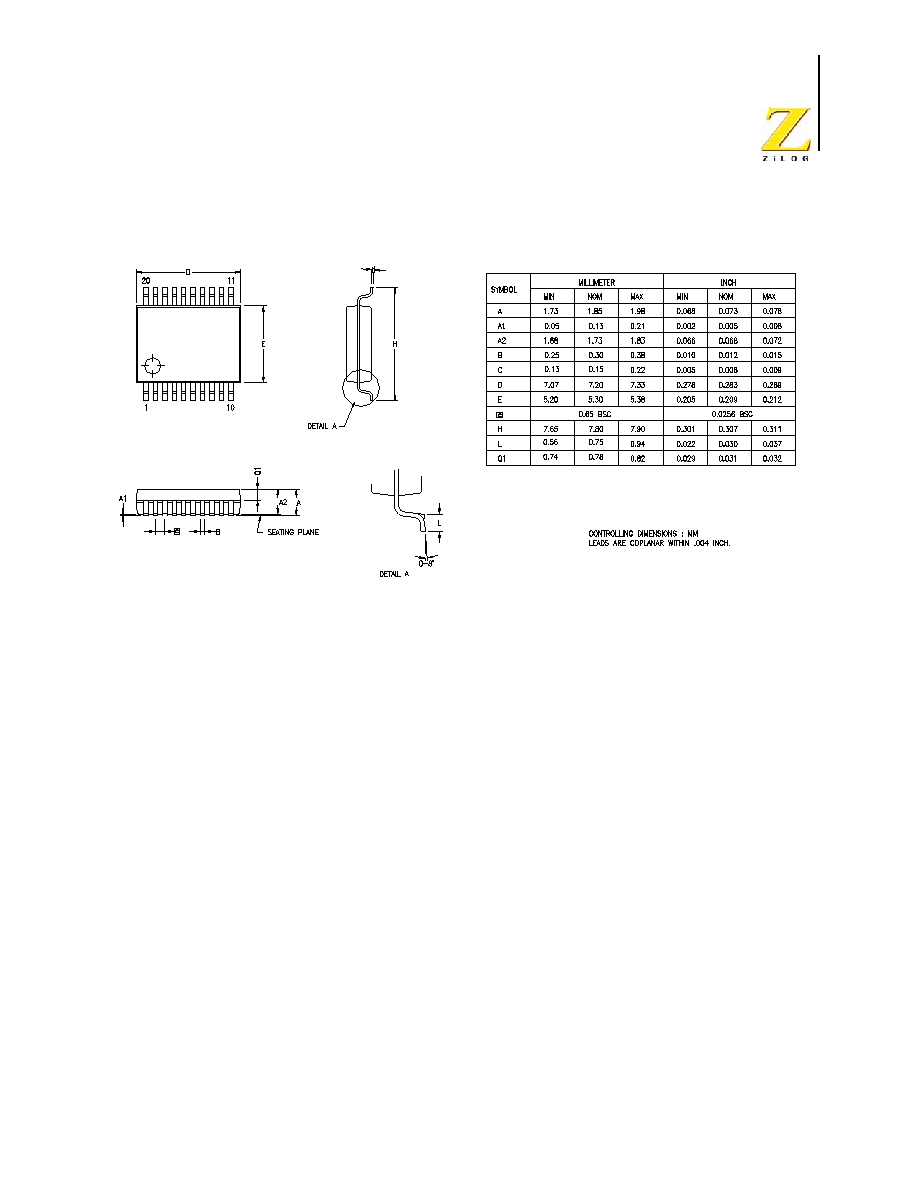
PS024302-0904
P R E L I M I N A R Y Packaging
Z8 Encore!
Æ
4K Series
Product Specification
182
Figure 38 illustrates the 20-pin Small Shrink Outline Package (SSOP) available for the Z8
Encore! XP
TM
4K Series devices.
Figure 38.20-Pin Small Shrink Outline Package (SSOP)
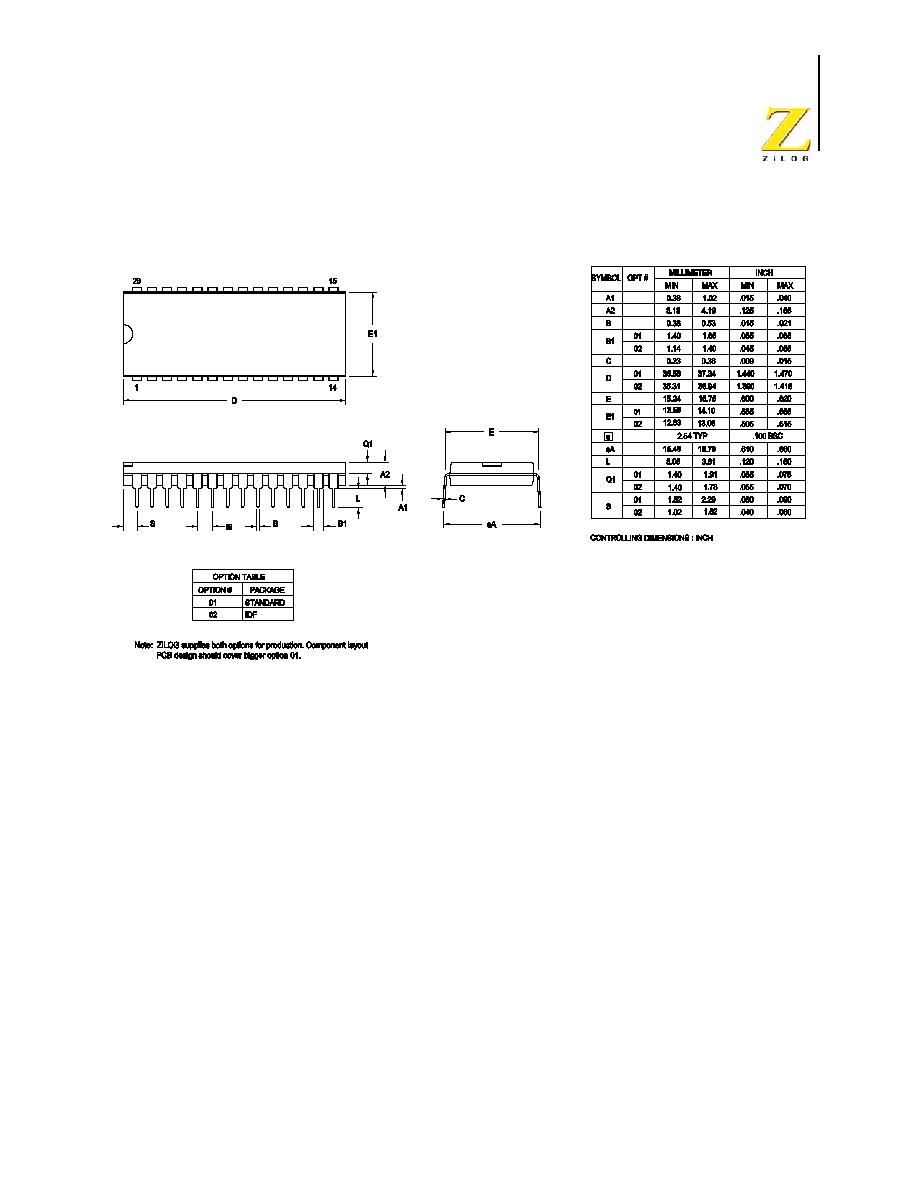
PS024302-0904
P R E L I M I N A R Y Packaging
Z8 Encore!
Æ
4K Series
Product Specification
183
Figure 39 illustrates the 28-pin Plastic Dual Inline Package (PDIP) available for the Z8
Encore! XP
TM
4K Series devices.
Figure 39.28-Pin Plastic Dual Inline Package (PDIP)
Figure 40 illustrates the 28-pin Small Outline Integrated Circuit package (SOIC) available
in the Z8 Encore! XP
TM
4K Series devices.

PS024302-0904
P R E L I M I N A R Y Packaging
Z8 Encore!
Æ
4K Series
Product Specification
184
Figure 40.28-Pin Small Outline Integrated Circuit Package (SOIC)

PS024302-0904
P R E L I M I N A R Y Ordering
Information
Z8 Encore!
Æ
4K Series
Product Specification
185
Ordering Information
Part Num
b
er
Flas
h
RA
M
I/
O Li
nes
Interrupt
s
16-Bit T
i
mers
w/
PWM
10-Bit A/
D C
h
annels
UA
RT with IrDA
Desc
ription
Z8 Encore!
Æ
with 4KB Flash, 10-Bit Analog-to-Digital Converter
Standard Temperature: 0∞ to 70∞C
Z8F0423PB005SC
4KB
1KB
6
12
2 4 1 PDIP 8-pin package
Z8F0423SB005SC
4KB
1KB
6
12
2 4 1 SOIC 8-pin package
Z8F0423SH005SC
4KB
1KB
16
18
2 7 1 SOIC 20-pin package
Z8F0423HH005SC
4KB
1KB
16
18
2 7 1 SSOP 20-pin package
Z8F0423PH005SC
4KB
1KB
16
18
2 7 1 PDIP 20-pin package
Z8F0423SJ005SC
4KB
1KB
22
18
2 8 1 SOIC 28-pin package
Z8F0423HJ005SC
4KB
1KB
22
18
2 8 1 SSOP 28-pin package
Z8F0423PJ005SC
4KB
1KB
22
18
2 8 1 PDIP 28-pin package
Extended Temperature: -40∞ to 105∞C
Z8F0423PB005EC
4KB
1KB
6
12
2 4 1 PDIP 8-pin package
Z8F0423SB005EC
4KB
1KB
6
12
2 4 1 SOIC 8-pin package
Z8F0423SH005EC
4KB
1KB
16
18
2 7 1 SOIC 20-pin package
Z8F0423HH005EC
4KB
1KB
16
18
2 7 1 SSOP 20-pin package
Z8F0423PH005EC
4KB
1KB
16
18
2 7 1 PDIP 20-pin package
Z8F0423SJ005EC
4KB
1KB
22
18
2 8 1 SOIC 28-pin package
Z8F0423HJ005EC
4KB
1KB
22
18
2 8 1 SSOP 28-pin package
Z8F0423PJ005EC
4KB
1KB
22
18
2 8 1 PDIP 28-pin package

PS024302-0904
P R E L I M I N A R Y Ordering
Information
Z8 Encore!
Æ
4K Series
Product Specification
186
Z8 Encore!
Æ
with 4KB Flash
Standard Temperature: 0∞ to 70∞C
Z8F0413PB005SC
4KB
1KB
6
12
2 0 1 PDIP 8-pin package
Z8F0413SB005SC
4KB
1KB
6
12
2 0 1 SOIC 8-pin package
Z8F0413SH005SC
4KB
1KB
16
18
2 0 1 SOIC 20-pin package
Z8F0413HH005SC
4KB
1KB
16
18
2 0 1 SSOP 20-pin package
Z8F0413PH005SC
4KB
1KB
16
18
2 0 1 PDIP 20-pin package
Z8F0413SJ005SC
4KB
1KB
24
18
2 0 1 SOIC 28-pin package
Z8F0413HJ005SC
4KB
1KB
24
18
2 0 1 SSOP 28-pin package
Z8F0413PJ005SC
4KB
1KB
24
18
2 0 1 PDIP 28-pin package
Extended Temperature: -40∞ to 105∞C
Z8F0413PB005EC
4KB
1KB
6
12
2 0 1 PDIP 8-pin package
Z8F0413SB005EC
4KB
1KB
6
12
2 0 1 SOIC 8-pin package
Z8F0413SH005EC
4KB
1KB
16
18
2 0 1 SOIC 20-pin package
Z8F0413HH005EC
4KB
1KB
16
18
2 0 1 SSOP 20-pin package
Z8F0413PH005EC
4KB
1KB
16
18
2 0 1 PDIP 20-pin package
Z8F0413SJ005EC
4KB
1KB
24
18
2 0 1 SOIC 28-pin package
Z8F0413HJ005EC
4KB
1KB
24
18
2 0 1 SSOP 28-pin package
Z8F0413PJ005EC
4KB
1KB
24
18
2 0 1 PDIP 28-pin package
P
a
rt Number
Fla
s
h
RA
M
I/
O Li
ne
s
Int
e
r
r
upt
s
16-Bit T
i
mers
w/PWM
10-Bit A/D Channels
U
ART with IrDA
De
scr
ip
tion

PS024302-0904
P R E L I M I N A R Y Ordering
Information
Z8 Encore!
Æ
4K Series
Product Specification
187
Z8 Encore!
Æ
with 2KB Flash, 10-Bit analog-to-Digital Converter
Standard Temperature: 0∞ to 70∞C
Z8F0223PB005SC
2KB
512B
6
12
2 4 1 PDIP 8-pin package
Z8F0223SB005SC
2KB
512B
6
12
2 4 1 SOIC 8-pin package
Z8F0223SH005SC
2KB
512B
16
18
2 7 1 SOIC 20-pin package
Z8F0223HH005SC
2KB
512B
16
18
2 7 1 SSOP 20-pin package
Z8F0223PH005SC
2KB
512B
16
18
2 7 1 PDIP 20-pin package
Z8F0223SJ005SC
2KB
512B
22
18
2 8 1 SOIC 28-pin package
Z8F0223HJ005SC
2KB
512B
22
18
2 8 1 SSOP 28-pin package
Z8F0223PJ005SC
2KB
512B
22
18
2 8 1 PDIP 28-pin package
Extended Temperature: -40∞ to 105∞C
Z8F0223PB005EC
2KB
512B
6
12
2 4 1 PDIP 8-pin package
Z8F0223SB005EC
2KB
512B
6
12
2 4 1 SOIC 8-pin package
Z8F0223SH005EC
2KB
512B
16
18
2 7 1 SOIC 20-pin package
Z8F0223HH005EC
2KB
512B
16
18
2 7 1 SSOP 20-pin package
Z8F0223PH005EC
2KB
512B
16
18
2 7 1 PDIP 20-pin package
Z8F0223SJ005EC
2KB
512B
22
18
2 8 1 SOIC 28-pin package
Z8F0223HJ005EC
2KB
512B
22
18
2 8 1 SSOP 28-pin package
Z8F0223PJ005EC
2KB
512B
22
18
2 8 1 PDIP 28-pin package
P
a
rt Number
Fla
s
h
RA
M
I/
O Li
ne
s
Int
e
r
r
upt
s
16-Bit T
i
mers
w/PWM
10-Bit A/D Channels
U
ART with IrDA
De
scr
ip
tion

PS024302-0904
P R E L I M I N A R Y Ordering
Information
Z8 Encore!
Æ
4K Series
Product Specification
188
Z8 Encore!
Æ
with 2KB Flash
Standard Temperature: 0∞ to 70∞C
Z8F0213PB005SC
2KB
512B
6
12
2 0 1 PDIP 8-pin package
Z8F0213SB005SC
2KB
512B
6
12
2 0 1 SOIC 8-pin package
Z8F0213SH005SC
2KB
512B
16
18
2 0 1 SOIC 20-pin package
Z8F0213HH005SC
2KB
512B
16
18
2 0 1 SSOP 20-pin package
Z8F0213PH005SC
2KB
512B
16
18
2 0 1 PDIP 20-pin package
Z8F0213SJ005SC
2KB
512B
24
18
2 0 1 SOIC 28-pin package
Z8F0213HJ005SC
2KB
512B
24
18
2 0 1 SSOP 28-pin package
Z8F0213PJ005SC
2KB
512B
24
18
2 0 1 PDIP 28-pin package
Extended Temperature: -40∞ to 105∞C
Z8F0213PB005EC
2KB
512B
6
12
2 0 1 PDIP 8-pin package
Z8F0213SB005EC
2KB
512B
6
12
2 0 1 SOIC 8-pin package
Z8F0213SH005EC
2KB
512B
16
18
2 0 1 SOIC 20-pin package
Z8F0213HH005EC
2KB
512B
16
18
2 0 1 SSOP 20-pin package
Z8F0213PH005EC
2KB
512B
16
18
2 0 1 PDIP 20-pin package
Z8F0213SJ005EC
2KB
512B
24
18
2 0 1 SOIC 28-pin package
Z8F0213HJ005EC
2KB
512B
24
18
2 0 1 SSOP 28-pin package
Z8F0213PJ005EC
2KB
512B
24
18
2 0 1 PDIP 28-pin package
P
a
rt Number
Fla
s
h
RA
M
I/
O Li
ne
s
Int
e
r
r
upt
s
16-Bit T
i
mers
w/PWM
10-Bit A/D Channels
U
ART with IrDA
De
scr
ip
tion

PS024302-0904
P R E L I M I N A R Y Ordering
Information
Z8 Encore!
Æ
4K Series
Product Specification
189
Z8 Encore!
Æ
with 1KB Flash, 10-Bit Analog-to-Digital Converter
Standard Temperature: 0∞ to 70∞C
Z8F0123PB005SC
1KB
256B
6
12
2 4 1 PDIP 8-pin package
Z8F0123SB005SC
1KB
256B
6
12
2 4 1 SOIC 8-pin package
Z8F0123SH005SC
1KB
256B
16
18
2 7 1 SOIC 20-pin package
Z8F0123HH005SC
1KB
256B
16
18
2 7 1 SSOP 20-pin package
Z8F0123PH005SC
1KB
256B
16
18
2 7 1 PDIP 20-pin package
Z8F0123SJ005SC
1KB
256B
22
18
2 8 1 SOIC 28-pin package
Z8F0123HJ005SC
1KB
256B
22
18
2 8 1 SSOP 28-pin package
Z8F0123PJ005SC
1KB
256B
22
18
2 8 1 PDIP 28-pin package
Extended Temperature: -40∞ to 105∞C
Z8F0123PB005EC
1KB
256B
6
12
2 4 1 PDIP 8-pin package
Z8F0123SB005EC
1KB
256B
6
12
2 4 1 SOIC 8-pin package
Z8F0123SH005EC
1KB
256B
16
18
2 7 1 SOIC 20-pin package
Z8F0123HH005EC
1KB
256B
16
18
2 7 1 SSOP 20-pin package
Z8F0123PH005EC
1KB
256B
16
18
2 7 1 PDIP 20-pin package
Z8F0123SJ005EC
1KB
256B
22
18
2 8 1 SOIC 28-pin package
Z8F0123HJ005EC
1KB
256B
22
18
2 8 1 SSOP 28-pin package
Z8F0123PJ005EC
1KB
256B
22
18
2 8 1 PDIP 28-pin package
P
a
rt Number
Fla
s
h
RA
M
I/
O Li
ne
s
Int
e
r
r
upt
s
16-Bit T
i
mers
w/PWM
10-Bit A/D Channels
U
ART with IrDA
De
scr
ip
tion

PS024302-0904
P R E L I M I N A R Y Ordering
Information
Z8 Encore!
Æ
4K Series
Product Specification
190
Z8 Encore!
Æ
with 1KB Flash
Standard Temperature: 0∞ to 70∞C
Z8F0113PB005SC
1KB
256B
6
12
2 0 1 PDIP 8-pin package
Z8F0113SB005SC
1KB
256B
6
12
2 0 1 SOIC 8-pin package
Z8F0113SH005SC
1KB
256B
16
18
2 0 1 SOIC 20-pin package
Z8F0113HH005SC
1KB
256B
16
18
2 0 1 SSOP 20-pin package
Z8F0113PH005SC
1KB
256B
16
18
2 0 1 PDIP 20-pin package
Z8F0113SJ005SC
1KB
256B
24
18
2 0 1 SOIC 28-pin package
Z8F0113HJ005SC
1KB
256B
24
18
2 0 1 SSOP 28-pin package
Z8F0113PJ005SC
1KB
256B
24
18
2 0 1 PDIP 28-pin package
Extended Temperature: -40∞ to 105∞C
Z8F0113PB005EC
1KB
256B
6
12
2 0 1 PDIP 8-pin package
Z8F0113SB005EC
1KB
256B
6
12
2 0 1 SOIC 8-pin package
Z8F0113SH005EC
1KB
256B
16
18
2 0 1 SOIC 20-pin package
Z8F0113HH005EC
1KB
256B
16
18
2 0 1 SSOP 20-pin package
Z8F0113PH005EC
1KB
256B
16
18
2 0 1 PDIP 20-pin package
Z8F0113SJ005EC
1KB
256B
24
18
2 0 1 SOIC 28-pin package
Z8F0113HJ005EC
1KB
256B
24
18
2 0 1 SSOP 28-pin package
Z8F0113PJ005EC
1KB
256B
24
18
2 0 1 PDIP 28-pin package
Z8F04328100KIT
Development Kit
P
a
rt Number
Fla
s
h
RA
M
I/
O Li
ne
s
Int
e
r
r
upt
s
16-Bit T
i
mers
w/PWM
10-Bit A/D Channels
U
ART with IrDA
De
scr
ip
tion

PS024302-0904
P R E L I M I N A R Y Ordering
Information
Z8 Encore!
Æ
4K Series
Product Specification
191
Part Number Suffix Designations
Z8 F 04 23 S
H 005 S
C
Environmental Flow:
C = Plastic Standard
Temperature Range (∞C):
S = Standard, 0 to 70
E = Extended, -40 to +105
Speed:
005 = 5MHz
Pin Count:
B = 8
H = 20
J = 28
Package:
H = SSOP
P = PDIP
S = SOIC
Device Type
Memory Size:
04 = 4KB Flash, 1KB RAM
02 = 2KB Flash, 512B RAM
01 = 1KB Flash, 256B RAM
Memory Type:
F = Flash
Device Family

PS024302-0904
P R E L I M I N A R Y Ordering
Information
Z8 Encore!
Æ
4K Series
Product Specification
192
Precharacterization Product
The product represented by this document is newly introduced and ZiLOG has not com-
pleted the full characterization of the product. The document states what ZiLOG knows
about this product at this time, but additional features or nonconformance with some
aspects of the document might be found, either by ZiLOG or its customers in the course of
further application and characterization work. In addition, ZiLOG cautions that delivery
might be uncertain at times, because of start-up yield issues.
ZiLOG, Inc.
532 Race Street
San Jose, CA 95126
Telephone (408) 558-8500
FAX 408 558-8300
Internet:
www.zilog.com
Customer Support
For valuable information about downloading other relevant documents or for hardware
and software development tools, visit the ZiLOG web site at
www.zilog.com
.

PS024302-0904
P R E L I M I N A R Y Customer
Feedback
Form
Z8 Encore!
Æ
4K Series
Product Specification
193
Customer Feedback Form
Z8 Encore!
Æ
4K Series High Performance MCUs with Flash Memory and 10-Bit A/D
Converter Product Specification
If you experience any problems while operating this product, or if you note any inaccuracies while reading
this document, please copy and complete this form and mail it to the address below or go to
www.zilog.com
(see Return Information, below). We also welcome your suggestions!
Customer Information
Product Information
Name
Country
Company
Phone
Address
Fax
City/State/Zip
Email
Serial # or Board Fab #/Rev. #
Software Version
Document Number
Host Computer Description/Type

PS024302-0904
P R E L I M I N A R Y Customer
Feedback
Form
Z8 Encore!
Æ
4K Series
Product Specification
194
Return Information
ZiLOG
System Test/Customer Support
532 Race Street
San Jose, CA 95126-3432
www.zilog.com
Problem Description or Suggestion
Provide a complete description of the problem or your suggestion. If you are reporting a specific problem,
include all steps leading up to the occurrence of the problem. Attach additional pages as necessary.

Z8 Encore!
Æ
4K Series
Product Specification
PS024302-0904
P R E L I M I N A R Y Index
195
Index
Symbols
# 150
% 150
@ 150
Numerics
10-bit ADC 4
40-lead plastic dual-inline package 184
A
absolute maximum ratings 167
AC characteristics 170
ADC 151
architecture 107
automatic power-down 108
block diagram 108
continuous conversion 110
control register 111, 112
control register definitions 111
data high byte register 113
data low bits register 113
electrical characteristics and timing 173
operation 108
single-shot conversion 109
ADCCTL register 111, 112
ADCDH register 113
ADCDL register 113
ADCX 151
ADD 151
add - extended addressing 151
add with carry 151
add with carry - extended addressing 151
additional symbols 150
address space 13
ADDX 151
analog signals 9
analog-to-digital converter (ADC) 107
AND 153
ANDX 153
arithmetic instructions 151
assembly language programming 147
assembly language syntax 148
B
B 150
b 149
baud rate generator, UART 94
BCLR 152
binary number suffix 150
BIT 152
bit 149
clear 152
manipulation instructions 152
set 152
set or clear 152
swap 152
test and jump 154
test and jump if non-zero 154
test and jump if zero 154
bit jump and test if non-zero 154
bit swap 154
block diagram 2
block transfer instructions 152
BRK 154
BSET 152
BSWAP 152, 154
BTJ 154
BTJNZ 154
BTJZ 154
C
CALL procedure 154
capture mode 76, 77
capture/compare mode 76
cc 149
CCF 152
characteristics, electrical 167
clear 153
CLR 153
COM 153

Z8 Encore!
Æ
4K Series
Product Specification
PS024302-0904
P R E L I M I N A R Y Index
196
compare 76
compare - extended addressing 151
compare mode 76
compare with carry 151
compare with carry - extended addressing 151
complement 153
complement carry flag 152
condition code 149
continuous conversion (ADC) 110
continuous mode 76
control register definition, UART 95
Control Registers 13, 16
counter modes 76
CP 151
CPC 151
CPCX 151
CPU and peripheral overview 4
CPU control instructions 152
CPX 151
Customer Feedback Form 193
Customer Information 193
D
DA 149, 151
data memory 15
DC characteristics 168
debugger, on-chip 131
DEC 151
decimal adjust 151
decrement 151
decrement and jump non-zero 154
decrement word 151
DECW 151
destination operand 150
device, port availability 31
DI 152
direct address 149
disable interrupts 152
DJNZ 154
dst 150
E
EI 152
electrical characteristics 167
ADC 173
flash memory and timing 172
GPIO input data sample timing 173
watch-dog timer 172
enable interrupt 152
ER 149
extended addressing register 149
external pin reset 24
eZ8 CPU features 4
eZ8 CPU instruction classes 150
eZ8 CPU instruction notation 148
eZ8 CPU instruction set 147
eZ8 CPU instruction summary 155
F
FCTL register 122, 127
features, Z8 Encore! 1
first opcode map 165
FLAGS 150
flags register 150
flash
controller 4
option bit address space 128
option bit configuration - reset 126
program memory address 0000H 128
program memory address 0001H 129
flash memory 115
arrangement 116
byte programming 121
code protection 119
configurations 115
control register definitions 122, 127
controller bypass 122
electrical characteristics and timing 172
flash control register 122, 127
flash option bits 120
flash status register 123
flow chart 118
frequency high and low byte registers 125
mass erase 121

Z8 Encore!
Æ
4K Series
Product Specification
PS024302-0904
P R E L I M I N A R Y Index
197
operation 117
operation timing 119
page erase 121
page select register 123, 124
FPS register 123, 124
FSTAT register 123
G
gated mode 76
general-purpose I/O 31
GPIO 4, 31
alternate functions 32
architecture 32
control register definitions 38
input data sample timing 173
interrupts 38
port A-C pull-up enable sub-registers 43,
44
port A-H address registers 39
port A-H alternate function sub-registers 40
port A-H control registers 39
port A-H data direction sub-registers 40
port A-H high drive enable sub-registers 42
port A-H input data registers 44
port A-H output control sub-registers 41
port A-H output data registers 45
port A-H stop mode recovery sub-registers
42
port availability by device 31
port input timing 174
port output timing 175
H
H 150
HALT 152
halt mode 29, 152
hexadecimal number prefix/suffix 150
I
I2C 4
IM 149
immediate data 149
immediate operand prefix 150
INC 151
increment 151
increment word 151
INCW 151
indexed 149
indirect address prefix 150
indirect register 149
indirect register pair 149
indirect working register 149
indirect working register pair 149
infrared encoder/decoder (IrDA) 103
Instruction Set 147
instruction set, ez8 CPU 147
instructions
ADC 151
ADCX 151
ADD 151
ADDX 151
AND 153
ANDX 153
arithmetic 151
BCLR 152
BIT 152
bit manipulation 152
block transfer 152
BRK 154
BSET 152
BSWAP 152, 154
BTJ 154
BTJNZ 154
BTJZ 154
CALL 154
CCF 152
CLR 153
COM 153
CP 151
CPC 151
CPCX 151
CPU control 152
CPX 151
DA 151
DEC 151

Z8 Encore!
Æ
4K Series
Product Specification
PS024302-0904
P R E L I M I N A R Y Index
198
DECW 151
DI 152
DJNZ 154
EI 152
HALT 152
INC 151
INCW 151
IRET 154
JP 154
LD 153
LDC 153
LDCI 152, 153
LDE 153
LDEI 152
LDX 153
LEA 153
load 153
logical 153
MULT 151
NOP 152
OR 153
ORX 153
POP 153
POPX 153
program control 154
PUSH 153
PUSHX 153
RCF 152
RET 154
RL 154
RLC 154
rotate and shift 154
RR 154
RRC 154
SBC 151
SCF 152
SRA 154
SRL 154
SRP 152
STOP 153
SUB 151
SUBX 151
SWAP 154
TCM 152
TCMX 152
TM 152
TMX 152
TRAP 154
watch-dog timer refresh 153
XOR 153
XORX 153
instructions, eZ8 classes of 150
interrupt control register 56
interrupt controller 46
architecture 46
interrupt assertion types 49
interrupt vectors and priority 49
operation 48
register definitions 50
software interrupt assertion 50
interrupt edge select register 56
interrupt request 0 register 50
interrupt request 1 register 51
interrupt request 2 register 52
interrupt return 154
interrupt vector listing 46
interrupts
UART 92
IR 149
Ir 149
IrDA
architecture 103
block diagram 103
control register definitions 106
operation 103
receiving data 105
transmitting data 104
IRET 154
IRQ0 enable high and low bit registers 52
IRQ1 enable high and low bit registers 54
IRQ2 enable high and low bit registers 55
IRR 149
Irr 149
J
JP 154
jump, conditional, relative, and relative condi-

Z8 Encore!
Æ
4K Series
Product Specification
PS024302-0904
P R E L I M I N A R Y Index
199
tional 154
L
LD 153
LDC 153
LDCI 152, 153
LDE 153
LDEI 152, 153
LDX 153
LEA 153
load 153
load constant 152
load constant to/from program memory 153
load constant with auto-increment addresses
153
load effective address 153
load external data 153
load external data to/from data memory and
auto-increment addresses 152
load external to/from data memory and auto-in-
crement addresses 153
load instructions 153
load using extended addressing 153
logical AND 153
logical AND/extended addressing 153
logical exclusive OR 153
logical exclusive OR/extended addressing 153
logical instructions 153
logical OR 153
logical OR/extended addressing 153
low power modes 28
M
master interrupt enable 48
memory
data 15
program 14
mode
capture 76, 77
capture/compare 76
continuous 76
counter 76
gated 76
one-shot 75
PWM 76
modes 76
MULT 151
multiply 151
multiprocessor mode, UART 90
N
NOP (no operation) 152
notation
b 149
cc 149
DA 149
ER 149
IM 149
IR 149
Ir 149
IRR 149
Irr 149
p 149
R 149
r 149
RA 149
RR 149
rr 149
vector 149
X 149
notational shorthand 149
O
OCD
architecture 131
auto-baud detector/generator 134
baud rate limits 134
block diagram 131
breakpoints 135
commands 136
control register 140
data format 134
DBG pin to RS-232 Interface 132
debug mode 133

Z8 Encore!
Æ
4K Series
Product Specification
PS024302-0904
P R E L I M I N A R Y Index
200
debugger break 154
interface 132
serial errors 135
status register 142
timing 176
OCD commands
execute instruction (12H) 140
read data memory (0DH) 139
read OCD control register (05H) 137
read OCD revision (00H) 137
read OCD status register (02H) 137
read program counter (07H) 138
read program memory (0BH) 139
read program memory CRC (0EH) 140
read register (09H) 138
read runtime counter (03H) 137
step instruction (10H) 140
stuff instruction (11H) 140
write data memory (0CH) 139
write OCD control register (04H) 137
write program counter (06H) 138
write program memory (0AH) 138
write register (08H) 138
on-chip debugger (OCD) 131
on-chip debugger signals 10
one-shot mode 75
opcode map
abbreviations 164
cell description 163
first 165
second after 1FH 166
Operational Description 20, 28, 31, 46, 58, 79,
84, 103, 107, 115, 126, 131, 143, 146
OR 153
ordering information 185
ORX 153
P
p 149
packaging
20-pin PDIP 180
20-pin SSOP 182
28-pin PDIP 183
28-pin SOIC 183
8-pin PDIP 179
8-pin SOIC 179
PDIP 184
part selection guide 2
PC 150
PDIP 184
peripheral AC and DC electrical characteristics
171
pin characteristics 10
Pin Descriptions 7
polarity 149
POP 153
pop using extended addressing 153
POPX 153
port availability, device 31
port input timing (GPIO) 174
port output timing, GPIO 175
power supply signals 10
power-down, automatic (ADC) 108
power-on and voltage brown-out electrical
characteristics and timing 171
power-on reset (POR) 22
Problem Description or Suggestion 194
Product Information 193
program control instructions 154
program counter 150
program memory 14
PUSH 153
push using extended addressing 153
PUSHX 153
PWM mode 76
PxADDR register 39
PxCTL register 40
R
R 149
r 149
RA
register address 149
RCF 152
receive
IrDA data 105

Z8 Encore!
Æ
4K Series
Product Specification
PS024302-0904
P R E L I M I N A R Y Index
201
receiving UART data-interrupt-driven method
89
receiving UART data-polled method 88
register 149
ADC control (ADCCTL) 111, 112
ADC data high byte (ADCDH) 113
ADC data low bits (ADCDL) 113
flash control (FCTL) 122, 127
flash high and low byte (FFREQH and
FREEQL) 125
flash page select (FPS) 123, 124
flash status (FSTAT) 123
GPIO port A-H address (PxADDR) 39
GPIO port A-H alternate function sub-regis-
ters 41
GPIO port A-H control address (PxCTL) 40
GPIO port A-H data direction sub-registers
40
OCD control 140
OCD status 142
UARTx baud rate high byte (UxBRH) 101
UARTx baud rate low byte (UxBRL) 101
UARTx Control 0 (UxCTL0) 98, 101
UARTx control 1 (UxCTL1) 99
UARTx receive data (UxRXD) 96
UARTx status 0 (UxSTAT0) 96
UARTx status 1 (UxSTAT1) 97
UARTx transmit data (UxTXD) 95
watch-dog timer control (WDTCTL) 26, 82,
144
watch-dog timer reload high byte (WDTH)
83
watch-dog timer reload low byte (WDTL)
83
watch-dog timer reload upper byte (WDTU)
83
register file 13
register pair 149
register pointer 150
reset
and stop mode characteristics 20
and stop mode recovery 20
carry flag 152
sources 21
RET 154
return 154
Return Information 194
RL 154
RLC 154
rotate and shift instructions 154
rotate left 154
rotate left through carry 154
rotate right 154
rotate right through carry 154
RP 150
RR 149, 154
rr 149
RRC 154
S
SBC 151
SCF 152
second opcode map after 1FH 166
set carry flag 152
set register pointer 152
shift right arithmetic 154
shift right logical 154
signal descriptions 9
single-shot conversion (ADC) 109
software trap 154
source operand 150
SP 150
SRA 154
src 150
SRL 154
SRP 152
stack pointer 150
STOP 153
stop mode 28, 153
stop mode recovery
sources 24
using a GPIO port pin transition 25, 26
using watch-dog timer time-out 25
SUB 151
subtract 151
subtract - extended addressing 151
subtract with carry 151

Z8 Encore!
Æ
4K Series
Product Specification
PS024302-0904
P R E L I M I N A R Y Index
202
subtract with carry - extended addressing 151
SUBX 151
SWAP 154
swap nibbles 154
symbols, additional 150
T
TCM 152
TCMX 152
test complement under mask 152
test complement under mask - extended ad-
dressing 152
test under mask 152
test under mask - extended addressing 152
timer signals 9
timers 58
architecture 58
block diagram 59
capture mode 66, 67, 76, 77
capture/compare mode 70, 76
compare mode 68, 76
continuous mode 60, 76
counter mode 61, 62
counter modes 76
gated mode 69, 76
one-shot mode 59, 75
operating mode 59
PWM mode 63, 64, 76
reading the timer count values 71
reload high and low byte registers 72
timer control register definitions 72
timer output signal operation 71
timers 0-3
control registers 74, 75
high and low byte registers 72, 73
TM 152
TMX 152
tools, hardware and software 192
transmit
IrDA data 104
transmitting UART data-polled method 86
transmitting UART data-interrupt-driven meth-
od 87
TRAP 154
U
UART 4
architecture 84
baud rate generator 94
baud rates table 102
control register definitions 95
controller signals 9
data format 85
interrupts 92
multiprocessor mode 90
receiving data using interrupt-driven meth-
od 89
receiving data using the polled method 88
transmitting data using the interrupt-driven
method 87
transmitting data using the polled method
86
x baud rate high and low registers 101
x control 0 and control 1 registers 98
x status 0 and status 1 registers 96, 97
UxBRH register 101
UxBRL register 101
UxCTL0 register 98, 101
UxCTL1 register 99
UxRXD register 96
UxSTAT0 register 96
UxSTAT1 register 97
UxTXD register 95
V
vector 149
voltage brown-out reset (VBR) 22
W
watch-dog timer
approximate time-out delay 80
approximate time-out delays 79, 143, 146
CNTL 23
control register 82, 144

Z8 Encore!
Æ
4K Series
Product Specification
PS024302-0904
P R E L I M I N A R Y Index
203
electrical characteristics and timing 172
interrupt in normal operation 80
interrupt in stop mode 81
operation 79, 143, 146
refresh 80, 153
reload unlock sequence 81
reload upper, high and low registers 82
reset 23
reset in normal operation 81
reset in Stop mode 81
time-out response 80
WDTCTL register 26, 82, 144
WDTH register 83
WDTL register 83
working register 149
working register pair 149
WTDU register 83
X
X 149
XOR 153
XORX 153
Z
Z8 Encore!
block diagram 2
features 1
part selection guide 2

























































































































































































































